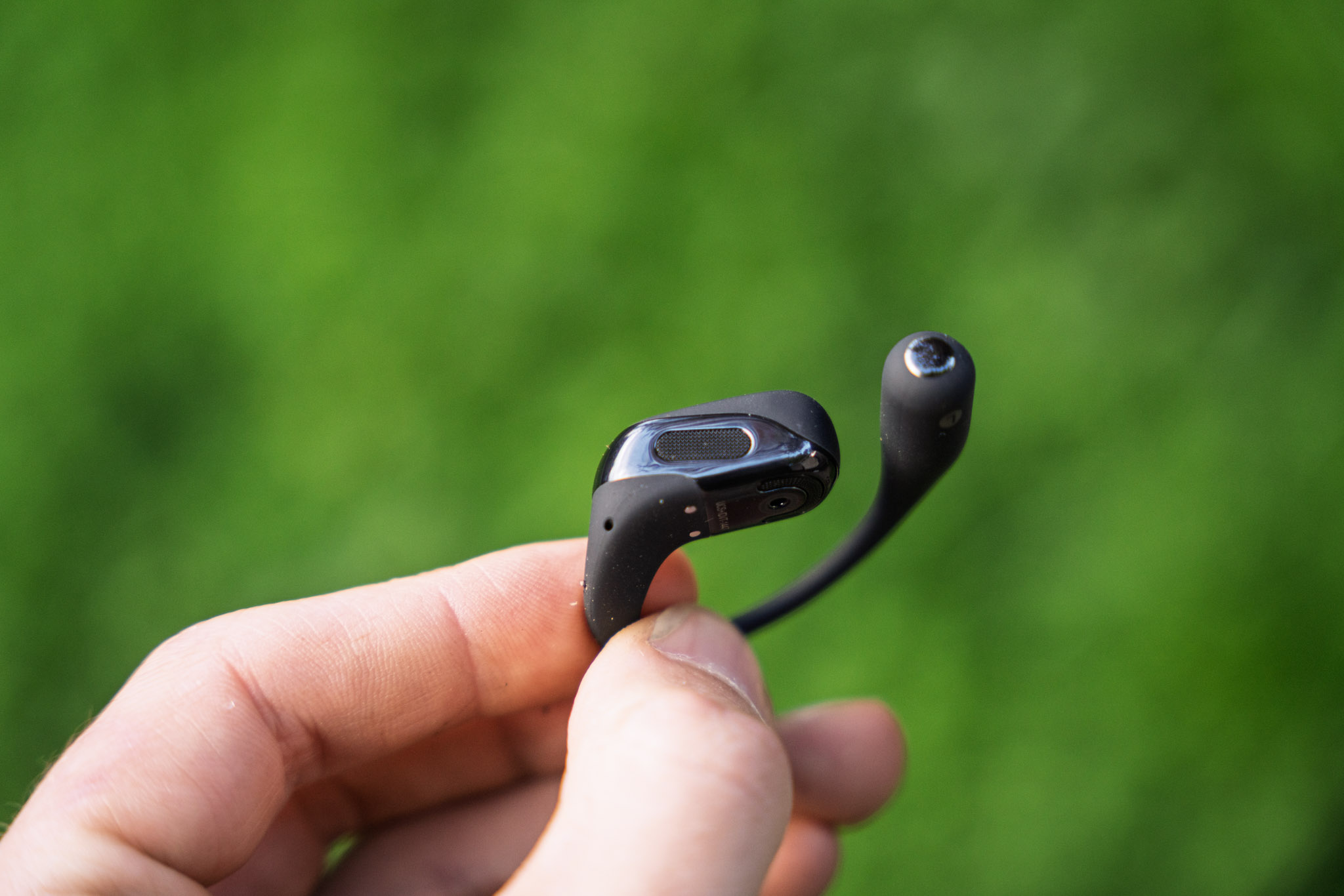- Trump issues chilling warning to Putin over Ukraine war samaa tv
- ‘You’ll see things happen’: Trump warns Putin on Ukraine Al Jazeera
- Trump commits to pursuing Russia-Ukraine peace: They are “not ready yet,” but “something is going to happen” CBS News
- Ukraine latest: Trump issues threat to Putin if US unhappy with his decision on peace The Independent
- Trump says he plans to hold talks on Ukraine in coming days Dawn
Blog
-
Trump issues chilling warning to Putin over Ukraine war – samaa tv
-
'Blood Moon' to rise during total lunar eclipse Sunday night – France 24
- ‘Blood Moon’ to rise during total lunar eclipse Sunday night France 24
- How to see Sunday’s ‘Blood Moon’ total lunar eclipse BBC
- Most of The World Will See an Eerie 82-Minute Blood Moon This Month ScienceAlert
- One week until the blood moon total lunar eclipse lights up September’s sky. Space
- How to See the Total Lunar Eclipse and Blood Moon on September 7 WIRED
Continue Reading
-

Extreme morning sickness found to carry heavy emotional and physical burden
A new study reveals the profound emotional and physical toll of extreme morning sickness, with more than half of affected women reporting they considered terminating their pregnancy, and 9 in 10 saying they had thought about not having more children.
The national survey, published in PLOS ONE, is one of the most comprehensive investigations into the lived experience of hyperemesis gravidarum (HG)-a severe form of nausea and vomiting in pregnancy – in Australia.
It highlights not only the debilitating nature of the condition but also the inconsistent effectiveness of commonly prescribed treatments.
Lead author Associate Professor Luke Grzeskowiak, a pharmacist and researcher from Flinders University, says that the findings underscore the urgent need for more compassionate, evidence-based care for pregnant women experiencing HG.
“Hyperemesis gravidarum is not just morning sickness-it’s a serious condition that can have devastating consequences for women’s mental health, relationships, and decisions about future pregnancies,” says Associate Professor Grzeskowiak.
“Our study shows that many women are not getting the support or relief they need, and that’s something we must urgently address.”
The survey of 289 Australian women found that 54% had considered terminating a pregnancy due to HG symptoms, while 90% had considered not having more children.
The condition was also linked to high rates of anxiety and depression, with 62% of respondents reporting they ‘often’ or ‘always’ experienced these feelings during pregnancy.
Despite the severity of symptoms, only half of the women surveyed rated commonly used treatments as effective.
Ondansetron, doxylamine and corticosteroids were perceived as the most effective medications, yet many women reported significant side effects, including constipation, sedation, and impaired cognition.
Metoclopramide, another frequently used drug, was discontinued by nearly one-third of users due to adverse effects.
“Women are often prescribed multiple medications in an attempt to manage their symptoms, but the reality is that many of these treatments come with their own burdens,” says Associate Professor Grzeskowiak.
“We need better evidence to guide treatment decisions and ensure women are supported to make informed choices.”
Beyond the physical symptoms, the study paints a dismal picture of the broader impact of HG on women’s lives.
More than half of respondents reported major disruptions to their ability to work, care for children, maintain relationships, and perform daily tasks. Thirty-seven per cent requested early induction of labour to end their pregnancy sooner due to the severity of their symptoms.
Caitlin Kay-Smith, founder of consumer organisation Hyperemesis Australia and co-author on the study, says the findings should prompt a shift in how HG is understood and managed in clinical settings.
“Too often, women’s symptoms are dismissed as a normal part of pregnancy, when in fact they are experiencing a condition that can be life-altering,” she says.
“We need to move away from a one-size-fits-all approach and toward personalised care that recognises the full impact of HG.”
The study was co-designed with Hyperemesis Australia and supported by the Robinson Research Institute at the University of Adelaide. It calls for further research into the long-term effects of HG and its treatments, as well as greater investment in support services for affected women.
Associate Professor Luke Grzeskowiak says the message from women was clear: “They want to be heard, believed, and treated with dignity.”
Source:
Journal reference:
Wills, L., et al. (2025). Assessing the burden of severe nausea and vomiting of pregnancy or hyperemesis gravidarum and the associated use and experiences of medication treatments: An Australian consumer survey. PLOS One. doi.org/10.1371/journal.pone.0329687
Continue Reading
-

Copper Extends Retreat From Five-Month Peak Ahead of US Data
Copper fell for a second day on the London Metal Exchange, as base metals staged a broad retreat ahead of key jobs data from the US later this week.
The red metal dropped 0.5% to trade at $9,926 a ton as of 11:45 a.m. Singapore time, after hitting its highest since March in intraday trading on Wednesday. The next major event for markets is on Friday, with a US payrolls report that should steer the Federal Reserve’s next moves on interest rates.
Continue Reading
-
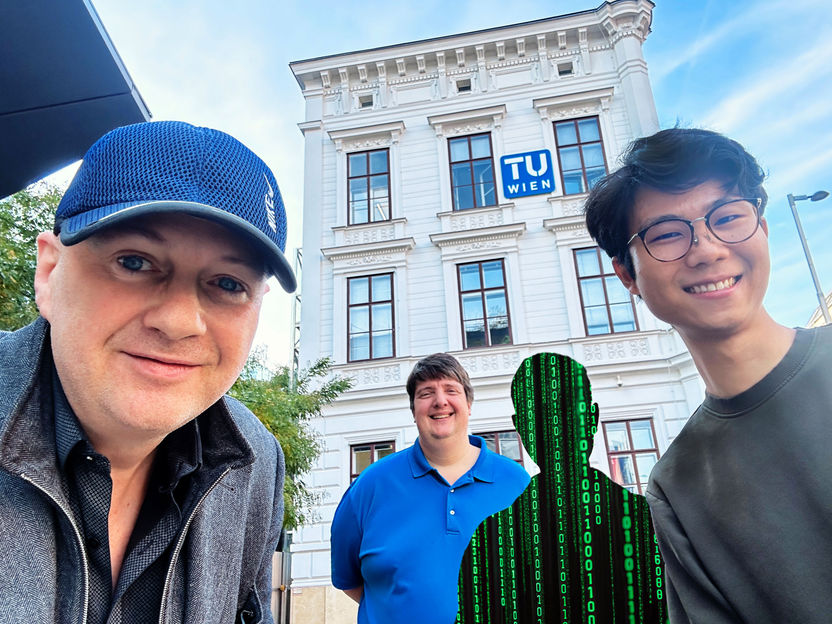
Watching catalytic nanoparticles at work
What exactly happens when syngas is produced? New methods allow to observe the process in real time. This answered the question how catalysts work in detail.
Atomic resolution images of PdO (red) and Pd (blue) structures and interfaces, with a corresponding illustration of the catalysts surface (right) and the microreactor in the electron microscope (left).
TU Wien
For many industrial applications one needs synthesis gas, also known as “Syngas”, a mixture of hydrogen (H2) and carbon monoxiode (CO). In addition to the established production method via steam reforming, synthesis gas can alternatively—and even more energy‑efficiently—be produced from methane (CH₄) and oxygen. However, in this process the total oxidation (combustion) of methane to CO2 and H2O must be avoided, which is why there is vivid research on syngas production worldwide.
Catalysts containing elements such as palladium are used for this purpose. Until now, however, it has been unclear exactly how the conversion of methane to syngas proceeds on palladium surfaces. Through a collaboration between TU Wien and the National University of Singapore (NUS), it has now been possible to observe the process using high‑resolution transmission electron microscopy —by so‑called operando TEM— combined with computational simulations. The results show that the reaction requires a synergy between different catalyst regions.
Palladium and palladium-oxide
“Methane is the main component of natural gas. Today we do not only use it for heating—which is problematic for reasons of global warming—but also as a feedstock for producing chemicals and fuels,” says Prof. Günther Rupprechter from the Institute of Materials Chemistry at TU Wien. “Even in the future, methane will therefore play a role in generating syngas and probably cannot be completely replaced within the next decade.”
This is why intensive research is being carried out today to find new processes to produce syngas from methane more efficiently while avoiding over‑oxidation—that is, combustion to CO₂ and water. This process is called “partial oxidation of methane” (POM). “In recent years we have investigated POM on various catalysts, most of which were nickel‑based,” Rupprechter says.
A microreactor in an electron microscope
It was already known that catalysts made of metal nanoparticles work well. But the open question was what exactly happens to the individual metal nanoparticles during the catalytic reaction. “In particular, we wanted to know: if the reaction is carried out with palladium nanoparticles, is palladium itself responsible for the catalysis, or palladium oxide, which forms during the reaction?”
This question could now be addressed for the first time through a combination of advanced approaches: The team observed the nanoparticles in real time during the catalytic reaction using high‑resolution transmission electron microscopy. At the same time, mass spectrometry was used to monitor which products form at which point in time—and all of this was complemented by computer simulations. This combination made it possible, for the first time, to obtain a more precise mechanistic picture of the process.
How does the catalyst work?
Alexander Genest from the TU Wien team, who was previously affiliated to the A*STAR High Performance Computing Centre in Singapore, has kept the collaboration between TU Wien and Singapore alive over the years. “Using computational modeling, we had previously looked into Pd nanoparticle oxidation and CO oxidation, so that the extension to methane oxidation was a very promising target”, says Alexander Genest.
Together with PhD candidate Parinya (Lewis) Tangpakonsab, he carried out simulations based on density functional theory (DFT) to study methane activation and the subsequent reaction steps. “We wanted to understand the origin of partial and total oxidation and to clarify exactly what happens at the atomic level,” says Tangpakonsab.
Metal and oxide: successful only in combination
The result was more complex than expected: neither the metal nor the metal oxide alone is responsible for the catalysis—the best performance comes from the two working together. “The two phases take on different tasks,” explains Günther Rupprechter. “The palladium dehydrogenates methane to carbon and hydrogen, while the palladium oxide oxidizes the carbon to CO.” This means that the most efficient catalysis can take place solely at the boundary regions between palladium and palladium oxide.
“Our group has already been very active in electron microscopy of surface oxidation reactions in the past, but this new operando‑TEM study extends this work to industrial conditions. Supported by the MECS Cluster of Excellence, we will soon have special reactor cells also available at TU Wien for similar operando‑TEM examination,” says Günther Rupprechter, Research Director of MECS.
Continue Reading
-

Fresh Produce | The Shokz OpenFit 2+ and OpenDots ONE earbuds bring the party to the trails
Love jamming out on the trails? We do too. Shokz have been delivering the party to outdoor enthusiasts and active individuals since 2011. They are well-known for their bone conduction headphones, and 2023 saw the introduction of the open ear range, including the OpenFit.
The idea behind all Shokz headphones is to allow you to listen to music or a podcast without compromising your awareness and still being able to hear what’s going on around you.
Earlier this year, Shokz launched a revised OpenFit model, alongside an all-new offering dubbed OpenDots ONE. We’ve been boogying down on the trails for the past few months to see what they are like from a mountain biker’s perspective.
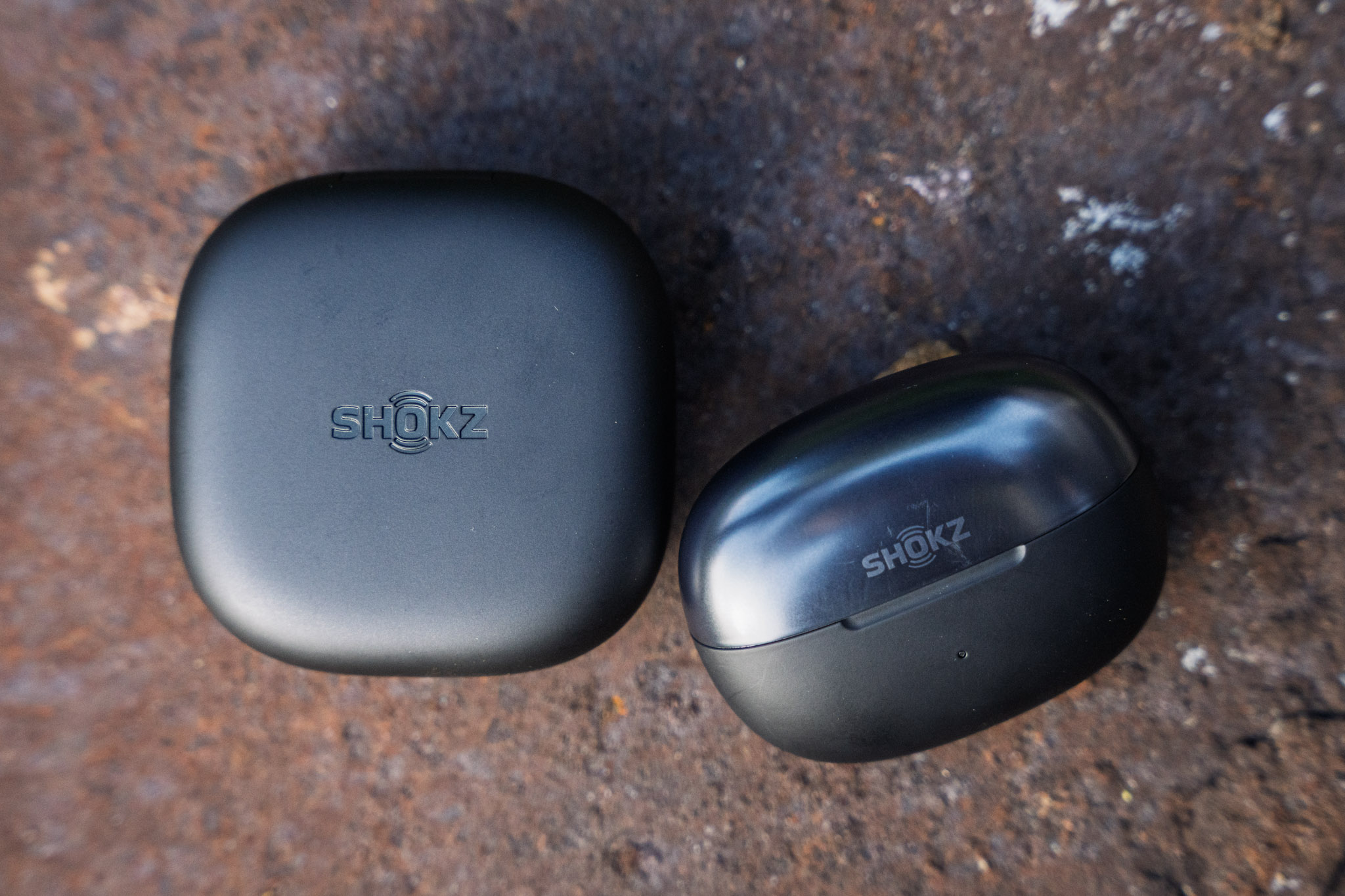
The handy little cases are compact and easy to throw in the pocket, and double as a charging bank for the earbuds. Shokz OpenFit 2+ Earbuds
The OpenFit 2+ is the brand’s updated open-ear offering, expanding on the original OpenFit model, utilising a flexible ear-hook design.
To produce a wide range of sound frequencies, it uses two individual speakers. A large, low-frequency speaker drops the bass, while an independent high-frequency speaker takes care of the elevated tones. They are left and right specific, and it’s relatively intuitive as to which one goes where.
While they are ear buds of a sort, given that you’re ear canal remains unobstructed, you can still hear the ambient noises around you while you make your way through Taylor Swift’s back catalogue, or Dr Karl drops some science knowledge as you ride.

An inbuilt magnet zaps each earbud satisfyingly into place. To control the audio, both the left and right earbuds have a physical button, which comes preconfigured with easy-to-remember controls. A single press pauses music; a double press skips to the next track. If you have an incoming call, a single press answers the call.
Each earbud also has a ‘touch area’ button, which is configured to do nothing by default. In the Shokz app, these can be set to control the voice assistant on your phone. Need to ask Siri what time your favourite Ramen restaurant closes quickly? A long press on the side of the bud and Siri kicks into gear with the answer.
The aesthetic of flexible ear-hook design is somewhat akin to something a secret agent would wear, with a sprinkle of modern style. It’s a little fiddly to get on in the right spot, but once in place, it sits very securely with minimal movement or need for adjustment.
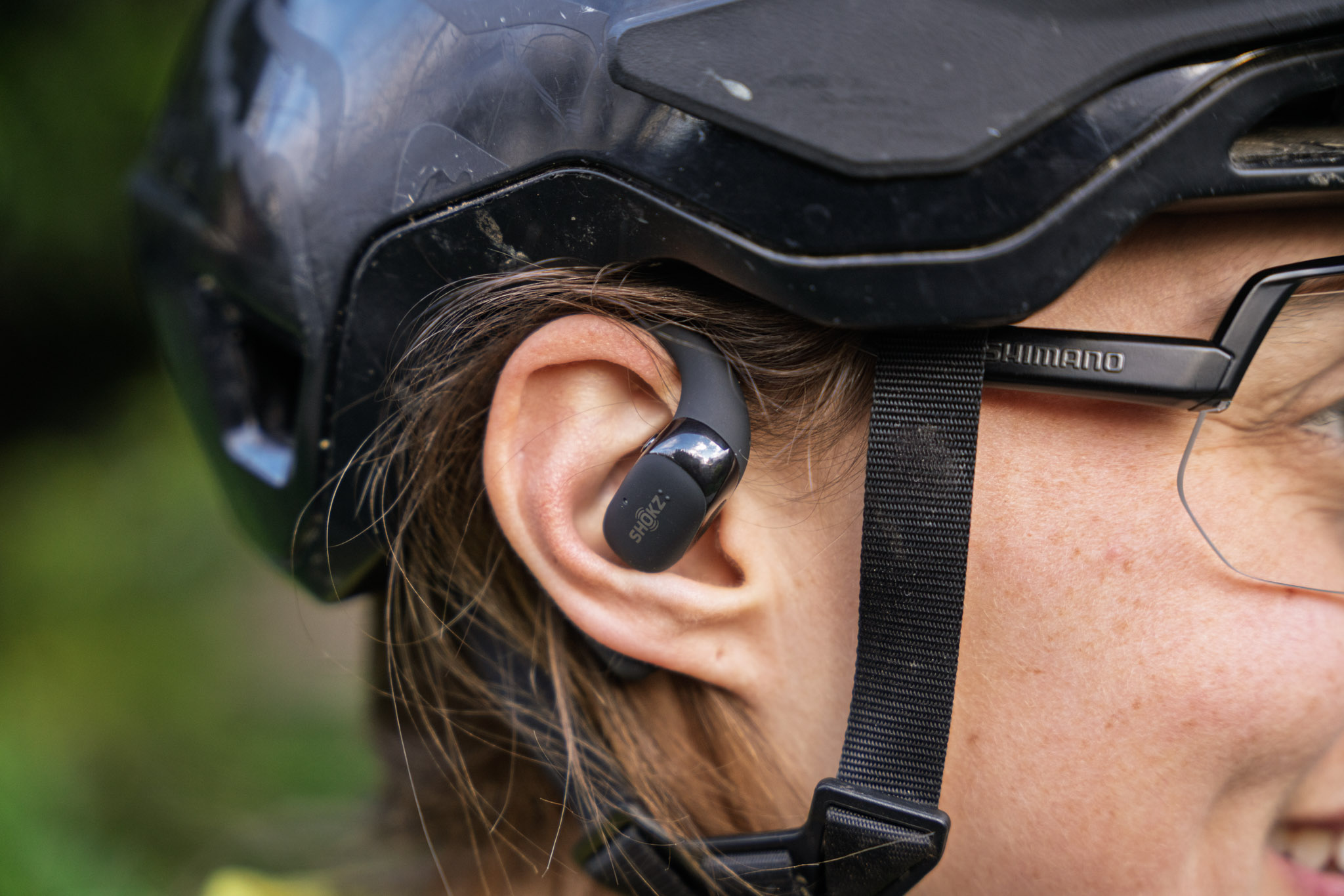
The flexible ear loop works well with helmets and riding glasses, and provides a secure fit. Both OpenFit 2+ earbuds fit neatly within the supplied case, which doubles as a battery bank for charging. The 56mAh batteries in the earbuds can deliver up to 11 hours of listening, and the 600mAh battery in the case zaps charge into the earbuds, delivering up to 48 hours of playtime. They are IP55 water-resistant too, meaning sweat and rain won’t ruin the tunes.
Key Details
- Connectivity | Bluetooth 5.4, 10m range
- Waterproofing | IP55
- Battery | Li-ion, 48hrs playtime
- Weight | 9g per earbud, 56g case
- Price | $339 AUD
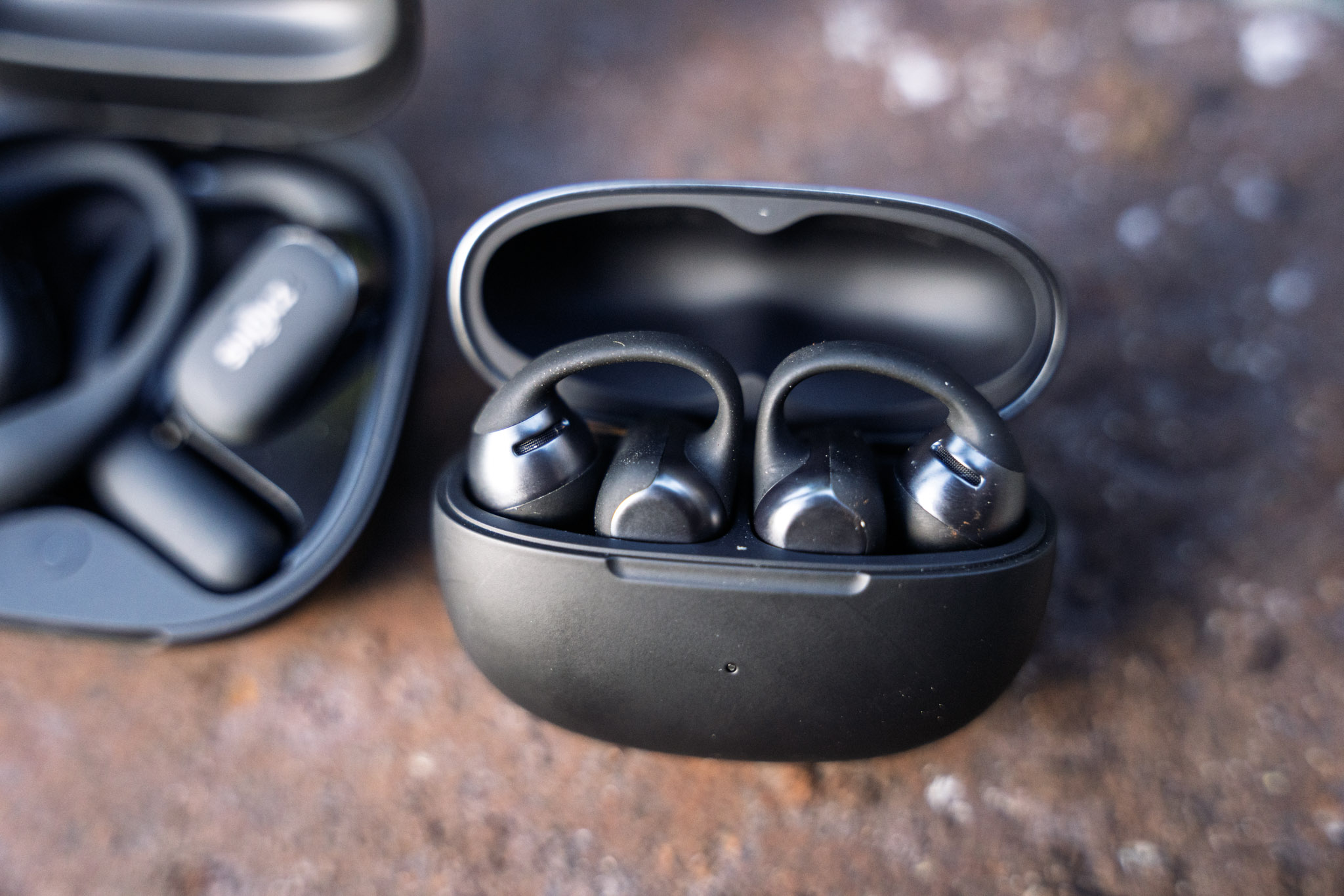
Slightly unconventional looks, but the OneDots ONE fit well and produce some serious sound. Shokz OpenDots ONE Earbuds
New in the brand’s lineup is the OneDots ONE, a fresh take on open ear headphones. They sit in the same ‘True Wireless’ range as the OneFit 2+, but with a completely new light clip design.
The OneDots ONE are lightweight and compact, with a minimalistic design that softly clips onto the lower part of your ear. They definitely aren’t as secure as the flexible ear-hook design, and in a decent crash, we can envisage them being a part of the yard sale.
That being said, whether you’re riding, running, or at the gym, the OneDots One buds sit firmly in place with no unwanted jiggle. The earbuds have no specific side, so you can just throw them on, without having to think about which one goes where.
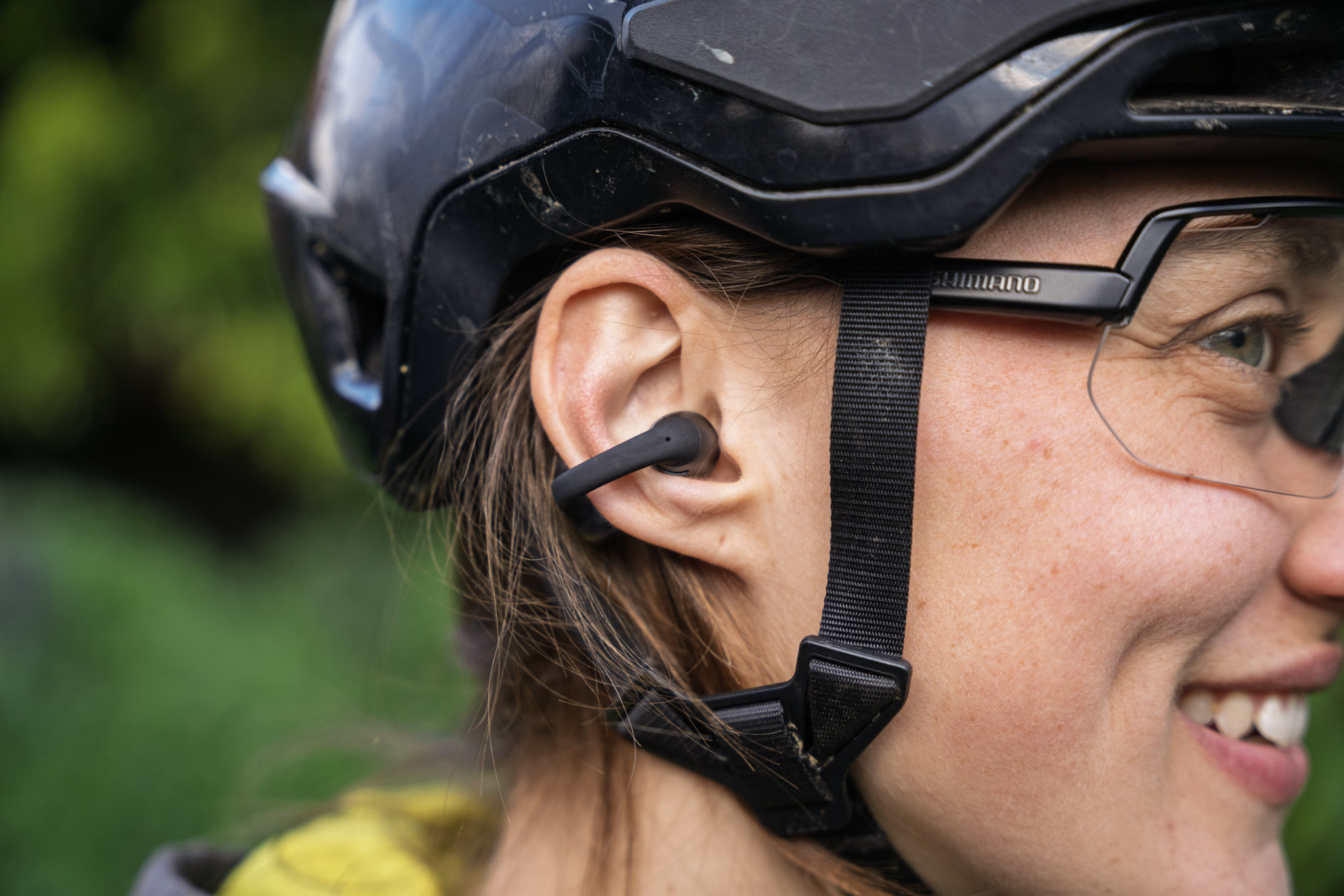
They sit well clear of the helmet straps and glasses, but certainly aren’t as secure as the OpenFit 2+. There are two touch control options for the OneDots One buds. A single tap of either the ‘JointArc’ or battery compartment, or a gentle two-finger pinch of either end of the battery compartment, plays or pauses music and answers incoming phone calls. In the default configuration, you can not skip or replay songs, so you’re going to want to make sure you’ve got a full playlist of bangers lined up. This is all customisable through the Shokz app, however, so you can add music control with a triple-tap of the ‘JointArc’.
The audio isn’t quite as ‘full’ as the OpenFit 2+; there’s a little less bass, but overall, the sound quality is still impressive. We found the audio quality and volume to be quite sensitive to the positioning on the ear. If they shake or knock out of place, or aren’t quite in the right spot, the quality drops drastically.
And similar to the OpenFit 2+ and all of Shokz other headphones, you’re not blocked off from the world and can hear what’s going on around you.
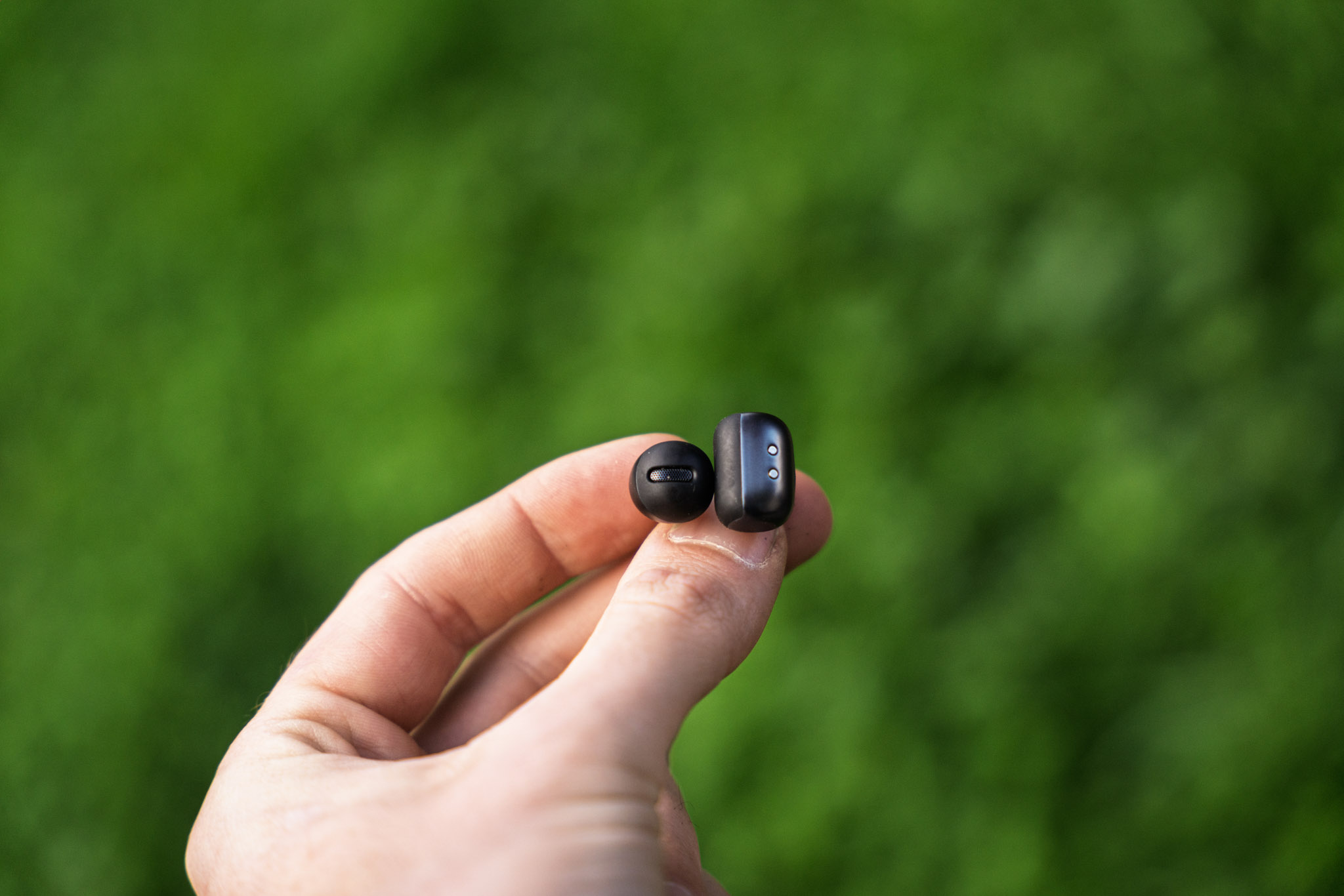
All that sound out of that little speaker? Impressive. The case of the OpenDots ONE is slightly more compact, doubling as a battery bank for charging. The 60mAh batteries in the earbuds can deliver up to 10 hours of listening, and the 590mAh battery in the case zaps charge into the earbuds, delivering up to 40 hours of total runtime. Similar to OneFit, they are also IP55 water-resistant, meaning sweat and rain won’t spoil the party.
Key Details
- Connectivity | Bluetooth 5.4, 10m range
- Waterproofing | IP55
- Battery | Li-ion, 40hrs playtime
- Weight | 7g per earbud, 39g case
- Price | $339 AUD
Shokz App
Shokz have developed a specific app to control both the OpenFit and OpenDot earbuds. Users can choose from different sound modes, including ‘Bass Boost’, ‘Vocal’, ‘Treble Boost’ or ‘Standard’, or even customise their own sound mode.
There is also the ability to enable the ‘Dolby Audio’ setting, which creates a more vivid, realistic and immersive sound from each of the buds. It seems a little odd that this is off by default, as it makes a significant improvement to the overall sound quality and experience.
Both OpenFit and OpenDots earbuds can be paired with multiple devices simultaneously through the app, making it easy to switch between your phone and laptop.
You can even customise the buttons, tailoring the single, double or triple clicks to the user’s preferences. Overall, the app is easy and intuitive to use, offering excellent control over the earbuds. We can’t imagine that folks will use it every time they throw on the earbuds, but it adds value to the overall package.
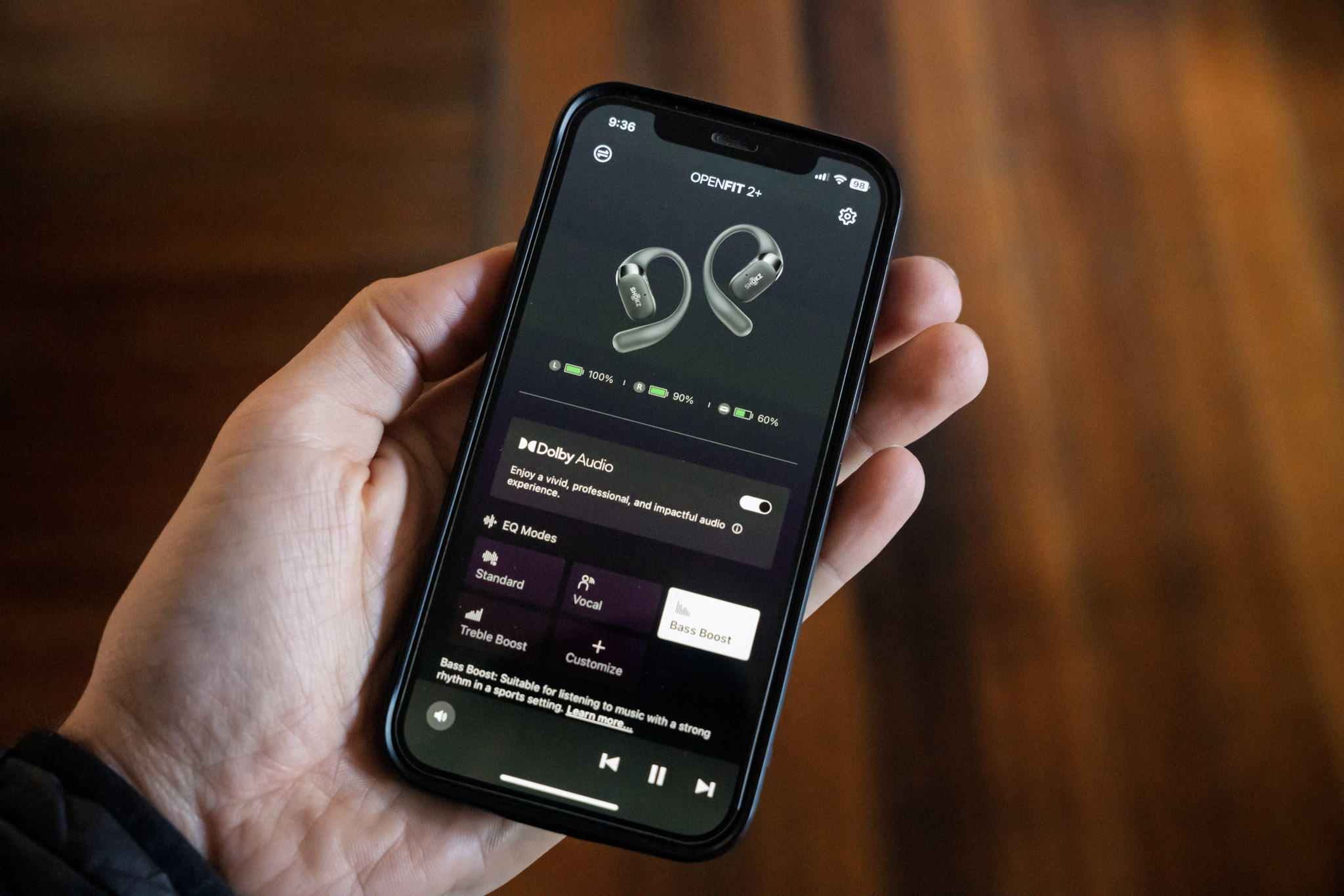
Both the OpenFit 2+ and OpenDots ONE can be configured with the Shokz app. Although we found it unusual that the Dolby Audio setting is configured to be off by default. Flow’s Take
Both the OpenFit 2+ and OpenDots ONE provide outstanding audio clarity and a unique fit that feels weightless when wearing. They provide superior spatial awareness compared to traditional in-ear earbuds, and the brand’s claim as to their ‘True Wireless’ functionality is certainly true. In our experience, both options fit well with riding helmets and sunglasses, making them an attractive choice for riders who love jamming out to music on the trails.
We really liked the minimalistic design of the OpenDots ONE, and the simple light clip was easy to use and comfortable to wear. The flexible hook design of the OpenFit 2+ provides a more secure fit, however, and might be a better choice for those who frequent rougher trails.
Continue Reading
-

Act now! Experts warn of active exploitation of vulnerabilities in several Sitecore products
Act now! Experts warn of active exploitation of vulnerabilities in several Sitecore products
The company behind CMS products used by companies such as L’Oreal, Microsoft, Toyota, and more has disclosed a critical vulnerability that hackers are already attempting to exploit.
Australian software company Sitecore has warned of a critical vulnerability in several of its products that could lead to remote code execution and the exfiltration of sensitive data.
The vulnerability – tracked as CVE-2025-53690 – potentially impacts four of Sitecore’s products: Experience Manager, Experience Platform, Experience Commerce, and Managed Cloud.
You’re out of free articles for this month
The issue impacts customers who followed the deployment instructions that came with XP 9.0 or earlier and Active Directory 1.4 or earlier. In some cases, customers have been found to have used the sample machine key included in those instructions, which date back to 2017.
“The issue stems from Sitecore users copying and pasting example keys from official documentation, rather than generating unique, random ones – a move we don’t recommend,” Ryan Dewhurst, watchTowr’s head of proactive threat intelligence, told Cyber Daily.
“Any deployment running with these known keys was left exposed to ViewState deserialisation attacks, a straight path right to remote code execution.”
Sitecore has recommended its customers rotate machine keys immediately, but that may not be enough, according to Caitlin Condon, VP of security research at VulnCheck.
“Unfortunately, rotating keys and locking down configurations isn’t enough on its own if threat actors were able to gain access to an organisation’s network,” Condon said.
“Security and threat hunting teams will need to examine environments for signs of compromise, particularly since Mandiant’s investigation found the (unattributed) threat actor had deployed malware and additional tooling geared toward internal reconnaissance and persistence across one or more compromised environments.”
What Condon is referring to is a detailed blog post from Mandiant outlining malicious activity it has already detected and prevented.
“In a recent investigation, Mandiant Threat Defense discovered an active ViewState deserialisation attack affecting Sitecore deployments leveraging a sample machine key that had been exposed in Sitecore deployment guides from 2017 and earlier,” Mandiant said on 3 September.
“An attacker leveraged the exposed ASP.NET machine keys to perform remote code execution.”
Mandiant said the threat actor seemed to have a deep understanding of Sitecore’s products, moving fast from initial compromise to privilege escalation. The attacker was able to establish a backdoor, maintain persistence, and deploy malicious tooling before beginning to perform network reconnaissance. Mandiant was able to stop the attack, which means it was unable to observe the life cycle of the attack.
Thankfully, Sitecore has said that new deployments will automatically generate keys, but more malicious activity may remain undetected, for now.
“Sitecore has confirmed that new deployments now generate keys automatically and that all affected customers have been contacted,” Dewhurst said.
“The blast radius remains unknown, but this bug exhibits all the characteristics that typically define severe vulnerabilities. The wider impact has not yet surfaced, but it will.”
David Hollingworth
David Hollingworth has been writing about technology for over 20 years, and has worked for a range of print and online titles in his career. He is enjoying getting to grips with cyber security, especially when it lets him talk about Lego.
Continue Reading
-
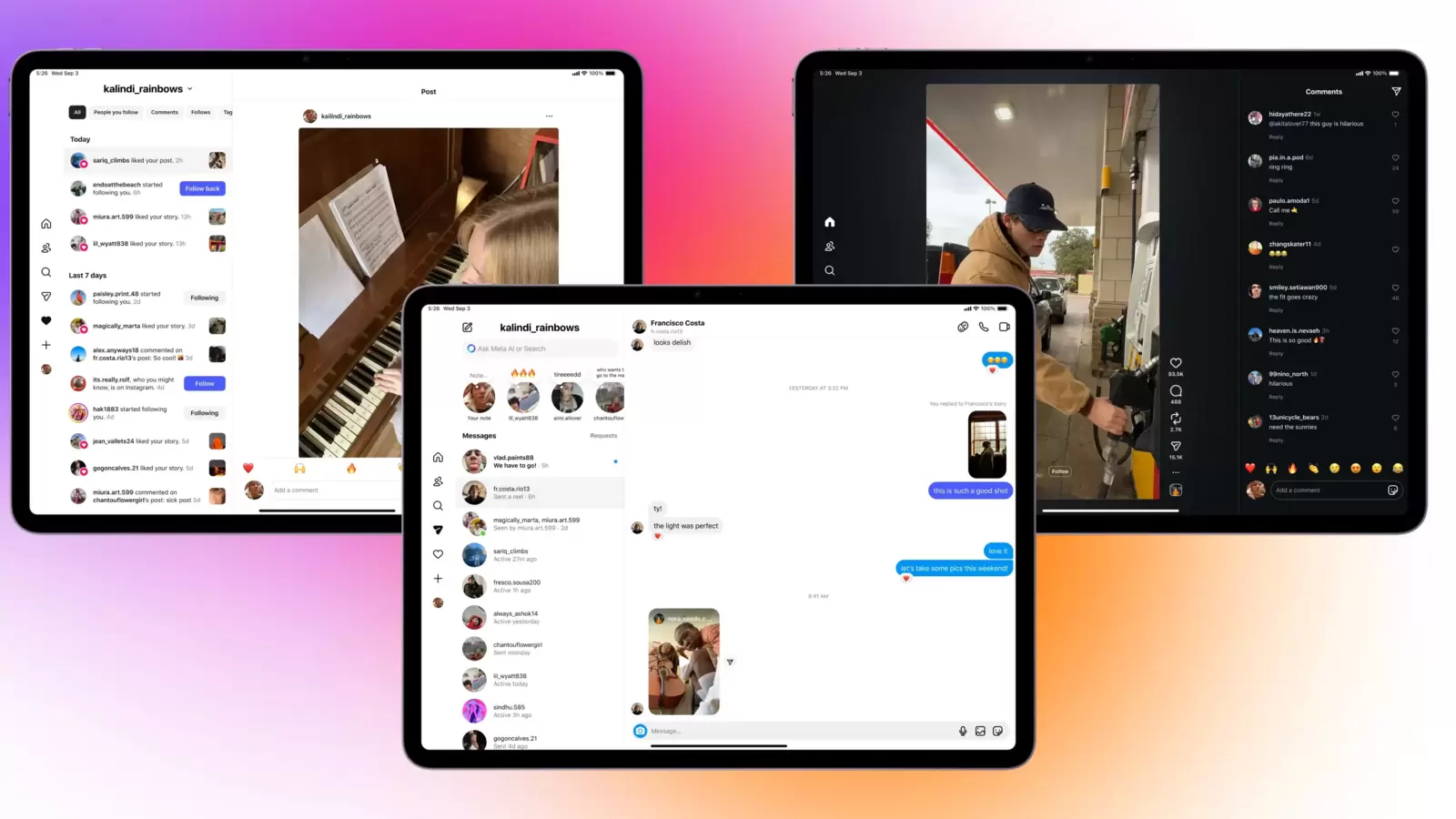
15 years later… Apple finally gets Instagram app for iPads
Published on: Sept 04, 2025 08:57 am IST
The Instagram app is finally rolling out to iPad users with a new multi-column layout and greater focus on Reels.
Continue Reading
-

September 3, 2025 — Don Callis Family Destroy Omega and Page, Allin Takes Kidd for a Painful Ride, More
With multiple championships on the line, we were back in Philadelphia at the 2300 Arena to begin the second week of our residency with AEW Dynamite!
Our main event went from an All-Star Tag to the destruction of Kenny Omega and AEW World Champion “Hangman” Adam Page at the hands of TNT Champion Kyle Fletcher and the Don Callis Family. The hostilities between Gabe Kidd and Darby Allin went to another level leading to a huge brawl and a painful trip for Kidd away from the 2300 Arena. Mercedes Moné turned back a tough challenge from Alex Windsor for the TBS Championship and learned about her next challenger. Ricochet and GOA had an All Out challenge for The Hurt Syndicate. Brodido were able to turn back the Death Riders to defend their AEW World Tag Team Championship. Plus, FTR brawled with Adam Copeland and Christian Cage again. And we got some big match announcements for AEW Collision and AEW All Out!
Here’s everything that went down on AEW Dynamite for September 3, 2025, including your full results and match recaps.
AEW Dynamite Recap Tonight for Philadelphia
Gabe Kidd Sends a Message, Darby Allin Responds!
As Excalibur tried to run down the championship matches on AEW Dynamite, Gabe Kidd interrupted with a microphone, as he walked down the aisle telling everyone they were on his time.
Kidd barely had a chance to call out Darby Allin when Allin hit the ring! The two quickly battled up to the top rope with Kidd dropping Allin across the exposed turnbuckles, sending him falling to the outside.
Allin found a moment of separation, but that immediately turned into a massive lariat from Kidd. As Kidd gathered himself, Allin came crashing down onto him with a Coffin Drop to the floor!
Allin went under the ring to grab a skateboard covered in tacks. Kidd grabbed Allin in a choke, which Darby broke up with his fingers in Kidd’s eye!
Before Allin could put the skateboard to good use on Kidd, Wheeler Yuta got in his way, but Allin stopped a Yuta punch with the skateboard. The rest of the Death Riders hit the ring, although that advantage didn’t last long, as Hook, Samoa Joe, Powerhouse Hobbs, and Willow Nightingale hit the scene and all hell broke loose with brawling all over the place.
Meanwhile, we caught up with Kidd and Allin behind the 2300 Arena, as Kidd tried to choke Allin as he berated him. Then, Kidd grabbed a hammer and tried to smash Allin’s head, but he escaped in the nick of time.
As Kidd chased after Allin, Darby blinded Kidd and then threw him in a bodybag attached to a truck. Kidd started to move around in the zipped-up bag, but it was too late, as Allin sped away, dragging Kidd into the South Philadelphia night!
How We Got to the TBS Championship Match
During her nine-belt celebration on last week’s AEW Dynamite, Mercedes Moné dodged a question about tapping out to Alex Windsor in a tag match the week before, but threatened to put Windsor in a hospital bed next to her husband, Will Ospreay.
Windsor responded on AEW Collision, promising to tap Moné again, but this time to take the TBS Championship. That brings us to the TBS Championship match!
TBS Championship: Mercedes Moné def. Alex Windsor
Our opening contest was the first championship match of the evening, as Alex Windsor looked for her first AEW gold against “The CEO” Mercedes Moné.
Windsor came out of the gates all over Moné, nearly capturing the TBS Champion in the same Sharpshooter that earned a tap out two weeks ago. The challenger was in control and concern was written all over Moné’s face.
Mercedes battled back and locked in The Statement Maker, yet Windsor was able to get a break. That submission didn’t keep Windsor down for long, as she was able to recover quickly with a huge cannonball to the outside, knocking Moné’s head off the floor.
Once again, Windsor locked in her Sharpshooter, but it was on the apron, so a tap didn’t matter. Moné grabbed Windsor’s hair to gain a little separation and then slid through to the outside and powerbombed Windsor on the apron!
The champion remained in control until Windsor hit a big headbutt counter to turn the tide back in her favor. Windsor had the champion reeling and locked in the Sharpshooter for a third time, but this time it was right in the middle of the ring! Moné resorted to a hair pull to get out of it, as it was apparent she was getting desperate.
Moné hit a Crucifix Bomb to get out of Windsor’s grasp for a two-count, but when Moné went for more, Windsor countered into a sitout powerbomb, leaving both competitors on the mat. Justin Roberts announced 10 minutes remained in the championship match.
Windsor stirred first and realized she had Moné’s legs in a compromising position, so she locked in yet another Sharpshooter. The two rolled to the floor, but Windsor still had Moné’s legs in the Sharpshooter as the champion tapped, although it meant nothing.
Both women returned to the ring and Moné tried to set up The Monéymaker, but Windsor was able to counter. And quickly followed with a blue thunder bomb. However, Mercedes kicked out at the last possible moment!
With Windsor on the top rope, a headbutt stunned her, allowing Moné to throw her to the mat. Moné immediately locked in The Statement Maker, and after a couple escape attempts, Windsor was able to reverse the submission into a pin attempt for a two count.
As Windsor popped up, Moné reversed the momentum into a capture pin for the victory and successful title defense!
It looked like the two may shake hands after the match, but Moné turned her back on Windor. Another Sharpshooter attempt resulted in a belt shot to the face. Moné went back to The Statement Maker, but a returning Riho came through the crowd to stomp Moné and sent her flying to the outside with a dropkick.
As Moné collected herself on the outside, Riho grabbed the TBS Championship and smiled!
Where Does HOOK Stand with The Opps?
Renee Paquette was in the back with two-thirds of the AEW World Trios Champions, Samoa Joe and Powerhouse Hobbs of The Opps. After acknowledging how they backed up Darby Allin earlier in the night, Paquette asked where things stood with HOOK and The Opps. Joe said you can ask him yourself just as HOOK showed up.
HOOK said he didn’t need Samoa Joe or Powerhouse Hobbs to fight his battles. And he wasn’t happy that he was replaced “before the body was cold” in reference to Hobbs replacing him as part of the AEW World Trios Champions.
Joe explained that The Opps take their opportunities and they had to make the call with Hook down.
Joe took the blame for making the call and said even if HOOK doesn’t want their backup, there will come a time when he needs their help and whether he wants it or not, The Opps will have his back.
Ricochet and GOA
Ricochet said his problems with The Hurt Syndicate predate their time together in AEW. Ricochet then said they should settle their differences at All Out Toronto on September 20th and that wasn’t a challenge, it was a demand.
Mark Briscoe def. Lance Archer of the Don Callis Family
Before his match, Mark Briscoe addressed how special it was to be back in the 2300 Arena because it was the building where he and his brother Jay fell in love with professional wrestling.
Briscoe said his attention was on Kyle Fletcher and the TNT Championship, but that meant a conversation with Don Callis to get his match for the title.
“I am speaking of the same Don Callis that looks like Elton John dressed up as a prosthetic penis for Halloween!”
Callis made his way to the ring with Rocky Romero and Lance Archer. He said he was too busy getting Fletcher ready to deal with the impatient Briscoe, but then revealed that Briscoe would face Konosuke Takeshita this Saturday on AEW Collision. Takeshita made his way out to face off with Briscoe and exited without incident.
That wasn’t enough for Briscoe, as he demanded another member of the Callis Family face him tonight. Archer stepped up and we had ourselves an impromptu match.
Briscoe attacked Archer as he tried to step over the top rope, and with a referee in the ring, the bell rang!
Immediately, Briscoe knocked Archer back to the outside and went for a dive, but he was caught by Archer and chokeslammed onto the apron! Archer went for a quick pin and got a two count, and it was clear he had more danger on his mind. It didn’t take long to see what that was, as Archer hit another chokeslam, this time on the steel steps!
With Archer in full control, he beat Briscoe up around the ringside area before finally getting back in the ring.
As the Philadelphia crowd got behind him with “DEM BOYZ” chants, Briscoe finally got Archer down and tried the dive to the outside again, but this time he was successful, nearly knocking both him and Archer into the front row!
Archer’s power got him back into the contest with a powerbomb in the corner followed by yet another chokeslam, which would have finished the match against most opponents, but not Briscoe. He kicked out in the nick of time, eliciting a huge reaction and another shot of life. Briscoe took Archer down again and knew this was his chance.
Briscoe quickly scaled the ropes and hit a picture-perfect Froggy Bow to get the win ahead of his big match with Takeshita on Collision.
AEW Women’s World Champion “Timeless” Toni Storm Speaks!
Earlier in the day, AEW Women’s World Champion “Timeless” Toni Storm commandeered a camera crew to talk about the history of the 2300 Arena in only a way she can.
“Philadelphia freaks, lend me your ears.”
Storm said no forever champion or belt collector could take her championship. She asked for the best, the worst, and everything in between.
“But don’t worry, darlings. God doesn’t judge. That’s my job!”
Kris Statlander and Harley Cameron Get Interrupted
Renee Paquette caught up with Kris Statlander and Harley Cameron to get their thoughts on their ongoing issues with Megan Bayne and Penelope Ford. Cameron admitted that Bayne bloodied her again last week, questioning the protection of her mask. Statlander reminded her that her wrath didn’t come from a mask. That seemed to fire up Cameron, who said that as an undefeated tag team, they were going straight for the top…and called out AEW World Tag Team Champions Bandido?
Statlander directed Cameron’s attention back towards Bayne and Ford before being interrupted by Wheeler Yuta. He said he was delivering a message from someone else.
“The Death Riders? We got your back. Just want you to know that.”
Harley tried to respond, but Marina Shafir appeared in front of Statlander. She told Shafir, “You can tell our friend that I got his message, alright?”
Yuta then complained that he had to wrestle after all he’d been through in the night, but promised to deliver Statlander’s message.
AEW World Tag Team Championship: Brodido def. Claudio Castagnoli & Wheeler Yuta
Yuta continued to the ring alongside Claudio Castagnoli and Shafir, as they entered through the hostile crowd for the AEW World Tag Team Championship match with Brodido.
Even after complaining about his previous run-in with Darby Allin’s tack-covered skateboard, Yuta started the match with ROH World Champion Bandido.
Bandido easily handled Yuta early on, much to the chagrin of Castagnoli, who tagged himself in as Brody King did the same in the opposite corner.
Castagnoli and King tried to outpower each other, yet neither could gain an advantage until a huge forearm from King put Castagnoli on the mat. Bandido got back in and quickly went to work double-teaming Castagnoli with King.
Bandido celebrated with the Macarena. King decided to exit without a dance of his own.
While you’d expect a power display from Castagnoli, it was Bandido who showed off by muscling Castagnoli up into a vertical suplex!
“BAN-DI-DO! BAN-DI-DO! BAN-DI-DO!”
With the ROH World Champion feeling it, he ascended to the top, but Castagnoli was ready, reversing the momentum in a devastating backbreaker.
The Philadelphia crowd continued to express their displeasure with Yuta, so Castagnoli responded by knocking King off the apron with a running big boot.
Bandido got enough time to recover and swung the match back in the champions’ favor when he hit a defensive Code Red on Claudio.
King tagged back in and came out swinging with chops to both Castagnoli and Yuta before sandwiching them in the corner with a splash followed by a cannonball.
Bandido got the tag and the unique offense of Brodido was back on display, including Bandido hitting a head scissors on King, sending him crashing into a downed Castagnoli! You won’t see that anywhere else!
Sensing a chance to finish things, Bandido went to the top, but missed a frog splash, which allowed Yuta back into the match. However, King and Bandido were ready, as they had Yuta set up for the Second Shooter, but Shafir grabbed Bandido’s leg to stop it.
Castagnoli came flying in with an uppercut to break it all up and then sent King to the outside. With Shafir distracting the referee, Jon Moxley appeared from the aisle and sent King into the steel post.
Back in the ring, Bandido was all alone against Castagnoli and Yuta. Castagnoli hit a superplex and then launched Yuta from the top onto Bandido, but he kicked out!
A giant swing by Castagnoli into a Yuta dropkick was almost the end, but King broke up the pin!
Moxley looked ready to take another shot at King until Darby Allin jumped on his back, taking him out of the mix for good.
King slugged Yuta with a huge forearm from the outside, leaving Bandido to hit a 21 Plex for the successful championship defense!
As Brodido celebrated, Allin escaped with the Death Riders hot on his tail.
AEW Unified Champion “The Rainmaker” Kazuchika Okada Has Words for Konosuke Takeshita
Renee Paquette was in the back with the AEW Unified Champion Kazuchika Okada and asked him about the tension with fellow Don Callis Family member Konosuke Takeshita in last week’s tag match. Okada said Takeshita may call himself “The Alpha, “ but he is the “top dog” in the family…bitch.
The Hurt Syndicate Accept Ricochet’s Challenge
Renee Paquette was with The Hurt Syndicate to get their thoughts on the challenge from Ricochet and GOA for All Out. MVP ran down Ricochet and questioned why GOA listened to him. He also accepted the challenge for All Out!
FTR Brawl With Adam Copeland and Christian Cage Again
While we were supposed to hear from Adam Copeland and Christian Cage, FTR attacked Copeland just seconds after he made his entrance. With Cash Wheeler and Dax Harwood going to work on Copeland, Cage ran out to even the odds.
All four men battled in and out of the ring with security unable to keep them apart. That brought out members of the ROH locker room to help restore order, as Dax bled from a cut opened in the melee.
It seemed as if everything was dying down until Harwood grabbed Jordan Oliver and Wheeler planted him with the spike piledriver.
That set off another fight with Adam Priest going after FTR, just days after he and JD Drake lost to Harwood and Wheeler on AEW Collision.
Did you really expect order to be restored in the 2300 Arena?
FTR Make a Challenge for AEW Collision
Stokely and FTR were backstage following the brawl with their All Out opponents, Christian Cage and Adam Copeland, but before Big Stoke could say much, Harwood called Adam Priest over to berate him for attacking them just minutes ago. As Priest tried to apologize, Wheeler told him they could do it again this Saturday on AEW Collision, so he better find a partner.
All-Star 8-Man Tag: TNT Champion Kyle Fletcher, Josh Alexander, and the Young Bucks def. AEW World Champion “Hangman” Adam Page, Kenny Omega, and JetSpeed
While the Young Bucks made another less-than-spectacular entrance, we were treated to some footage from their meet and greet earlier in the day. They really needed the Monéy…and still do.
More importantly, it was time for our main event!
The AEW World Champion “Hangman” Adam Page started things off with the “Walking Weapon” Josh Alexander, in a callback to Alexander’s AEW debut against Page in the Owen Hart Foundation Tournament back in April.
Hangman took down Alexander and had an intense staredown with the TNT Champion Kyle Fletcher, but when he turned his back to make a tag, Fletcher attacked from behind!
That brought everyone into the ring to throw hands, as Philadelphia roared in approval!
After knocking all four of their opponents to the outside, Page, Omega, Bailey, and Knight all hit planchas at the same time. They even took some time to celebrate with the fans, who were whipped into a frenzy.
Omega and Page went to work on Alexander back in the ring, making it apparent they had already found their old chemistry.
An eyerake by Alexander blinded Omega long enough for Fletcher to go on the attack, which put Kenny in the wrong corner for some time.
Omega tagged Speedball, giving their side a glimmer of hope, although Alexander regained control quickly, which allowed Matt Jackson to go to work. Knight entered the fray to give his team some life, buying enough time to tag Hangman back in the match. After eating some offense from the Young Bucks, Page was able to tag in Omega just as Fletcher tagged in for his side.
Page and Omega had Fletcher in big trouble until Alexander ripped Page off the apron. Fletcher fought off Omega and followed that with a big dive to Page on the outside. Fletcher went for more on the inside, but Hangman hit a big powerbomb to reverse his fortunes.
Eventually, we got back to Alexander and Bailey as the legal men, although they wound up back outside in a dangerous position on the guardrail. Knight came flying off the top and clotheslined Alexander into the front row!
Knight turned right into a kick from Nick Jackson and it looked like Bailey would get spiked by the Bucks on the outside, but Nick springboarded into the ring to help Fletcher spike Knight with a piledriver before going back outside to do the same to Bailey.
As the match continued, the Bucks hit a foot stomp/powerbomb combo on Bailey, which Excalibur suggested calling the “MmmBop Drop.” It’s catchy!
Omega and Fletcher tagged back in, trading reversals until Omega hit Snap Dragon suplexes on Fletcher and Alexander. That brought the Bucks back together with Omega and Page, as the memories of their legendary title match at AEW Revolution 2020 came flooding back with the crowd erupting in a “Holy Shit!” chant.
As all four men traded blows, Hangman went for a Buckshot on Matt Jackson, but he ducked as Nick went for his own Buckshot and instead hit Matt! Hangman immediately connected with Nick and Omega followed with a V-Trigger on Matt. It looked like Page and Omega had Matt Jackson set up for the Buckshot/V-Trigger, but Nick made the save and the brothers delivered a pair of superkicks only for Omega and Page to fire back with a pair of clotheslines, as all four men went down.
Fletcher tagged back in and the ring was clear for him and Page. A couple of tombstone reversals by both men ended with Fletcher finally hitting the move. Knight made a blind tag and started teeing off on Fletcher, as Bailey came in to go to work with his tag partner. Matt and Nick Jackson got involved long enough for Fletcher to recover, as he avoided the UFO Splash by getting his knees up on Knight.
After a running kick in the corner, Fletcher had Knight perched on the top rope, but Bailey came in from the side to hit Fletcher with a Poisonrana only to be met by a pair of superkicks from the Bucks.
Matt and Nick took out Omega and Page with dives to the outside before assisting Alexander with a piledriver on Knight. Fletcher finished Knight with his devastating brainbuster to get the win.
The match was over, yet the fighting continued, as JetSpeed and the Young Bucks fought up the ramp while Rocky Romero and Lance Archer hit the ring to give the Don Callis Family even more of an advantage.
They isolated Page in the ring, which gave Alexander the opportunity to hit yet another brainbuster, this time putting the AEW World Champion through a chair!
Omega tried to fight back, but the numbers were just too much and a chairshot to the weakened midsection of Omega only made matters worse.
With a table set up on the floor, Fletcher grabbed Omega on the apron and hit a sickening brainbuster through the table, shattering pieces everywhere.
Medical personnel attended to Omega, as Page tried to check on his partner while Fletcher basked in the damage he inflicted as AEW Dynamite came to a close.
Catch AEW Collision Saturday LIVE at 8/7c on TNT and streaming on HBO Max from the 2300 Arena in Philadelphia, PA!
And remember… We are AEW—Where The Best Wrestle!
","category":{"enumClass":"com.wixpress.live.site.data.types.CustomContentCategory","value":"ESSENTIAL"}},"domain":"allelitewrestling.com","name":"Custom"},{"id":"3fa558c7-1d0b-40b7-b103-73cc8f591272","embedType":"verificationCode","position":"head","loadOnce":false,"content":{"type":"verificationCode","html":""},"domain":"allelitewrestling.com","name":"Verification Code"},{"id":"9dd1580e-74b7-4932-82de-36efdb47589a","embedType":"custom","position":"head","loadOnce":true,"content":{"type":"custom","html":"nnn","category":{"enumClass":"com.wixpress.live.site.data.types.CustomContentCategory","value":"ESSENTIAL"}},"domain":"allelitewrestling.com","name":"FB Pixel"},{"id":"30131f06-9fc8-4c68-bbb3-b73db853240e","embedType":"custom","position":"head","loadOnce":false,"content":{"type":"custom","html":"","category":{"enumClass":"com.wixpress.live.site.data.types.CustomContentCategory","value":"ESSENTIAL"}},"domain":"allelitewrestling.com","name":"Facebook Domain Verification"},{"id":"b7f75316-8a15-45b2-a126-1bc7a2e96d06","embedType":"custom","position":"head","loadOnce":false,"content":{"type":"custom","html":"nnn","category":{"enumClass":"com.wixpress.live.site.data.types.CustomContentCategory","value":"ESSENTIAL"}},"domain":"allelitewrestling.com","name":"Meta Pixel"},{"id":"8c14ed18-9e10-4b9a-bb8a-8b23c90030c2","embedType":"custom","position":"head","loadOnce":false,"content":{"type":"custom","html":"","category":{"enumClass":"com.wixpress.live.site.data.types.CustomContentCategory","value":"ESSENTIAL"}},"domain":"allelitewrestling.com","name":"DB Verification"},{"id":"4853a1d9-c3db-4e98-8de2-b48824287f5a","embedType":"custom","position":"head","loadOnce":false,"content":{"type":"custom","html":"nnn","category":{"enumClass":"com.wixpress.live.site.data.types.CustomContentCategory","value":"ESSENTIAL"}},"domain":"allelitewrestling.com","name":"FB CANADA PIXEL"},{"id":"699deaa4-2042-4fc0-8f63-bb052dd5ef3a","embedType":"custom","position":"head","loadOnce":false,"content":{"type":"custom","html":"nnn","category":{"enumClass":"com.wixpress.live.site.data.types.CustomContentCategory","value":"ESSENTIAL"}},"domain":"allelitewrestling.com","name":"TM Facebook Pixel"},{"id":"4fba6725-0296-4e1a-9bc0-3e3e97497bab","embedType":"custom","position":"head","loadOnce":false,"content":{"type":"custom","html":"nn","category":{"enumClass":"com.wixpress.live.site.data.types.CustomContentCategory","value":"ESSENTIAL"}},"domain":"allelitewrestling.com","name":"Cumulus National GTM"},{"id":"e41964bf-ebd8-42d7-a639-78756b8085cf","embedType":"custom","position":"bodyStart","loadOnce":false,"content":{"type":"custom","html":"nn","category":{"enumClass":"com.wixpress.live.site.data.types.CustomContentCategory","value":"ESSENTIAL"}},"domain":"allelitewrestling.com","name":"Cumulus National GTM"}],"shouldLoadRequireJS":true},"componentsRegistry":{"librariesTopology":[{"artifactId":"editor-elements","namespace":"wixui","url":"https://static.parastorage.com/services/editor-elements/1.14295.0"},{"artifactId":"editor-elements","namespace":"dsgnsys","url":"https://static.parastorage.com/services/editor-elements/1.14295.0"}]},"consentPolicy":{"siteConsentPolicy":{"essential":true,"functional":false,"analytics":false,"advertising":false,"dataToThirdParty":true},"isWixSite":false},"cookiesManager":{"cookieSitePath":"/","cookieSiteDomain":"www.allelitewrestling.com"},"dataWixCodeSdk":{"gridAppId":"8a24e7a3-4544-480c-b398-ad045e613d58","environment":"LIVE","cloudDataUrlWithExternalBase":"https://www.allelitewrestling.com/_api/cloud-data"},"dynamicPages":{"prefixToRouterFetchData":{"Items":{"urlData":{"basePath":"https://www.allelitewrestling.com/_api/dynamic-pages-router/v1","queryParams":"gridAppId=8a24e7a3-4544-480c-b398-ad045e613d58&viewMode=site","fetchUsingGet":true,"compressPayload":true,"appDefinitionId":"675bbcef-18d8-41f5-800e-131ec9e08762","encodeURI":false},"optionsData":{"bodyData":{"pageRoles":{"23b6e3b6-502f-48bd-af16-c0685897f52c":{"id":"p1tjd","title":"Items (Title)"}},"routerPrefix":"/Items","config":{"patterns":{"/{title}":{"pageRole":"23b6e3b6-502f-48bd-af16-c0685897f52c","title":"{title}","config":{"collection":"Items","seoV2":true},"seoMetaTags":{}}}},"roleVariations":{}},"headers":{"Content-Type":"application/json","X-XSRF-TOKEN":"","x-wix-grid-app-id":"8a24e7a3-4544-480c-b398-ad045e613d58"}},"wixCodeAppDefinitionId":"675bbcef-18d8-41f5-800e-131ec9e08762"},"womens-roster":{"urlData":{"basePath":"https://www.allelitewrestling.com/_api/dynamic-pages-router/v1","queryParams":"gridAppId=8a24e7a3-4544-480c-b398-ad045e613d58&viewMode=site","fetchUsingGet":true,"compressPayload":true,"appDefinitionId":"675bbcef-18d8-41f5-800e-131ec9e08762","encodeURI":false},"optionsData":{"bodyData":{"pageRoles":{"d346d592-41c0-4cd1-828d-22a1d31d2422":{"id":"pnopx","title":"Roster Women (Item)"}},"routerPrefix":"/womens-roster","config":{"patterns":{"/{name}":{"seoMetaTags":{"description":"{name}","og:image":"{headshot}","robots":"index"},"pageRole":"d346d592-41c0-4cd1-828d-22a1d31d2422","title":"{name}","config":{"collection":"RosterWomen","pageSize":1,"lowercase":true,"seoV2":true}}}},"roleVariations":{}},"headers":{"Content-Type":"application/json","X-XSRF-TOKEN":"","x-wix-grid-app-id":"8a24e7a3-4544-480c-b398-ad045e613d58"}},"wixCodeAppDefinitionId":"675bbcef-18d8-41f5-800e-131ec9e08762"},"aew-event":{"urlData":{"basePath":"https://www.allelitewrestling.com/_api/dynamic-pages-router/v1","queryParams":"gridAppId=8a24e7a3-4544-480c-b398-ad045e613d58&viewMode=site","fetchUsingGet":true,"compressPayload":true,"appDefinitionId":"675bbcef-18d8-41f5-800e-131ec9e08762","encodeURI":false},"optionsData":{"bodyData":{"pageRoles":{"ea885169-014c-4de7-a669-2572b7e5d1de":{"id":"l5qmn","title":"AEW Events (Title)"}},"routerPrefix":"/aew-event","config":{"patterns":{"/{title}":{"seoMetaTags":{"description":"{date}{eventName}","og:image":"{promoImage}","robots":"index","keywords":""},"pageRole":"ea885169-014c-4de7-a669-2572b7e5d1de","title":"{title}","config":{"collection":"AEWEvents","pageSize":1,"lowercase":true,"sort":[{"title":"asc"}],"seoV2":true}}}},"roleVariations":{}},"headers":{"Content-Type":"application/json","X-XSRF-TOKEN":"","x-wix-grid-app-id":"8a24e7a3-4544-480c-b398-ad045e613d58"}},"wixCodeAppDefinitionId":"675bbcef-18d8-41f5-800e-131ec9e08762"},"broadcast-roster":{"urlData":{"basePath":"https://www.allelitewrestling.com/_api/dynamic-pages-router/v1","queryParams":"gridAppId=8a24e7a3-4544-480c-b398-ad045e613d58&viewMode=site","fetchUsingGet":true,"compressPayload":true,"appDefinitionId":"675bbcef-18d8-41f5-800e-131ec9e08762","encodeURI":false},"optionsData":{"bodyData":{"pageRoles":{"8c6d703f-5076-42bb-ab98-5a5893541189":{"id":"qsboh","title":"Broadcast Roster (Item)"}},"routerPrefix":"/broadcast-roster","config":{"patterns":{"/{name}":{"seoMetaTags":{"description":"{name}","og:image":"{headshot24}","robots":"index"},"pageRole":"8c6d703f-5076-42bb-ab98-5a5893541189","title":"{name}","config":{"collection":"BroadcastRoster","pageSize":1,"lowercase":true,"seoV2":true}}}},"roleVariations":{}},"headers":{"Content-Type":"application/json","X-XSRF-TOKEN":"","x-wix-grid-app-id":"8a24e7a3-4544-480c-b398-ad045e613d58"}},"wixCodeAppDefinitionId":"675bbcef-18d8-41f5-800e-131ec9e08762"},"items-1":{"urlData":{"basePath":"https://www.allelitewrestling.com/_api/dynamic-pages-router/v1","queryParams":"gridAppId=8a24e7a3-4544-480c-b398-ad045e613d58&viewMode=site","fetchUsingGet":true,"compressPayload":true,"appDefinitionId":"675bbcef-18d8-41f5-800e-131ec9e08762","encodeURI":false},"optionsData":{"bodyData":{"pageRoles":{"16ef9cbd-1229-42ff-8b7c-5bb0a44a0902":{"id":"j10nj","title":"Items (List)"},"7412db14-8abb-43e0-b673-fbbaa9e74b4d":{"id":"o04cf","title":"Items (Item)"}},"routerPrefix":"/items-1","config":{"patterns":{"/{title}":{"seoMetaTags":{"description":"{subtitle}","og:image":"{image}","keywords":"","robots":"index"},"pageRole":"7412db14-8abb-43e0-b673-fbbaa9e74b4d","title":"{title}","config":{"collection":"Items","pageSize":1,"lowercase":true,"seoV2":true}},"/":{"seoMetaTags":{"robots":"index"},"pageRole":"16ef9cbd-1229-42ff-8b7c-5bb0a44a0902","title":"Items","config":{"collection":"Items","pageSize":100,"lowercase":true,"seoV2":true}}}},"roleVariations":{}},"headers":{"Content-Type":"application/json","X-XSRF-TOKEN":"","x-wix-grid-app-id":"8a24e7a3-4544-480c-b398-ad045e613d58"}},"wixCodeAppDefinitionId":"675bbcef-18d8-41f5-800e-131ec9e08762"},"items":{"urlData":{"basePath":"https://www.allelitewrestling.com/_api/dynamic-pages-router/v1","queryParams":"gridAppId=8a24e7a3-4544-480c-b398-ad045e613d58&viewMode=site","fetchUsingGet":true,"compressPayload":true,"appDefinitionId":"675bbcef-18d8-41f5-800e-131ec9e08762","encodeURI":false},"optionsData":{"bodyData":{"pageRoles":{"7b92cbdd-0b34-4c04-b603-4d34e89ee741":{"id":"b3cy2","title":"Items (Title)"}},"routerPrefix":"/items","config":{"patterns":{"/{title}":{"pageRole":"7b92cbdd-0b34-4c04-b603-4d34e89ee741","title":"{title}","config":{"collection":"Items","pageSize":1,"lowercase":true,"sort":[{"title":"asc"}],"seoV2":true},"seoMetaTags":{"description":"{subtitle}","og:image":"{image}","keywords":"","robots":"index"}}}},"roleVariations":{}},"headers":{"Content-Type":"application/json","X-XSRF-TOKEN":"","x-wix-grid-app-id":"8a24e7a3-4544-480c-b398-ad045e613d58"}},"wixCodeAppDefinitionId":"675bbcef-18d8-41f5-800e-131ec9e08762"},"wrestler-bio":{"urlData":{"basePath":"https://www.allelitewrestling.com/_api/dynamic-pages-router/v1","queryParams":"gridAppId=8a24e7a3-4544-480c-b398-ad045e613d58&viewMode=site","fetchUsingGet":true,"compressPayload":true,"appDefinitionId":"675bbcef-18d8-41f5-800e-131ec9e08762","encodeURI":false},"optionsData":{"bodyData":{"pageRoles":{"94a0e33a-1320-4360-b10f-f0cf091ed164":{"id":"ia8h8","title":"Wrestler-Bio (All)"},"9b054fb9-59c2-44b8-bb99-b645b6bf55a1":{"id":"xnzro","title":"Wrestler-Bio (Title)"}},"routerPrefix":"/wrestler-bio","config":{"patterns":{"/{title}":{"pageRole":"9b054fb9-59c2-44b8-bb99-b645b6bf55a1","title":"{title}","config":{"collection":"Wrestler-Bio","pageSize":1,"lowercase":true,"sort":[{"title":"asc"}],"seoV2":true},"seoMetaTags":{"description":"{_id}","og:image":"{wrestlerImage}","robots":"noindex"}},"/":{"pageRole":"94a0e33a-1320-4360-b10f-f0cf091ed164","title":"Wrestler-Bio","config":{"collection":"Wrestler-Bio","pageSize":12,"sort":[{"title":"asc"}],"lowercase":true,"seoV2":true},"seoMetaTags":{"robots":"noindex"}}}},"roleVariations":{}},"headers":{"Content-Type":"application/json","X-XSRF-TOKEN":"","x-wix-grid-app-id":"8a24e7a3-4544-480c-b398-ad045e613d58"}},"wixCodeAppDefinitionId":"675bbcef-18d8-41f5-800e-131ec9e08762"},"mens-roster":{"urlData":{"basePath":"https://www.allelitewrestling.com/_api/dynamic-pages-router/v1","queryParams":"gridAppId=8a24e7a3-4544-480c-b398-ad045e613d58&viewMode=site","fetchUsingGet":true,"compressPayload":true,"appDefinitionId":"675bbcef-18d8-41f5-800e-131ec9e08762","encodeURI":false},"optionsData":{"bodyData":{"pageRoles":{"e13503b3-ee37-46ab-8301-1761957b4b70":{"id":"nkf8t","title":"Mens Roster (Item)"}},"routerPrefix":"/mens-roster","config":{"patterns":{"/{name}":{"seoMetaTags":{"description":"{nickname}","og:image":"{headshot}","robots":"index"},"pageRole":"e13503b3-ee37-46ab-8301-1761957b4b70","title":"{name}","config":{"collection":"Rosters","pageSize":1,"lowercase":true,"seoV2":true}}}},"roleVariations":{}},"headers":{"Content-Type":"application/json","X-XSRF-TOKEN":"","x-wix-grid-app-id":"8a24e7a3-4544-480c-b398-ad045e613d58"}},"wixCodeAppDefinitionId":"675bbcef-18d8-41f5-800e-131ec9e08762"}},"routerPagesSeoToIdMap":{"items-title":"p1tjd","roster-women-item":"pnopx","aew-events-title-1":"l5qmn","blank-1":"qsboh","blank-6":"j10nj","blank-5":"o04cf","blank":"b3cy2","blank-3":"ia8h8","blank-2":"xnzro","blank-4":"nkf8t"},"externalBaseUrl":"https://www.allelitewrestling.com"},"editorWixCodeSdk":{"isBuilderComponentModel":false},"elementorySupportWixCodeSdk":{"baseUrl":"https://www.allelitewrestling.com/_api/wix-code-public-dispatcher-ng/siteview","relativePath":"//_api/wix-code-public-dispatcher-ng/siteview","gridAppId":"8a24e7a3-4544-480c-b398-ad045e613d58","viewMode":"site","siteRevision":9756},"environmentWixCodeSdk":{},"environment":{"editorType":"","domain":"allelitewrestling.com","previewMode":false},"fedopsWixCodeSdk":{"isWixSite":false,"shouldReportFedops":false},"lightbox":{"prefixToRouterFetchData":{},"pageIdToPrefix":{},"isBuilderComponentModel":false},"locationWixCodeSdk":{"routersConfigMap":{"routers-k6scejdj":{"prefix":"Items","appDefinitionId":"dataBinding","config":"{"patterns":{"/{title}":{"pageRole":"23b6e3b6-502f-48bd-af16-c0685897f52c","title":"{title}","config":{"collection":"Items","seoV2":true},"seoMetaTags":{}}}}","group":"","pages":{"23b6e3b6-502f-48bd-af16-c0685897f52c":"p1tjd"},"roleVariations":{}},"routers-mcc4r53m":{"prefix":"womens-roster","appDefinitionId":"dataBinding","config":"{"patterns":{"/{name}":{"seoMetaTags":{"description":"{name}","og:image":"{headshot}","robots":"index"},"pageRole":"d346d592-41c0-4cd1-828d-22a1d31d2422","title":"{name}","config":{"collection":"RosterWomen","pageSize":1,"lowercase":true,"seoV2":true}}}}","group":"","pages":{"d346d592-41c0-4cd1-828d-22a1d31d2422":"pnopx"},"roleVariations":{}},"routers-ljlrjxx4":{"prefix":"aew-event","appDefinitionId":"dataBinding","config":"{"patterns":{"/{title}":{"seoMetaTags":{"description":"{date}{eventName}","og:image":"{promoImage}","robots":"index","keywords":""},"pageRole":"ea885169-014c-4de7-a669-2572b7e5d1de","title":"{title}","config":{"collection":"AEWEvents","pageSize":1,"lowercase":true,"sort":[{"title":"asc"}],"seoV2":true}}}}","group":"","pages":{"ea885169-014c-4de7-a669-2572b7e5d1de":"l5qmn"},"roleVariations":{}},"routers-mcc8u8mg":{"prefix":"broadcast-roster","appDefinitionId":"dataBinding","config":"{"patterns":{"/{name}":{"seoMetaTags":{"description":"{name}","og:image":"{headshot24}","robots":"index"},"pageRole":"8c6d703f-5076-42bb-ab98-5a5893541189","title":"{name}","config":{"collection":"BroadcastRoster","pageSize":1,"lowercase":true,"seoV2":true}}}}","group":"","pages":{"8c6d703f-5076-42bb-ab98-5a5893541189":"qsboh"},"roleVariations":{}},"routers-mcc3u3lt":{"prefix":"items-1","appDefinitionId":"dataBinding","config":"{"patterns":{"/{title}":{"seoMetaTags":{"description":"{subtitle}","og:image":"{image}","keywords":"","robots":"index"},"pageRole":"7412db14-8abb-43e0-b673-fbbaa9e74b4d","title":"{title}","config":{"collection":"Items","pageSize":1,"lowercase":true,"seoV2":true}},"/":{"seoMetaTags":{"robots":"index"},"pageRole":"16ef9cbd-1229-42ff-8b7c-5bb0a44a0902","title":"Items","config":{"collection":"Items","pageSize":100,"lowercase":true,"seoV2":true}}}}","group":"","pages":{"16ef9cbd-1229-42ff-8b7c-5bb0a44a0902":"j10nj","7412db14-8abb-43e0-b673-fbbaa9e74b4d":"o04cf"},"roleVariations":{}},"routers-ktegbhil":{"prefix":"items","appDefinitionId":"dataBinding","config":"{"patterns":{"/{title}":{"pageRole":"7b92cbdd-0b34-4c04-b603-4d34e89ee741","title":"{title}","config":{"collection":"Items","pageSize":1,"lowercase":true,"sort":[{"title":"asc"}],"seoV2":true},"seoMetaTags":{"description":"{subtitle}","og:image":"{image}","keywords":"","robots":"index"}}}}","group":"","pages":{"7b92cbdd-0b34-4c04-b603-4d34e89ee741":"b3cy2"},"roleVariations":{}},"routers-kudrtm0w":{"prefix":"wrestler-bio","appDefinitionId":"dataBinding","config":"{"patterns":{"/{title}":{"pageRole":"9b054fb9-59c2-44b8-bb99-b645b6bf55a1","title":"{title}","config":{"collection":"Wrestler-Bio","pageSize":1,"lowercase":true,"sort":[{"title":"asc"}],"seoV2":true},"seoMetaTags":{"description":"{_id}","og:image":"{wrestlerImage}","robots":"noindex"}},"/":{"pageRole":"94a0e33a-1320-4360-b10f-f0cf091ed164","title":"Wrestler-Bio","config":{"collection":"Wrestler-Bio","pageSize":12,"sort":[{"title":"asc"}],"lowercase":true,"seoV2":true},"seoMetaTags":{"robots":"noindex"}}}}","group":"","pages":{"94a0e33a-1320-4360-b10f-f0cf091ed164":"ia8h8","9b054fb9-59c2-44b8-bb99-b645b6bf55a1":"xnzro"},"roleVariations":{}},"routers-m9viyt75":{"prefix":"mens-roster","appDefinitionId":"dataBinding","config":"{"patterns":{"/{name}":{"seoMetaTags":{"description":"{nickname}","og:image":"{headshot}","robots":"index"},"pageRole":"e13503b3-ee37-46ab-8301-1761957b4b70","title":"{name}","config":{"collection":"Rosters","pageSize":1,"lowercase":true,"seoV2":true}}}}","group":"","pages":{"e13503b3-ee37-46ab-8301-1761957b4b70":"nkf8t"},"roleVariations":{}}},"urlMappings":null},"mpaNavigation":{"forceMpaNavigation":false},"multilingual":{"originalLanguage":{"languageCode":"en","locale":"en-us","countryCode":"USA","resolutionMethod":"QueryParam","url":"https://www.allelitewrestling.com/post/aew-dynamite-results-september-3-2025","name":"English","seoLang":"en-us","localizedName":"English","isPrimaryLanguage":true},"isOriginalLanguage":true,"currentLanguage":{"languageCode":"en","locale":"en-us","countryCode":"USA","resolutionMethod":"QueryParam","url":"https://www.allelitewrestling.com/post/aew-dynamite-results-september-3-2025","name":"English","seoLang":"en-us","localizedName":"English","isPrimaryLanguage":true},"siteLanguages":[{"languageCode":"es","locale":"es-es","countryCode":"ESP","resolutionMethod":"QueryParam","url":"https://www.allelitewrestling.com/post/aew-dynamite-results-september-3-2025?lang=es","name":"Spanish","seoLang":"es-es","localizedName":"Español","isPrimaryLanguage":false,"status":"Active"},{"languageCode":"en","locale":"en-us","countryCode":"USA","resolutionMethod":"QueryParam","url":"https://www.allelitewrestling.com/post/aew-dynamite-results-september-3-2025","name":"English","seoLang":"en-us","localizedName":"English","isPrimaryLanguage":true,"status":"Active"}],"hasLanguageSelector":false,"isEnabled":true,"baseUrl":"https://www.allelitewrestling.com","domain":"allelitewrestling.com","isPremiumDomain":true,"flagsUrl":"https://static.parastorage.com/services/linguist-flags/1.969.0"},"ooiTpaSharedConfig":{"imageSpriteUrl":"https://static.parastorage.com/services/santa-resources/resources/viewer/editorUI/fonts.v19.png","wixStaticFontsLinks":["https://static.parastorage.com/services/fonts-data/dist/fonts.ofswy8azkapkh19wdwih.css","https://static.parastorage.com/services/fonts-data/dist/wixMadefor.j95mkaziqjnrn77aekr8.css","https://static.parastorage.com/services/fonts-data/dist/google.hba6ofik00l4m5mejlr2.css"]},"ooi":{"ooiComponentsData":{"144097ea-fea0-498e-ade7-e6de40127106":{"componentUrl":"https://static.parastorage.com/services/wix-vod-widget/1.4553.0/WixVideoViewerWidget.bundle.min.js","widgetId":"144097ea-fea0-498e-ade7-e6de40127106","noCssComponentUrl":"https://static.parastorage.com/services/wix-vod-widget/1.4553.0/WixVideoViewerWidgetNoCss.bundle.min.js","staticBaseUrl":"https://vod-server.wix.com/","isLoadable":false,"isServerBundled":false,"loadStaticCssWithLink":false,"isModuleFederated":false},"aa86b56d-3c49-44fd-9976-963695e7815d":{"sentryDsn":"https://1eeb89147c984dc6bc3ffafd9e6cd089@sentry.wixpress.com/809","componentUrl":"https://static.parastorage.com/services/ricos-viewer-ooi/10.126.11/ricosviewerViewerWidget.bundle.min.js","widgetId":"aa86b56d-3c49-44fd-9976-963695e7815d","noCssComponentUrl":"","staticBaseUrl":"https://static.parastorage.com/services/ricos-viewer-ooi/10.126.11/","isLoadable":true,"isServerBundled":false,"loadStaticCssWithLink":false,"isModuleFederated":false},"c52f18ce-1b6c-4f9b-9fee-119d0fdba9ce":{"sentryDsn":"https://5d1795a2db124a268f1e1bd88f503500@sentry.wixpress.com/4615","componentUrl":"https://static.parastorage.com/services/form-app/1.2037.0/StandaloneFormViewerWidget.bundle.min.js","widgetId":"c52f18ce-1b6c-4f9b-9fee-119d0fdba9ce","noCssComponentUrl":"","staticBaseUrl":"https://static.parastorage.com/services/form-app/1.2037.0","isLoadable":false,"isServerBundled":false,"loadStaticCssWithLink":true,"isModuleFederated":false},"371ee199-389c-4a93-849e-e35b8a15b7ca":{"sentryDsn":"https://18d2f96d279149989b95faf0a4b41882@sentry-next.wixpress.com/1784","componentUrl":"https://static.parastorage.com/services/form-app/1.2037.0/FormViewerWidget.bundle.min.js","widgetId":"371ee199-389c-4a93-849e-e35b8a15b7ca","noCssComponentUrl":"","staticBaseUrl":"https://static.parastorage.com/services/form-app/1.2037.0","isLoadable":true,"isServerBundled":false,"loadStaticCssWithLink":true,"isModuleFederated":false},"142bb34d-3439-576a-7118-683e690a1e0d":{"sentryDsn":"https://8eb368c655b84e029ed79ad7a5c1718e@sentry.wixpress.com/3427","componentUrl":"https://static.parastorage.com/services/pro-gallery-tpa/1.1466.0/WixProGalleryViewerWidget.bundle.min.js","widgetId":"142bb34d-3439-576a-7118-683e690a1e0d","noCssComponentUrl":"","isLoadable":true,"isServerBundled":false,"loadStaticCssWithLink":false,"isModuleFederated":false},"14c1462a-97f2-9f6a-7bb7-f5541f23caa6":{"sentryDsn":"https://2062d0a4929b45348643784b5cb39c36@sentry.wixpress.com/1643","componentUrl":"https://static.parastorage.com/services/communities-blog-ooi/1.2926.0/BlogViewerWidget.bundle.min.js","widgetId":"14c1462a-97f2-9f6a-7bb7-f5541f23caa6","noCssComponentUrl":"https://static.parastorage.com/services/communities-blog-ooi/1.2926.0/BlogViewerWidgetNoCss.bundle.min.js","staticBaseUrl":"https://static.parastorage.com/services/communities-blog-ooi/1.2926.0/","isLoadable":true,"isServerBundled":false,"loadStaticCssWithLink":false,"isModuleFederated":false},"46a9e991-c1cc-47c9-b19a-e99d3be1e2c9":{"sentryDsn":"https://2062d0a4929b45348643784b5cb39c36@sentry.wixpress.com/1643","componentUrl":"https://static.parastorage.com/services/communities-blog-ooi/1.2926.0/RelatedPostsViewerWidget.bundle.min.js","widgetId":"46a9e991-c1cc-47c9-b19a-e99d3be1e2c9","noCssComponentUrl":"","staticBaseUrl":"https://static.parastorage.com/services/communities-blog-ooi/1.2926.0/","isLoadable":false,"isServerBundled":false,"loadStaticCssWithLink":false,"isModuleFederated":false},"a0d7808c-0d7d-4a40-8cf0-911a9f0de96f":{"sentryDsn":"https://2062d0a4929b45348643784b5cb39c36@sentry.wixpress.com/1643","componentUrl":"https://static.parastorage.com/services/communities-blog-ooi/1.2926.0/CategoryMenuViewerWidget.bundle.min.js","widgetId":"a0d7808c-0d7d-4a40-8cf0-911a9f0de96f","noCssComponentUrl":"","staticBaseUrl":"https://static.parastorage.com/services/communities-blog-ooi/1.2926.0/","isLoadable":false,"isServerBundled":false,"loadStaticCssWithLink":true,"isModuleFederated":false},"c0a125b8-2311-451e-99c5-89b6bba02b22":{"sentryDsn":"https://2062d0a4929b45348643784b5cb39c36@sentry.wixpress.com/1643","componentUrl":"https://static.parastorage.com/services/communities-blog-ooi/1.2926.0/TagCloudViewerWidget.bundle.min.js","widgetId":"c0a125b8-2311-451e-99c5-89b6bba02b22","noCssComponentUrl":"","staticBaseUrl":"https://static.parastorage.com/services/communities-blog-ooi/1.2926.0/","isLoadable":false,"isServerBundled":false,"loadStaticCssWithLink":true,"isModuleFederated":false},"1515a9e7-b579-fbbb-43fc-0e3051c14803":{"sentryDsn":"https://2062d0a4929b45348643784b5cb39c36@sentry.wixpress.com/1643","componentUrl":"https://static.parastorage.com/services/communities-blog-ooi/1.2926.0/RssButtonViewerWidget.bundle.min.js","widgetId":"1515a9e7-b579-fbbb-43fc-0e3051c14803","noCssComponentUrl":"","staticBaseUrl":"https://static.parastorage.com/services/communities-blog-ooi/1.2926.0/","isLoadable":false,"isServerBundled":false,"loadStaticCssWithLink":true,"isModuleFederated":false},"2f3d2c69-2bc4-4519-bd72-0a63dd92577f":{"sentryDsn":"https://2062d0a4929b45348643784b5cb39c36@sentry.wixpress.com/1643","componentUrl":"https://static.parastorage.com/services/communities-blog-ooi/1.2926.0/ArchiveViewerWidget.bundle.min.js","widgetId":"2f3d2c69-2bc4-4519-bd72-0a63dd92577f","noCssComponentUrl":"","staticBaseUrl":"https://static.parastorage.com/services/communities-blog-ooi/1.2926.0/","isLoadable":false,"isServerBundled":false,"loadStaticCssWithLink":true,"isModuleFederated":false},"211b5287-14e2-4690-bb71-525908938c81":{"sentryDsn":"https://2062d0a4929b45348643784b5cb39c36@sentry.wixpress.com/1643","componentUrl":"https://static.parastorage.com/services/communities-blog-ooi/1.2926.0/PostViewerWidget.bundle.min.js","widgetId":"211b5287-14e2-4690-bb71-525908938c81","noCssComponentUrl":"https://static.parastorage.com/services/communities-blog-ooi/1.2926.0/PostViewerWidgetNoCss.bundle.min.js","staticBaseUrl":"https://static.parastorage.com/services/communities-blog-ooi/1.2926.0/","isLoadable":true,"isServerBundled":false,"loadStaticCssWithLink":true,"isModuleFederated":false},"478911c3-de0c-469e-90e3-304f2f8cd6a7":{"sentryDsn":"https://2062d0a4929b45348643784b5cb39c36@sentry.wixpress.com/1643","componentUrl":"https://static.parastorage.com/services/communities-blog-ooi/1.2926.0/PostTitleViewerWidget.bundle.min.js","widgetId":"478911c3-de0c-469e-90e3-304f2f8cd6a7","noCssComponentUrl":"","staticBaseUrl":"https://static.parastorage.com/services/communities-blog-ooi/1.2926.0/","isLoadable":false,"isServerBundled":false,"loadStaticCssWithLink":false,"isModuleFederated":false},"813eb645-c6bd-4870-906d-694f30869fd9":{"sentryDsn":"https://2062d0a4929b45348643784b5cb39c36@sentry.wixpress.com/1643","componentUrl":"https://static.parastorage.com/services/communities-blog-ooi/1.2926.0/PostListViewerWidget.bundle.min.js","widgetId":"813eb645-c6bd-4870-906d-694f30869fd9","noCssComponentUrl":"https://static.parastorage.com/services/communities-blog-ooi/1.2926.0/PostListViewerWidgetNoCss.bundle.min.js","staticBaseUrl":"https://static.parastorage.com/services/communities-blog-ooi/1.2926.0/","isLoadable":false,"isServerBundled":false,"loadStaticCssWithLink":false,"isModuleFederated":false},"e5a2773b-0e6b-4cbb-a012-3b4a69e92046":{"sentryDsn":"https://2062d0a4929b45348643784b5cb39c36@sentry.wixpress.com/1643","componentUrl":"https://static.parastorage.com/services/communities-blog-ooi/1.2926.0/MyPostsViewerWidget.bundle.min.js","widgetId":"e5a2773b-0e6b-4cbb-a012-3b4a69e92046","noCssComponentUrl":"","staticBaseUrl":"https://static.parastorage.com/services/communities-blog-ooi/1.2926.0/","isLoadable":false,"isServerBundled":false,"loadStaticCssWithLink":false,"isModuleFederated":false}},"viewMode":"Site","formFactor":"Desktop","blogMobileComponentUrl":"https://static.parastorage.com/services/communities-blog-ooi/1.2926.0/feed-page-mobile-viewer.bundle.min.js"},"passwordProtectedPage":{"protectedPageResolverUrl":"https://site-pages.wix.com/_api/wix-public-html-info-webapp/resolve_protected_page_urls","homePageId":"bocr0"},"protectedPages":{"passwordProtected":{"h6b73":"h6b73","w41b3":"w41b3","o04cf":"o04cf","uftkh":"uftkh","j10nj":"j10nj","hdwn8":"hdwn8","f3np9":"f3np9","p1tjd":"p1tjd","x4b3c":"x4b3c","sr74a":"sr74a","liiko":"liiko","nt99h":"nt99h"},"publicPageIds":["igfsm","e9293","v07cf","ia8h8","lxves","f357j","pnopx","w57fk","e9291","e9297","envd3","yma6t","b3cy2","ln9j0","vjehi","q3szb","u8ihc","m5qt0","a5f89","mol9c","zmn7e","re2pa","qsboh","v9m51","xnzro","gx25g","daaq0","ma167","f4030","nkf8t","l5qmn","p4ifi","a5ild","djy3m","z2jks","kfc7g","qubfx","pb603","e9294","vtlxv","o9duf","bpp1z","bocr0","lkwqs","skhzm","rvpfz","x0ww0","fnhvj","aclza","w4whx","u09zr","wz38x","e928z"],"pageUriSeoToRouterPrefix":{"items-title":"Items","roster-women-item":"womens-roster","aew-events-title-1":"aew-event","blank-1":"broadcast-roster","blank-6":"items-1","blank-5":"items-1","blank":"items","blank-3":"wrestler-bio","blank-2":"wrestler-bio","blank-4":"mens-roster"}},"renderer":{"disabledComponents":{}},"reporter":{"userId":"ac204170-0fa0-45fe-b909-0b095ac53c17","metaSiteId":"47fb83ce-06e0-4294-bbcb-4ca3aa4ebe17","isPremium":true,"isFBServerEventsAppProvisioned":true,"dynamicPagesIds":["p1tjd","pnopx","l5qmn","qsboh","j10nj","o04cf","b3cy2","ia8h8","xnzro","nkf8t"]},"routerFetch":{"externalBaseUrl":"https://www.allelitewrestling.com","viewMode":"desktop"},"router":{"baseUrl":"https://www.allelitewrestling.com","urlMappingsExist":false,"mainPageId":"bocr0","pagesMap":{"igfsm":{"pageId":"igfsm","title":"Fullscreen Page","pageUriSEO":"fullscreen-page","pageJsonFileName":"ac2041_f703a05522d3369032b8e1e91c70cc7c_9756"},"o04cf":{"pageId":"o04cf","title":"Items (Item)","pageUriSEO":"blank-5"},"e9293":{"pageId":"e9293","title":"Jax Seating","pageUriSEO":"copy-of-new-mexico-seating","pageJsonFileName":"ac2041_fbc45c458052e9ba526aaaa9ea316ef6_9664"},"v07cf":{"pageId":"v07cf","title":"Insider Sign Up","pageUriSEO":"aew-insider","pageJsonFileName":"ac2041_0b041d6cd1e644836206cb27a2fb10f5_9664"},"ia8h8":{"pageId":"ia8h8","title":"Wrestler-Bio (All)","pageUriSEO":"blank-3","pageJsonFileName":"ac2041_02cb3d3ddece51a94a2c72ad62cf87e2_9664"},"lxves":{"pageId":"lxves","title":"AEW Programming","pageUriSEO":"programming","pageJsonFileName":"ac2041_59111583512010e2fcfea1abed1087b6_9664"},"f357j":{"pageId":"f357j","title":"AEW Careers","pageUriSEO":"aew-careers","pageJsonFileName":"ac2041_d0f03ac6b29b1354e3e30a0a15697474_9699"},"pnopx":{"pageId":"pnopx","title":"Roster Women (Item)","pageUriSEO":"roster-women-item","pageJsonFileName":"ac2041_8954993a70f3279ed3cae8c94bd4ae6d_9664"},"w57fk":{"pageId":"w57fk","title":"All Elite Experience","pageUriSEO":"alleliteexperience","pageJsonFileName":"ac2041_a7f2d54f6e87b08b10a98f5653690c48_9664"},"e9291":{"pageId":"e9291","title":"Houston Seating","pageUriSEO":"copy-of-houston-seating-e9291","pageJsonFileName":"ac2041_6481a65c46ea87db50e0d35d70c319c3_9664"},"e9297":{"pageId":"e9297","title":"Wounded Warrior Project Rules","pageUriSEO":"popup-e9297","pageJsonFileName":"ac2041_2af7a7b69813ccdb4b11acebdd37df7f_9664"},"envd3":{"pageId":"envd3","title":"Mr. Brodie Lee Tribute","pageUriSEO":"mr-brodie-lee-tribute","pageJsonFileName":"ac2041_0643bd62fcdc85da3427d8ff02466dc7_9698"},"yma6t":{"pageId":"yma6t","title":"Blog","pageUriSEO":"blog","pageJsonFileName":"ac2041_5cf310197ea1e3bf6fe1772ce7c6a6b4_9664"},"b3cy2":{"pageId":"b3cy2","title":"Items (Title)","pageUriSEO":"blank","pageJsonFileName":"ac2041_0ded1b22ed4f6a06a5d9890cc2c23336_9664"},"ln9j0":{"pageId":"ln9j0","title":"Privacy Policy","pageUriSEO":"privacy-policy","pageJsonFileName":"ac2041_d75869043bb01a0441b94fb02584dd84_9664"},"vjehi":{"pageId":"vjehi","title":"AEW on TV","pageUriSEO":"aew-how-to-watch","pageJsonFileName":"ac2041_86fdf74072ac820b255ba3c40a650b9d_9664"},"q3szb":{"pageId":"q3szb","title":"AEW Continental Championship History","pageUriSEO":"continental-championship-history","pageJsonFileName":"ac2041_9725628f566de9ef8693c32918671c7f_9664"},"u8ihc":{"pageId":"u8ihc","title":"Terms Of Use","pageUriSEO":"terms-of-use","pageJsonFileName":"ac2041_75636d1964e02143d881631ec3513a75_9664"},"m5qt0":{"pageId":"m5qt0","title":"AEW TNT Championship History","pageUriSEO":"aew-tnt-championship-history","pageJsonFileName":"ac2041_5a625dc47f25ab8cf9d1aab21f558af2_9664"},"p1tjd":{"pageId":"p1tjd","title":"Items (Title)","pageUriSEO":"items-title"},"a5f89":{"pageId":"a5f89","title":"Rankings","pageUriSEO":"aew-rankings","pageJsonFileName":"ac2041_c88ac6bac91c94df3a718028926ab518_9664"},"nt99h":{"pageId":"nt99h","title":"AEW Recruiting","pageUriSEO":"aew-recruiting"},"mol9c":{"pageId":"mol9c","title":"Partner Inquiry","pageUriSEO":"partnership-inquiry","pageJsonFileName":"ac2041_957fece5bbbb8e652b43deaf22300da0_9664"},"zmn7e":{"pageId":"zmn7e","title":"AEW Women's Championship History","pageUriSEO":"aew-womens-championship-history","pageJsonFileName":"ac2041_82e3d690c5ff66cca764cbfaf542c929_9664"},"re2pa":{"pageId":"re2pa","title":"AEW on PPV","pageUriSEO":"aewonppv","pageJsonFileName":"ac2041_ed175d5100b926b6e5347e29cf612748_9755"},"qsboh":{"pageId":"qsboh","title":"Broadcast Roster (Item)","pageUriSEO":"blank-1","pageJsonFileName":"ac2041_70800345f1de253c6ddb077bad998eb5_9664"},"x4b3c":{"pageId":"x4b3c","title":"Cookie Policy 2025","pageUriSEO":"cookie-policy-2025"},"v9m51":{"pageId":"v9m51","title":"AEW TNT Test Page","pageUriSEO":"aew-tnt-test-page","pageJsonFileName":"ac2041_0a22fe8468fefe7a75d27ed17fe10886_9664"},"xnzro":{"pageId":"xnzro","title":"Wrestler-Bio (Title)","pageUriSEO":"blank-2","pageJsonFileName":"ac2041_e4a1b2a17ffa70d421c5456a8ade032a_9664"},"gx25g":{"pageId":"gx25g","title":"Tag Team Rankings","pageUriSEO":"tag-team-rankings","pageJsonFileName":"ac2041_3dfd36727f1d4fb092f65c2c98cce0ef_9693"},"liiko":{"pageId":"liiko","title":"TEST - Home","pageUriSEO":"copy-of-home"},"daaq0":{"pageId":"daaq0","title":"AEW All In Texas","pageUriSEO":"aew-all-in-texas","pageJsonFileName":"ac2041_9a6c38129e12276c2386a5a50887490e_9697"},"ma167":{"pageId":"ma167","title":"Press Releases","pageUriSEO":"press-releases","pageJsonFileName":"ac2041_4dd5ec13b1931ba6a5630712029e109f_9664"},"f4030":{"pageId":"f4030","title":"Partners","pageUriSEO":"partners","pageJsonFileName":"ac2041_e25df5de9361c6db1027cb76fcd0b2e1_9701"},"nkf8t":{"pageId":"nkf8t","title":"Mens Roster (Item)","pageUriSEO":"blank-4","pageJsonFileName":"ac2041_033736437fe570d88f467d3b318783bd_9664"},"l5qmn":{"pageId":"l5qmn","title":"AEW Events (Title)","pageUriSEO":"aew-events-title-1","pageJsonFileName":"ac2041_6cbba67bd148af201a2ae3c8ce261415_9684"},"p4ifi":{"pageId":"p4ifi","title":"Women's Rankings","pageUriSEO":"womens-ranking","pageJsonFileName":"ac2041_24a2474d95c65966b2546e1026812c7e_9664"},"a5ild":{"pageId":"a5ild","title":"Results","pageUriSEO":"aew-results","pageJsonFileName":"ac2041_226a3f4cf90400587df42a30d8d54a2f_9664"},"h6b73":{"pageId":"h6b73","title":"Opt Out","pageUriSEO":"opt-out-request"},"djy3m":{"pageId":"djy3m","title":"Photos","pageUriSEO":"aew-photos","pageJsonFileName":"ac2041_4cc513c78fef1fc903f5c218e16c8d23_9697"},"z2jks":{"pageId":"z2jks","title":"Roster","pageUriSEO":"aew-roster","pageJsonFileName":"ac2041_a76e0ffa21e0a8e5ad578bb23f6d551c_9720"},"kfc7g":{"pageId":"kfc7g","title":"Events","pageUriSEO":"aew-events","pageJsonFileName":"ac2041_5dd7b49f5902e45a6068c57e96e761fa_9753"},"qubfx":{"pageId":"qubfx","title":"About AEW","pageUriSEO":"about-aew","pageJsonFileName":"ac2041_9cde2db66eb88530801ca902f4f7aa3b_9664"},"pb603":{"pageId":"pb603","title":"Post","pageUriSEO":"post","pageJsonFileName":"ac2041_c9ea52a5ad8330242225b0dc627684b1_9694"},"w41b3":{"pageId":"w41b3","title":"Homepage OLD","pageUriSEO":"about-1"},"hdwn8":{"pageId":"hdwn8","title":"Privacy Policy 2025","pageUriSEO":"privacy-policy-temp"},"e9294":{"pageId":"e9294","title":"Promo (Sign Up)","pageUriSEO":"popup-e9294","pageJsonFileName":"ac2041_f3b0f0f55a6d36b29131edcb11b1cc5a_9664"},"vtlxv":{"pageId":"vtlxv","title":"AEW Unified Championship History","pageUriSEO":"aew-unified-championship-history","pageJsonFileName":"ac2041_85c99274db5c910e92fee39dca0e63c5_9664"},"o9duf":{"pageId":"o9duf","title":"404 Error Page","pageUriSEO":"error404","pageJsonFileName":"ac2041_0100f48d4a95d2d7bbd13b1414247f33_9664"},"bpp1z":{"pageId":"bpp1z","title":"AEW International Championship History","pageUriSEO":"aew-international-championship-history","pageJsonFileName":"ac2041_e22cb5f9789a83df14ef3e1ac0f15a95_9664"},"uftkh":{"pageId":"uftkh","title":"ROSTER TEST","pageUriSEO":"copy-of-roster"},"bocr0":{"pageId":"bocr0","title":"HOME","pageUriSEO":"home","pageJsonFileName":"ac2041_f5c7b0fe6eb28ae1370baed0e7be855d_9756"},"lkwqs":{"pageId":"lkwqs","title":"AEW World Tag Team Championship History","pageUriSEO":"aew-world-tag-team-championship-history","pageJsonFileName":"ac2041_df42a4aa386745d4e72c81ebff886578_9664"},"skhzm":{"pageId":"skhzm","title":"AEW World Championship History","pageUriSEO":"aew-world-championship-history","pageJsonFileName":"ac2041_ad7011907a4b08a4be13ad4b2215c056_9664"},"rvpfz":{"pageId":"rvpfz","title":"Men's Rankings","pageUriSEO":"mens-rankings","pageJsonFileName":"ac2041_b8a1cf52410524826f5bfba9f0a91cc5_9664"},"x0ww0":{"pageId":"x0ww0","title":"AEW World Trios Championship","pageUriSEO":"aew-world-trios-championship","pageJsonFileName":"ac2041_c732f29bcaaf70e79de1b355936dc75d_9664"},"fnhvj":{"pageId":"fnhvj","title":"Cookie Policy","pageUriSEO":"cookie-policy","pageJsonFileName":"ac2041_6b0cf5e79fa59ffc8dc10efad70a1651_9701"},"aclza":{"pageId":"aclza","title":"AEW TBS Championship History","pageUriSEO":"aew-tbs-championship-history","pageJsonFileName":"ac2041_a66ba56fda8dda47ea64e71d1862df0c_9664"},"sr74a":{"pageId":"sr74a","title":"HOME MOCKUP","pageUriSEO":"home-mockup"},"j10nj":{"pageId":"j10nj","title":"Items (List)","pageUriSEO":"blank-6"},"w4whx":{"pageId":"w4whx","title":"News","pageUriSEO":"aew-news","pageJsonFileName":"ac2041_fabab892ea15c8980cd95771988a37a3_9664"},"u09zr":{"pageId":"u09zr","title":"Continental Classic","pageUriSEO":"continental-classic","pageJsonFileName":"ac2041_ef3b96c1f8c9e4160478f524af1b8a27_9664"},"f3np9":{"pageId":"f3np9","title":"hometest","pageUriSEO":"hometest2023"},"wz38x":{"pageId":"wz38x","title":"AEW Insider","pageUriSEO":"aew-insider-international","pageJsonFileName":"ac2041_70116aa43e72cac130689c476d0cbe2b_9689"},"e928z":{"pageId":"e928z","title":"DoN Seating","pageUriSEO":"copy-of-philly-seating-e928z","pageJsonFileName":"ac2041_4f78f52180670e44a02f90e8864c8af3_9664"}},"disableStaticPagesUrlHierarchy":false,"routes":{"./fullscreen-page":{"type":"Static","pageId":"igfsm"},"./copy-of-new-mexico-seating":{"type":"Static","pageId":"e9293"},"./aew-insider":{"type":"Static","pageId":"v07cf"},"./programming":{"type":"Static","pageId":"lxves"},"./aew-careers":{"type":"Static","pageId":"f357j"},"./alleliteexperience":{"type":"Static","pageId":"w57fk"},"./copy-of-houston-seating-e9291":{"type":"Static","pageId":"e9291"},"./popup-e9297":{"type":"Static","pageId":"e9297"},"./mr-brodie-lee-tribute":{"type":"Static","pageId":"envd3"},"./blog":{"type":"Static","pageId":"yma6t"},"./privacy-policy":{"type":"Static","pageId":"ln9j0"},"./aew-how-to-watch":{"type":"Static","pageId":"vjehi"},"./continental-championship-history":{"type":"Static","pageId":"q3szb"},"./terms-of-use":{"type":"Static","pageId":"u8ihc"},"./aew-tnt-championship-history":{"type":"Static","pageId":"m5qt0"},"./aew-rankings":{"type":"Static","pageId":"a5f89"},"./aew-recruiting":{"type":"Static","pageId":"nt99h"},"./partnership-inquiry":{"type":"Static","pageId":"mol9c"},"./aew-womens-championship-history":{"type":"Static","pageId":"zmn7e"},"./aewonppv":{"type":"Static","pageId":"re2pa"},"./cookie-policy-2025":{"type":"Static","pageId":"x4b3c"},"./aew-tnt-test-page":{"type":"Static","pageId":"v9m51"},"./tag-team-rankings":{"type":"Static","pageId":"gx25g"},"./copy-of-home":{"type":"Static","pageId":"liiko"},"./aew-all-in-texas":{"type":"Static","pageId":"daaq0"},"./press-releases":{"type":"Static","pageId":"ma167"},"./partners":{"type":"Static","pageId":"f4030"},"./womens-ranking":{"type":"Static","pageId":"p4ifi"},"./aew-results":{"type":"Static","pageId":"a5ild"},"./opt-out-request":{"type":"Static","pageId":"h6b73"},"./aew-photos":{"type":"Static","pageId":"djy3m"},"./aew-roster":{"type":"Static","pageId":"z2jks"},"./aew-events":{"type":"Static","pageId":"kfc7g"},"./about-aew":{"type":"Static","pageId":"qubfx"},"./post":{"type":"Static","pageId":"pb603"},"./about-1":{"type":"Static","pageId":"w41b3"},"./privacy-policy-temp":{"type":"Static","pageId":"hdwn8"},"./popup-e9294":{"type":"Static","pageId":"e9294"},"./aew-unified-championship-history":{"type":"Static","pageId":"vtlxv"},"./error404":{"type":"Static","pageId":"o9duf"},"./aew-international-championship-history":{"type":"Static","pageId":"bpp1z"},"./copy-of-roster":{"type":"Static","pageId":"uftkh"},"./home":{"type":"Static","pageId":"bocr0"},"./aew-world-tag-team-championship-history":{"type":"Static","pageId":"lkwqs"},"./aew-world-championship-history":{"type":"Static","pageId":"skhzm"},"./mens-rankings":{"type":"Static","pageId":"rvpfz"},"./aew-world-trios-championship":{"type":"Static","pageId":"x0ww0"},"./cookie-policy":{"type":"Static","pageId":"fnhvj"},"./aew-tbs-championship-history":{"type":"Static","pageId":"aclza"},"./home-mockup":{"type":"Static","pageId":"sr74a"},"./aew-news":{"type":"Static","pageId":"w4whx"},"./continental-classic":{"type":"Static","pageId":"u09zr"},"./hometest2023":{"type":"Static","pageId":"f3np9"},"./aew-insider-international":{"type":"Static","pageId":"wz38x"},"./copy-of-philly-seating-e928z":{"type":"Static","pageId":"e928z"},"./Items":{"type":"Dynamic","pageIds":["p1tjd"]},"./womens-roster":{"type":"Dynamic","pageIds":["pnopx"]},"./aew-event":{"type":"Dynamic","pageIds":["l5qmn"]},"./broadcast-roster":{"type":"Dynamic","pageIds":["qsboh"]},"./items-1":{"type":"Dynamic","pageIds":["j10nj","o04cf"]},"./items":{"type":"Dynamic","pageIds":["b3cy2"]},"./wrestler-bio":{"type":"Dynamic","pageIds":["ia8h8","xnzro"]},"./mens-roster":{"type":"Dynamic","pageIds":["nkf8t"]},"./":{"type":"Static","pageId":"bocr0"}},"pageIdToPrefix":{"p1tjd":"Items","pnopx":"womens-roster","l5qmn":"aew-event","qsboh":"broadcast-roster","j10nj":"items-1","o04cf":"items-1","b3cy2":"items","ia8h8":"wrestler-bio","xnzro":"wrestler-bio","nkf8t":"mens-roster"},"isWixSite":false,"partialRouteMatchingAllowed":true,"customNotFoundPage":{"pageId":"o9duf","pageRoute":"./error404"}},"searchWixCodeSdk":{"language":"en"},"seo":{"context":{"siteName":"All Elite Wrestling ","siteUrl":"https://www.allelitewrestling.com","domain":"allelitewrestling.com","indexSite":true,"defaultUrl":"https://www.allelitewrestling.com/post/aew-dynamite-results-september-3-2025","currLangIsOriginal":true,"siteOgImage":"https://static.wixstatic.com/media/815952_52c138f99fc048a58f72c105ef533452%7Emv2.jpg","homePageTitle":"HOME","facebookAdminId":"JeffreyBrianJones","businessName":"AEW | All Elite Wrestling","businesDescription":"All Elite Wrestling, LLC is an American professional wrestling promotion founded in 2019. ","businesLocale":"en-us","businesLogo":"https://static.wixstatic.com/media/ac2041_91e5248ab1fa490c97239e3ce23e3d20~mv2.jpg","businessLocationCountry":"US","businessLocationFormatted":"1 TIAA Bank Field","businesLocationsState":"FL","businessLocationCity":"Jacksonville","businesLocationsStreet":"TIAA Bank Field Dr","businessLocationsStreetNumber":"1","businessPostalCode":"32202","businessLocationCoordinates":{"latitude":30.323972,"longitude":-81.6372893},"currency":"USD","experiments":{"specs.seo.EnableFaqSD":"false","specs.seo.EnableOnlineProgramsVideoSD":"https://www.allelitewrestling.com/post/true","specs.seo.enableLangCheck":"https://www.allelitewrestling.com/post/true"},"platformAppsExperiments":{"225dd912-7dea-4738-8688-4b8c6955ffc2":{"specs.forms.LocalPhoneNumbers":"https://www.allelitewrestling.com/post/true","specs.forms.DarkWDSTheme":"false","specs.form-app.AiFormAssistantTypingEffect":"false","specs.forms.MultilineAddressInTemplates":"https://www.allelitewrestling.com/post/true","specs.forms.FetchFormsInEditor":"false","specs.forms.SettingsButtonTextFormatting":"https://www.allelitewrestling.com/post/true","specs.forms.ComposerSoftDefaultStyleFormApp":"false","specs.forms.FixControllerActions":"https://www.allelitewrestling.com/post/true","specs.forms.WixServicesInstallation":"false","specs.forms.SubmitStatusMessageViewer":"https://www.allelitewrestling.com/post/true","specs.forms.UseFieldsV2":"false","specs.form-app.AiFormAssistantV2":"false","specs.forms.FileUploadLimitExceeded":"https://www.allelitewrestling.com/post/true","specs.forms.ImportFilesToMediaManagerExperiment":"https://www.allelitewrestling.com/post/true","specs.form-app.AiFormAssistantOptionsButtons":"https://www.allelitewrestling.com/post/true","specs.forms.EnableNewPhoneFieldValidation":"https://www.allelitewrestling.com/post/true","specs.forms.EnablePhoneField":"https://www.allelitewrestling.com/post/true","specs.forms.SignatureFieldV2":"https://www.allelitewrestling.com/post/true","specs.forms.EnablePresetTab":"false"},"14271d6f-ba62-d045-549b-ab972ae1f70e":{"specs.pro-gallery.displayPreset14":"https://www.allelitewrestling.com/post/true","specs.pro-gallery.removeUseOfCounterApi":"https://www.allelitewrestling.com/post/true","specs.pro-gallery.horizontalScrollAnimations":"https://www.allelitewrestling.com/post/true","specs.pro-gallery.useImageAvifFormat":"https://www.allelitewrestling.com/post/true","specs.pro-gallery.EnableAlbumsStorePremiumValidation":"https://www.allelitewrestling.com/post/true","specs.pro-gallery.removePgStoreTab":"https://www.allelitewrestling.com/post/true","specs.pro-gallery.backgroundDesignFullscreen":"https://www.allelitewrestling.com/post/true","specs.pro-gallery.addSEOVideoMetaTags":"false","specs.pro-gallery.enableMainLightroomSettingsButton":"https://www.allelitewrestling.com/post/true","specs.pro-gallery.displayPreset17":"false","specs.pro-gallery.slideTransition":"https://www.allelitewrestling.com/post/true","specs.proGallery.shouldShowNewPanels":"false","specs.pro-gallery.displayProGalleryPresets":"https://www.allelitewrestling.com/post/true","specs.pro-gallery.navigationArrowsDrawer":"https://www.allelitewrestling.com/post/true","specs.pro-gallery.horizontalTitlePlacementOptions":"https://www.allelitewrestling.com/post/true","specs.pro-gallery.artstoreShowDeprecationMessageInSettings":"false","specs.pro-gallery.navArrowsVericalPositionController":"https://www.allelitewrestling.com/post/true","specs.pro-gallery.enablePGRenderIndicator":"false","specs.pro-gallery.excludeFromWarmupData":"false","specs.pro-gallery.customNavigationArrows":"https://www.allelitewrestling.com/post/true","specs.pro-gallery.fixedGalleryRatio":"https://www.allelitewrestling.com/post/true","specs.pro-gallery.displayProGalleryNewPreset":"https://www.allelitewrestling.com/post/true","specs.pro-gallery.useReactionService":"https://www.allelitewrestling.com/post/true","specs.pro-gallery.textBoxWidthControllers":"https://www.allelitewrestling.com/post/true","specs.pro-gallery.allowOverlayGradient":"https://www.allelitewrestling.com/post/true","specs.pro-gallery.excludeFromLayoutFixer":"false","specs.pro-gallery.useIsInFirstFold":"false","specs.pro-gallery.dontRenderGalleryBelowFoldOnLoad":"false","specs.pro-gallery.enableLightroomSettingsButton":"https://www.allelitewrestling.com/post/true","specs.pro-gallery.displayPreset16":"https://www.allelitewrestling.com/post/true","specs.pro-gallery.displayProGallerySEOSettings":"false","specs.pro-gallery.imageEditing":"b","specs.pro-gallery.useWowImageRenderer":"false","specs.pro-gallery.useWarmupData":"https://www.allelitewrestling.com/post/true","specs.pro-gallery.enableFullResFeature":"https://www.allelitewrestling.com/post/true","specs.pro-gallery.disableVisibleItemsOnPrerenderMode":"false","specs.pro-gallery.slideAnimationDeck":"https://www.allelitewrestling.com/post/true","specs.pro-gallery.useReactPortalInArtStore":"https://www.allelitewrestling.com/post/true","specs.pro-gallery.blockOAP":"false","specs.pro-gallery.useServerBlueprints-viewer":"false","specs.pro-gallery.excludeFromThinLinesFix":"false","specs.pro-gallery.excludeFromHlsVideosOnIphone":"https://www.allelitewrestling.com/post/true","specs.pro-gallery.removeRoleApplication":"https://www.allelitewrestling.com/post/true","specs.pro-gallery.tryCentralizedConduction":"false","specs.pro-gallery.organizeMediaMultiTypes":"https://www.allelitewrestling.com/post/true","specs.pro-gallery.useServerBlueprints-preview":"false","specs.pro-gallery.displayPreset15":"https://www.allelitewrestling.com/post/true","specs.pro-gallery.enableVideoPlaceholder":"https://www.allelitewrestling.com/post/true","specs.pro-gallery.organizeMediaAltText":"b","specs.pro-gallery.overlayDesign":"https://www.allelitewrestling.com/post/true","specs.pro-gallery.shouldUseVirtualization":"https://www.allelitewrestling.com/post/true","specs.pro-gallery.disableImagePreload":"https://www.allelitewrestling.com/post/true","specs.pro-gallery.excludeFromPrerenderPerformance":"false","specs.pro-gallery.appSettings":"https://www.allelitewrestling.com/post/true"},"949cfcc9-2a3f-4a96-bd6c-11d9d82763a4":{"specs.ricos.newFormattingToolbar":"https://www.allelitewrestling.com/post/true","specs.ricos.newVideoVerticalAndSocialModals":"https://www.allelitewrestling.com/post/true","specs.wixRicos.withWixStyles":"https://www.allelitewrestling.com/post/true","specs.ricos-server.resolveParentPagePath":"https://www.allelitewrestling.com/post/true","specs.ricos.removeUsmFromImageUrls":"https://www.allelitewrestling.com/post/true","specs.ricos.fixedTabSize":"https://www.allelitewrestling.com/post/true","specs.ricos.encAutoImageUrls":"https://www.allelitewrestling.com/post/true","specs.ricos.tiptapEditor":"false","specs.ricos.newSettingsModals":"https://www.allelitewrestling.com/post/true"},"14409595-f076-4753-8303-9a86f9f71469":{"specs.vod.iosHlsJsOverrideNative":"https://www.allelitewrestling.com/post/true"},"dataBinding":{"specs.wixDataClient.AutomationsClientV2":"https://www.allelitewrestling.com/post/true","specs.wixDataViewer.fetchOnlyConnectedFields":"https://www.allelitewrestling.com/post/true","specs.wixDataViewer.NewCoreFormatters":"false","specs.wixDataClient.accessibilityBindingsViewer":"https://www.allelitewrestling.com/post/true","specs.wixDataViewer.EnableNewCore":"false"},"14ce1214-b278-a7e4-1373-00cebd1bef7c":{"specs.forms.EnableFormsInBlog":"https://www.allelitewrestling.com/post/true"},"14bcded7-0066-7c35-14d7-466cb3f09103":{"specs.wixBlog.ImportFromWordPressInsideMenu":"false","specs.wixBlog.FixMultipleColors":"https://www.allelitewrestling.com/post/true","specs.media.MediaManager3":"https://www.allelitewrestling.com/post/true","specs.wixBlog.CollectMetrics":"false","specs.ricos.newFormattingToolbar":"https://www.allelitewrestling.com/post/true","specs.wixBlog.UseWarmupStateInOldPostPage":"false","specs.wixBlog.PreInstalledAuthorChanged":"https://www.allelitewrestling.com/post/true","specs.wixBlog.UseBlogSettingsAllPostsFeedLabels":"https://www.allelitewrestling.com/post/true","specs.wixBlog.MarginSettingsEditorX":"false","specs.ricos.newVideoVerticalAndSocialModals":"https://www.allelitewrestling.com/post/true","specs.wixBlog.BlogSausageMenu":"false","specs.wixBlog.BMMergePendingReviewTab":"false","specs.wixBlog.ImportUseDraftPostApiProxy":"https://www.allelitewrestling.com/post/true","specs.wixBlog.RemoveMainTab":"https://www.allelitewrestling.com/post/true","specs.wixBlog.NewBlogPostComment":"false","specs.wixBlog.DontCallDbOnBadSlug":"false","specs.wixRicos.withWixStyles":"https://www.allelitewrestling.com/post/true","specs.wixBlog.UseWarmupStateInPostList":"https://www.allelitewrestling.com/post/true","specs.wixBlog.UseWarmupStateInNewPostPage":"https://www.allelitewrestling.com/post/true","specs.wixBlog.BlockViewCountUpdates":"false","specs.wixBlog.UsePlatformizedFetchPostAmp":"https://www.allelitewrestling.com/post/true","specs.ricos-server.resolveParentPagePath":"https://www.allelitewrestling.com/post/true","specs.wixBlog.HashtagPageUseFeedPage":"https://www.allelitewrestling.com/post/true","specs.wixBlog.PostRatings":"https://www.allelitewrestling.com/post/true","specs.wixBlog.DisplayPostComposerError":"false","specs.wixBlog.ScrollPostListToTop":"https://www.allelitewrestling.com/post/true","specs.wixBlog.PreInstalledPostSubmittedForReview":"https://www.allelitewrestling.com/post/true","specs.wixBlog.UseBlogPermissionCacheService":"https://www.allelitewrestling.com/post/true","specs.blogImporter.EnableRollbackOfMigrationsBM":"false","specs.wixBlog.UseWarmupStateInFeed":"https://www.allelitewrestling.com/post/true","specs.wixBlog.UseLayoutFixer":"https://www.allelitewrestling.com/post/true","specs.ricos.removeUsmFromImageUrls":"https://www.allelitewrestling.com/post/true","specs.forms.EnableFormsInBlog":"https://www.allelitewrestling.com/post/true","specs.wixBlog.HideSausageMenuFromPostAndBlogPages":"https://www.allelitewrestling.com/post/true","specs.wixBlog.UseTranslationCreditsApi":"https://www.allelitewrestling.com/post/true","specs.membersArea.BlogCommentsFromCommentsSerivice":"https://www.allelitewrestling.com/post/true","specs.wixBlog.LiveSiteEditorDeprication":"https://www.allelitewrestling.com/post/true","specs.wixBlog.UseFilesusrDomain":"false","specs.wixBlog.UsePromptHubForImageGeneration":"https://www.allelitewrestling.com/post/true","specs.wixBlog.MigrateCustomFeedOnEditorReady":"false","specs.wixBlog.SettingsFromParastorage":"false","specs.wixBlog.RemovePublishedDraftPost":"false","specs.wixBlog.NewBlogPostPublishedAutomation":"https://www.allelitewrestling.com/post/true","specs.ricos.fixedTabSize":"https://www.allelitewrestling.com/post/true","specs.wixBlog.UseBlogLikeNinjaService":"https://www.allelitewrestling.com/post/true","specs.wixBlog.BMManagePendingReviews":"https://www.allelitewrestling.com/post/true","specs.wixBlog.PreInstalledPostSubmissionStatus":"https://www.allelitewrestling.com/post/true","specs.wixBlog.OOIInEditor":"https://www.allelitewrestling.com/post/true","specs.wixBlog.EnableDiscoveryIngestion":"https://www.allelitewrestling.com/post/true","specs.wixBlog.UseAiServiceCreateDraftPost":"https://www.allelitewrestling.com/post/true","specs.wixBlog.PreInstalledScheduledPostPublished":"https://www.allelitewrestling.com/post/true","specs.ricos.encAutoImageUrls":"https://www.allelitewrestling.com/post/true","specs.ricos.tiptapEditor":"false","specs.ricos.newSettingsModals":"https://www.allelitewrestling.com/post/true"},"1380b703-ce81-ff05-f115-39571d94dfcd":{"specs.stores.GalleryMigrateRowsToProductsCountViewer":"https://www.allelitewrestling.com/post/true","specs.stores.ExpressCheckoutInSideCart":"https://www.allelitewrestling.com/post/true","specs.ecom.CouponShippingDiscountTypeOnCheckout":"https://www.allelitewrestling.com/post/true","specs.stores.AddMobileClassesToSliderGalleryRoot":"https://www.allelitewrestling.com/post/true","specs.stores.DisableFocusProductOnInfiniteScroll":"https://www.allelitewrestling.com/post/true","specs.stores.QuickViewFixViewMoreLink":"https://www.allelitewrestling.com/post/true","specs.forms.LocalPhoneNumbers":"https://www.allelitewrestling.com/post/true","specs.stores.GalleryProductOptionMobileNativeDropdown":"https://www.allelitewrestling.com/post/true","specs.stores.AllowAddToCartButtonOnImageInViewer":"https://www.allelitewrestling.com/post/true","specs.stores.shouldRemoveModifiersFromSelections":"https://www.allelitewrestling.com/post/true","specs.stores.FixProductGridWithHorizontalMenuWidth":"https://www.allelitewrestling.com/post/true","specs.stores.ShouldRemoveFilterModalOpenClass":"https://www.allelitewrestling.com/post/true","specs.forms.JapanAutocompleteEnabled":"https://www.allelitewrestling.com/post/true","specs.stores.FixHeroDescriptionCrashingCategoryPage":"https://www.allelitewrestling.com/post/true","specs.ecom.SendBIForPromoCodeAndNoteDisplay":"https://www.allelitewrestling.com/post/true","specs.stores.GalleryFetchAppSettingsOnce":"false","specs.stores.EnableDynamicSizeDefaultImage":"https://www.allelitewrestling.com/post/true","specs.stores.ProductPageOOIExpandIcon":"https://www.allelitewrestling.com/post/true","specs.ecom.StripUnusedURLParams":"https://www.allelitewrestling.com/post/true","specs.ecom.UseNewControllerFactoryInSideCart":"https://www.allelitewrestling.com/post/true","specs.ecom.FixCheckoutPreSelectedEnabledDeliveryCountries":"https://www.allelitewrestling.com/post/true","specs.stores.ProductPageNewWixCodeApi":"https://www.allelitewrestling.com/post/true","specs.stores.ShowAutomaticDiscountDataOnGallery":"https://www.allelitewrestling.com/post/true","specs.stores.HideBillingFormForPayPalAndManualNotBrazil":"https://www.allelitewrestling.com/post/true","specs.ecom.UseNewControllerFactoryInCart":"https://www.allelitewrestling.com/post/true","specs.stores.GalleryProductOptionsAndQuantityWidth":"https://www.allelitewrestling.com/post/true","specs.stores.UsePrefixForRouterNavigationToProductPage":"https://www.allelitewrestling.com/post/true","specs.ecom.ErrorHandlerOnCheckout":"https://www.allelitewrestling.com/post/true","specs.ecom.CheckViewerCurrency":"https://www.allelitewrestling.com/post/true","specs.stores.InfoSectionTabsTPAComponent":"false","specs.stores.ProductPageBreadcrumbsAfterHydration":"https://www.allelitewrestling.com/post/true","specs.ecom.ErrorHandlerOnStorefrontSdk":"https://www.allelitewrestling.com/post/true","specs.ecom.UseNewControllerFactoryInTYP":"https://www.allelitewrestling.com/post/true","specs.ecom.StopUsingPaymentMethodsInCart":"https://www.allelitewrestling.com/post/true","specs.stores.RtlAlignmentProductPage":"https://www.allelitewrestling.com/post/true","specs.stores.shouldCheckDiscountInVariantLevel":"https://www.allelitewrestling.com/post/true","specs.ecom.UseCheckoutCompletedFlagForNavigation":"https://www.allelitewrestling.com/post/true","specs.stores.GalleryColorPickerA11yReflowKeyboardFix":"https://www.allelitewrestling.com/post/true","specs.ecom.UseEcommerceSettingsInCart":"https://www.allelitewrestling.com/post/true","specs.stores.GallerySplitDesignTitlesViewer":"https://www.allelitewrestling.com/post/true","specs.stores.GalleryDontFetchFilteredProductsWithoutActiveFilters":"https://www.allelitewrestling.com/post/true","specs.ecom.UseNewControllerFactoryInCartIcon":"https://www.allelitewrestling.com/post/true","specs.stores.ShouldUseCommonDiscountPricingMethods":"https://www.allelitewrestling.com/post/true","specs.ecom.FixGetApiBaseUrl":"https://www.allelitewrestling.com/post/true","specs.stores.UseNewFiltersQueryParamEncoder":"https://www.allelitewrestling.com/post/true","specs.ecom.BISameAsDeliveryAddress":"https://www.allelitewrestling.com/post/true","specs.stores.IncludeLowestSubscriptionPriceInCalculation":"false","specs.ecom.UseTitleHtmlTagSettingParam":"https://www.allelitewrestling.com/post/true","specs.stores.MergePaymentAndPlaceOrderSteps":"https://www.allelitewrestling.com/post/true","specs.ecom.SupportMembershipOnlineWithOfflineRemainderPaymentOption":"https://www.allelitewrestling.com/post/true","specs.stores.ProductPageOOIStickyColumnViewer":"false","specs.stores.GalleryEnableLoadMoreHoverUnderline":"https://www.allelitewrestling.com/post/true","specs.stores.allowProductPageButtonsOption":"false","specs.stores.TYPUpdateOrderModelWithSubscriptionInfo":"https://www.allelitewrestling.com/post/true","specs.forms.MoveEcomLabelTranslations":"https://www.allelitewrestling.com/post/true","specs.ecom.PreloadOnCartCheckoutButton":"https://www.allelitewrestling.com/post/true","specs.stores.SliderGalleryInfiniteLoopToggleViewer":"https://www.allelitewrestling.com/post/true","specs.stores.ProductPageOOIFixThumbnailsDisplay":"https://www.allelitewrestling.com/post/true","specs.stores.UseProductThumbnailWithWowImage":"https://www.allelitewrestling.com/post/true","specs.stores.GalleryPriceFilterClientTicksCalculation":"https://www.allelitewrestling.com/post/true","specs.stores.GalleryEditableGridTemplateRepeatOption":"https://www.allelitewrestling.com/post/true","specs.stores.ShouldPreloadEcomPagesAndLightboxes":"https://www.allelitewrestling.com/post/true","specs.stores.RemoveModifiersSelectionIdsFromUserSelections":"https://www.allelitewrestling.com/post/true","specs.stores.AddHasDiscountToVariantsItemsQueries":"https://www.allelitewrestling.com/post/true","specs.stores.LoadClientConfigInLegacyController":"https://www.allelitewrestling.com/post/true","specs.stores.ShowAutomaticDiscountDataOnProductWidget":"https://www.allelitewrestling.com/post/true","specs.stores.FixCheckoutAddressTemplateMandatoryZipCode":"https://www.allelitewrestling.com/post/true","specs.ecom.UseNewControllerFactoryInPaymentRequest":"https://www.allelitewrestling.com/post/true","specs.ecom.BuyerNoteDebounceUpdate":"https://www.allelitewrestling.com/post/true","specs.forms.MultilineAddressInTemplates":"https://www.allelitewrestling.com/post/true","specs.stores.FixCartIconOnEditor":"https://www.allelitewrestling.com/post/true","specs.stores.FixSliderGalleryTextSettingToChangeOnEditor":"https://www.allelitewrestling.com/post/true","specs.stores.CartIconCssVarsCssOptimization":"https://www.allelitewrestling.com/post/true","specs.stores.ProductPageSlotsAddMoreProps":"https://www.allelitewrestling.com/post/true","specs.stores.FixAnnounceNotDefinedBug":"https://www.allelitewrestling.com/post/true","specs.ecom.SkipCreateCheckoutFromCartForV2":"https://www.allelitewrestling.com/post/true","specs.stores.AddComparePriceToVariantsItemsQueries":"https://www.allelitewrestling.com/post/true","specs.stores.RefactorFormServiceToCalcExtendedFields":"https://www.allelitewrestling.com/post/true","specs.stores.FixQuickViewForSubscriptionsInWishlist":"https://www.allelitewrestling.com/post/true","specs.ecom.Support4LetterLocaleCode":"https://www.allelitewrestling.com/post/true","specs.stores.LoadClientConfigInController":"https://www.allelitewrestling.com/post/true","specs.stores.MainMediaWrapperAsAnchorElement":"https://www.allelitewrestling.com/post/true","specs.ecom.ShowModalWhenNoPremiumForExpressOnCart":"https://www.allelitewrestling.com/post/true","specs.stores.AllowGalleryProductRoundCornersInViewer":"false","specs.ecom.FixPaymentRequestViewCss":"https://www.allelitewrestling.com/post/true","specs.ecom.FixTypingTextInNoteFieldIsBuggy":"https://www.allelitewrestling.com/post/true","specs.stores.ColorOptionsDefaultSizeViewer":"https://www.allelitewrestling.com/post/true","specs.stores.OptionalZipCodeForCountryARE":"https://www.allelitewrestling.com/post/true","specs.stores.SupportFreeTrialTYP":"https://www.allelitewrestling.com/post/true","usingStoresViewerScriptAddToCart":"false","specs.ecom.HeadlessRedirectToCart":"https://www.allelitewrestling.com/post/true","specs.ecom.PreloadOnCartIconHover":"https://www.allelitewrestling.com/post/true","specs.stores.StorefrontLegacyEnablePanoramaIntegration":"https://www.allelitewrestling.com/post/true","specs.stores.GalleryProductOptionFixMobileDropdownBehavior":"https://www.allelitewrestling.com/post/true","specs.ecom.DeprecatePaypalOnlyFlowInCart":"https://www.allelitewrestling.com/post/true","specs.stores.UseUndefinedAsDefaultBillingAddressInCheckout":"https://www.allelitewrestling.com/post/true","specs.stores.GalleryA11yReflowFilterModalFix":"false","specs.stores.EnableDiscountAndRegularPriceSwapViewer":"https://www.allelitewrestling.com/post/true","specs.stores.UseDropdownTpaLabel":"https://www.allelitewrestling.com/post/true","specs.ecom.CatchSetItemErrorCCS":"https://www.allelitewrestling.com/post/true","specs.ecom.CacheGetClientConfigInSiteStore":"https://www.allelitewrestling.com/post/true","specs.stores.GalleryFiltersClassicMobileHorizontalOrientationFix":"https://www.allelitewrestling.com/post/true","specs.ecom.ShowVoidedErrorMessage":"false","specs.stores.UseOpenSideCartApi":"https://www.allelitewrestling.com/post/true","specs.stores.SlotSpacingAndDividers":"https://www.allelitewrestling.com/post/true","specs.stores.UsingStoresViewerScriptAddToCart":"https://www.allelitewrestling.com/post/true","specs.stores.ShouldFixZoomForCheckoutInClassic":"false","specs.stores.ShowAutomaticDiscountDataOnProductPage":"https://www.allelitewrestling.com/post/true","specs.ecom.FixCarrierIdForSelectShippingOptionExpress":"https://www.allelitewrestling.com/post/true","specs.stores.EnableFadeInAnimationOnGalleryScroll":"https://www.allelitewrestling.com/post/true","specs.stores.UseNewSubscriptionView":"https://www.allelitewrestling.com/post/true","specs.stores.AddSlotToCheckoutPolicies":"false","specs.forms.FixControllerActions":"https://www.allelitewrestling.com/post/true","specs.ecom.ImprovePerformanceByParallelPromises":"https://www.allelitewrestling.com/post/true","specs.stores.AddToCartInLightboxOpneProductPage":"https://www.allelitewrestling.com/post/true","specs.ecom.CheckoutSkipCustomerDetailstStep":"false","specs.stores.GalleryAddMissingAddProductImpressionEvent":"https://www.allelitewrestling.com/post/true","specs.ecom.UseNewControllerFactoryInCheckout":"https://www.allelitewrestling.com/post/true","specs.stores.ProductPageUplift":"https://www.allelitewrestling.com/post/true","specs.ecom.SendBIEventOnExpressButtonsPresented":"https://www.allelitewrestling.com/post/true","specs.ecom.UseAdditionalEcommerceSettings":"https://www.allelitewrestling.com/post/true","specs.stores.FixQueryParamSpecialCharDecode":"https://www.allelitewrestling.com/post/true","specs.stores.NavigateToCartWhenCallShowMiniCart":"https://www.allelitewrestling.com/post/true","specs.stores.GallerySlotsPOC":"false","specs.stores.AllowGalleryIntervalNavigation":"https://www.allelitewrestling.com/post/true","specs.stores.navigateToRelativeUrlWithCustomizedUrl":"https://www.allelitewrestling.com/post/true","specs.ecom.AddSlotsToSideCart":"false","specs.stores.AddContainerBufferInLoadMore":"https://www.allelitewrestling.com/post/true","specs.stores.enableUnitedStatesMilitaryAddresses":"https://www.allelitewrestling.com/post/true","specs.stores.shouldCheckDiscountInVariantLevelGallery":"https://www.allelitewrestling.com/post/true","specs.ecom.FixExpressWrongTotalAmount":"https://www.allelitewrestling.com/post/true","specs.stores.GalleryPriceSliderA11yFixKeyboardFocus":"https://www.allelitewrestling.com/post/true","specs.stores.AllowGalleryContainerPadding":"https://www.allelitewrestling.com/post/true","specs.ecom.AddCheckoutUpdatedDateToCheckoutSlotAPI":"https://www.allelitewrestling.com/post/true","specs.ecom.ExpressCheckoutButtonsSkeleton":"https://www.allelitewrestling.com/post/true","specs.stores.OptimizeSelectionCalculation":"https://www.allelitewrestling.com/post/true","specs.ecom.FixCouponCss":"https://www.allelitewrestling.com/post/true","specs.stores.RestrictResponseLengthInCheckoutRequirement":"false","specs.stores.ShouldHandlePaylinksRedirectError":"https://www.allelitewrestling.com/post/true","specs.stores.HoverEffectOnImageOnly":"https://www.allelitewrestling.com/post/true","specs.stores.ShouldProductPageUseNewSocialIcons":"https://www.allelitewrestling.com/post/true","specs.stores.ProductPageA11yReflowZoomModal":"https://www.allelitewrestling.com/post/true","specs.ecom.UseEcommerceSettingsInCheckout":"https://www.allelitewrestling.com/post/true","specs.stores.SliderGalleryFixSwiperIndex":"https://www.allelitewrestling.com/post/true","specs.stores.DontRedirectToSiteOnFailedFetch":"https://www.allelitewrestling.com/post/true","specs.stores.SupportMitEnabledFieldInCheckoutPage":"https://www.allelitewrestling.com/post/true","specs.stores.ConfigureSlotsInEditorSDK":"https://www.allelitewrestling.com/post/true","specs.stores.GalleryProductOptionsLimit":"https://www.allelitewrestling.com/post/true","specs.stores.ProductPageSlots":"https://www.allelitewrestling.com/post/true","specs.stores.newClearFiltersHoverState":"https://www.allelitewrestling.com/post/true","specs.stores.UseGalleryNewApplyFilterQueryParams":"false","specs.ecom.SideCartNote":"https://www.allelitewrestling.com/post/true","specs.stores.tpaRouterShouldQueryProductsV3":"https://www.allelitewrestling.com/post/true","specs.stores.SliderGalleryTitleFontSizeViewer":"https://www.allelitewrestling.com/post/true","specs.ecom.FixCartNoteAutoFocus":"https://www.allelitewrestling.com/post/true","specs.stores.UseNewSubscriptionCheckboxInCustomerDetailsForm":"false","storesFTGalleryEnableLoadMoreHoverUnderline":"false","specs.forms.EnableNewPhoneFieldValidation":"https://www.allelitewrestling.com/post/true","specs.stores.GalleryProductItemsLazyLoadingForV3":"https://www.allelitewrestling.com/post/true","specs.ecom.EmptyCartA11yFix":"https://www.allelitewrestling.com/post/true","specs.stores.GallerySeoTags":"https://www.allelitewrestling.com/post/true","specs.stores.GalleryMoveDiscountNameUnderPrice":"https://www.allelitewrestling.com/post/true","specs.ecom.SupportSubscriptionsInPurchaseFlow":"false","specs.stores.SliderGallery200Limit":"https://www.allelitewrestling.com/post/true","specs.stores.ProductPriceNameFixTextColor":"https://www.allelitewrestling.com/post/true","specs.stores.ProductPageBlocksFixAddToCartOnSecondaryLang":"https://www.allelitewrestling.com/post/true","specs.stores.AllowStickySidebarInViewer":"https://www.allelitewrestling.com/post/true","specs.stores.RangeFilterRefactor":"https://www.allelitewrestling.com/post/true","specs.stores.ProductPageLocationOnChangePathChangeForEditorSausage":"https://www.allelitewrestling.com/post/true","specs.ecom.UsePayableCurrencies":"https://www.allelitewrestling.com/post/true","specs.stores.AllowAddToCartButtonContentTypesInViewer":"https://www.allelitewrestling.com/post/true","specs.ecom.OrdersModifiers":"https://www.allelitewrestling.com/post/true","specs.ecom.AddProjectionsTYPQuery":"https://www.allelitewrestling.com/post/true","specs.stores.ShowCssPerBreakpointIndicationsSideCart":"https://www.allelitewrestling.com/post/true","specs.ecom.UpdateCartIconsSVGViewer":"false","specs.ecom.FixAdditionalFeeWithoutCode":"https://www.allelitewrestling.com/post/true","specs.stores.EnableOutOfStockAlignment":"https://www.allelitewrestling.com/post/true","specs.forms.EnablePhoneField":"https://www.allelitewrestling.com/post/true","specs.stores.UseNewQueriesOnWishlistWithDiscount":"https://www.allelitewrestling.com/post/true","specs.ecom.ClientFormattingForPrices":"https://www.allelitewrestling.com/post/true","specs.stores.FixGalleryBorderRadiusOnZoomHover":"https://www.allelitewrestling.com/post/true","specs.stores.AccessibilityOptimizedPageHierarchy":"https://www.allelitewrestling.com/post/true","specs.stores.FixBackInStockButtonValidation":"https://www.allelitewrestling.com/post/true","specs.stores.RemoveControllerFactory":"false","specs.stores.FixShareIconsAria":"https://www.allelitewrestling.com/post/true","specs.stores.FixGalleryNotToShowQueryPageFor1":"https://www.allelitewrestling.com/post/true","specs.stores.AddToCartButtonColorContrast":"https://www.allelitewrestling.com/post/true","specs.ecom.AlwaysSendCurrencyHeader":"false","specs.stores.FixSliderGalleryRelatedProductsEmptyRender":"https://www.allelitewrestling.com/post/true","specs.ecom.UseTaxIncludedFromCheckout":"https://www.allelitewrestling.com/post/true","specs.stores.GalleryProductOptionsAndQuantityRoundCornersInViewer":"https://www.allelitewrestling.com/post/true","specs.stores.FixProductPageUrlsForRouterPage":"https://www.allelitewrestling.com/post/true","specs.forms.SignatureFieldV2":"https://www.allelitewrestling.com/post/true","specs.stores.GalleryShowLazyLoadingLoader":"https://www.allelitewrestling.com/post/true","specs.stores.RenderSlotsInGallery":"https://www.allelitewrestling.com/post/true","specs.stores.CatchErrorsOnCurrentCartService":"https://www.allelitewrestling.com/post/true","specs.stores.PriceFilterClientTicksCalculation":"https://www.allelitewrestling.com/post/true","specs.stores.UseNewQueriesWithProductDiscount":"https://www.allelitewrestling.com/post/true","specs.stores.ProductPageOOIMediaNavigationToSwiper":"https://www.allelitewrestling.com/post/true","specs.stores.ProductPageAddDelayedCapturePropToPaymentMethodsBanner":"false","specs.stores.UseNewFiltersQueryParamDecoder":"https://www.allelitewrestling.com/post/true","specs.stores.ResponsiveTYPCss":"https://www.allelitewrestling.com/post/true","specs.ecom.RemoveBackgroudColorCartItemThumbnail":"https://www.allelitewrestling.com/post/true","specs.ecom.FreeDeliveryCouponTextOnCart":"https://www.allelitewrestling.com/post/true","specs.ecom.InitCustomUrlApiOnlyInProductPage":"https://www.allelitewrestling.com/post/true","specs.stores.ShouldSplitBillingInfoPrefill":"https://www.allelitewrestling.com/post/true","specs.ecom.SendBiFromDeliveryDropdown":"https://www.allelitewrestling.com/post/true","specs.stores.AllowGalleryFreeModeNavigationInViewer":"https://www.allelitewrestling.com/post/true","specs.ecom.FixHandleCreateCheckoutError":"https://www.allelitewrestling.com/post/true","specs.stores.GalleryProductItemResetQuantityUponSelectionChange":"https://www.allelitewrestling.com/post/true","specs.stores.EnableQualityOptionsStylingChanges":"false","specs.stores.AddingOverflowHiddenToFilterTitleMobile":"https://www.allelitewrestling.com/post/true","specs.stores.UseProductLineItemFromTYP":"https://www.allelitewrestling.com/post/true","specs.ecom.SideCartCouponAndNote":"https://www.allelitewrestling.com/post/true","specs.ecom.CartButtonBIEvents":"https://www.allelitewrestling.com/post/true","specs.stores.FixGalleryRenderingWhenUrlChanges":"false","specs.stores.AddCheckoutSettingsToGetConfigGQLQuery":"false","specs.stores.ProductPageNotifyEmailOnCheckout":"https://www.allelitewrestling.com/post/true","specs.stores.GalleryStorefrontAddStrikethroughAndSalePriceDesign":"https://www.allelitewrestling.com/post/true","specs.stores.PreventGalleryFullRefreshOnUrlChange":"https://www.allelitewrestling.com/post/true","specs.stores.ProductPageRicoDescription":"https://www.allelitewrestling.com/post/true","specs.stores.increaseGqlGetLimit":"https://www.allelitewrestling.com/post/true","specs.ecom.ShowErrorInCheckoutWhenNoPremium":"https://www.allelitewrestling.com/post/true"},"675bbcef-18d8-41f5-800e-131ec9e08762":{"specs.wixCode.LoadWithImportAMDModule":"https://www.allelitewrestling.com/post/true","specs.wixCode.LoadNamespacesPerPage":"false","specs.wixcode.ViewerExperimentOwnerScopeTest":"https://www.allelitewrestling.com/post/true","specs.wixCode.resolveMissingPlatformNamespaces":"false","specs.wixcode.ViewerExperimentTest":"false"}},"siteLanguages":[{"languageCode":"x-default","locale":"en-us","countryCode":"USA","resolutionMethod":"QueryParam","url":"https://www.allelitewrestling.com/post/aew-dynamite-results-september-3-2025","name":"English","seoLang":"en-us","localizedName":"English","isPrimaryLanguage":false,"status":"Active"},{"languageCode":"es","locale":"es-es","countryCode":"ESP","resolutionMethod":"QueryParam","url":"https://www.allelitewrestling.com/post/aew-dynamite-results-september-3-2025?lang=es","name":"Spanish","seoLang":"es-es","localizedName":"Español","isPrimaryLanguage":false,"status":"Active"},{"languageCode":"en","locale":"en-us","countryCode":"USA","resolutionMethod":"QueryParam","url":"https://www.allelitewrestling.com/post/aew-dynamite-results-september-3-2025","name":"English","seoLang":"en-us","localizedName":"English","isPrimaryLanguage":true,"status":"Active"}],"currLangCode":"en","seoLang":"en-us","currLangResolutionMethod":"QueryParam"},"userPatterns":[{"patternType":"WIX_DATA_PAGE_ITEM-l2ru5","content":"{"tags":[{"type":"meta","props":{"name":"description","content":"{{wix-data-page-item.AEWEvents.subtitle}}"}},{"type":"meta","props":{"name":"robots","content":"index"}},{"type":"meta","props":{"content":"{{wix-data-page-item.AEWEvents.image}}","property":"og:image"}},{"type":"title","children":"{{wix-data-page-item.AEWEvents.title}}"}]}"},{"patternType":"WIX_DATA_PAGE_ITEM-l5qmn","content":"{"tags":[{"type":"meta","props":{"name":"description","content":"{{wix-data-page-item.AEWEvents.date}}{{wix-data-page-item.AEWEvents.eventName}}"}},{"type":"meta","props":{"name":"robots","content":"index"}},{"type":"meta","props":{"content":"{{wix-data-page-item.AEWEvents.promoImage}}","property":"og:image"}},{"type":"title","children":"{{wix-data-page-item.AEWEvents.eventName}}"},{"type":"meta","props":{"content":"{{wix-data-page-item.AEWEvents.eventName}}","property":"og:title"}}]}"},{"patternType":"WIX_DATA_PAGE_ITEM-ogm6p","content":"{"tags":[{"type":"meta","props":{"name":"description","content":"{{wix-data-page-item.Wrestler-Bio._id}}"}},{"type":"meta","props":{"content":"{{wix-data-page-item.Wrestler-Bio.wrestlerImage}}","property":"og:image"}},{"type":"title","children":"{{wix-data-page-item.Wrestler-Bio.title}}"}]}"},{"patternType":"WIX_DATA_PAGE_ITEM-xnzro","content":"{"tags":[{"type":"meta","props":{"name":"description","content":"{{wix-data-page-item.Wrestler-Bio._id}}"}},{"type":"meta","props":{"content":"{{wix-data-page-item.Wrestler-Bio.wrestlerImage}}","property":"og:image"}},{"type":"title","children":"{{wix-data-page-item.Wrestler-Bio.title}}"}]}"}],"metaTags":[{"name":"fb_admins_meta_tag","value":"JeffreyBrianJones","property":false},{"name":"google-site-verification","value":"OrSrT3xqTys3WbjDw4NTqFO2lvmIF7d5tmGKaAIf3rQ","property":false}],"customHeadTags":"","isInSEO":false,"hasBlogAmp":false,"mainPageId":"bocr0"},"sessionManager":{"isRunningInDifferentSiteContext":false,"expiryTimeoutOverride":0,"appsInstances":{},"sessionModel":{}},"siteMembersWixCodeSdk":{"isPreviewMode":false,"isEditMode":false,"smToken":"","smcollectionId":"681b5293-e0f0-4967-9bc3-2103817230a3"},"siteMembers":{"collectionExposure":"Public","smcollectionId":"681b5293-e0f0-4967-9bc3-2103817230a3","smToken":"","protectedHomepage":false,"isTemplate":false,"loginSocialBarOnSite":false,"routerPrefix":"","isCommunityInstalled":false},"siteWixCodeSdk":{"fontFaceServerUrl":"https://serverless.parastorage.com/_serverless/site-sdk-server/v1/style","siteDisplayName":"All Elite Wrestling ","siteRevision":9756,"regionalSettings":"en-us","language":"en","currency":"USD","mainPageId":"bocr0","pageIdToPrefix":{"p1tjd":"Items","pnopx":"womens-roster","l5qmn":"aew-event","qsboh":"broadcast-roster","j10nj":"items-1","o04cf":"items-1","b3cy2":"items","ia8h8":"wrestler-bio","xnzro":"wrestler-bio","nkf8t":"mens-roster"},"routerPrefixes":{"23b6e3b6-502f-48bd-af16-c0685897f52c":{"name":"Items","prefix":"/Items","type":"dynamicPages"},"d346d592-41c0-4cd1-828d-22a1d31d2422":{"name":"womens-roster","prefix":"/womens-roster","type":"dynamicPages"},"ea885169-014c-4de7-a669-2572b7e5d1de":{"name":"aew-event","prefix":"/aew-event","type":"dynamicPages"},"8c6d703f-5076-42bb-ab98-5a5893541189":{"name":"broadcast-roster","prefix":"/broadcast-roster","type":"dynamicPages"},"16ef9cbd-1229-42ff-8b7c-5bb0a44a0902":{"name":"items-1","prefix":"/items-1","type":"dynamicPages"},"7412db14-8abb-43e0-b673-fbbaa9e74b4d":{"name":"items-1","prefix":"/items-1","type":"dynamicPages"},"7b92cbdd-0b34-4c04-b603-4d34e89ee741":{"name":"items","prefix":"/items","type":"dynamicPages"},"94a0e33a-1320-4360-b10f-f0cf091ed164":{"name":"wrestler-bio","prefix":"/wrestler-bio","type":"dynamicPages"},"9b054fb9-59c2-44b8-bb99-b645b6bf55a1":{"name":"wrestler-bio","prefix":"/wrestler-bio","type":"dynamicPages"},"e13503b3-ee37-46ab-8301-1761957b4b70":{"name":"mens-roster","prefix":"/mens-roster","type":"dynamicPages"}},"timezone":"America/New_York","pageIdToTitle":{"igfsm":"Fullscreen Page","o04cf":"Items (Item)","e9293":"Jax Seating","v07cf":"Insider Sign Up","ia8h8":"Wrestler-Bio (All)","lxves":"AEW Programming","f357j":"AEW Careers","pnopx":"Roster Women (Item)","w57fk":"All Elite Experience","e9291":"Houston Seating","e9297":"Wounded Warrior Project Rules","envd3":"Mr. Brodie Lee Tribute","yma6t":"Blog","b3cy2":"Items (Title)","ln9j0":"Privacy Policy","vjehi":"AEW on TV","q3szb":"AEW Continental Championship History","u8ihc":"Terms Of Use","m5qt0":"AEW TNT Championship History","p1tjd":"Items (Title)","a5f89":"Rankings","nt99h":"AEW Recruiting","mol9c":"Partner Inquiry","zmn7e":"AEW Women's Championship History","re2pa":"AEW on PPV","qsboh":"Broadcast Roster (Item)","x4b3c":"Cookie Policy 2025","v9m51":"AEW TNT Test Page","xnzro":"Wrestler-Bio (Title)","gx25g":"Tag Team Rankings","liiko":"TEST - Home","daaq0":"AEW All In Texas","ma167":"Press Releases","f4030":"Partners","nkf8t":"Mens Roster (Item)","l5qmn":"AEW Events (Title)","p4ifi":"Women's Rankings","a5ild":"Results","h6b73":"Opt Out","djy3m":"Photos","z2jks":"Roster","kfc7g":"Events","qubfx":"About AEW","pb603":"Post","w41b3":"Homepage OLD","hdwn8":"Privacy Policy 2025","e9294":"Promo (Sign Up)","vtlxv":"AEW Unified Championship History","o9duf":"404 Error Page","bpp1z":"AEW International Championship History","uftkh":"ROSTER TEST","bocr0":"HOME","lkwqs":"AEW World Tag Team Championship History","skhzm":"AEW World Championship History","rvpfz":"Men's Rankings","x0ww0":"AEW World Trios Championship","fnhvj":"Cookie Policy","aclza":"AEW TBS Championship History","sr74a":"HOME MOCKUP","j10nj":"Items (List)","w4whx":"News","u09zr":"Continental Classic","f3np9":"hometest","wz38x":"AEW Insider","e928z":"DoN Seating"},"urlMappings":null,"viewMode":"Site"},"speculationRules":{"currentPagePath":"/post/aew-dynamite-results-september-3-2025"},"ssrCache":{},"tpaCommons":{"widgetsClientSpecMapData":{"141995eb-c700-8487-6366-a482f7432e2b":{"widgetUrl":"https://so-feed.codev.wixapps.net/widget","mobileUrl":"https://so-feed.codev.wixapps.net/widget","tpaWidgetId":"shoutout_feed","appPage":{},"applicationId":14,"appDefinitionName":"ShoutOut (Legacy)","appDefinitionId":"135c3d92-0fea-1f9d-2ba5-2a1dfb04297e","isWixTPA":true,"allowScrolling":false},"139781a0-05d8-a054-19d7-4ea2424cf291":{"widgetUrl":"https://app.socialstream.io/wix/widget","mobileUrl":"https://app.socialstream.io/wix/mobile","tpaWidgetId":"stream_social_media","appPage":{},"applicationId":31,"appDefinitionName":"Social Media Stream","appDefinitionId":"1397817e-3428-11c5-6751-79acf34f2f34","isWixTPA":false,"allowScrolling":false},"066f5016-56ef-4831-b164-217fb3e45066":{"widgetUrl":"/","appPage":{},"applicationId":34,"appDefinitionName":"UserWay Accessibility","appDefinitionId":"898463dd-e655-48ab-8a11-25979bea5045","isWixTPA":false,"allowScrolling":false},"27f9a78c-9f69-402e-8e2c-1d00f26fcf41":{"widgetUrl":"/","appPage":{},"applicationId":35,"appDefinitionName":"Cookie Policy Banner","appDefinitionId":"f105ba16-6b7a-4b52-a2e5-712bdc749f76","isWixTPA":true,"allowScrolling":false},"3f1cd43a-87ec-4b1f-b07f-8a443a683fbd":{"widgetUrl":"/","appPage":{},"applicationId":38,"appDefinitionName":"Facebook Server Side Events","appDefinitionId":"cf06bdf3-5bab-4f20-b165-97fb723dac6a","isWixTPA":true,"allowScrolling":false},"9011e882-d984-410f-8503-898b7161bb6e":{"widgetUrl":"/","appPage":{},"applicationId":44,"appDefinitionName":"Profy Countdown Timer Bar","appDefinitionId":"50b1bebe-6887-4ba1-bd12-c2c80208a2be","isWixTPA":false,"allowScrolling":false},"b0931891-aa63-4ca5-9f9e-c632c6fbf9b6":{"widgetUrl":"/","appPage":{},"applicationId":44,"appDefinitionName":"Profy Countdown Timer Bar","appDefinitionId":"50b1bebe-6887-4ba1-bd12-c2c80208a2be","isWixTPA":false,"allowScrolling":false},"298cf666-6202-4605-9649-ffce5d9ef17f":{"widgetUrl":"https://editor.wix.com/","appPage":{},"applicationId":44,"appDefinitionName":"Profy Countdown Timer Bar","appDefinitionId":"50b1bebe-6887-4ba1-bd12-c2c80208a2be","isWixTPA":false,"allowScrolling":false},"142bb34d-3439-576a-7118-683e690a1e0d":{"widgetUrl":"https://progallery.wixapps.net/gallery.html","mobileUrl":"https://progallery.wixapps.net/gallery.html","tpaWidgetId":"pro-gallery","appPage":{},"applicationId":2923,"appDefinitionName":"Wix Pro Gallery","appDefinitionId":"14271d6f-ba62-d045-549b-ab972ae1f70e","isWixTPA":true,"allowScrolling":false},"144f04b9-aab4-fde7-179b-780c11da4f46":{"widgetUrl":"https://progallery.wixapps.net/fullscreen","mobileUrl":"https://progallery.wixapps.net/fullscreen","appPage":{"id":"fullscreen_page","name":"Fullscreen Page","defaultPage":"","hidden":true,"multiInstanceEnabled":false,"order":1,"indexable":true,"fullPage":true,"landingPageInMobile":false,"hideFromMenu":true},"applicationId":2923,"appDefinitionName":"Wix Pro Gallery","appDefinitionId":"14271d6f-ba62-d045-549b-ab972ae1f70e","isWixTPA":true,"allowScrolling":true},"121a27a6-8fda-4a45-b2eb-60bf40299017":{"widgetUrl":"https://editor.wix.com/","appPage":{},"applicationId":2923,"appDefinitionName":"Wix Pro Gallery","appDefinitionId":"14271d6f-ba62-d045-549b-ab972ae1f70e","isWixTPA":true,"allowScrolling":false},"144097ea-fea0-498e-ade7-e6de40127106":{"widgetUrl":"https://editor.wixapps.net/render/prod/editor/wix-vod-widget/1.4553.0/WixVideo","mobileUrl":"https://editor.wixapps.net/render/prod/editor/wix-vod-widget/1.4553.0/WixVideo","tpaWidgetId":"wix_vod_develop","appPage":{},"applicationId":3959,"appDefinitionName":"Wix Video","appDefinitionId":"14409595-f076-4753-8303-9a86f9f71469","isWixTPA":true,"allowScrolling":false},"ea40bb32-ddfc-4f68-a163-477bd0e97c8e":{"widgetUrl":"https://editor.wix.com/","appPage":{},"applicationId":4150,"appDefinitionName":"Wix Blog","appDefinitionId":"14bcded7-0066-7c35-14d7-466cb3f09103","isWixTPA":true,"allowScrolling":false},"14f260f9-c2eb-50e8-9b3c-4d21861fe58f":{"widgetUrl":"https://social-blog.wix.com/member-comments-page","mobileUrl":"https://social-blog.wix.com/member-comments-page","appPage":{"id":"member-comments-page","name":"Blog Comments ","defaultPage":"","hidden":true,"multiInstanceEnabled":false,"order":3,"indexable":false,"fullPage":false,"landingPageInMobile":false,"hideFromMenu":true},"applicationId":4150,"appDefinitionName":"Wix Blog","appDefinitionId":"14bcded7-0066-7c35-14d7-466cb3f09103","isWixTPA":true,"allowScrolling":false},"6e2b3a80-dc83-4ce3-adc2-82ce48ff2ed6":{"widgetUrl":"https://editor.wix.com/","appPage":{},"applicationId":4150,"appDefinitionName":"Wix Blog","appDefinitionId":"14bcded7-0066-7c35-14d7-466cb3f09103","isWixTPA":true,"allowScrolling":false},"14e5b36b-e545-88a0-1475-2487df7e9206":{"widgetUrl":"https://social-blog.wix.com/recent-posts-widget","mobileUrl":"https://social-blog.wix.com/recent-posts-widget","tpaWidgetId":"recent-posts-widget","appPage":{},"applicationId":4150,"appDefinitionName":"Wix Blog","appDefinitionId":"14bcded7-0066-7c35-14d7-466cb3f09103","isWixTPA":true,"allowScrolling":false},"14c1462a-97f2-9f6a-7bb7-f5541f23caa6":{"widgetUrl":"https://editor.wixapps.net/render/prod/editor/communities-blog-ooi/1.2926.0/Blog","mobileUrl":"https://editor.wixapps.net/render/prod/editor/communities-blog-ooi/1.2926.0/Blog","appPage":{"id":"blog","name":"Blog","defaultPage":"","hidden":false,"multiInstanceEnabled":false,"order":1,"indexable":true,"fullPage":false,"landingPageInMobile":false,"hideFromMenu":false},"applicationId":4150,"appDefinitionName":"Wix Blog","appDefinitionId":"14bcded7-0066-7c35-14d7-466cb3f09103","isWixTPA":true,"allowScrolling":false},"5fdc6c03-080d-4872-b567-24146c82fae5":{"widgetUrl":"https://editor.wix.com/","appPage":{},"applicationId":4150,"appDefinitionName":"Wix Blog","appDefinitionId":"14bcded7-0066-7c35-14d7-466cb3f09103","isWixTPA":true,"allowScrolling":false},"7183995a-bf0b-4a2f-a9b4-a1b7ef96b6fa":{"widgetUrl":"https://editor.wix.com/","appPage":{},"applicationId":4150,"appDefinitionName":"Wix Blog","appDefinitionId":"14bcded7-0066-7c35-14d7-466cb3f09103","isWixTPA":true,"allowScrolling":false},"ff5bffc0-5d09-4b31-b140-be6d8ffa2c03":{"widgetUrl":"https://editor.wix.com/","appPage":{},"applicationId":4150,"appDefinitionName":"Wix Blog","appDefinitionId":"14bcded7-0066-7c35-14d7-466cb3f09103","isWixTPA":true,"allowScrolling":false},"2d4ed2d3-75f8-4942-9787-71e3d182e256":{"widgetUrl":"https://editor.wix.com/","appPage":{},"applicationId":4150,"appDefinitionName":"Wix Blog","appDefinitionId":"14bcded7-0066-7c35-14d7-466cb3f09103","isWixTPA":true,"allowScrolling":false},"46a9e991-c1cc-47c9-b19a-e99d3be1e2c9":{"widgetUrl":"https://editor.wixapps.net/render/prod/editor/communities-blog-ooi/1.2926.0/RelatedPosts","mobileUrl":"https://editor.wixapps.net/render/prod/editor/communities-blog-ooi/1.2926.0/RelatedPosts","tpaWidgetId":"46a9e991-c1cc-47c9-b19a-e99d3be1e2c9","appPage":{},"applicationId":4150,"appDefinitionName":"Wix Blog","appDefinitionId":"14bcded7-0066-7c35-14d7-466cb3f09103","isWixTPA":true,"allowScrolling":false},"a0d7808c-0d7d-4a40-8cf0-911a9f0de96f":{"widgetUrl":"https://editor.wixapps.net/render/prod/editor/communities-blog-ooi/1.2926.0/CategoryMenu","mobileUrl":"https://editor.wixapps.net/render/prod/editor/communities-blog-ooi/1.2926.0/CategoryMenu","tpaWidgetId":"a0d7808c-0d7d-4a40-8cf0-911a9f0de96f","appPage":{},"applicationId":4150,"appDefinitionName":"Wix Blog","appDefinitionId":"14bcded7-0066-7c35-14d7-466cb3f09103","isWixTPA":true,"allowScrolling":false},"5940091f-797c-4e86-9c57-73fcfd87425f":{"widgetUrl":"https://editor.wix.com/","appPage":{},"applicationId":4150,"appDefinitionName":"Wix Blog","appDefinitionId":"14bcded7-0066-7c35-14d7-466cb3f09103","isWixTPA":true,"allowScrolling":false},"e5520a99-1725-4b88-a85f-c439916890c8":{"widgetUrl":"https://editor.wix.com/","appPage":{},"applicationId":4150,"appDefinitionName":"Wix Blog","appDefinitionId":"14bcded7-0066-7c35-14d7-466cb3f09103","isWixTPA":true,"allowScrolling":false},"1b5b448c-a39f-4515-9445-c6b4ceace1c2":{"widgetUrl":"https://editor.wix.com/","appPage":{},"applicationId":4150,"appDefinitionName":"Wix Blog","appDefinitionId":"14bcded7-0066-7c35-14d7-466cb3f09103","isWixTPA":true,"allowScrolling":false},"68a2d745-328b-475d-9e36-661f678daa31":{"widgetUrl":"https://editor.wix.com/","appPage":{},"applicationId":4150,"appDefinitionName":"Wix Blog","appDefinitionId":"14bcded7-0066-7c35-14d7-466cb3f09103","isWixTPA":true,"allowScrolling":false},"5e123a45-f3aa-4157-a47a-e58d8cb246eb":{"widgetUrl":"https://editor.wix.com/","appPage":{},"applicationId":4150,"appDefinitionName":"Wix Blog","appDefinitionId":"14bcded7-0066-7c35-14d7-466cb3f09103","isWixTPA":true,"allowScrolling":false},"c0a125b8-2311-451e-99c5-89b6bba02b22":{"widgetUrl":"https://editor.wixapps.net/render/prod/editor/communities-blog-ooi/1.2926.0/TagCloud","mobileUrl":"https://editor.wixapps.net/render/prod/editor/communities-blog-ooi/1.2926.0/TagCloud","tpaWidgetId":"c0a125b8-2311-451e-99c5-89b6bba02b22","appPage":{},"applicationId":4150,"appDefinitionName":"Wix Blog","appDefinitionId":"14bcded7-0066-7c35-14d7-466cb3f09103","isWixTPA":true,"allowScrolling":false},"b27ea74b-1c6f-4bdb-bda7-8242323ba20b":{"widgetUrl":"https://editor.wix.com/","appPage":{},"applicationId":4150,"appDefinitionName":"Wix Blog","appDefinitionId":"14bcded7-0066-7c35-14d7-466cb3f09103","isWixTPA":true,"allowScrolling":false},"25ab36f9-f8bd-4799-a887-f10b6822fc2e":{"widgetUrl":"https://editor.wix.com/","appPage":{},"applicationId":4150,"appDefinitionName":"Wix Blog","appDefinitionId":"14bcded7-0066-7c35-14d7-466cb3f09103","isWixTPA":true,"allowScrolling":false},"14f26109-514f-f9a8-9b3c-4d21861fe58f":{"widgetUrl":"https://social-blog.wix.com/member-likes-page","mobileUrl":"https://social-blog.wix.com/member-likes-page","appPage":{"id":"member-likes-page","name":"Blog Likes","defaultPage":"","hidden":true,"multiInstanceEnabled":false,"order":4,"indexable":false,"fullPage":false,"landingPageInMobile":false,"hideFromMenu":true},"applicationId":4150,"appDefinitionName":"Wix Blog","appDefinitionId":"14bcded7-0066-7c35-14d7-466cb3f09103","isWixTPA":true,"allowScrolling":false},"76359954-edd4-4c46-ad14-a7c5e65cc30c":{"widgetUrl":"https://editor.wix.com/","appPage":{},"applicationId":4150,"appDefinitionName":"Wix Blog","appDefinitionId":"14bcded7-0066-7c35-14d7-466cb3f09103","isWixTPA":true,"allowScrolling":false},"14e5b39b-6d47-99c3-3ee5-cee1c2574c89":{"widgetUrl":"https://social-blog.wix.com/custom-feed-widget","mobileUrl":"https://social-blog.wix.com/custom-feed-widget","tpaWidgetId":"custom-feed-widget","appPage":{},"applicationId":4150,"appDefinitionName":"Wix Blog","appDefinitionId":"14bcded7-0066-7c35-14d7-466cb3f09103","isWixTPA":true,"allowScrolling":false},"26858b64-aad8-42ab-8c63-f19009198c7b":{"widgetUrl":"https://editor.wix.com/","appPage":{},"applicationId":4150,"appDefinitionName":"Wix Blog","appDefinitionId":"14bcded7-0066-7c35-14d7-466cb3f09103","isWixTPA":true,"allowScrolling":false},"129259f6-06e4-42a3-9877-81a1fa9de95c":{"widgetUrl":"https://editor.wix.com/","appPage":{},"applicationId":4150,"appDefinitionName":"Wix Blog","appDefinitionId":"14bcded7-0066-7c35-14d7-466cb3f09103","isWixTPA":true,"allowScrolling":false},"d134b0c9-8085-415a-9479-b555374ba958":{"widgetUrl":"https://editor.wix.com/","appPage":{},"applicationId":4150,"appDefinitionName":"Wix Blog","appDefinitionId":"14bcded7-0066-7c35-14d7-466cb3f09103","isWixTPA":true,"allowScrolling":false},"1515a9e7-b579-fbbb-43fc-0e3051c14803":{"widgetUrl":"https://editor.wixapps.net/render/prod/editor/communities-blog-ooi/1.2926.0/RssButton","mobileUrl":"https://editor.wixapps.net/render/prod/editor/communities-blog-ooi/1.2926.0/RssButton","tpaWidgetId":"rss-feed-widget","appPage":{},"applicationId":4150,"appDefinitionName":"Wix Blog","appDefinitionId":"14bcded7-0066-7c35-14d7-466cb3f09103","isWixTPA":true,"allowScrolling":false},"2f3d2c69-2bc4-4519-bd72-0a63dd92577f":{"widgetUrl":"https://editor.wixapps.net/render/prod/editor/communities-blog-ooi/1.2926.0/Archive","mobileUrl":"https://editor.wixapps.net/render/prod/editor/communities-blog-ooi/1.2926.0/Archive","tpaWidgetId":"2f3d2c69-2bc4-4519-bd72-0a63dd92577f","appPage":{},"applicationId":4150,"appDefinitionName":"Wix Blog","appDefinitionId":"14bcded7-0066-7c35-14d7-466cb3f09103","isWixTPA":true,"allowScrolling":false},"75eefde7-6159-4e4c-aafd-2aaf5a27ebbd":{"widgetUrl":"https://editor.wix.com/","appPage":{},"applicationId":4150,"appDefinitionName":"Wix Blog","appDefinitionId":"14bcded7-0066-7c35-14d7-466cb3f09103","isWixTPA":true,"allowScrolling":false},"211b5287-14e2-4690-bb71-525908938c81":{"widgetUrl":"https://editor.wixapps.net/render/prod/editor/communities-blog-ooi/1.2926.0/Post","mobileUrl":"https://editor.wixapps.net/render/prod/editor/communities-blog-ooi/1.2926.0/Post","appPage":{"id":"post","name":"Post","defaultPage":"","hidden":true,"multiInstanceEnabled":false,"order":6,"indexable":true,"fullPage":false,"landingPageInMobile":false,"hideFromMenu":false},"applicationId":4150,"appDefinitionName":"Wix Blog","appDefinitionId":"14bcded7-0066-7c35-14d7-466cb3f09103","isWixTPA":true,"allowScrolling":false},"478911c3-de0c-469e-90e3-304f2f8cd6a7":{"widgetUrl":"https://editor.wixapps.net/render/prod/editor/communities-blog-ooi/1.2926.0/PostTitle","mobileUrl":"https://editor.wixapps.net/render/prod/editor/communities-blog-ooi/1.2926.0/PostTitle","tpaWidgetId":"478911c3-de0c-469e-90e3-304f2f8cd6a7","appPage":{},"applicationId":4150,"appDefinitionName":"Wix Blog","appDefinitionId":"14bcded7-0066-7c35-14d7-466cb3f09103","isWixTPA":true,"allowScrolling":false},"f43a5e97-d70d-4906-a56e-45fdfc0f5bb7":{"widgetUrl":"https://editor.wix.com/","appPage":{},"applicationId":4150,"appDefinitionName":"Wix Blog","appDefinitionId":"14bcded7-0066-7c35-14d7-466cb3f09103","isWixTPA":true,"allowScrolling":false},"ce8e832b-c34f-4b80-b2a6-6cfd6d573751":{"widgetUrl":"https://editor.wix.com/","appPage":{},"applicationId":4150,"appDefinitionName":"Wix Blog","appDefinitionId":"14bcded7-0066-7c35-14d7-466cb3f09103","isWixTPA":true,"allowScrolling":false},"0cc51cdc-4a4f-4054-9284-6cfb0dc5a22a":{"widgetUrl":"https://editor.wix.com/","appPage":{},"applicationId":4150,"appDefinitionName":"Wix Blog","appDefinitionId":"14bcded7-0066-7c35-14d7-466cb3f09103","isWixTPA":true,"allowScrolling":false},"813eb645-c6bd-4870-906d-694f30869fd9":{"widgetUrl":"https://editor.wixapps.net/render/prod/editor/communities-blog-ooi/1.2926.0/PostList","mobileUrl":"https://editor.wixapps.net/render/prod/editor/communities-blog-ooi/1.2926.0/PostList","tpaWidgetId":"813eb645-c6bd-4870-906d-694f30869fd9","appPage":{},"applicationId":4150,"appDefinitionName":"Wix Blog","appDefinitionId":"14bcded7-0066-7c35-14d7-466cb3f09103","isWixTPA":true,"allowScrolling":false},"bc7fa914-015b-4c32-a323-e5472563a798":{"widgetUrl":"https://editor.wix.com/","appPage":{},"applicationId":4150,"appDefinitionName":"Wix Blog","appDefinitionId":"14bcded7-0066-7c35-14d7-466cb3f09103","isWixTPA":true,"allowScrolling":false},"7466726a-84cf-41c8-be6b-1694445dc539":{"widgetUrl":"https://editor.wix.com/","appPage":{},"applicationId":4150,"appDefinitionName":"Wix Blog","appDefinitionId":"14bcded7-0066-7c35-14d7-466cb3f09103","isWixTPA":true,"allowScrolling":false},"14f260e4-ea13-f861-b0ba-4577df99b961":{"widgetUrl":"https://social-blog.wix.com/member-drafts-page","mobileUrl":"https://social-blog.wix.com/member-drafts-page","appPage":{"id":"member-drafts-page","name":"My Drafts","defaultPage":"","hidden":true,"multiInstanceEnabled":false,"order":2,"indexable":false,"fullPage":false,"landingPageInMobile":false,"hideFromMenu":true},"applicationId":4150,"appDefinitionName":"Wix Blog","appDefinitionId":"14bcded7-0066-7c35-14d7-466cb3f09103","isWixTPA":true,"allowScrolling":false},"091d05b7-f44d-4a76-9163-0c7ed5312769":{"widgetUrl":"https://editor.wix.com/","appPage":{},"applicationId":4150,"appDefinitionName":"Wix Blog","appDefinitionId":"14bcded7-0066-7c35-14d7-466cb3f09103","isWixTPA":true,"allowScrolling":false},"763aa9a8-0531-426f-a4b1-61a7291ce292":{"widgetUrl":"https://editor.wix.com/","appPage":{},"applicationId":4150,"appDefinitionName":"Wix Blog","appDefinitionId":"14bcded7-0066-7c35-14d7-466cb3f09103","isWixTPA":true,"allowScrolling":false},"e5a2773b-0e6b-4cbb-a012-3b4a69e92046":{"widgetUrl":"https://editor.wixapps.net/render/prod/editor/communities-blog-ooi/1.2926.0/MyPosts","mobileUrl":"https://editor.wixapps.net/render/prod/editor/communities-blog-ooi/1.2926.0/MyPosts","tpaWidgetId":"e5a2773b-0e6b-4cbb-a012-3b4a69e92046","appPage":{"id":"My Posts","name":"My Posts","defaultPage":"","hidden":true,"multiInstanceEnabled":false,"order":1,"indexable":true,"fullPage":false,"landingPageInMobile":false,"hideFromMenu":false},"applicationId":4150,"appDefinitionName":"Wix Blog","appDefinitionId":"14bcded7-0066-7c35-14d7-466cb3f09103","isWixTPA":true,"allowScrolling":false},"14f26118-b65b-b1c1-b6db-34d5da9dd623":{"widgetUrl":"https://social-blog.wix.com/member-posts-page","mobileUrl":"https://social-blog.wix.com/member-posts-page","appPage":{"id":"member-posts-page","name":"Blog Posts","defaultPage":"","hidden":true,"multiInstanceEnabled":false,"order":5,"indexable":false,"fullPage":false,"landingPageInMobile":false,"hideFromMenu":true},"applicationId":4150,"appDefinitionName":"Wix Blog","appDefinitionId":"14bcded7-0066-7c35-14d7-466cb3f09103","isWixTPA":true,"allowScrolling":false},"14635280-8c8d-5346-b643-691f84f48973":{"widgetUrl":"https://instafeed.codev.wixapps.net/ig_business_app/widget","mobileUrl":"https://instafeed.codev.wixapps.net/ig_business_app/widget","tpaWidgetId":"instagram_feed","appPage":{},"applicationId":4527,"appDefinitionName":"Instagram Feed","appDefinitionId":"14635256-b183-1c71-a4d2-f55179b80e8a","isWixTPA":true,"allowScrolling":false},"137d8ff3-4c89-dc2e-68f2-82c77743cee5":{"widgetUrl":"https://www.powr.io/plugins/twitter-feed/wix_cached_view","mobileUrl":"https://www.powr.io/plugins/twitter-feed/wix_cached_view","tpaWidgetId":"powr_twitter_feed","appPage":{},"applicationId":5125,"appDefinitionName":"Social Media Feed","appDefinitionId":"137d8fdd-cbed-2d8f-7a72-5d13eb1a6b1f","isWixTPA":false,"allowScrolling":false},"12e0dad0-9bf0-bfaf-0230-70b3a58d1105":{"widgetUrl":"https://wixlabs-countdown.appspot.com/index","mobileUrl":"https://wixlabs-countdown.appspot.com/mobile","tpaWidgetId":"countdown_clock","appPage":{},"applicationId":5682,"appDefinitionName":"Wix Countdown Clock","appDefinitionId":"12e0dab3-a3cf-d446-2251-450722a9f464","isWixTPA":true,"allowScrolling":false},"aa86b56d-3c49-44fd-9976-963695e7815d":{"widgetUrl":"https://editor.wixapps.net/render/prod/editor/ricos-viewer-ooi/10.126.11/ricosviewer","mobileUrl":"https://editor.wixapps.net/render/prod/editor/ricos-viewer-ooi/10.126.11/ricosviewer","tpaWidgetId":"","appPage":{},"applicationId":6968,"appDefinitionName":"ricos-viewer-ooi","appDefinitionId":"949cfcc9-2a3f-4a96-bd6c-11d9d82763a4","isWixTPA":true,"allowScrolling":false},"12d58350-abc8-568f-db5c-bd1c19a2a71a":{"widgetUrl":"https://wixlabs-adsense-v3.uc.r.appspot.com/widget","mobileUrl":"https://wixlabs-adsense-v3.uc.r.appspot.com/widget","tpaWidgetId":"google_adsense","appPage":{},"applicationId":9637,"appDefinitionName":"Wix Monetize with AdSense","appDefinitionId":"12d5833e-f061-7cc8-5122-e1d404f6c8ae","isWixTPA":true,"allowScrolling":false},"8f30e801-f3d7-4bf5-9045-3e3290045941":{"widgetUrl":"/","appPage":{},"applicationId":9637,"appDefinitionName":"Wix Monetize with AdSense","appDefinitionId":"12d5833e-f061-7cc8-5122-e1d404f6c8ae","isWixTPA":true,"allowScrolling":false},"c8e6cca8-3a46-4dd5-8ae4-9a809e2d2939":{"widgetUrl":"https://editor.wixapps.net/render/prod/editor/adsense-editor-ooi/1.82.0/adsense","mobileUrl":"https://editor.wixapps.net/render/prod/editor/adsense-editor-ooi/1.82.0/adsense","tpaWidgetId":"c8e6cca8-3a46-4dd5-8ae4-9a809e2d2939","appPage":{},"applicationId":9637,"appDefinitionName":"Wix Monetize with AdSense","appDefinitionId":"12d5833e-f061-7cc8-5122-e1d404f6c8ae","isWixTPA":true,"allowScrolling":false},"4c50c6bd-d7d3-4f11-9e8f-0fcc45ce86cc":{"widgetUrl":"/","appPage":{},"applicationId":9637,"appDefinitionName":"Wix Monetize with AdSense","appDefinitionId":"12d5833e-f061-7cc8-5122-e1d404f6c8ae","isWixTPA":true,"allowScrolling":false},"13413a43-5f07-2918-9924-bc7506a64d36":{"widgetUrl":"https://wix-visual-data.appspot.com/index","mobileUrl":"https://wix-visual-data.appspot.com/mobile","tpaWidgetId":"visual_data","appPage":{},"applicationId":10148,"appDefinitionName":"Table Master","appDefinitionId":"134139f3-f2a0-2c2c-693c-ed22165cfd84","isWixTPA":true,"allowScrolling":false},"1365fa0c-92e1-f89d-dbcb-7b55c55978e8":{"widgetUrl":"https://www.powr.io/plugins/countdown-timer/wix_cached_view","mobileUrl":"https://www.powr.io/plugins/countdown-timer/wix_cached_view","tpaWidgetId":"countdown","appPage":{},"applicationId":12619,"appDefinitionName":"Urgency Countdown Timer","appDefinitionId":"1365f9c7-cd93-bab2-d8ef-4a661300ac8c","isWixTPA":false,"allowScrolling":false},"6aaf0b7d-32c6-4384-b128-d47e22ba1087":{"widgetUrl":"https://editor.wix.com/","appPage":{},"applicationId":14975,"appDefinitionName":"TikTok Feed","appDefinitionId":"75d1f6b3-b0e3-4db4-8d3c-f29deb1e6aa3","isWixTPA":false,"allowScrolling":false},"f4877f7b-3730-4bf6-ab04-f8a2b47fe642":{"widgetUrl":"/","appPage":{},"applicationId":14975,"appDefinitionName":"TikTok Feed","appDefinitionId":"75d1f6b3-b0e3-4db4-8d3c-f29deb1e6aa3","isWixTPA":false,"allowScrolling":false},"b07b31e4-3a98-4859-abca-0854eef13bc9":{"widgetUrl":"https://editor.wix.com/","appPage":{},"applicationId":14975,"appDefinitionName":"TikTok Feed","appDefinitionId":"75d1f6b3-b0e3-4db4-8d3c-f29deb1e6aa3","isWixTPA":false,"allowScrolling":false},"c52f18ce-1b6c-4f9b-9fee-119d0fdba9ce":{"widgetUrl":"https://editor.wixapps.net/render/prod/editor/form-app/1.2037.0/StandaloneForm","mobileUrl":"https://editor.wixapps.net/render/prod/editor/form-app/1.2037.0/StandaloneForm","tpaWidgetId":"c52f18ce-1b6c-4f9b-9fee-119d0fdba9ce","appPage":{"id":"StandaloneForm","name":"StandaloneForm","defaultPage":"","hidden":true,"multiInstanceEnabled":false,"order":1,"indexable":true,"fullPage":false,"landingPageInMobile":false,"hideFromMenu":false},"applicationId":16754,"appDefinitionName":"Wix Forms","appDefinitionId":"225dd912-7dea-4738-8688-4b8c6955ffc2","isWixTPA":true,"allowScrolling":false},"371ee199-389c-4a93-849e-e35b8a15b7ca":{"widgetUrl":"https://editor.wixapps.net/render/prod/editor/form-app/1.2037.0/Form","mobileUrl":"https://editor.wixapps.net/render/prod/editor/form-app/1.2037.0/Form","tpaWidgetId":"371ee199-389c-4a93-849e-e35b8a15b7ca","appPage":{},"applicationId":16754,"appDefinitionName":"Wix Forms","appDefinitionId":"225dd912-7dea-4738-8688-4b8c6955ffc2","isWixTPA":true,"allowScrolling":false}},"appsClientSpecMapData":{"135c3d92-0fea-1f9d-2ba5-2a1dfb04297e":{"applicationId":14,"widgets":{"141995eb-c700-8487-6366-a482f7432e2b":{"widgetUrl":"https://so-feed.codev.wixapps.net/widget","widgetId":"141995eb-c700-8487-6366-a482f7432e2b","refreshOnWidthChange":true,"mobileUrl":"https://so-feed.codev.wixapps.net/widget","published":true,"mobilePublished":true,"seoEnabled":true,"preFetch":false,"shouldBeStretchedByDefault":false,"shouldBeStretchedByDefaultMobile":false,"componentFields":{},"tpaWidgetId":"shoutout_feed","default":true}},"appDefinitionName":"ShoutOut (Legacy)","appFields":{"premiumBundle":{"parentAppSlug":"ee21fe60-48c5-45e9-95f4-6ca8f9b1c9d9","parentAppId":"ee21fe60-48c5-45e9-95f4-6ca8f9b1c9d9"},"permissionsEnforced":false,"blocksPermissionsEnforced":false,"isStandalone":true,"semanticVersion":"^0.2699.0"},"isWixTPA":true},"1397817e-3428-11c5-6751-79acf34f2f34":{"applicationId":31,"widgets":{"139781a0-05d8-a054-19d7-4ea2424cf291":{"widgetUrl":"https://app.socialstream.io/wix/widget","widgetId":"139781a0-05d8-a054-19d7-4ea2424cf291","refreshOnWidthChange":true,"mobileUrl":"https://app.socialstream.io/wix/mobile","published":true,"mobilePublished":true,"seoEnabled":true,"preFetch":false,"shouldBeStretchedByDefault":false,"shouldBeStretchedByDefaultMobile":false,"componentFields":{},"tpaWidgetId":"stream_social_media","default":true}},"appDefinitionName":"Social Media Stream","appFields":{"featuresForNewPackagePicker":[],"packagePickerV2":[{"model":{"features":[{"description":"Give your site visitors a seamless experience in your website by removing Stream logo.","name":"Remove Branding & Logo","id":"1481e502-123b-43fe-875a-f5cd6d0ca1be"},{"description":"Don't be bound by the amount of the total number of Social Streams You will be able to connect","name":"Connect Many Social Streams","id":"5708ee7e-481b-4093-af64-9a7069e45ff5"},{"description":"Have your streams update multiple times a day. Free plan includes stream updates once per day.","name":"Instant VS Daily Updates","id":"5c701822-83d6-4665-b518-6db9e546a55b"},{"description":"Be able to select the maximum number of posts displays in your Web site","name":"Number of Posts","id":"c60bb296-50d7-4649-bcd3-c4de7d404e2c"},{"description":"Personalize colors to match your site design.","name":"Fully Customizable","id":"54626ec7-5bbb-4aeb-9d11-8cd6d9fd7119"},{"description":"Full mobile support so your social stream looks great on any device","name":"Mobile Responsive","id":"1146c273-16c4-4d8f-a737-40e7a8cbbbe2"},{"description":"On top of your personal profiles , get these great features for free!","name":"Pages and Hashtag support","id":"35613f56-a25f-4377-8b50-12f92b7ec7d6"},{"description":"Show and Hide posts from your feed","name":"Post Moderation","id":"732e9e68-e42e-4149-a4d2-66c4d628ede7"},{"description":"we'll make sure your feed is driving more traffic with SEO","name":"SEO support","id":"5ce286cb-4a16-4e46-be77-22f7571c1449"}],"isExternalPricing":false,"languageCode":"en","isInAppPurchase":false,"freeTrialDays":0,"plans":[{"name":"Silver","vendorId":"Premium1","featureList":{"5c701822-83d6-4665-b518-6db9e546a55b":"Updates every 2 hours","54626ec7-5bbb-4aeb-9d11-8cd6d9fd7119":"","5ce286cb-4a16-4e46-be77-22f7571c1449":"","1146c273-16c4-4d8f-a737-40e7a8cbbbe2":"","5708ee7e-481b-4093-af64-9a7069e45ff5":"5","c60bb296-50d7-4649-bcd3-c4de7d404e2c":"80 posts","1481e502-123b-43fe-875a-f5cd6d0ca1be":"","732e9e68-e42e-4149-a4d2-66c4d628ede7":"","35613f56-a25f-4377-8b50-12f92b7ec7d6":""},"id":"e9660b3f-1aec-4e5e-bce0-9720e272ca2d","mostPopular":false,"billing":{"oneTimePrice":0,"yearlyDiscountPercent":17,"monthlyPrice":5.9499998092651,"yearlyPrice":4.9499998092651}},{"name":"Gold","vendorId":"Premium2","featureList":{"5c701822-83d6-4665-b518-6db9e546a55b":"Updates every 30 minutes","54626ec7-5bbb-4aeb-9d11-8cd6d9fd7119":"","5ce286cb-4a16-4e46-be77-22f7571c1449":"","1146c273-16c4-4d8f-a737-40e7a8cbbbe2":"","5708ee7e-481b-4093-af64-9a7069e45ff5":"10","c60bb296-50d7-4649-bcd3-c4de7d404e2c":"200 posts","1481e502-123b-43fe-875a-f5cd6d0ca1be":"","732e9e68-e42e-4149-a4d2-66c4d628ede7":"","35613f56-a25f-4377-8b50-12f92b7ec7d6":""},"id":"f19d8a0f-b99f-4fb4-8d3d-cf4fa4a58f73","mostPopular":true,"billing":{"oneTimePrice":0,"yearlyDiscountPercent":20,"monthlyPrice":9.9499998092651,"yearlyPrice":7.9499998092651}},{"name":" Platinum","vendorId":"Premium3","featureList":{"5c701822-83d6-4665-b518-6db9e546a55b":"Updates every 10 minutes","54626ec7-5bbb-4aeb-9d11-8cd6d9fd7119":"","5ce286cb-4a16-4e46-be77-22f7571c1449":"","1146c273-16c4-4d8f-a737-40e7a8cbbbe2":"","5708ee7e-481b-4093-af64-9a7069e45ff5":"Unlimited","c60bb296-50d7-4649-bcd3-c4de7d404e2c":"500 posts","1481e502-123b-43fe-875a-f5cd6d0ca1be":"","732e9e68-e42e-4149-a4d2-66c4d628ede7":"","35613f56-a25f-4377-8b50-12f92b7ec7d6":""},"id":"33072816-1b3b-4ca4-8b8a-8ce157aa62d0","mostPopular":false,"billing":{"oneTimePrice":0,"yearlyDiscountPercent":20,"monthlyPrice":24.950000762939,"yearlyPrice":19.950000762939}}],"businessModel":"FREEMIUM"},"appId":"e7982025-4a2e-4485-876e-9f4a413814d6","languageCode":"en"}],"permissionsEnforced":false,"blocksPermissionsEnforced":false,"isStandalone":true,"semanticVersion":"^1.0.0","installedVersion":"^1.0.0"},"isWixTPA":false},"898463dd-e655-48ab-8a11-25979bea5045":{"applicationId":34,"widgets":{"066f5016-56ef-4831-b164-217fb3e45066":{"widgetUrl":"/","widgetId":"066f5016-56ef-4831-b164-217fb3e45066","refreshOnWidthChange":true,"published":true,"mobilePublished":true,"seoEnabled":false,"shouldBeStretchedByDefaultMobile":true,"componentFields":{"allowedForFreeSite":true,"dependencies":[]},"default":false}},"appDefinitionName":"UserWay Accessibility","appFields":{"permissionsEnforced":true,"blocksPermissionsEnforced":false,"isStandalone":true,"semanticVersion":"^6.1.0","installedVersion":"^6.0.0"},"isWixTPA":false},"f105ba16-6b7a-4b52-a2e5-712bdc749f76":{"applicationId":35,"widgets":{"27f9a78c-9f69-402e-8e2c-1d00f26fcf41":{"widgetUrl":"/","widgetId":"27f9a78c-9f69-402e-8e2c-1d00f26fcf41","refreshOnWidthChange":true,"published":true,"mobilePublished":true,"seoEnabled":false,"shouldBeStretchedByDefaultMobile":true,"componentFields":{"allowedForFreeSite":false,"dependencies":[]},"default":false}},"appDefinitionName":"Cookie Policy Banner","appFields":{"permissionsEnforced":false,"blocksPermissionsEnforced":false,"isStandalone":true,"semanticVersion":"^0.0.0"},"isWixTPA":true},"cf06bdf3-5bab-4f20-b165-97fb723dac6a":{"applicationId":38,"widgets":{"3f1cd43a-87ec-4b1f-b07f-8a443a683fbd":{"widgetUrl":"/","widgetId":"3f1cd43a-87ec-4b1f-b07f-8a443a683fbd","refreshOnWidthChange":true,"published":true,"mobilePublished":true,"seoEnabled":false,"shouldBeStretchedByDefaultMobile":true,"componentFields":{"allowedForFreeSite":false,"dependencies":[]},"default":false}},"appDefinitionName":"Facebook Server Side Events","appFields":{"permissionsEnforced":false,"blocksPermissionsEnforced":false,"isStandalone":true,"semanticVersion":"^0.12.0","installedVersion":"^0.0.0"},"isWixTPA":true},"50b1bebe-6887-4ba1-bd12-c2c80208a2be":{"applicationId":44,"widgets":{"9011e882-d984-410f-8503-898b7161bb6e":{"widgetUrl":"/","widgetId":"9011e882-d984-410f-8503-898b7161bb6e","refreshOnWidthChange":true,"published":true,"mobilePublished":true,"seoEnabled":false,"shouldBeStretchedByDefaultMobile":true,"componentFields":{"allowedForFreeSite":true,"dependencies":[]},"default":false},"b0931891-aa63-4ca5-9f9e-c632c6fbf9b6":{"widgetUrl":"/","widgetId":"b0931891-aa63-4ca5-9f9e-c632c6fbf9b6","refreshOnWidthChange":true,"published":true,"mobilePublished":true,"seoEnabled":false,"shouldBeStretchedByDefaultMobile":true,"componentFields":{"importName":"@anirudhalek/profy-countdown-timer","gridId":"83b67425-3fcb-4b82-a438-20d08453cc40"},"default":false},"298cf666-6202-4605-9649-ffce5d9ef17f":{"widgetUrl":"https://editor.wix.com/","widgetId":"298cf666-6202-4605-9649-ffce5d9ef17f","refreshOnWidthChange":true,"published":true,"mobilePublished":true,"seoEnabled":false,"shouldBeStretchedByDefaultMobile":true,"componentFields":{"appStudioFields":{"id":"dbr7o","pageJsonFilename":"f5f35a_27142055e6f50c9a267dcbdec18ce3ee_176.json","blocksVersion":"2.0.0","ssrCacheExcluded":"false","nestedWidgets":{}}},"default":false}},"appDefinitionName":"Profy Countdown Timer Bar","appFields":{"platform":{"baseUrls":{"siteAssets":"{urlTemplate: {siteAssets}?siteId=a026fceb-4969-44d2-8ddb-033c8488ec59&metaSiteId=54cb03d7-134c-4a87-bbef-fe86e450b2e2&siteRevision=178","blocks_devSiteUrl":"https://anirudhal.editorx.io/whqwxfgtnwx8e7bjvo7a","blocks_widgetManifestsUrl":"/manifests/50b1bebe-6887-4ba1-bd12-c2c80208a2be/178/manifests.json"},"permissionsEnforced":true,"editorScriptUrl":"{urlTemplate:{universalEditorApp:*}}","viewerScriptUrl":"{urlTemplate:{appStudioBundler:*}}","studio":{"siteHeaderUrl":"0931372c10c66b05beb481239d431e8b_r3.json","wixCodeGridId":"a263e70c-dd17-4262-b00d-e05c81b181bf","wixCodeInstanceId":"20798cd7-3d02-4c29-bb4b-0183c152bebb"}},"permissionsEnforced":true,"blocksPermissionsEnforced":true,"newEditorSchemaVersion":"externalUnifiedComponents","isStandalone":true,"semanticVersion":"^6.6.0","installedVersion":"^6.0.0"},"isWixTPA":false},"14271d6f-ba62-d045-549b-ab972ae1f70e":{"applicationId":2923,"widgets":{"142bb34d-3439-576a-7118-683e690a1e0d":{"widgetUrl":"https://progallery.wixapps.net/gallery.html","widgetId":"142bb34d-3439-576a-7118-683e690a1e0d","refreshOnWidthChange":true,"mobileUrl":"https://progallery.wixapps.net/gallery.html","published":true,"mobilePublished":true,"seoEnabled":true,"preFetch":false,"shouldBeStretchedByDefault":true,"shouldBeStretchedByDefaultMobile":false,"componentFields":{"mobileSettingsEnabled":true,"viewer":{"errorReporting":{"url":"https://8eb368c655b84e029ed79ad7a5c1718e@sentry.wixpress.com/3427"}},"controllerUrl":"https://static.parastorage.com/services/pro-gallery-tpa/1.1466.0/WixProGalleryController.bundle.min.js","componentUrl":"https://static.parastorage.com/services/pro-gallery-tpa/1.1466.0/WixProGalleryViewerWidget.bundle.min.js","ssrCacheExcluded":"false","mpaCompatible":true,"useSsrSeo":true,"isLoadable":true},"tpaWidgetId":"pro-gallery","default":false},"144f04b9-aab4-fde7-179b-780c11da4f46":{"widgetUrl":"https://progallery.wixapps.net/fullscreen","widgetId":"144f04b9-aab4-fde7-179b-780c11da4f46","refreshOnWidthChange":true,"mobileUrl":"https://progallery.wixapps.net/fullscreen","appPage":{"id":"fullscreen_page","name":"Fullscreen Page","defaultPage":"","hidden":true,"multiInstanceEnabled":false,"order":1,"indexable":true,"fullPage":true,"landingPageInMobile":false,"hideFromMenu":true},"published":true,"mobilePublished":true,"seoEnabled":true,"preFetch":false,"shouldBeStretchedByDefault":true,"shouldBeStretchedByDefaultMobile":false,"componentFields":{"useSsrSeo":true,"linkable":true,"mpaCompatible":true},"default":false},"121a27a6-8fda-4a45-b2eb-60bf40299017":{"widgetUrl":"https://editor.wix.com/","widgetId":"121a27a6-8fda-4a45-b2eb-60bf40299017","refreshOnWidthChange":true,"published":true,"mobilePublished":true,"seoEnabled":false,"shouldBeStretchedByDefaultMobile":true,"componentFields":{"appStudioFields":{"id":"myzur","pageJsonFilename":"60cca8_1187b22ad1b74be9c211069460329a2b_8.json","blocksVersion":"2.0.0","ssrCacheExcluded":"https://www.allelitewrestling.com/post/true","relatedArtifact":"pro-gallery-tpa","nestedWidgets":"{"internal":[]}"},"mpaCompatible":true},"default":false}},"appDefinitionName":"Wix Pro Gallery","appFields":{"platform":{"baseUrls":{"siteAssets":"{urlTemplate: {siteAssets}?siteId=ce7fd828-85c4-4b73-a390-d293eae32cec&metaSiteId=5af77ffc-cae0-4550-8a1e-4a85ff049a48&siteRevision=25","blocks_widgetManifestsUrl":"/manifests/14271d6f-ba62-d045-549b-ab972ae1f70e/25/manifests.json","santaWrapperBaseUrl":"https://static.parastorage.com/services/pro-gallery-tpa/1.1466.0/"},"margins":{"desktop":{"top":{},"right":{},"bottom":{},"left":{}},"tablet":{"top":{},"right":{},"bottom":{},"left":{}},"mobile":{"top":{},"right":{},"bottom":{},"left":{}}},"height":{"desktop":{},"tablet":{},"mobile":{}},"cloneAppDataUrl":"https://progallery.wixapps.net/_api/gallery/clone","editorScriptUrl":"https://static.parastorage.com/services/pro-gallery-tpa/1.1466.0/editorScript.bundle.min.js","docking":{"desktop":{},"tablet":{},"mobile":{}},"viewerScriptUrl":"https://static.parastorage.com/services/pro-gallery-tpa/1.1466.0/viewerScript.bundle.min.js","errorReporting":{"url":"https://8eb368c655b84e029ed79ad7a5c1718e@sentry.wixpress.com/3427"},"width":{"desktop":{},"tablet":{},"mobile":{}},"shouldCloneDataPerComponent":true,"viewer":{"errorReporting":{"url":"https://8eb368c655b84e029ed79ad7a5c1718e@sentry.wixpress.com/3427"}},"studio":{"siteHeaderUrl":"a7dbf879980a8e90e03d649b6f48fac4_r3.json","wixCodeGridId":"71869e96-79b7-49b9-b6f9-e32bcf00ac52","wixCodeInstanceId":"4655355b-4814-4846-b82a-e057f0df94a3"}},"permissionsEnforced":false,"blocksPermissionsEnforced":false,"isStandalone":true,"semanticVersion":"^0.961.0"},"isWixTPA":true},"14409595-f076-4753-8303-9a86f9f71469":{"applicationId":3959,"widgets":{"144097ea-fea0-498e-ade7-e6de40127106":{"widgetUrl":"https://editor.wixapps.net/render/prod/editor/wix-vod-widget/1.4553.0/WixVideo","widgetId":"144097ea-fea0-498e-ade7-e6de40127106","refreshOnWidthChange":true,"mobileUrl":"https://editor.wixapps.net/render/prod/editor/wix-vod-widget/1.4553.0/WixVideo","published":true,"mobilePublished":true,"seoEnabled":true,"preFetch":false,"shouldBeStretchedByDefault":false,"shouldBeStretchedByDefaultMobile":true,"componentFields":{"mobileSettingsEnabled":true,"useSsrSeo":true,"viewer":{"errorReporting":{"url":""}},"controllerUrl":"https://static.parastorage.com/services/wix-vod-widget/1.4553.0/WixVideoController.bundle.min.js","componentUrl":"https://static.parastorage.com/services/wix-vod-widget/1.4553.0/WixVideoViewerWidget.bundle.min.js","ssrCacheExcluded":"false","mpaCompatible":true,"noCssComponentUrlTemplate":"<%=serviceUrl('wix-vod-widget', 'WixVideoViewerWidgetNoCss.bundle.min.js')%>"},"tpaWidgetId":"wix_vod_develop","default":true}},"appDefinitionName":"Wix Video","appFields":{"platform":{"baseUrls":{"staticsBaseUrl":"https://vod-server.wix.com/"},"margins":{"desktop":{"top":{"type":"PX","value":0},"right":{"type":"PX","value":0},"bottom":{"type":"PX","value":0},"left":{"type":"PX","value":0}}},"editorScriptUrl":"https://static.parastorage.com/services/wix-vod-widget/1.4553.0/editorScript.bundle.min.js","isStretched":{"desktop":false,"tablet":false,"mobile":false},"docking":{"desktop":{"horizontal":"HCENTER","vertical":"TOP_DOCKING"}},"viewerScriptUrl":"https://static.parastorage.com/services/wix-vod-widget/1.4553.0/viewerScript.bundle.min.js"},"permissionsEnforced":false,"blocksPermissionsEnforced":false,"isStandalone":true,"semanticVersion":"^0.344.0"},"isWixTPA":true},"14bcded7-0066-7c35-14d7-466cb3f09103":{"applicationId":4150,"widgets":{"ea40bb32-ddfc-4f68-a163-477bd0e97c8e":{"widgetUrl":"https://editor.wix.com/","widgetId":"ea40bb32-ddfc-4f68-a163-477bd0e97c8e","refreshOnWidthChange":true,"published":true,"mobilePublished":true,"seoEnabled":false,"shouldBeStretchedByDefaultMobile":true,"componentFields":{"appStudioFields":{"id":"sw47o","pageJsonFilename":"","blocksVersion":"2.0.0","ssrCacheExcluded":"https://www.allelitewrestling.com/post/true","nestedWidgets":"{"internal":[]}"}},"default":false},"14f260f9-c2eb-50e8-9b3c-4d21861fe58f":{"widgetUrl":"https://social-blog.wix.com/member-comments-page","widgetId":"14f260f9-c2eb-50e8-9b3c-4d21861fe58f","refreshOnWidthChange":true,"mobileUrl":"https://social-blog.wix.com/member-comments-page","appPage":{"id":"member-comments-page","name":"Blog Comments ","defaultPage":"","hidden":true,"multiInstanceEnabled":false,"order":3,"indexable":false,"fullPage":false,"landingPageInMobile":false,"hideFromMenu":true},"published":true,"mobilePublished":true,"seoEnabled":false,"preFetch":false,"shouldBeStretchedByDefault":false,"shouldBeStretchedByDefaultMobile":true,"componentFields":{"linkable":true,"mpaCompatible":true},"default":false},"6e2b3a80-dc83-4ce3-adc2-82ce48ff2ed6":{"widgetUrl":"https://editor.wix.com/","widgetId":"6e2b3a80-dc83-4ce3-adc2-82ce48ff2ed6","refreshOnWidthChange":true,"published":true,"mobilePublished":true,"seoEnabled":false,"shouldBeStretchedByDefaultMobile":true,"componentFields":{"appStudioFields":{"id":"ak2wd","pageJsonFilename":"","blocksVersion":"2.0.0","ssrCacheExcluded":"https://www.allelitewrestling.com/post/true","nestedWidgets":"{"internal":[]}"}},"default":false},"14e5b36b-e545-88a0-1475-2487df7e9206":{"widgetUrl":"https://social-blog.wix.com/recent-posts-widget","widgetId":"14e5b36b-e545-88a0-1475-2487df7e9206","refreshOnWidthChange":true,"mobileUrl":"https://social-blog.wix.com/recent-posts-widget","published":false,"mobilePublished":true,"seoEnabled":true,"preFetch":false,"shouldBeStretchedByDefault":false,"shouldBeStretchedByDefaultMobile":false,"componentFields":{"useSsrSeo":true},"tpaWidgetId":"recent-posts-widget","default":false},"14c1462a-97f2-9f6a-7bb7-f5541f23caa6":{"widgetUrl":"https://editor.wixapps.net/render/prod/editor/communities-blog-ooi/1.2926.0/Blog","widgetId":"14c1462a-97f2-9f6a-7bb7-f5541f23caa6","refreshOnWidthChange":true,"mobileUrl":"https://editor.wixapps.net/render/prod/editor/communities-blog-ooi/1.2926.0/Blog","appPage":{"id":"blog","name":"Blog","defaultPage":"","hidden":false,"multiInstanceEnabled":false,"order":1,"indexable":true,"fullPage":false,"landingPageInMobile":false,"hideFromMenu":false},"published":true,"mobilePublished":true,"seoEnabled":true,"preFetch":false,"shouldBeStretchedByDefault":false,"shouldBeStretchedByDefaultMobile":true,"componentFields":{"iframeWithPlatform":true,"mobileSettingsEnabled":true,"componentUrl":"https://static.parastorage.com/services/communities-blog-ooi/1.2926.0/BlogViewerWidget.bundle.min.js","useSsrSeo":true,"subPages":[{"key":"wix.blog.sub_pages.tag","enumerable":true,"hideFromFloatingNavBar":true,"hideFromLinkPanel":true},{"key":"wix.blog.sub_pages.category","enumerable":true,"hideFromFloatingNavBar":true},{"key":"wix.blog.sub_pages.archive","enumerable":true,"hideFromFloatingNavBar":true,"hideFromLinkPanel":true}],"linkable":true,"viewer":{"errorReporting":{"url":""}},"noCssComponentUrl":"https://static.parastorage.com/services/communities-blog-ooi/1.2926.0/BlogViewerWidgetNoCss.bundle.min.js","controllerUrlTemplate":"","ssrCacheExcluded":"false","builderConfigUrl":"https://static.parastorage.com/services/communities-blog-ooi/1.2926.0/Blog.builder.bundle.min.js","chunkLoadingGlobal":"webpackJsonp__wix_communities_blog_ooi","isLoadable":true,"shouldLoadServerZip":true,"mpaCompatible":true},"default":true},"5fdc6c03-080d-4872-b567-24146c82fae5":{"widgetUrl":"https://editor.wix.com/","widgetId":"5fdc6c03-080d-4872-b567-24146c82fae5","refreshOnWidthChange":true,"published":true,"mobilePublished":true,"seoEnabled":false,"shouldBeStretchedByDefaultMobile":true,"componentFields":{"appStudioFields":{"id":"q8dzf","pageJsonFilename":"b17e8c_1c07c2861d2dfbeb0a345308f97602a9_25.json","blocksVersion":"2.0.0","ssrCacheExcluded":"https://www.allelitewrestling.com/post/true","relatedArtifact":"communities-blog-ooi","nestedWidgets":"{"internal":["2d4ed2d3-75f8-4942-9787-71e3d182e256","7466726a-84cf-41c8-be6b-1694445dc539","68a2d745-328b-475d-9e36-661f678daa31","f43a5e97-d70d-4906-a56e-45fdfc0f5bb7","d134b0c9-8085-415a-9479-b555374ba958","75eefde7-6159-4e4c-aafd-2aaf5a27ebbd","ce8e832b-c34f-4b80-b2a6-6cfd6d573751","b27ea74b-1c6f-4bdb-bda7-8242323ba20b"]}"}},"default":false},"7183995a-bf0b-4a2f-a9b4-a1b7ef96b6fa":{"widgetUrl":"https://editor.wix.com/","widgetId":"7183995a-bf0b-4a2f-a9b4-a1b7ef96b6fa","refreshOnWidthChange":true,"published":true,"mobilePublished":true,"seoEnabled":false,"shouldBeStretchedByDefaultMobile":true,"componentFields":{"appStudioFields":{"id":"u5w25","pageJsonFilename":"","blocksVersion":"2.0.0","ssrCacheExcluded":"https://www.allelitewrestling.com/post/true","nestedWidgets":"{"internal":[]}"}},"default":false},"ff5bffc0-5d09-4b31-b140-be6d8ffa2c03":{"widgetUrl":"https://editor.wix.com/","widgetId":"ff5bffc0-5d09-4b31-b140-be6d8ffa2c03","refreshOnWidthChange":true,"published":true,"mobilePublished":true,"seoEnabled":false,"shouldBeStretchedByDefaultMobile":true,"componentFields":{"appStudioFields":{"id":"hoxv1","pageJsonFilename":"","blocksVersion":"2.0.0","ssrCacheExcluded":"https://www.allelitewrestling.com/post/true","nestedWidgets":{}}},"default":false},"2d4ed2d3-75f8-4942-9787-71e3d182e256":{"widgetUrl":"https://editor.wix.com/","widgetId":"2d4ed2d3-75f8-4942-9787-71e3d182e256","refreshOnWidthChange":true,"published":true,"mobilePublished":true,"seoEnabled":false,"shouldBeStretchedByDefaultMobile":true,"componentFields":{"appStudioFields":{"id":"pit6d","pageJsonFilename":"","blocksVersion":"2.0.0","ssrCacheExcluded":"https://www.allelitewrestling.com/post/true","nestedWidgets":"{"internal":[]}"}},"default":false},"46a9e991-c1cc-47c9-b19a-e99d3be1e2c9":{"widgetUrl":"https://editor.wixapps.net/render/prod/editor/communities-blog-ooi/1.2926.0/RelatedPosts","widgetId":"46a9e991-c1cc-47c9-b19a-e99d3be1e2c9","refreshOnWidthChange":true,"mobileUrl":"https://editor.wixapps.net/render/prod/editor/communities-blog-ooi/1.2926.0/RelatedPosts","published":true,"mobilePublished":true,"seoEnabled":false,"shouldBeStretchedByDefault":false,"shouldBeStretchedByDefaultMobile":false,"componentFields":{"mobileSettingsEnabled":true,"noCssComponentUrl":"https://static.parastorage.com/services/communities-blog-ooi/1.2926.0/RelatedPostsViewerWidgetNoCss.bundle.min.js","componentUrl":"https://static.parastorage.com/services/communities-blog-ooi/1.2926.0/RelatedPostsViewerWidget.bundle.min.js","ssrCacheExcluded":"false","mpaCompatible":true},"tpaWidgetId":"46a9e991-c1cc-47c9-b19a-e99d3be1e2c9","default":false},"a0d7808c-0d7d-4a40-8cf0-911a9f0de96f":{"widgetUrl":"https://editor.wixapps.net/render/prod/editor/communities-blog-ooi/1.2926.0/CategoryMenu","widgetId":"a0d7808c-0d7d-4a40-8cf0-911a9f0de96f","refreshOnWidthChange":true,"mobileUrl":"https://editor.wixapps.net/render/prod/editor/communities-blog-ooi/1.2926.0/CategoryMenu","published":true,"mobilePublished":true,"seoEnabled":false,"shouldBeStretchedByDefault":false,"shouldBeStretchedByDefaultMobile":false,"componentFields":{"mobileSettingsEnabled":true,"viewer":{"errorReporting":{"url":""}},"noCssComponentUrl":"https://static.parastorage.com/services/communities-blog-ooi/1.2926.0/CategoryMenuViewerWidgetNoCss.bundle.min.js","componentUrl":"https://static.parastorage.com/services/communities-blog-ooi/1.2926.0/CategoryMenuViewerWidget.bundle.min.js","controllerUrlTemplate":"","cssPerBreakpoint":true,"ssrCacheExcluded":"false","builderConfigUrl":"https://static.parastorage.com/services/communities-blog-ooi/1.2926.0/CategoryMenu.builder.bundle.min.js","mpaCompatible":true},"tpaWidgetId":"a0d7808c-0d7d-4a40-8cf0-911a9f0de96f","default":false},"5940091f-797c-4e86-9c57-73fcfd87425f":{"widgetUrl":"https://editor.wix.com/","widgetId":"5940091f-797c-4e86-9c57-73fcfd87425f","refreshOnWidthChange":true,"published":true,"mobilePublished":true,"seoEnabled":false,"shouldBeStretchedByDefaultMobile":true,"componentFields":{"appStudioFields":{"id":"prihd","pageJsonFilename":"","blocksVersion":"2.0.0","ssrCacheExcluded":"https://www.allelitewrestling.com/post/true","nestedWidgets":"{"internal":[]}"}},"default":false},"e5520a99-1725-4b88-a85f-c439916890c8":{"widgetUrl":"https://editor.wix.com/","widgetId":"e5520a99-1725-4b88-a85f-c439916890c8","refreshOnWidthChange":true,"published":true,"mobilePublished":true,"seoEnabled":false,"shouldBeStretchedByDefaultMobile":true,"componentFields":{"appStudioFields":{"id":"dqjva","pageJsonFilename":"","blocksVersion":"2.0.0","ssrCacheExcluded":"https://www.allelitewrestling.com/post/true","nestedWidgets":"{"internal":[]}"}},"default":false},"1b5b448c-a39f-4515-9445-c6b4ceace1c2":{"widgetUrl":"https://editor.wix.com/","widgetId":"1b5b448c-a39f-4515-9445-c6b4ceace1c2","refreshOnWidthChange":true,"published":true,"mobilePublished":true,"seoEnabled":false,"shouldBeStretchedByDefaultMobile":true,"componentFields":{"appStudioFields":{"id":"nz8hi","pageJsonFilename":"","blocksVersion":"2.0.0","ssrCacheExcluded":"https://www.allelitewrestling.com/post/true","nestedWidgets":"{"internal":[]}"}},"default":false},"68a2d745-328b-475d-9e36-661f678daa31":{"widgetUrl":"https://editor.wix.com/","widgetId":"68a2d745-328b-475d-9e36-661f678daa31","refreshOnWidthChange":true,"published":true,"mobilePublished":true,"seoEnabled":false,"shouldBeStretchedByDefaultMobile":true,"componentFields":{"appStudioFields":{"id":"e9hqn","pageJsonFilename":"","blocksVersion":"2.0.0","ssrCacheExcluded":"https://www.allelitewrestling.com/post/true","nestedWidgets":"{"internal":[]}"}},"default":false},"5e123a45-f3aa-4157-a47a-e58d8cb246eb":{"widgetUrl":"https://editor.wix.com/","widgetId":"5e123a45-f3aa-4157-a47a-e58d8cb246eb","refreshOnWidthChange":true,"published":true,"mobilePublished":true,"seoEnabled":false,"shouldBeStretchedByDefaultMobile":true,"componentFields":{"appStudioFields":{"id":"e3jvn","pageJsonFilename":"","blocksVersion":"2.0.0","ssrCacheExcluded":"https://www.allelitewrestling.com/post/true","nestedWidgets":"{"internal":[]}"}},"default":false},"c0a125b8-2311-451e-99c5-89b6bba02b22":{"widgetUrl":"https://editor.wixapps.net/render/prod/editor/communities-blog-ooi/1.2926.0/TagCloud","widgetId":"c0a125b8-2311-451e-99c5-89b6bba02b22","refreshOnWidthChange":true,"mobileUrl":"https://editor.wixapps.net/render/prod/editor/communities-blog-ooi/1.2926.0/TagCloud","published":true,"mobilePublished":true,"seoEnabled":false,"shouldBeStretchedByDefault":false,"shouldBeStretchedByDefaultMobile":false,"componentFields":{"mobileSettingsEnabled":true,"viewer":{"errorReporting":{"url":""}},"noCssComponentUrl":"https://static.parastorage.com/services/communities-blog-ooi/1.2926.0/TagCloudViewerWidgetNoCss.bundle.min.js","componentUrl":"https://static.parastorage.com/services/communities-blog-ooi/1.2926.0/TagCloudViewerWidget.bundle.min.js","controllerUrlTemplate":"","cssPerBreakpoint":true,"ssrCacheExcluded":"false","builderConfigUrl":"https://static.parastorage.com/services/communities-blog-ooi/1.2926.0/TagCloud.builder.bundle.min.js","mpaCompatible":true},"tpaWidgetId":"c0a125b8-2311-451e-99c5-89b6bba02b22","default":false},"b27ea74b-1c6f-4bdb-bda7-8242323ba20b":{"widgetUrl":"https://editor.wix.com/","widgetId":"b27ea74b-1c6f-4bdb-bda7-8242323ba20b","refreshOnWidthChange":true,"published":true,"mobilePublished":true,"seoEnabled":false,"shouldBeStretchedByDefaultMobile":true,"componentFields":{"appStudioFields":{"id":"gcv5t","pageJsonFilename":"","blocksVersion":"2.0.0","ssrCacheExcluded":"https://www.allelitewrestling.com/post/true","nestedWidgets":"{"internal":[]}"}},"default":false},"25ab36f9-f8bd-4799-a887-f10b6822fc2e":{"widgetUrl":"https://editor.wix.com/","widgetId":"25ab36f9-f8bd-4799-a887-f10b6822fc2e","refreshOnWidthChange":true,"published":true,"mobilePublished":true,"seoEnabled":false,"shouldBeStretchedByDefaultMobile":true,"componentFields":{"appStudioFields":{"id":"ghrxf","pageJsonFilename":"","blocksVersion":"2.0.0","ssrCacheExcluded":"https://www.allelitewrestling.com/post/true","nestedWidgets":"{"internal":["5fdc6c03-080d-4872-b567-24146c82fae5","2d4ed2d3-75f8-4942-9787-71e3d182e256","7466726a-84cf-41c8-be6b-1694445dc539","68a2d745-328b-475d-9e36-661f678daa31","f43a5e97-d70d-4906-a56e-45fdfc0f5bb7","d134b0c9-8085-415a-9479-b555374ba958","75eefde7-6159-4e4c-aafd-2aaf5a27ebbd","ce8e832b-c34f-4b80-b2a6-6cfd6d573751","b27ea74b-1c6f-4bdb-bda7-8242323ba20b","ea40bb32-ddfc-4f68-a163-477bd0e97c8e","763aa9a8-0531-426f-a4b1-61a7291ce292","bc7fa914-015b-4c32-a323-e5472563a798","7183995a-bf0b-4a2f-a9b4-a1b7ef96b6fa","1b5b448c-a39f-4515-9445-c6b4ceace1c2","26858b64-aad8-42ab-8c63-f19009198c7b","5940091f-797c-4e86-9c57-73fcfd87425f","e5520a99-1725-4b88-a85f-c439916890c8","0cc51cdc-4a4f-4054-9284-6cfb0dc5a22a","5e123a45-f3aa-4157-a47a-e58d8cb246eb"]}"}},"default":false},"14f26109-514f-f9a8-9b3c-4d21861fe58f":{"widgetUrl":"https://social-blog.wix.com/member-likes-page","widgetId":"14f26109-514f-f9a8-9b3c-4d21861fe58f","refreshOnWidthChange":true,"mobileUrl":"https://social-blog.wix.com/member-likes-page","appPage":{"id":"member-likes-page","name":"Blog Likes","defaultPage":"","hidden":true,"multiInstanceEnabled":false,"order":4,"indexable":false,"fullPage":false,"landingPageInMobile":false,"hideFromMenu":true},"published":true,"mobilePublished":true,"seoEnabled":false,"preFetch":false,"shouldBeStretchedByDefault":false,"shouldBeStretchedByDefaultMobile":true,"componentFields":{"linkable":true,"mpaCompatible":true},"default":false},"76359954-edd4-4c46-ad14-a7c5e65cc30c":{"widgetUrl":"https://editor.wix.com/","widgetId":"76359954-edd4-4c46-ad14-a7c5e65cc30c","refreshOnWidthChange":true,"published":true,"mobilePublished":true,"seoEnabled":false,"shouldBeStretchedByDefaultMobile":true,"componentFields":{"appStudioFields":{"id":"liy9s","pageJsonFilename":"","blocksVersion":"2.0.0","ssrCacheExcluded":"https://www.allelitewrestling.com/post/true","nestedWidgets":{}}},"default":false},"14e5b39b-6d47-99c3-3ee5-cee1c2574c89":{"widgetUrl":"https://social-blog.wix.com/custom-feed-widget","widgetId":"14e5b39b-6d47-99c3-3ee5-cee1c2574c89","refreshOnWidthChange":true,"mobileUrl":"https://social-blog.wix.com/custom-feed-widget","published":true,"mobilePublished":true,"seoEnabled":true,"preFetch":false,"shouldBeStretchedByDefault":false,"shouldBeStretchedByDefaultMobile":false,"componentFields":{"useSsrSeo":true},"tpaWidgetId":"custom-feed-widget","default":false},"26858b64-aad8-42ab-8c63-f19009198c7b":{"widgetUrl":"https://editor.wix.com/","widgetId":"26858b64-aad8-42ab-8c63-f19009198c7b","refreshOnWidthChange":true,"published":true,"mobilePublished":true,"seoEnabled":false,"shouldBeStretchedByDefaultMobile":true,"componentFields":{"appStudioFields":{"id":"eii64","pageJsonFilename":"","blocksVersion":"2.0.0","ssrCacheExcluded":"https://www.allelitewrestling.com/post/true","nestedWidgets":"{"internal":[]}"}},"default":false},"129259f6-06e4-42a3-9877-81a1fa9de95c":{"widgetUrl":"https://editor.wix.com/","widgetId":"129259f6-06e4-42a3-9877-81a1fa9de95c","refreshOnWidthChange":true,"published":true,"mobilePublished":true,"seoEnabled":false,"shouldBeStretchedByDefaultMobile":true,"componentFields":{"appStudioFields":{"id":"u61rq","pageJsonFilename":"","blocksVersion":"2.0.0","ssrCacheExcluded":"https://www.allelitewrestling.com/post/true","nestedWidgets":{}}},"default":false},"d134b0c9-8085-415a-9479-b555374ba958":{"widgetUrl":"https://editor.wix.com/","widgetId":"d134b0c9-8085-415a-9479-b555374ba958","refreshOnWidthChange":true,"published":true,"mobilePublished":true,"seoEnabled":false,"shouldBeStretchedByDefaultMobile":true,"componentFields":{"appStudioFields":{"id":"pzdqd","pageJsonFilename":"","blocksVersion":"2.0.0","ssrCacheExcluded":"https://www.allelitewrestling.com/post/true","nestedWidgets":"{"internal":[]}"}},"default":false},"1515a9e7-b579-fbbb-43fc-0e3051c14803":{"widgetUrl":"https://editor.wixapps.net/render/prod/editor/communities-blog-ooi/1.2926.0/RssButton","widgetId":"1515a9e7-b579-fbbb-43fc-0e3051c14803","refreshOnWidthChange":true,"mobileUrl":"https://editor.wixapps.net/render/prod/editor/communities-blog-ooi/1.2926.0/RssButton","published":true,"mobilePublished":true,"seoEnabled":false,"preFetch":false,"shouldBeStretchedByDefault":false,"shouldBeStretchedByDefaultMobile":false,"componentFields":{"mobileSettingsEnabled":true,"viewer":{"errorReporting":{"url":""}},"noCssComponentUrl":"https://static.parastorage.com/services/communities-blog-ooi/1.2926.0/RssButtonViewerWidgetNoCss.bundle.min.js","componentUrl":"https://static.parastorage.com/services/communities-blog-ooi/1.2926.0/RssButtonViewerWidget.bundle.min.js","cssPerBreakpoint":true,"ssrCacheExcluded":"false","mpaCompatible":true},"tpaWidgetId":"rss-feed-widget","default":false},"2f3d2c69-2bc4-4519-bd72-0a63dd92577f":{"widgetUrl":"https://editor.wixapps.net/render/prod/editor/communities-blog-ooi/1.2926.0/Archive","widgetId":"2f3d2c69-2bc4-4519-bd72-0a63dd92577f","refreshOnWidthChange":true,"mobileUrl":"https://editor.wixapps.net/render/prod/editor/communities-blog-ooi/1.2926.0/Archive","published":true,"mobilePublished":true,"seoEnabled":false,"shouldBeStretchedByDefault":false,"shouldBeStretchedByDefaultMobile":false,"componentFields":{"mobileSettingsEnabled":true,"viewer":{"errorReporting":{"url":""}},"noCssComponentUrl":"https://static.parastorage.com/services/communities-blog-ooi/1.2926.0/ArchiveViewerWidgetNoCss.bundle.min.js","componentUrl":"https://static.parastorage.com/services/communities-blog-ooi/1.2926.0/ArchiveViewerWidget.bundle.min.js","controllerUrlTemplate":"","cssPerBreakpoint":true,"ssrCacheExcluded":"false","builderConfigUrl":"https://static.parastorage.com/services/communities-blog-ooi/1.2926.0/Archive.builder.bundle.min.js"},"tpaWidgetId":"2f3d2c69-2bc4-4519-bd72-0a63dd92577f","default":false},"75eefde7-6159-4e4c-aafd-2aaf5a27ebbd":{"widgetUrl":"https://editor.wix.com/","widgetId":"75eefde7-6159-4e4c-aafd-2aaf5a27ebbd","refreshOnWidthChange":true,"published":true,"mobilePublished":true,"seoEnabled":false,"shouldBeStretchedByDefaultMobile":true,"componentFields":{"appStudioFields":{"id":"yrjyo","pageJsonFilename":"","blocksVersion":"2.0.0","ssrCacheExcluded":"https://www.allelitewrestling.com/post/true","nestedWidgets":"{"internal":[]}"}},"default":false},"211b5287-14e2-4690-bb71-525908938c81":{"widgetUrl":"https://editor.wixapps.net/render/prod/editor/communities-blog-ooi/1.2926.0/Post","widgetId":"211b5287-14e2-4690-bb71-525908938c81","refreshOnWidthChange":true,"mobileUrl":"https://editor.wixapps.net/render/prod/editor/communities-blog-ooi/1.2926.0/Post","appPage":{"id":"post","name":"Post","defaultPage":"","hidden":true,"multiInstanceEnabled":false,"order":6,"indexable":true,"fullPage":false,"landingPageInMobile":false,"hideFromMenu":false},"published":true,"mobilePublished":true,"seoEnabled":true,"preFetch":false,"shouldBeStretchedByDefault":false,"shouldBeStretchedByDefaultMobile":true,"componentFields":{"iframeWithPlatform":true,"mobileSettingsEnabled":true,"componentUrl":"https://static.parastorage.com/services/communities-blog-ooi/1.2926.0/PostViewerWidget.bundle.min.js","useSsrSeo":true,"subPages":[{"key":"wix.blog.sub_pages.post","enumerable":true,"hideFromFloatingNavBar":true}],"linkable":true,"viewer":{"errorReporting":{"url":""}},"noCssComponentUrl":"https://static.parastorage.com/services/communities-blog-ooi/1.2926.0/PostViewerWidgetNoCss.bundle.min.js","controllerUrlTemplate":"","cssPerBreakpoint":true,"ssrCacheExcluded":"false","builderConfigUrl":"https://static.parastorage.com/services/communities-blog-ooi/1.2926.0/Post.builder.bundle.min.js","chunkLoadingGlobal":"webpackJsonp__wix_communities_blog_ooi","isLoadable":true,"shouldLoadServerZip":true,"mpaCompatible":true},"default":false},"478911c3-de0c-469e-90e3-304f2f8cd6a7":{"widgetUrl":"https://editor.wixapps.net/render/prod/editor/communities-blog-ooi/1.2926.0/PostTitle","widgetId":"478911c3-de0c-469e-90e3-304f2f8cd6a7","refreshOnWidthChange":true,"mobileUrl":"https://editor.wixapps.net/render/prod/editor/communities-blog-ooi/1.2926.0/PostTitle","published":true,"mobilePublished":true,"seoEnabled":false,"shouldBeStretchedByDefault":false,"shouldBeStretchedByDefaultMobile":false,"componentFields":{"viewer":{"errorReporting":{"url":""}},"noCssComponentUrl":"https://static.parastorage.com/services/communities-blog-ooi/1.2926.0/PostTitleViewerWidgetNoCss.bundle.min.js","componentUrl":"https://static.parastorage.com/services/communities-blog-ooi/1.2926.0/PostTitleViewerWidget.bundle.min.js","ssrCacheExcluded":"false"},"tpaWidgetId":"478911c3-de0c-469e-90e3-304f2f8cd6a7","default":false},"f43a5e97-d70d-4906-a56e-45fdfc0f5bb7":{"widgetUrl":"https://editor.wix.com/","widgetId":"f43a5e97-d70d-4906-a56e-45fdfc0f5bb7","refreshOnWidthChange":true,"published":true,"mobilePublished":true,"seoEnabled":false,"shouldBeStretchedByDefaultMobile":true,"componentFields":{"appStudioFields":{"id":"wzdp6","pageJsonFilename":"","blocksVersion":"2.0.0","ssrCacheExcluded":"https://www.allelitewrestling.com/post/true","nestedWidgets":"{"internal":[]}"}},"default":false},"ce8e832b-c34f-4b80-b2a6-6cfd6d573751":{"widgetUrl":"https://editor.wix.com/","widgetId":"ce8e832b-c34f-4b80-b2a6-6cfd6d573751","refreshOnWidthChange":true,"published":true,"mobilePublished":true,"seoEnabled":false,"shouldBeStretchedByDefaultMobile":true,"componentFields":{"appStudioFields":{"id":"y3apm","pageJsonFilename":"","blocksVersion":"2.0.0","ssrCacheExcluded":"https://www.allelitewrestling.com/post/true","nestedWidgets":"{"internal":[]}"}},"default":false},"0cc51cdc-4a4f-4054-9284-6cfb0dc5a22a":{"widgetUrl":"https://editor.wix.com/","widgetId":"0cc51cdc-4a4f-4054-9284-6cfb0dc5a22a","refreshOnWidthChange":true,"published":true,"mobilePublished":true,"seoEnabled":false,"shouldBeStretchedByDefaultMobile":true,"componentFields":{"appStudioFields":{"id":"bu1xw","pageJsonFilename":"","blocksVersion":"2.0.0","ssrCacheExcluded":"https://www.allelitewrestling.com/post/true","nestedWidgets":"{"internal":[]}"}},"default":false},"813eb645-c6bd-4870-906d-694f30869fd9":{"widgetUrl":"https://editor.wixapps.net/render/prod/editor/communities-blog-ooi/1.2926.0/PostList","widgetId":"813eb645-c6bd-4870-906d-694f30869fd9","refreshOnWidthChange":true,"mobileUrl":"https://editor.wixapps.net/render/prod/editor/communities-blog-ooi/1.2926.0/PostList","published":true,"mobilePublished":true,"seoEnabled":false,"shouldBeStretchedByDefault":false,"shouldBeStretchedByDefaultMobile":false,"componentFields":{"mobileSettingsEnabled":true,"viewer":{"errorReporting":{"url":""}},"noCssComponentUrl":"https://static.parastorage.com/services/communities-blog-ooi/1.2926.0/PostListViewerWidgetNoCss.bundle.min.js","componentUrl":"https://static.parastorage.com/services/communities-blog-ooi/1.2926.0/PostListViewerWidget.bundle.min.js","controllerUrlTemplate":"","ssrCacheExcluded":"false","builderConfigUrl":"https://static.parastorage.com/services/communities-blog-ooi/1.2926.0/PostList.builder.bundle.min.js","mpaCompatible":true},"tpaWidgetId":"813eb645-c6bd-4870-906d-694f30869fd9","default":false},"bc7fa914-015b-4c32-a323-e5472563a798":{"widgetUrl":"https://editor.wix.com/","widgetId":"bc7fa914-015b-4c32-a323-e5472563a798","refreshOnWidthChange":true,"published":true,"mobilePublished":true,"seoEnabled":false,"shouldBeStretchedByDefaultMobile":true,"componentFields":{"appStudioFields":{"id":"pz2i2","pageJsonFilename":"","blocksVersion":"2.0.0","ssrCacheExcluded":"https://www.allelitewrestling.com/post/true","nestedWidgets":"{"internal":[]}"}},"default":false},"7466726a-84cf-41c8-be6b-1694445dc539":{"widgetUrl":"https://editor.wix.com/","widgetId":"7466726a-84cf-41c8-be6b-1694445dc539","refreshOnWidthChange":true,"published":true,"mobilePublished":true,"seoEnabled":false,"shouldBeStretchedByDefaultMobile":true,"componentFields":{"appStudioFields":{"id":"e25z0","pageJsonFilename":"","blocksVersion":"2.0.0","ssrCacheExcluded":"https://www.allelitewrestling.com/post/true","relatedArtifact":"communities-blog-ooi","nestedWidgets":"{"internal":[]}"}},"default":false},"14f260e4-ea13-f861-b0ba-4577df99b961":{"widgetUrl":"https://social-blog.wix.com/member-drafts-page","widgetId":"14f260e4-ea13-f861-b0ba-4577df99b961","refreshOnWidthChange":true,"mobileUrl":"https://social-blog.wix.com/member-drafts-page","appPage":{"id":"member-drafts-page","name":"My Drafts","defaultPage":"","hidden":true,"multiInstanceEnabled":false,"order":2,"indexable":false,"fullPage":false,"landingPageInMobile":false,"hideFromMenu":true},"published":true,"mobilePublished":true,"seoEnabled":false,"preFetch":false,"shouldBeStretchedByDefault":false,"shouldBeStretchedByDefaultMobile":true,"componentFields":{"linkable":true},"default":false},"091d05b7-f44d-4a76-9163-0c7ed5312769":{"widgetUrl":"https://editor.wix.com/","widgetId":"091d05b7-f44d-4a76-9163-0c7ed5312769","refreshOnWidthChange":true,"published":true,"mobilePublished":true,"seoEnabled":false,"shouldBeStretchedByDefaultMobile":true,"componentFields":{"appStudioFields":{"id":"b0z74","pageJsonFilename":"","blocksVersion":"2.0.0","ssrCacheExcluded":"https://www.allelitewrestling.com/post/true","nestedWidgets":{}}},"default":false},"763aa9a8-0531-426f-a4b1-61a7291ce292":{"widgetUrl":"https://editor.wix.com/","widgetId":"763aa9a8-0531-426f-a4b1-61a7291ce292","refreshOnWidthChange":true,"published":true,"mobilePublished":true,"seoEnabled":false,"shouldBeStretchedByDefaultMobile":true,"componentFields":{"appStudioFields":{"id":"h77jn","pageJsonFilename":"","blocksVersion":"2.0.0","ssrCacheExcluded":"https://www.allelitewrestling.com/post/true","nestedWidgets":"{"internal":["2d4ed2d3-75f8-4942-9787-71e3d182e256","b27ea74b-1c6f-4bdb-bda7-8242323ba20b","f43a5e97-d70d-4906-a56e-45fdfc0f5bb7","d134b0c9-8085-415a-9479-b555374ba958","75eefde7-6159-4e4c-aafd-2aaf5a27ebbd","ce8e832b-c34f-4b80-b2a6-6cfd6d573751"]}"}},"default":false},"e5a2773b-0e6b-4cbb-a012-3b4a69e92046":{"widgetUrl":"https://editor.wixapps.net/render/prod/editor/communities-blog-ooi/1.2926.0/MyPosts","widgetId":"e5a2773b-0e6b-4cbb-a012-3b4a69e92046","refreshOnWidthChange":true,"mobileUrl":"https://editor.wixapps.net/render/prod/editor/communities-blog-ooi/1.2926.0/MyPosts","appPage":{"id":"My Posts","name":"My Posts","defaultPage":"","hidden":true,"multiInstanceEnabled":false,"order":1,"indexable":true,"fullPage":false,"landingPageInMobile":false,"hideFromMenu":false},"published":true,"mobilePublished":true,"seoEnabled":false,"shouldBeStretchedByDefault":false,"shouldBeStretchedByDefaultMobile":false,"componentFields":{"linkable":true,"viewer":{"errorReporting":{"url":""}},"noCssComponentUrl":"https://static.parastorage.com/services/communities-blog-ooi/1.2926.0/MyPostsViewerWidgetNoCss.bundle.min.js","componentUrl":"https://static.parastorage.com/services/communities-blog-ooi/1.2926.0/MyPostsViewerWidget.bundle.min.js","ssrCacheExcluded":"false","builderConfigUrl":"https://static.parastorage.com/services/communities-blog-ooi/1.2926.0/MyPosts.builder.bundle.min.js","mpaCompatible":true},"tpaWidgetId":"e5a2773b-0e6b-4cbb-a012-3b4a69e92046","default":false},"14f26118-b65b-b1c1-b6db-34d5da9dd623":{"widgetUrl":"https://social-blog.wix.com/member-posts-page","widgetId":"14f26118-b65b-b1c1-b6db-34d5da9dd623","refreshOnWidthChange":true,"mobileUrl":"https://social-blog.wix.com/member-posts-page","appPage":{"id":"member-posts-page","name":"Blog Posts","defaultPage":"","hidden":true,"multiInstanceEnabled":false,"order":5,"indexable":false,"fullPage":false,"landingPageInMobile":false,"hideFromMenu":true},"published":false,"mobilePublished":true,"seoEnabled":false,"preFetch":false,"shouldBeStretchedByDefault":false,"shouldBeStretchedByDefaultMobile":true,"componentFields":{"linkable":true},"default":false}},"appDefinitionName":"Wix Blog","appFields":{"platform":{"viewerScriptUrl":"https://static.parastorage.com/services/communities-blog-ooi/1.2926.0/viewerScript.bundle.min.js","editorScriptUrl":"https://static.parastorage.com/services/communities-blog-ooi/1.2926.0/editorScript.bundle.min.js","baseUrls":{"mediaImageHost":"static.wixstatic.com","staticsBaseUrl":"https://static.parastorage.com/services/communities-blog-ooi/1.2926.0/","duplexerUrl":"duplexer.wix.com","apiBaseUrlClient":"/_api/communities-blog-node-api","translationsBaseUrl":"https://static.parastorage.com/services/communities-blog-translations/1.4450.0/","siteAssets":"{urlTemplate: {siteAssets}?siteId=f2343010-d1f3-4080-a98e-3d82976a671d&metaSiteId=2b9fa616-1dde-46d3-a1a3-d715ebc1d57d&siteRevision=1335","apiPlatformizedBaseUrl":"https://www.wix.com/_api/communities-blog-api-web","mediaVideoHost":"video.wixstatic.com","apiPlatformizedBaseUrlClient":"/_api/communities-blog-api-web","apiBaseUrl":"https://apps.wix.com/_api/communities-blog-node-api","apiExperimentsBaseUrlClient":"/_api/wix-laboratory-server","blocks_devSiteUrl":"https://zanass1.editorx.io/2w5loeiwuf2frneevn6m","blocks_widgetManifestsUrl":"/manifests/14bcded7-0066-7c35-14d7-466cb3f09103/1335/manifests.json","useArchiveWidgetAdapter":"false","disableDuplexerForInstanceIds":"671e6bcb-a0a9-4ae0-98f2-f81a607bf167","provisioningModalUrl":"https://www.wix.com/_partials/communities-blog-provisioning-modal/1.1107.0/modal.html","apiAggregatorBaseUrl":"/blog-frontend-adapter-public","apiPaywallBaseUrl":"/_api/paywall-server","categoryLabel":"false"},"margins":{"desktop":{"top":{"type":"PX","value":0},"right":{"type":"PX","value":0},"bottom":{"type":"PX","value":0},"left":{"type":"PX","value":0}},"tablet":{"top":{},"right":{},"bottom":{},"left":{}},"mobile":{"top":{},"right":{},"bottom":{},"left":{}}},"migratedToNewPlatformApi":true,"height":{"desktop":{},"tablet":{},"mobile":{}},"editorTranslationUrl":"https://static.parastorage.com/services/communities-blog-ooi/1.2252.0/assets/locales/messages_%7B%7Blng%7D%7D.json","docking":{"desktop":{"horizontal":"HCENTER","vertical":"TOP_DOCKING"},"tablet":{},"mobile":{}},"errorReporting":{"url":"https://2062d0a4929b45348643784b5cb39c36@sentry.wixpress.com/1643"},"width":{"desktop":{},"tablet":{},"mobile":{}},"viewer":{"errorReporting":{"url":"https://2062d0a4929b45348643784b5cb39c36@sentry.wixpress.com/1643"}},"studio":{"siteHeaderUrl":"ae7beb322e32912fccc688a488a3de89_r3.json","wixCodeGridId":"21056c2c-144a-488f-912d-5fb0e1262beb","wixCodeInstanceId":"c520f32b-7cd2-44bd-a087-e5c72fd7af4c"}},"appConfig":{"siteConfig":{"siteStructureApi":"wixArtifactId:com.wixpress.npm.communities-blog-node-api"}},"excludeFromAutoRevoke":true,"permissionsEnforced":false,"blocksPermissionsEnforced":false,"isStandalone":true,"semanticVersion":"^0.4673.0"},"isWixTPA":true},"14635256-b183-1c71-a4d2-f55179b80e8a":{"applicationId":4527,"widgets":{"14635280-8c8d-5346-b643-691f84f48973":{"widgetUrl":"https://instafeed.codev.wixapps.net/ig_business_app/widget","widgetId":"14635280-8c8d-5346-b643-691f84f48973","refreshOnWidthChange":true,"mobileUrl":"https://instafeed.codev.wixapps.net/ig_business_app/widget","published":false,"mobilePublished":true,"seoEnabled":true,"preFetch":false,"shouldBeStretchedByDefault":false,"shouldBeStretchedByDefaultMobile":true,"componentFields":{"mobileSettingsEnabled":true,"mpaCompatible":true},"tpaWidgetId":"instagram_feed","default":false}},"appDefinitionName":"Instagram Feed","appFields":{"excludeFromAutoRevoke":true,"permissionsEnforced":false,"blocksPermissionsEnforced":false,"isStandalone":true,"semanticVersion":"^1.0.0"},"isWixTPA":true},"137d8fdd-cbed-2d8f-7a72-5d13eb1a6b1f":{"applicationId":5125,"widgets":{"137d8ff3-4c89-dc2e-68f2-82c77743cee5":{"widgetUrl":"https://www.powr.io/plugins/twitter-feed/wix_cached_view","widgetId":"137d8ff3-4c89-dc2e-68f2-82c77743cee5","refreshOnWidthChange":true,"mobileUrl":"https://www.powr.io/plugins/twitter-feed/wix_cached_view","published":false,"mobilePublished":true,"seoEnabled":true,"preFetch":false,"shouldBeStretchedByDefault":false,"shouldBeStretchedByDefaultMobile":false,"componentFields":{},"tpaWidgetId":"powr_twitter_feed","default":false}},"appDefinitionName":"Social Media Feed","appFields":{"featuresForNewPackagePicker":[],"packagePickerV2":[{"model":{"features":[{"description":"Remove the POWr logo from the bottom of your Twitter Feed.","name":"No POWr Logo","id":"3656b178-e0c5-4b22-8c35-462d7f0f6311"},{"description":"The amount of time before your Twitter Feed is updated with new posts.","name":"Content Refresh Rate","id":"5d8f487a-5aa6-4574-93af-361c7cb5890a"},{"description":"The maximum number of tweets you can display in your feed.","name":"Number of Tweets","id":"d528cf92-5b75-47fb-ae3d-9753eaf5beff"},{"description":"The number of handles and/or hashtags you can follow in one feed.","name":"Number of @Handles & #Hashtags","id":"86bb2ab2-35c0-4c59-9696-3be86a69ea77"},{"description":"Let visitors retweet or favorite posts from your Twitter Feed.","name":"Retweet/Favorite Posts","id":"b11b6830-91bd-48c4-b4f1-93823f444870"},{"description":"Add custom CSS or JavaScript in advanced settings for further customization.","name":"Custom CSS & JavaScript","id":"d9d4ef44-4c07-4dbd-99a8-8e6fd64eda57"}],"isExternalPricing":false,"languageCode":"en","isInAppPurchase":false,"freeTrialDays":0,"plans":[{"name":"Starter","vendorId":"premium","featureList":{"5d8f487a-5aa6-4574-93af-361c7cb5890a":"12 Hours","3656b178-e0c5-4b22-8c35-462d7f0f6311":"","d528cf92-5b75-47fb-ae3d-9753eaf5beff":"5","86bb2ab2-35c0-4c59-9696-3be86a69ea77":"2"},"id":"3e64f4a2-4a40-4e68-97a2-e8a6d14c94e8","mostPopular":false,"billing":{"oneTimePrice":0,"yearlyDiscountPercent":17,"monthlyPrice":3.9900000095367,"yearlyPrice":3.3099999427795}},{"name":"Pro","vendorId":"Pro","featureList":{"5d8f487a-5aa6-4574-93af-361c7cb5890a":"3 Hours","b11b6830-91bd-48c4-b4f1-93823f444870":"","86bb2ab2-35c0-4c59-9696-3be86a69ea77":"5","d528cf92-5b75-47fb-ae3d-9753eaf5beff":"15","3656b178-e0c5-4b22-8c35-462d7f0f6311":""},"id":"612c4229-6909-4b67-a7b3-d55295452319","mostPopular":true,"billing":{"oneTimePrice":0,"yearlyDiscountPercent":30,"monthlyPrice":7.9899997711182,"yearlyPrice":5.5900001525879}},{"name":"Business","vendorId":"business","featureList":{"5d8f487a-5aa6-4574-93af-361c7cb5890a":"20 Minutes","d9d4ef44-4c07-4dbd-99a8-8e6fd64eda57":"","b11b6830-91bd-48c4-b4f1-93823f444870":"","86bb2ab2-35c0-4c59-9696-3be86a69ea77":"10","d528cf92-5b75-47fb-ae3d-9753eaf5beff":"50","3656b178-e0c5-4b22-8c35-462d7f0f6311":""},"id":"121a889c-1d4e-445b-be2b-90febcc8dbd7","mostPopular":false,"billing":{"oneTimePrice":0,"yearlyDiscountPercent":17,"monthlyPrice":11.989999771118,"yearlyPrice":9.9499998092651}}],"businessModel":"FREEMIUM"},"appId":"a365d579-778c-4392-ba12-f5ed64901e1a","languageCode":"en"}],"excludeFromAutoRevoke":true,"permissionsEnforced":false,"blocksPermissionsEnforced":false,"isStandalone":true,"semanticVersion":"^3.28.0"},"isWixTPA":false},"12e0dab3-a3cf-d446-2251-450722a9f464":{"applicationId":5682,"widgets":{"12e0dad0-9bf0-bfaf-0230-70b3a58d1105":{"widgetUrl":"https://wixlabs-countdown.appspot.com/index","widgetId":"12e0dad0-9bf0-bfaf-0230-70b3a58d1105","refreshOnWidthChange":true,"mobileUrl":"https://wixlabs-countdown.appspot.com/mobile","published":true,"mobilePublished":true,"seoEnabled":true,"preFetch":false,"shouldBeStretchedByDefault":false,"shouldBeStretchedByDefaultMobile":false,"componentFields":{},"tpaWidgetId":"countdown_clock","default":true}},"appDefinitionName":"Wix Countdown Clock","appFields":{"permissionsEnforced":false,"blocksPermissionsEnforced":false,"isStandalone":true,"semanticVersion":"^2.0.0","installedVersion":"^2.0.0"},"isWixTPA":true},"949cfcc9-2a3f-4a96-bd6c-11d9d82763a4":{"applicationId":6968,"widgets":{"aa86b56d-3c49-44fd-9976-963695e7815d":{"widgetUrl":"https://editor.wixapps.net/render/prod/editor/ricos-viewer-ooi/10.126.11/ricosviewer","widgetId":"aa86b56d-3c49-44fd-9976-963695e7815d","refreshOnWidthChange":true,"mobileUrl":"https://editor.wixapps.net/render/prod/editor/ricos-viewer-ooi/10.126.11/ricosviewer","published":true,"mobilePublished":true,"seoEnabled":false,"shouldBeStretchedByDefault":false,"shouldBeStretchedByDefaultMobile":false,"componentFields":{"viewer":{"errorReporting":{"url":""}},"controllerUrl":"https://static.parastorage.com/services/ricos-viewer-ooi/10.126.11/ricosviewerController.bundle.min.js","componentUrl":"https://static.parastorage.com/services/ricos-viewer-ooi/10.126.11/ricosviewerViewerWidget.bundle.min.js","ssrCacheExcluded":"false","isLoadable":true,"chunkLoadingGlobal":"webpackJsonp__wix_ricos_viewer_ooi","shouldLoadServerZip":true},"tpaWidgetId":"","default":true}},"appDefinitionName":"ricos-viewer-ooi","appFields":{"platform":{"baseUrls":{"staticsBaseUrl":"https://static.parastorage.com/services/ricos-viewer-ooi/10.126.11/","staticsEditorBaseUrl":"https://static.parastorage.com/services/ricos-viewer-ooi/10.126.11"},"margins":{"desktop":{"top":{},"right":{},"bottom":{},"left":{}},"tablet":{"top":{},"right":{},"bottom":{},"left":{}},"mobile":{"top":{},"right":{},"bottom":{},"left":{}}},"height":{"desktop":{},"tablet":{},"mobile":{}},"editorScriptUrl":"https://static.parastorage.com/services/ricos-viewer-ooi/10.126.11/editorScript.bundle.min.js","docking":{"desktop":{},"tablet":{},"mobile":{}},"viewerScriptUrl":"https://static.parastorage.com/services/ricos-viewer-ooi/10.126.11/viewerScript.bundle.min.js","errorReporting":{"url":"https://1eeb89147c984dc6bc3ffafd9e6cd089@sentry.wixpress.com/809"},"width":{"desktop":{},"tablet":{},"mobile":{}},"viewer":{"errorReporting":{"url":"https://1eeb89147c984dc6bc3ffafd9e6cd089@sentry.wixpress.com/809"}}},"permissionsEnforced":false,"blocksPermissionsEnforced":false,"isStandalone":true,"semanticVersion":"^0.198.0"},"isWixTPA":true},"12d5833e-f061-7cc8-5122-e1d404f6c8ae":{"applicationId":9637,"widgets":{"12d58350-abc8-568f-db5c-bd1c19a2a71a":{"widgetUrl":"https://wixlabs-adsense-v3.uc.r.appspot.com/widget","widgetId":"12d58350-abc8-568f-db5c-bd1c19a2a71a","refreshOnWidthChange":true,"mobileUrl":"https://wixlabs-adsense-v3.uc.r.appspot.com/widget","published":true,"mobilePublished":true,"seoEnabled":true,"preFetch":false,"shouldBeStretchedByDefault":false,"shouldBeStretchedByDefaultMobile":false,"componentFields":{"minHeightInMobile":250},"tpaWidgetId":"google_adsense","default":false},"8f30e801-f3d7-4bf5-9045-3e3290045941":{"widgetUrl":"/","widgetId":"8f30e801-f3d7-4bf5-9045-3e3290045941","refreshOnWidthChange":true,"published":true,"mobilePublished":true,"seoEnabled":false,"shouldBeStretchedByDefaultMobile":true,"componentFields":{"allowedForFreeSite":true,"dependencies":[]},"default":false},"c8e6cca8-3a46-4dd5-8ae4-9a809e2d2939":{"widgetUrl":"https://editor.wixapps.net/render/prod/editor/adsense-editor-ooi/1.82.0/adsense","widgetId":"c8e6cca8-3a46-4dd5-8ae4-9a809e2d2939","refreshOnWidthChange":true,"mobileUrl":"https://editor.wixapps.net/render/prod/editor/adsense-editor-ooi/1.82.0/adsense","published":true,"mobilePublished":true,"seoEnabled":false,"shouldBeStretchedByDefault":false,"shouldBeStretchedByDefaultMobile":false,"componentFields":{"viewer":{"errorReporting":{"url":"https://bcea6319e2dd4b1aaecfde5bec98f9ed@sentry.wixpress.com/6129"}},"controllerUrl":"https://static.parastorage.com/services/adsense-editor-ooi/1.82.0/adsenseController.bundle.min.js","componentUrlTemplate":"<%= serviceUrl('adsense-editor-ooi', 'adsenseViewerWidget.bundle.min.js') %>","componentUrl":"https://static.parastorage.com/services/adsense-editor-ooi/1.82.0/adsenseViewerWidget.bundle.min.js","controllerUrlTemplate":"<%= serviceUrl('adsense-editor-ooi', 'adsenseController.bundle.min.js') %>","ssrCacheExcluded":"false"},"tpaWidgetId":"c8e6cca8-3a46-4dd5-8ae4-9a809e2d2939","default":false},"4c50c6bd-d7d3-4f11-9e8f-0fcc45ce86cc":{"widgetUrl":"/","widgetId":"4c50c6bd-d7d3-4f11-9e8f-0fcc45ce86cc","refreshOnWidthChange":true,"published":true,"mobilePublished":true,"seoEnabled":false,"shouldBeStretchedByDefaultMobile":true,"componentFields":{"allowedForFreeSite":true,"dependencies":[]},"default":false}},"appDefinitionName":"Wix Monetize with AdSense","appFields":{"excludeFromAutoRevoke":true,"permissionsEnforced":false,"blocksPermissionsEnforced":false,"isStandalone":true,"semanticVersion":"^2.61.0","installedVersion":"^2.0.0"},"isWixTPA":true},"134139f3-f2a0-2c2c-693c-ed22165cfd84":{"applicationId":10148,"widgets":{"13413a43-5f07-2918-9924-bc7506a64d36":{"widgetUrl":"https://wix-visual-data.appspot.com/index","widgetId":"13413a43-5f07-2918-9924-bc7506a64d36","refreshOnWidthChange":true,"mobileUrl":"https://wix-visual-data.appspot.com/mobile","published":true,"mobilePublished":true,"seoEnabled":true,"shouldBeStretchedByDefault":false,"shouldBeStretchedByDefaultMobile":false,"componentFields":{},"tpaWidgetId":"visual_data","default":true}},"appDefinitionName":"Table Master","appFields":{"permissionsEnforced":false,"blocksPermissionsEnforced":false,"isStandalone":true,"semanticVersion":"^0.0.0","installedVersion":"^0.0.0"},"isWixTPA":true},"1365f9c7-cd93-bab2-d8ef-4a661300ac8c":{"applicationId":12619,"widgets":{"1365fa0c-92e1-f89d-dbcb-7b55c55978e8":{"widgetUrl":"https://www.powr.io/plugins/countdown-timer/wix_cached_view","widgetId":"1365fa0c-92e1-f89d-dbcb-7b55c55978e8","refreshOnWidthChange":true,"mobileUrl":"https://www.powr.io/plugins/countdown-timer/wix_cached_view","published":true,"mobilePublished":true,"seoEnabled":true,"shouldBeStretchedByDefault":false,"shouldBeStretchedByDefaultMobile":false,"componentFields":{},"tpaWidgetId":"countdown","default":true}},"appDefinitionName":"Urgency Countdown Timer","appFields":{"featuresForNewPackagePicker":[],"packagePickerV2":[{"model":{"features":[{"description":"Remove the POWr logo from your Countdown Timer.","name":"No POWr Logo","id":"992818c3-bb4f-4c30-ae4e-f3238479e668"},{"description":"The number of different counters you can add to one website.","name":"Number of Counters","id":"b545090f-9577-476a-8d9c-aebcc037d3ea"},{"description":"Add a custom message after your countdown is over.","name":"Custom Content After Count","id":"eb812d35-7b52-470d-8757-9f8d40dbfd9a"},{"description":"Choose to hide days, hours or minutes for longer countdowns.","name":"Hide Days, Hours or Minutes","id":"6adda941-8af8-4752-a7d7-85c74d75d689"},{"description":"Set your timer to automatically repeat (e.g. every month, immediately after count, once a year).","name":"Automatically Repeat Timer","id":"f7569edb-c5ac-43de-9f2a-02b99d6a6f62"},{"description":"Add a 'Buy Now' or custom button to your timer to take payments or redirect visitors.","name":"Paypal or Custom Button","id":"34b525bc-eedd-43ad-9dcc-ca460a1537be"},{"description":"Choose an animation style for your counter (e.g. slide down, flip).","name":"Advanced Animation Effects","id":"e640cb5e-f77a-4d2d-9b4a-fdaa31f91e8e"},{"description":"Get more sales with a limited time offer that resets for each new visitor!","name":"Countdown Timer per Visitor","id":"9a395e38-a942-4042-a633-39f109451958"},{"description":"Make your products look extra popular with a count-up timer that resets for each visitor!","name":"Count Up Number per Visitor","id":"6d76332f-f1c1-4fbb-aa2e-358000ceb5d5"},{"description":"Get customers excited about your products with a stock countdown that resets for each new visitor!","name":"Countdown Number per Visitor","id":"c2de7063-6cc8-4b1d-99eb-a60a27fc897e"}],"isExternalPricing":false,"languageCode":"en","isInAppPurchase":false,"freeTrialDays":0,"plans":[{"name":"Starter","vendorId":"premium","featureList":{"992818c3-bb4f-4c30-ae4e-f3238479e668":"","6adda941-8af8-4752-a7d7-85c74d75d689":"","b545090f-9577-476a-8d9c-aebcc037d3ea":"2","34b525bc-eedd-43ad-9dcc-ca460a1537be":"","e640cb5e-f77a-4d2d-9b4a-fdaa31f91e8e":"","eb812d35-7b52-470d-8757-9f8d40dbfd9a":"","f7569edb-c5ac-43de-9f2a-02b99d6a6f62":""},"id":"c1dc2e81-8f7b-4876-a048-b053d2a97960","mostPopular":false,"billing":{"oneTimePrice":0,"yearlyDiscountPercent":17,"monthlyPrice":2.9900000095367,"yearlyPrice":2.4800000190735}},{"name":"Pro","vendorId":"pro","featureList":{"992818c3-bb4f-4c30-ae4e-f3238479e668":"","6adda941-8af8-4752-a7d7-85c74d75d689":"","b545090f-9577-476a-8d9c-aebcc037d3ea":"3","c2de7063-6cc8-4b1d-99eb-a60a27fc897e":"","34b525bc-eedd-43ad-9dcc-ca460a1537be":"","e640cb5e-f77a-4d2d-9b4a-fdaa31f91e8e":"","eb812d35-7b52-470d-8757-9f8d40dbfd9a":"","6d76332f-f1c1-4fbb-aa2e-358000ceb5d5":"","9a395e38-a942-4042-a633-39f109451958":"","f7569edb-c5ac-43de-9f2a-02b99d6a6f62":""},"id":"769ae6d1-ebfa-44ea-ac95-1349cbe40eb1","mostPopular":true,"billing":{"oneTimePrice":0,"yearlyDiscountPercent":30,"monthlyPrice":5.6999998092651,"yearlyPrice":3.9900000095367}},{"name":"Business","vendorId":"business","featureList":{"992818c3-bb4f-4c30-ae4e-f3238479e668":"","6adda941-8af8-4752-a7d7-85c74d75d689":"","b545090f-9577-476a-8d9c-aebcc037d3ea":"Unlimited","c2de7063-6cc8-4b1d-99eb-a60a27fc897e":"","34b525bc-eedd-43ad-9dcc-ca460a1537be":"","e640cb5e-f77a-4d2d-9b4a-fdaa31f91e8e":"","eb812d35-7b52-470d-8757-9f8d40dbfd9a":"","6d76332f-f1c1-4fbb-aa2e-358000ceb5d5":"","9a395e38-a942-4042-a633-39f109451958":"","f7569edb-c5ac-43de-9f2a-02b99d6a6f62":""},"id":"41ac1422-9b34-4457-b680-486f24da3278","mostPopular":false,"billing":{"oneTimePrice":0,"yearlyDiscountPercent":17,"monthlyPrice":7.9899997711182,"yearlyPrice":6.6300001144409}}],"businessModel":"FREEMIUM"},"appId":"f652708f-a809-4106-9c8a-bedf7761e379","languageCode":"en"}],"permissionsEnforced":false},"isWixTPA":false},"75d1f6b3-b0e3-4db4-8d3c-f29deb1e6aa3":{"applicationId":14975,"widgets":{"6aaf0b7d-32c6-4384-b128-d47e22ba1087":{"widgetUrl":"https://editor.wix.com/","widgetId":"6aaf0b7d-32c6-4384-b128-d47e22ba1087","refreshOnWidthChange":true,"published":true,"mobilePublished":true,"seoEnabled":false,"shouldBeStretchedByDefaultMobile":true,"componentFields":{"appStudioFields":{"id":"rmno8","pageJsonFilename":"1fff64_95d6b69dd27f1dbee6ff7c6c04840496_230.json","blocksVersion":"2.0.0","ssrCacheExcluded":"false","nestedWidgets":{}}},"default":false},"f4877f7b-3730-4bf6-ab04-f8a2b47fe642":{"widgetUrl":"/","widgetId":"f4877f7b-3730-4bf6-ab04-f8a2b47fe642","refreshOnWidthChange":true,"published":true,"mobilePublished":true,"seoEnabled":false,"shouldBeStretchedByDefaultMobile":true,"componentFields":{"importName":"@s21797/tiktok-feed","gridId":"efd5c4eb-d4f5-43ef-aeb8-c983ee6856a3"},"default":false},"b07b31e4-3a98-4859-abca-0854eef13bc9":{"widgetUrl":"https://editor.wix.com/","widgetId":"b07b31e4-3a98-4859-abca-0854eef13bc9","refreshOnWidthChange":true,"published":true,"mobilePublished":true,"seoEnabled":false,"shouldBeStretchedByDefaultMobile":true,"componentFields":{"appStudioFields":{"id":"x5kmw","pageJsonFilename":"1fff64_f316b1e7ef5381105129bcddd78548d0_227.json","blocksVersion":"2.0.0","ssrCacheExcluded":"false","nestedWidgets":{}}},"default":false}},"appDefinitionName":"TikTok Feed","appFields":{"platform":{"baseUrls":{"siteAssets":"{urlTemplate: {siteAssets}?siteId=35bbc60f-7333-456c-8d12-465f7f6a8352&metaSiteId=cb51255d-85e6-46d5-b822-fda4e8b8da0e&siteRevision=281","blocks_devSiteUrl":"https://s21797.editorx.io/nsg1jn8ehqqg3j6cd827","blocks_widgetManifestsUrl":"/manifests/75d1f6b3-b0e3-4db4-8d3c-f29deb1e6aa3/281/manifests.json"},"editorScriptUrl":"{urlTemplate:{universalEditorApp:*}}","viewerScriptUrl":"{urlTemplate:{appStudioBundler:*}}","studio":{"siteHeaderUrl":"cc8a10617c0a2e85799a065bb5ec2c04_r3.json","wixCodeGridId":"2ee55378-9115-4805-8438-a07a2b3c53dc","wixCodeInstanceId":"d1f2fb12-462c-4b8a-8b12-1cc4637960c4"}},"permissionsEnforced":false,"blocksPermissionsEnforced":false,"isStandalone":true,"semanticVersion":"^2.0.0","installedVersion":"^2.0.0"},"isWixTPA":false},"225dd912-7dea-4738-8688-4b8c6955ffc2":{"applicationId":16754,"widgets":{"c52f18ce-1b6c-4f9b-9fee-119d0fdba9ce":{"widgetUrl":"https://editor.wixapps.net/render/prod/editor/form-app/1.2037.0/StandaloneForm","widgetId":"c52f18ce-1b6c-4f9b-9fee-119d0fdba9ce","refreshOnWidthChange":true,"mobileUrl":"https://editor.wixapps.net/render/prod/editor/form-app/1.2037.0/StandaloneForm","appPage":{"id":"StandaloneForm","name":"StandaloneForm","defaultPage":"","hidden":true,"multiInstanceEnabled":false,"order":1,"indexable":true,"fullPage":false,"landingPageInMobile":false,"hideFromMenu":false},"published":true,"mobilePublished":true,"seoEnabled":false,"shouldBeStretchedByDefault":false,"shouldBeStretchedByDefaultMobile":false,"componentFields":{"linkable":true,"viewer":{"errorReporting":{"url":""}},"noCssComponentUrl":"https://static.parastorage.com/services/form-app/1.2037.0/StandaloneFormViewerWidgetNoCss.bundle.min.js","componentUrl":"https://static.parastorage.com/services/form-app/1.2037.0/StandaloneFormViewerWidget.bundle.min.js","cssPerBreakpoint":true,"ssrCacheExcluded":"false","refType":"wysiwyg.viewer.components.tpapps.TPASection","componentType":"wixForms.StandaloneForm_legacy_1"},"tpaWidgetId":"c52f18ce-1b6c-4f9b-9fee-119d0fdba9ce","default":false},"371ee199-389c-4a93-849e-e35b8a15b7ca":{"widgetUrl":"https://editor.wixapps.net/render/prod/editor/form-app/1.2037.0/Form","widgetId":"371ee199-389c-4a93-849e-e35b8a15b7ca","refreshOnWidthChange":true,"mobileUrl":"https://editor.wixapps.net/render/prod/editor/form-app/1.2037.0/Form","published":true,"mobilePublished":true,"seoEnabled":false,"shouldBeStretchedByDefault":false,"shouldBeStretchedByDefaultMobile":false,"componentFields":{"mobileSettingsEnabled":true,"viewer":{"errorReporting":{"url":"https://18d2f96d279149989b95faf0a4b41882@sentry-next.wixpress.com/1784"}},"noCssComponentUrl":"https://static.parastorage.com/services/form-app/1.2037.0/FormViewerWidgetNoCss.bundle.min.js","componentUrl":"https://static.parastorage.com/services/form-app/1.2037.0/FormViewerWidget.bundle.min.js","cssPerBreakpoint":true,"isLoadable":true,"ssrCacheExcluded":"false","builderConfigUrl":"https://static.parastorage.com/services/form-app/1.2037.0/Form.builder.bundle.min.js","ooiInEditor":true,"mpaCompatible":true},"tpaWidgetId":"371ee199-389c-4a93-849e-e35b8a15b7ca","default":true}},"appDefinitionName":"Wix Forms","appFields":{"platform":{"baseUrls":{"staticsBaseUrl":"https://static.parastorage.com/services/form-app/1.2037.0","staticsEditorBaseUrl":"https://static.parastorage.com/services/form-app/1.2037.0"},"baseUrlsTemplate":{"staticsBaseUrl":"https://static.parastorage.com/services/form-app/1.2037.0"},"editorScriptUrl":"https://static.parastorage.com/services/form-app/1.2037.0/editorScript.bundle.min.js","viewerScriptUrl":"https://static.parastorage.com/services/form-app/1.2037.0/viewerScript.bundle.min.js","errorReporting":{"url":"https://5d1795a2db124a268f1e1bd88f503500@sentry.wixpress.com/4615"},"viewer":{"errorReporting":{"url":"https://5d1795a2db124a268f1e1bd88f503500@sentry.wixpress.com/4615"}},"ooiInEditor":true},"permissionsEnforced":false,"blocksPermissionsEnforced":false,"isStandalone":true,"semanticVersion":"^0.840.0"},"isWixTPA":true}},"previewMode":false,"siteRevision":9756,"userFileDomainUrl":"filesusr.com","metaSiteId":"47fb83ce-06e0-4294-bbcb-4ca3aa4ebe17","isPremiumDomain":true,"routersConfig":{"routers-k6scejdj":{"prefix":"Items","appDefinitionId":"dataBinding","config":"{"patterns":{"/{title}":{"pageRole":"23b6e3b6-502f-48bd-af16-c0685897f52c","title":"{title}","config":{"collection":"Items","seoV2":true},"seoMetaTags":{}}}}","group":"","pages":{"23b6e3b6-502f-48bd-af16-c0685897f52c":"p1tjd"},"roleVariations":{}},"routers-mcc4r53m":{"prefix":"womens-roster","appDefinitionId":"dataBinding","config":"{"patterns":{"/{name}":{"seoMetaTags":{"description":"{name}","og:image":"{headshot}","robots":"index"},"pageRole":"d346d592-41c0-4cd1-828d-22a1d31d2422","title":"{name}","config":{"collection":"RosterWomen","pageSize":1,"lowercase":true,"seoV2":true}}}}","group":"","pages":{"d346d592-41c0-4cd1-828d-22a1d31d2422":"pnopx"},"roleVariations":{}},"routers-ljlrjxx4":{"prefix":"aew-event","appDefinitionId":"dataBinding","config":"{"patterns":{"/{title}":{"seoMetaTags":{"description":"{date}{eventName}","og:image":"{promoImage}","robots":"index","keywords":""},"pageRole":"ea885169-014c-4de7-a669-2572b7e5d1de","title":"{title}","config":{"collection":"AEWEvents","pageSize":1,"lowercase":true,"sort":[{"title":"asc"}],"seoV2":true}}}}","group":"","pages":{"ea885169-014c-4de7-a669-2572b7e5d1de":"l5qmn"},"roleVariations":{}},"routers-mcc8u8mg":{"prefix":"broadcast-roster","appDefinitionId":"dataBinding","config":"{"patterns":{"/{name}":{"seoMetaTags":{"description":"{name}","og:image":"{headshot24}","robots":"index"},"pageRole":"8c6d703f-5076-42bb-ab98-5a5893541189","title":"{name}","config":{"collection":"BroadcastRoster","pageSize":1,"lowercase":true,"seoV2":true}}}}","group":"","pages":{"8c6d703f-5076-42bb-ab98-5a5893541189":"qsboh"},"roleVariations":{}},"routers-mcc3u3lt":{"prefix":"items-1","appDefinitionId":"dataBinding","config":"{"patterns":{"/{title}":{"seoMetaTags":{"description":"{subtitle}","og:image":"{image}","keywords":"","robots":"index"},"pageRole":"7412db14-8abb-43e0-b673-fbbaa9e74b4d","title":"{title}","config":{"collection":"Items","pageSize":1,"lowercase":true,"seoV2":true}},"/":{"seoMetaTags":{"robots":"index"},"pageRole":"16ef9cbd-1229-42ff-8b7c-5bb0a44a0902","title":"Items","config":{"collection":"Items","pageSize":100,"lowercase":true,"seoV2":true}}}}","group":"","pages":{"16ef9cbd-1229-42ff-8b7c-5bb0a44a0902":"j10nj","7412db14-8abb-43e0-b673-fbbaa9e74b4d":"o04cf"},"roleVariations":{}},"routers-ktegbhil":{"prefix":"items","appDefinitionId":"dataBinding","config":"{"patterns":{"/{title}":{"pageRole":"7b92cbdd-0b34-4c04-b603-4d34e89ee741","title":"{title}","config":{"collection":"Items","pageSize":1,"lowercase":true,"sort":[{"title":"asc"}],"seoV2":true},"seoMetaTags":{"description":"{subtitle}","og:image":"{image}","keywords":"","robots":"index"}}}}","group":"","pages":{"7b92cbdd-0b34-4c04-b603-4d34e89ee741":"b3cy2"},"roleVariations":{}},"routers-kudrtm0w":{"prefix":"wrestler-bio","appDefinitionId":"dataBinding","config":"{"patterns":{"/{title}":{"pageRole":"9b054fb9-59c2-44b8-bb99-b645b6bf55a1","title":"{title}","config":{"collection":"Wrestler-Bio","pageSize":1,"lowercase":true,"sort":[{"title":"asc"}],"seoV2":true},"seoMetaTags":{"description":"{_id}","og:image":"{wrestlerImage}","robots":"noindex"}},"/":{"pageRole":"94a0e33a-1320-4360-b10f-f0cf091ed164","title":"Wrestler-Bio","config":{"collection":"Wrestler-Bio","pageSize":12,"sort":[{"title":"asc"}],"lowercase":true,"seoV2":true},"seoMetaTags":{"robots":"noindex"}}}}","group":"","pages":{"94a0e33a-1320-4360-b10f-f0cf091ed164":"ia8h8","9b054fb9-59c2-44b8-bb99-b645b6bf55a1":"xnzro"},"roleVariations":{}},"routers-m9viyt75":{"prefix":"mens-roster","appDefinitionId":"dataBinding","config":"{"patterns":{"/{name}":{"seoMetaTags":{"description":"{nickname}","og:image":"{headshot}","robots":"index"},"pageRole":"e13503b3-ee37-46ab-8301-1761957b4b70","title":"{name}","config":{"collection":"Rosters","pageSize":1,"lowercase":true,"seoV2":true}}}}","group":"","pages":{"e13503b3-ee37-46ab-8301-1761957b4b70":"nkf8t"},"roleVariations":{}}},"routerByPrefix":{"Items":"routers-k6scejdj","womens-roster":"routers-mcc4r53m","aew-event":"routers-ljlrjxx4","broadcast-roster":"routers-mcc8u8mg","items-1":"routers-mcc3u3lt","items":"routers-ktegbhil","wrestler-bio":"routers-kudrtm0w","mens-roster":"routers-m9viyt75"},"pageIdToPrefix":{"p1tjd":"Items","pnopx":"womens-roster","l5qmn":"aew-event","qsboh":"broadcast-roster","j10nj":"items-1","o04cf":"items-1","b3cy2":"items","ia8h8":"wrestler-bio","xnzro":"wrestler-bio","nkf8t":"mens-roster"},"viewMode":"site","editorOrSite":"site","externalBaseUrl":"https://www.allelitewrestling.com","tpaModalConfig":{"wixTPAs":{"141fbfae-511e-6817-c9f0-48993a7547d1":true,"14d7032a-0a65-5270-cca7-30f599708fed":true,"14bca956-e09f-f4d6-14d7-466cb3f09103":true,"13ee94c1-b635-8505-3391-97919052c16f":true,"150ae7ee-c74a-eecd-d3d7-2112895b988a":true,"55cd9036-36bb-480b-8ddc-afda3cb2eb8d":true,"f123e8f1-4350-4c9b-b269-04adfadda977":true,"1480c568-5cbd-9392-5604-1148f5faffa0":true,"e3118e0a-b1c1-4e1d-b67d-ddf0cb92309b":true,"14b89688-9b25-5214-d1cb-a3fb9683618b":true,"135c3d92-0fea-1f9d-2ba5-2a1dfb04297e":true,"146c0d71-352e-4464-9a03-2e868aabe7b9":true,"139ef4fa-c108-8f9a-c7be-d5f492a2c939":true,"9bead16f-1c73-4cda-b6c4-28cff46988db":true,"ea2821fc-7d97-40a9-9f75-772f29178430":true,"13aa9735-aa50-4bdb-877c-0bb46804bd71":true,"a322993b-2c74-426f-bbb8-444db73d0d1b":true,"307ba931-689c-4b55-bb1d-6a382bad9222":true,"d70b68e2-8d77-4e0c-9c00-c292d6e0025e":true,"4b10fcce-732d-4be3-9d46-801d271acda9":true,"94bc563b-675f-41ad-a2a6-5494f211c47b":true,"8ea9df15-9ff6-4acf-bbb8-8d3a69ae5841":true,"14ce1214-b278-a7e4-1373-00cebd1bef7c":true,"35aec784-bbec-4e6e-abcb-d3d724af52cf":true,"8725b255-2aa2-4a53-b76d-7d3c363aaeea":true,"8d8ba777-9a97-4f63-88da-3d21f7914863":true,"f105ba16-6b7a-4b52-a2e5-712bdc749f76":true,"e4b5f1bc-c77a-4319-a60d-a46acb17f6fc":true,"eec3496e-44a8-45ac-9581-868a67345be8":true,"cf06bdf3-5bab-4f20-b165-97fb723dac6a":true,"14e12b04-943e-fd32-456d-70b1820a2ff2":true,"1973457f-c021-4da5-941f-58444ff761d4":true,"3e9885e0-57be-460d-9d6d-b1de852cf343":true,"14271d6f-ba62-d045-549b-ab972ae1f70e":true,"14409595-f076-4753-8303-9a86f9f71469":true,"14bcded7-0066-7c35-14d7-466cb3f09103":true,"14635256-b183-1c71-a4d2-f55179b80e8a":true,"14d84998-ae09-1abf-c6fc-3f3cace5bf19":true,"12e0dab3-a3cf-d446-2251-450722a9f464":true,"949cfcc9-2a3f-4a96-bd6c-11d9d82763a4":true,"9699c03d-5c19-4a7c-a454-e8109a6e43fc":true,"12d5833e-f061-7cc8-5122-e1d404f6c8ae":true,"134139f3-f2a0-2c2c-693c-ed22165cfd84":true,"225dd912-7dea-4738-8688-4b8c6955ffc2":true}},"appSectionParams":{},"requestUrl":"https://www.allelitewrestling.com/post/aew-dynamite-results-september-3-2025","isMobileView":false,"deviceType":"desktop","isMobileDevice":false,"extras":{"currency":"USD"},"tpaDebugParams":{"debugApp":null,"petri_ovr":null},"locale":"en","timeZone":"America/New_York","shouldRenderTPAsIframe":true,"debug":false,"regionalLanguage":"en"},"widgetWixCodeSdk":{"isBuilderComponentModel":false},"windowWixCodeSdk":{"locale":"en-us","isMobileFriendly":true,"formFactor":"Desktop","pageIdToRouterAppDefinitionId":{"p1tjd":"dataBinding","pnopx":"dataBinding","l5qmn":"dataBinding","qsboh":"dataBinding","j10nj":"dataBinding","o04cf":"dataBinding","b3cy2":"dataBinding","ia8h8":"dataBinding","xnzro":"dataBinding","nkf8t":"dataBinding"}},"wixCustomElementComponent":{"shouldLoadAllExternalScripts":true,"widgetsToRenderOnFreeSites":{"066f5016-56ef-4831-b164-217fb3e45066":true,"9011e882-d984-410f-8503-898b7161bb6e":true,"8f30e801-f3d7-4bf5-9045-3e3290045941":true,"4c50c6bd-d7d3-4f11-9e8f-0fcc45ce86cc":true,"50b1bebe-6887-4ba1-bd12-c2c80208a2be-dbr7o":true,"14271d6f-ba62-d045-549b-ab972ae1f70e-myzur":true,"14bcded7-0066-7c35-14d7-466cb3f09103-sw47o":true,"14bcded7-0066-7c35-14d7-466cb3f09103-ak2wd":true,"14bcded7-0066-7c35-14d7-466cb3f09103-q8dzf":true,"14bcded7-0066-7c35-14d7-466cb3f09103-u5w25":true,"14bcded7-0066-7c35-14d7-466cb3f09103-hoxv1":true,"14bcded7-0066-7c35-14d7-466cb3f09103-pit6d":true,"14bcded7-0066-7c35-14d7-466cb3f09103-prihd":true,"14bcded7-0066-7c35-14d7-466cb3f09103-dqjva":true,"14bcded7-0066-7c35-14d7-466cb3f09103-nz8hi":true,"14bcded7-0066-7c35-14d7-466cb3f09103-e9hqn":true,"14bcded7-0066-7c35-14d7-466cb3f09103-e3jvn":true,"14bcded7-0066-7c35-14d7-466cb3f09103-gcv5t":true,"14bcded7-0066-7c35-14d7-466cb3f09103-ghrxf":true,"14bcded7-0066-7c35-14d7-466cb3f09103-liy9s":true,"14bcded7-0066-7c35-14d7-466cb3f09103-eii64":true,"14bcded7-0066-7c35-14d7-466cb3f09103-u61rq":true,"14bcded7-0066-7c35-14d7-466cb3f09103-pzdqd":true,"14bcded7-0066-7c35-14d7-466cb3f09103-yrjyo":true,"14bcded7-0066-7c35-14d7-466cb3f09103-wzdp6":true,"14bcded7-0066-7c35-14d7-466cb3f09103-y3apm":true,"14bcded7-0066-7c35-14d7-466cb3f09103-bu1xw":true,"14bcded7-0066-7c35-14d7-466cb3f09103-pz2i2":true,"14bcded7-0066-7c35-14d7-466cb3f09103-e25z0":true,"14bcded7-0066-7c35-14d7-466cb3f09103-b0z74":true,"14bcded7-0066-7c35-14d7-466cb3f09103-h77jn":true,"75d1f6b3-b0e3-4db4-8d3c-f29deb1e6aa3-rmno8":true,"75d1f6b3-b0e3-4db4-8d3c-f29deb1e6aa3-x5kmw":true},"wixCodeBundlersUrlData":{"url":"https://bundler.wix-code.com/47fb83ce-06e0-4294-bbcb-4ca3aa4ebe17/6dc8c455-c56b-4b33-9719-b7ddbc80b82e/8a24e7a3-4544-480c-b398-ad045e613d58/","queryParams":"init-platform-api-provider=true&get-app-def-id-from-package-name=false&disable-yarn-pnp-mode=false","parastorageUrl":"https://bundler-velo.parastorage.com/v_metaSiteId_47fb83ce-06e0-4294-bbcb-4ca3aa4ebe17/gridAppId_8a24e7a3-4544-480c-b398-ad045e613d58/filePath_/fileType_js/compression_gzip/depToken_/bundlerRuntimeExperiments_bundlerTrafficToAws-typescriptListExportedFunctions/additionalOptions_","appDefIdToWixCodeBundlerUrlData":{"50b1bebe-6887-4ba1-bd12-c2c80208a2be":{"url":"https://bundler.wix-code.com/47fb83ce-06e0-4294-bbcb-4ca3aa4ebe17/6dc8c455-c56b-4b33-9719-b7ddbc80b82e/a263e70c-dd17-4262-b00d-e05c81b181bf/","parastorageUrl":"https://bundler-velo.parastorage.com/v_metaSiteId_47fb83ce-06e0-4294-bbcb-4ca3aa4ebe17/gridAppId_a263e70c-dd17-4262-b00d-e05c81b181bf/filePath_/fileType_js/compression_gzip/depToken_/bundlerRuntimeExperiments_bundlerTrafficToAws-typescriptListExportedFunctions/additionalOptions_","queryParams":"init-platform-api-provider=true&get-app-def-id-from-package-name=false&disable-yarn-pnp-mode=false"},"14271d6f-ba62-d045-549b-ab972ae1f70e":{"url":"https://bundler.wix-code.com/47fb83ce-06e0-4294-bbcb-4ca3aa4ebe17/6dc8c455-c56b-4b33-9719-b7ddbc80b82e/71869e96-79b7-49b9-b6f9-e32bcf00ac52/","parastorageUrl":"https://bundler-velo.parastorage.com/v_metaSiteId_47fb83ce-06e0-4294-bbcb-4ca3aa4ebe17/gridAppId_71869e96-79b7-49b9-b6f9-e32bcf00ac52/filePath_/fileType_js/compression_gzip/depToken_/bundlerRuntimeExperiments_bundlerTrafficToAws-typescriptListExportedFunctions/additionalOptions_","queryParams":"init-platform-api-provider=true&get-app-def-id-from-package-name=false&disable-yarn-pnp-mode=false"},"14bcded7-0066-7c35-14d7-466cb3f09103":{"url":"https://bundler.wix-code.com/47fb83ce-06e0-4294-bbcb-4ca3aa4ebe17/6dc8c455-c56b-4b33-9719-b7ddbc80b82e/21056c2c-144a-488f-912d-5fb0e1262beb/","parastorageUrl":"https://bundler-velo.parastorage.com/v_metaSiteId_47fb83ce-06e0-4294-bbcb-4ca3aa4ebe17/gridAppId_21056c2c-144a-488f-912d-5fb0e1262beb/filePath_/fileType_js/compression_gzip/depToken_/bundlerRuntimeExperiments_bundlerTrafficToAws-typescriptListExportedFunctions/additionalOptions_","queryParams":"init-platform-api-provider=true&get-app-def-id-from-package-name=false&disable-yarn-pnp-mode=false"},"75d1f6b3-b0e3-4db4-8d3c-f29deb1e6aa3":{"url":"https://bundler.wix-code.com/47fb83ce-06e0-4294-bbcb-4ca3aa4ebe17/6dc8c455-c56b-4b33-9719-b7ddbc80b82e/2ee55378-9115-4805-8438-a07a2b3c53dc/","parastorageUrl":"https://bundler-velo.parastorage.com/v_metaSiteId_47fb83ce-06e0-4294-bbcb-4ca3aa4ebe17/gridAppId_2ee55378-9115-4805-8438-a07a2b3c53dc/filePath_/fileType_js/compression_gzip/depToken_/bundlerRuntimeExperiments_bundlerTrafficToAws-typescriptListExportedFunctions/additionalOptions_","queryParams":"init-platform-api-provider=true&get-app-def-id-from-package-name=false&disable-yarn-pnp-mode=false"}}},"customElementWidgets":{}},"wixEmbedsApi":{"isAdminPage":false},"platform":{"sdksStaticPaths":{"mainSdks":"https://static.parastorage.com/services/wix-thunderbolt/dist/mainSdks.6c5088df.chunk.min.js","nonMainSdks":"https://static.parastorage.com/services/wix-thunderbolt/dist/nonMainSdks.34d766ce.chunk.min.js"},"landingPageId":"pb603","clientWorkerUrl":"https://static.parastorage.com/services/wix-thunderbolt/dist/clientWorker.d8a037e6.bundle.min.js","bootstrapData":{"isMobileView":false,"isMobileAppBuilder":false,"appsSpecData":{"14ce1214-b278-a7e4-1373-00cebd1bef7c":{"appDefinitionId":"14ce1214-b278-a7e4-1373-00cebd1bef7c","type":"public","instanceId":"f7cf9d3c-609f-4796-8cca-89a09339f991","appDefinitionName":"Old Wix Forms and Payments","isWixTPA":true,"isModuleFederated":false},"1973457f-c021-4da5-941f-58444ff761d4":{"appDefinitionId":"1973457f-c021-4da5-941f-58444ff761d4","type":"public","instanceId":"9b46cfb8-f554-43da-bcf7-991c3109773a","appDefinitionName":"CMS","isWixTPA":true,"isModuleFederated":false},"50b1bebe-6887-4ba1-bd12-c2c80208a2be":{"appDefinitionId":"50b1bebe-6887-4ba1-bd12-c2c80208a2be","type":"public","instanceId":"c802fc58-4b68-4cd8-a850-7a56926f76d6","appDefinitionName":"Profy Countdown Timer Bar","isWixTPA":false,"isModuleFederated":false},"14271d6f-ba62-d045-549b-ab972ae1f70e":{"appDefinitionId":"14271d6f-ba62-d045-549b-ab972ae1f70e","type":"public","instanceId":"660d3d60-70e2-4398-ae7a-1e397f2733f3","appDefinitionName":"Wix Pro Gallery","isWixTPA":true,"isModuleFederated":false},"14409595-f076-4753-8303-9a86f9f71469":{"appDefinitionId":"14409595-f076-4753-8303-9a86f9f71469","type":"public","instanceId":"2968ecd9-900e-4ae9-b719-4d1702f45fa5","appDefinitionName":"Wix Video","isWixTPA":true,"isModuleFederated":false},"14bcded7-0066-7c35-14d7-466cb3f09103":{"appDefinitionId":"14bcded7-0066-7c35-14d7-466cb3f09103","type":"public","instanceId":"dacdff3e-9ebe-4700-adcd-24c8019f1c83","appDefinitionName":"Wix Blog","isWixTPA":true,"isModuleFederated":false},"675bbcef-18d8-41f5-800e-131ec9e08762":{"appDefinitionId":"675bbcef-18d8-41f5-800e-131ec9e08762","type":"siteextension","instanceId":"6dc8c455-c56b-4b33-9719-b7ddbc80b82e","isModuleFederated":false},"949cfcc9-2a3f-4a96-bd6c-11d9d82763a4":{"appDefinitionId":"949cfcc9-2a3f-4a96-bd6c-11d9d82763a4","type":"public","instanceId":"53533cc6-85d5-4439-8bbf-df36470b898f","appDefinitionName":"ricos-viewer-ooi","isWixTPA":true,"isModuleFederated":false},"75d1f6b3-b0e3-4db4-8d3c-f29deb1e6aa3":{"appDefinitionId":"75d1f6b3-b0e3-4db4-8d3c-f29deb1e6aa3","type":"public","instanceId":"baba45f4-acf0-4f5e-a175-74a8d94c661d","appDefinitionName":"TikTok Feed","isWixTPA":false,"isModuleFederated":false},"225dd912-7dea-4738-8688-4b8c6955ffc2":{"appDefinitionId":"225dd912-7dea-4738-8688-4b8c6955ffc2","type":"public","instanceId":"6ed0dc28-063d-4c83-8169-250d36627483","appDefinitionName":"Wix Forms","isWixTPA":true,"isModuleFederated":false},"dataBinding":{"appDefinitionId":"dataBinding","type":"application","instanceId":"6dc8c455-c56b-4b33-9719-b7ddbc80b82e","appDefinitionName":"Data Binding","isWixTPA":true,"isModuleFederated":false}},"appsUrlData":{"14ce1214-b278-a7e4-1373-00cebd1bef7c":{"appDefId":"14ce1214-b278-a7e4-1373-00cebd1bef7c","appDefName":"Old Wix Forms and Payments","viewerScriptUrl":"https://static.parastorage.com/services/forms-viewer/1.883.0/viewerScript.bundle.min.js","baseUrls":{},"widgets":{}},"1973457f-c021-4da5-941f-58444ff761d4":{"appDefId":"1973457f-c021-4da5-941f-58444ff761d4","appDefName":"CMS","viewerScriptUrl":"https://static.parastorage.com/services/wix-data-client-app/1.29.0/webworker/wixDataViewer.umd.min.js","baseUrls":{"staticsBaseUrl":"https://static.parastorage.com/services/wix-data-client-app/1.29.0/webworker/"},"widgets":{}},"14409595-f076-4753-8303-9a86f9f71469":{"appDefId":"14409595-f076-4753-8303-9a86f9f71469","appDefName":"Wix Video","viewerScriptUrl":"https://static.parastorage.com/services/wix-vod-widget/1.4553.0/viewerScript.bundle.min.js","baseUrls":{"staticsBaseUrl":"https://vod-server.wix.com/"},"widgets":{"144097ea-fea0-498e-ade7-e6de40127106":{"controllerUrl":"https://static.parastorage.com/services/wix-vod-widget/1.4553.0/WixVideoController.bundle.min.js","componentUrl":"https://static.parastorage.com/services/wix-vod-widget/1.4553.0/WixVideoViewerWidget.bundle.min.js","noCssComponentUrl":"https://static.parastorage.com/services/wix-vod-widget/1.4553.0/WixVideoViewerWidgetNoCss.bundle.min.js","widgetId":"144097ea-fea0-498e-ade7-e6de40127106"}}},"949cfcc9-2a3f-4a96-bd6c-11d9d82763a4":{"appDefId":"949cfcc9-2a3f-4a96-bd6c-11d9d82763a4","appDefName":"ricos-viewer-ooi","viewerScriptUrl":"https://static.parastorage.com/services/ricos-viewer-ooi/10.126.11/viewerScript.bundle.min.js","baseUrls":{"staticsBaseUrl":"https://static.parastorage.com/services/ricos-viewer-ooi/10.126.11/","staticsEditorBaseUrl":"https://static.parastorage.com/services/ricos-viewer-ooi/10.126.11"},"errorReportingUrl":"https://1eeb89147c984dc6bc3ffafd9e6cd089@sentry.wixpress.com/809","widgets":{"aa86b56d-3c49-44fd-9976-963695e7815d":{"controllerUrl":"https://static.parastorage.com/services/ricos-viewer-ooi/10.126.11/ricosviewerController.bundle.min.js","componentUrl":"https://static.parastorage.com/services/ricos-viewer-ooi/10.126.11/ricosviewerViewerWidget.bundle.min.js","noCssComponentUrl":"","errorReportingUrl":"https://1eeb89147c984dc6bc3ffafd9e6cd089@sentry.wixpress.com/809","widgetId":"aa86b56d-3c49-44fd-9976-963695e7815d"}}},"225dd912-7dea-4738-8688-4b8c6955ffc2":{"appDefId":"225dd912-7dea-4738-8688-4b8c6955ffc2","appDefName":"Wix Forms","viewerScriptUrl":"https://static.parastorage.com/services/form-app/1.2037.0/viewerScript.bundle.min.js","baseUrls":{"staticsBaseUrl":"https://static.parastorage.com/services/form-app/1.2037.0","staticsEditorBaseUrl":"https://static.parastorage.com/services/form-app/1.2037.0"},"errorReportingUrl":"https://5d1795a2db124a268f1e1bd88f503500@sentry.wixpress.com/4615","widgets":{"c52f18ce-1b6c-4f9b-9fee-119d0fdba9ce":{"controllerUrl":"","componentUrl":"https://static.parastorage.com/services/form-app/1.2037.0/StandaloneFormViewerWidget.bundle.min.js","noCssComponentUrl":"https://static.parastorage.com/services/form-app/1.2037.0/StandaloneFormViewerWidgetNoCss.bundle.min.js","errorReportingUrl":"https://5d1795a2db124a268f1e1bd88f503500@sentry.wixpress.com/4615","widgetId":"c52f18ce-1b6c-4f9b-9fee-119d0fdba9ce","cssPerBreakpoint":true},"371ee199-389c-4a93-849e-e35b8a15b7ca":{"controllerUrl":"","componentUrl":"https://static.parastorage.com/services/form-app/1.2037.0/FormViewerWidget.bundle.min.js","noCssComponentUrl":"https://static.parastorage.com/services/form-app/1.2037.0/FormViewerWidgetNoCss.bundle.min.js","errorReportingUrl":"https://18d2f96d279149989b95faf0a4b41882@sentry-next.wixpress.com/1784","widgetId":"371ee199-389c-4a93-849e-e35b8a15b7ca","cssPerBreakpoint":true}}},"50b1bebe-6887-4ba1-bd12-c2c80208a2be":{"appDefId":"50b1bebe-6887-4ba1-bd12-c2c80208a2be","appDefName":"Profy Countdown Timer Bar","viewerScriptUrl":"https://static.parastorage.com/services/blocks-client-viewer-app/1.2471.0/viewerApp.umd.min.js","baseUrls":{"siteAssets":"{urlTemplate: {siteAssets}?siteId=a026fceb-4969-44d2-8ddb-033c8488ec59&metaSiteId=54cb03d7-134c-4a87-bbef-fe86e450b2e2&siteRevision=178","blocks_devSiteUrl":"https://anirudhal.editorx.io/whqwxfgtnwx8e7bjvo7a","blocks_widgetManifestsUrl":"/manifests/50b1bebe-6887-4ba1-bd12-c2c80208a2be/178/manifests.json"},"widgets":{"9011e882-d984-410f-8503-898b7161bb6e":{"controllerUrl":"","componentUrl":"","noCssComponentUrl":"","widgetId":"9011e882-d984-410f-8503-898b7161bb6e"},"b0931891-aa63-4ca5-9f9e-c632c6fbf9b6":{"controllerUrl":"","componentUrl":"","noCssComponentUrl":"","widgetId":"b0931891-aa63-4ca5-9f9e-c632c6fbf9b6"},"298cf666-6202-4605-9649-ffce5d9ef17f":{"controllerUrl":"","componentUrl":"","noCssComponentUrl":"","widgetId":"298cf666-6202-4605-9649-ffce5d9ef17f"}}},"14271d6f-ba62-d045-549b-ab972ae1f70e":{"appDefId":"14271d6f-ba62-d045-549b-ab972ae1f70e","appDefName":"Wix Pro Gallery","viewerScriptUrl":"https://static.parastorage.com/services/pro-gallery-tpa/1.1466.0/viewerScript.bundle.min.js","baseUrls":{"siteAssets":"{urlTemplate: {siteAssets}?siteId=ce7fd828-85c4-4b73-a390-d293eae32cec&metaSiteId=5af77ffc-cae0-4550-8a1e-4a85ff049a48&siteRevision=25","blocks_widgetManifestsUrl":"/manifests/14271d6f-ba62-d045-549b-ab972ae1f70e/25/manifests.json","santaWrapperBaseUrl":"https://static.parastorage.com/services/pro-gallery-tpa/1.1466.0/"},"errorReportingUrl":"https://8eb368c655b84e029ed79ad7a5c1718e@sentry.wixpress.com/3427","widgets":{"142bb34d-3439-576a-7118-683e690a1e0d":{"controllerUrl":"https://static.parastorage.com/services/pro-gallery-tpa/1.1466.0/WixProGalleryController.bundle.min.js","componentUrl":"https://static.parastorage.com/services/pro-gallery-tpa/1.1466.0/WixProGalleryViewerWidget.bundle.min.js","noCssComponentUrl":"","errorReportingUrl":"https://8eb368c655b84e029ed79ad7a5c1718e@sentry.wixpress.com/3427","widgetId":"142bb34d-3439-576a-7118-683e690a1e0d"},"144f04b9-aab4-fde7-179b-780c11da4f46":{"controllerUrl":"","componentUrl":"","noCssComponentUrl":"","errorReportingUrl":"https://8eb368c655b84e029ed79ad7a5c1718e@sentry.wixpress.com/3427","widgetId":"144f04b9-aab4-fde7-179b-780c11da4f46"},"121a27a6-8fda-4a45-b2eb-60bf40299017":{"controllerUrl":"","componentUrl":"","noCssComponentUrl":"","errorReportingUrl":"https://8eb368c655b84e029ed79ad7a5c1718e@sentry.wixpress.com/3427","widgetId":"121a27a6-8fda-4a45-b2eb-60bf40299017"}}},"14bcded7-0066-7c35-14d7-466cb3f09103":{"appDefId":"14bcded7-0066-7c35-14d7-466cb3f09103","appDefName":"Wix Blog","viewerScriptUrl":"https://static.parastorage.com/services/communities-blog-ooi/1.2926.0/viewerScript.bundle.min.js","baseUrls":{"mediaImageHost":"static.wixstatic.com","staticsBaseUrl":"https://static.parastorage.com/services/communities-blog-ooi/1.2926.0/","duplexerUrl":"duplexer.wix.com","apiBaseUrlClient":"/_api/communities-blog-node-api","translationsBaseUrl":"https://static.parastorage.com/services/communities-blog-translations/1.4450.0/","siteAssets":"{urlTemplate: {siteAssets}?siteId=f2343010-d1f3-4080-a98e-3d82976a671d&metaSiteId=2b9fa616-1dde-46d3-a1a3-d715ebc1d57d&siteRevision=1335","apiPlatformizedBaseUrl":"https://www.wix.com/_api/communities-blog-api-web","mediaVideoHost":"video.wixstatic.com","apiPlatformizedBaseUrlClient":"/_api/communities-blog-api-web","apiBaseUrl":"https://apps.wix.com/_api/communities-blog-node-api","apiExperimentsBaseUrlClient":"/_api/wix-laboratory-server","blocks_devSiteUrl":"https://zanass1.editorx.io/2w5loeiwuf2frneevn6m","blocks_widgetManifestsUrl":"/manifests/14bcded7-0066-7c35-14d7-466cb3f09103/1335/manifests.json","useArchiveWidgetAdapter":"false","disableDuplexerForInstanceIds":"671e6bcb-a0a9-4ae0-98f2-f81a607bf167","provisioningModalUrl":"https://www.wix.com/_partials/communities-blog-provisioning-modal/1.1107.0/modal.html","apiAggregatorBaseUrl":"/blog-frontend-adapter-public","apiPaywallBaseUrl":"/_api/paywall-server","categoryLabel":"false"},"errorReportingUrl":"https://2062d0a4929b45348643784b5cb39c36@sentry.wixpress.com/1643","widgets":{"ea40bb32-ddfc-4f68-a163-477bd0e97c8e":{"controllerUrl":"","componentUrl":"","noCssComponentUrl":"","errorReportingUrl":"https://2062d0a4929b45348643784b5cb39c36@sentry.wixpress.com/1643","widgetId":"ea40bb32-ddfc-4f68-a163-477bd0e97c8e"},"14f260f9-c2eb-50e8-9b3c-4d21861fe58f":{"controllerUrl":"","componentUrl":"","noCssComponentUrl":"","errorReportingUrl":"https://2062d0a4929b45348643784b5cb39c36@sentry.wixpress.com/1643","widgetId":"14f260f9-c2eb-50e8-9b3c-4d21861fe58f"},"6e2b3a80-dc83-4ce3-adc2-82ce48ff2ed6":{"controllerUrl":"","componentUrl":"","noCssComponentUrl":"","errorReportingUrl":"https://2062d0a4929b45348643784b5cb39c36@sentry.wixpress.com/1643","widgetId":"6e2b3a80-dc83-4ce3-adc2-82ce48ff2ed6"},"14e5b36b-e545-88a0-1475-2487df7e9206":{"controllerUrl":"","componentUrl":"","noCssComponentUrl":"","errorReportingUrl":"https://2062d0a4929b45348643784b5cb39c36@sentry.wixpress.com/1643","widgetId":"14e5b36b-e545-88a0-1475-2487df7e9206"},"14c1462a-97f2-9f6a-7bb7-f5541f23caa6":{"controllerUrl":"","componentUrl":"https://static.parastorage.com/services/communities-blog-ooi/1.2926.0/BlogViewerWidget.bundle.min.js","noCssComponentUrl":"https://static.parastorage.com/services/communities-blog-ooi/1.2926.0/BlogViewerWidgetNoCss.bundle.min.js","errorReportingUrl":"https://2062d0a4929b45348643784b5cb39c36@sentry.wixpress.com/1643","widgetId":"14c1462a-97f2-9f6a-7bb7-f5541f23caa6"},"5fdc6c03-080d-4872-b567-24146c82fae5":{"controllerUrl":"","componentUrl":"","noCssComponentUrl":"","errorReportingUrl":"https://2062d0a4929b45348643784b5cb39c36@sentry.wixpress.com/1643","widgetId":"5fdc6c03-080d-4872-b567-24146c82fae5"},"7183995a-bf0b-4a2f-a9b4-a1b7ef96b6fa":{"controllerUrl":"","componentUrl":"","noCssComponentUrl":"","errorReportingUrl":"https://2062d0a4929b45348643784b5cb39c36@sentry.wixpress.com/1643","widgetId":"7183995a-bf0b-4a2f-a9b4-a1b7ef96b6fa"},"ff5bffc0-5d09-4b31-b140-be6d8ffa2c03":{"controllerUrl":"","componentUrl":"","noCssComponentUrl":"","errorReportingUrl":"https://2062d0a4929b45348643784b5cb39c36@sentry.wixpress.com/1643","widgetId":"ff5bffc0-5d09-4b31-b140-be6d8ffa2c03"},"2d4ed2d3-75f8-4942-9787-71e3d182e256":{"controllerUrl":"","componentUrl":"","noCssComponentUrl":"","errorReportingUrl":"https://2062d0a4929b45348643784b5cb39c36@sentry.wixpress.com/1643","widgetId":"2d4ed2d3-75f8-4942-9787-71e3d182e256"},"46a9e991-c1cc-47c9-b19a-e99d3be1e2c9":{"controllerUrl":"","componentUrl":"https://static.parastorage.com/services/communities-blog-ooi/1.2926.0/RelatedPostsViewerWidget.bundle.min.js","noCssComponentUrl":"https://static.parastorage.com/services/communities-blog-ooi/1.2926.0/RelatedPostsViewerWidgetNoCss.bundle.min.js","errorReportingUrl":"https://2062d0a4929b45348643784b5cb39c36@sentry.wixpress.com/1643","widgetId":"46a9e991-c1cc-47c9-b19a-e99d3be1e2c9"},"a0d7808c-0d7d-4a40-8cf0-911a9f0de96f":{"controllerUrl":"","componentUrl":"https://static.parastorage.com/services/communities-blog-ooi/1.2926.0/CategoryMenuViewerWidget.bundle.min.js","noCssComponentUrl":"https://static.parastorage.com/services/communities-blog-ooi/1.2926.0/CategoryMenuViewerWidgetNoCss.bundle.min.js","errorReportingUrl":"https://2062d0a4929b45348643784b5cb39c36@sentry.wixpress.com/1643","widgetId":"a0d7808c-0d7d-4a40-8cf0-911a9f0de96f","cssPerBreakpoint":true},"5940091f-797c-4e86-9c57-73fcfd87425f":{"controllerUrl":"","componentUrl":"","noCssComponentUrl":"","errorReportingUrl":"https://2062d0a4929b45348643784b5cb39c36@sentry.wixpress.com/1643","widgetId":"5940091f-797c-4e86-9c57-73fcfd87425f"},"e5520a99-1725-4b88-a85f-c439916890c8":{"controllerUrl":"","componentUrl":"","noCssComponentUrl":"","errorReportingUrl":"https://2062d0a4929b45348643784b5cb39c36@sentry.wixpress.com/1643","widgetId":"e5520a99-1725-4b88-a85f-c439916890c8"},"1b5b448c-a39f-4515-9445-c6b4ceace1c2":{"controllerUrl":"","componentUrl":"","noCssComponentUrl":"","errorReportingUrl":"https://2062d0a4929b45348643784b5cb39c36@sentry.wixpress.com/1643","widgetId":"1b5b448c-a39f-4515-9445-c6b4ceace1c2"},"68a2d745-328b-475d-9e36-661f678daa31":{"controllerUrl":"","componentUrl":"","noCssComponentUrl":"","errorReportingUrl":"https://2062d0a4929b45348643784b5cb39c36@sentry.wixpress.com/1643","widgetId":"68a2d745-328b-475d-9e36-661f678daa31"},"5e123a45-f3aa-4157-a47a-e58d8cb246eb":{"controllerUrl":"","componentUrl":"","noCssComponentUrl":"","errorReportingUrl":"https://2062d0a4929b45348643784b5cb39c36@sentry.wixpress.com/1643","widgetId":"5e123a45-f3aa-4157-a47a-e58d8cb246eb"},"c0a125b8-2311-451e-99c5-89b6bba02b22":{"controllerUrl":"","componentUrl":"https://static.parastorage.com/services/communities-blog-ooi/1.2926.0/TagCloudViewerWidget.bundle.min.js","noCssComponentUrl":"https://static.parastorage.com/services/communities-blog-ooi/1.2926.0/TagCloudViewerWidgetNoCss.bundle.min.js","errorReportingUrl":"https://2062d0a4929b45348643784b5cb39c36@sentry.wixpress.com/1643","widgetId":"c0a125b8-2311-451e-99c5-89b6bba02b22","cssPerBreakpoint":true},"b27ea74b-1c6f-4bdb-bda7-8242323ba20b":{"controllerUrl":"","componentUrl":"","noCssComponentUrl":"","errorReportingUrl":"https://2062d0a4929b45348643784b5cb39c36@sentry.wixpress.com/1643","widgetId":"b27ea74b-1c6f-4bdb-bda7-8242323ba20b"},"25ab36f9-f8bd-4799-a887-f10b6822fc2e":{"controllerUrl":"","componentUrl":"","noCssComponentUrl":"","errorReportingUrl":"https://2062d0a4929b45348643784b5cb39c36@sentry.wixpress.com/1643","widgetId":"25ab36f9-f8bd-4799-a887-f10b6822fc2e"},"14f26109-514f-f9a8-9b3c-4d21861fe58f":{"controllerUrl":"","componentUrl":"","noCssComponentUrl":"","errorReportingUrl":"https://2062d0a4929b45348643784b5cb39c36@sentry.wixpress.com/1643","widgetId":"14f26109-514f-f9a8-9b3c-4d21861fe58f"},"76359954-edd4-4c46-ad14-a7c5e65cc30c":{"controllerUrl":"","componentUrl":"","noCssComponentUrl":"","errorReportingUrl":"https://2062d0a4929b45348643784b5cb39c36@sentry.wixpress.com/1643","widgetId":"76359954-edd4-4c46-ad14-a7c5e65cc30c"},"14e5b39b-6d47-99c3-3ee5-cee1c2574c89":{"controllerUrl":"","componentUrl":"","noCssComponentUrl":"","errorReportingUrl":"https://2062d0a4929b45348643784b5cb39c36@sentry.wixpress.com/1643","widgetId":"14e5b39b-6d47-99c3-3ee5-cee1c2574c89"},"26858b64-aad8-42ab-8c63-f19009198c7b":{"controllerUrl":"","componentUrl":"","noCssComponentUrl":"","errorReportingUrl":"https://2062d0a4929b45348643784b5cb39c36@sentry.wixpress.com/1643","widgetId":"26858b64-aad8-42ab-8c63-f19009198c7b"},"129259f6-06e4-42a3-9877-81a1fa9de95c":{"controllerUrl":"","componentUrl":"","noCssComponentUrl":"","errorReportingUrl":"https://2062d0a4929b45348643784b5cb39c36@sentry.wixpress.com/1643","widgetId":"129259f6-06e4-42a3-9877-81a1fa9de95c"},"d134b0c9-8085-415a-9479-b555374ba958":{"controllerUrl":"","componentUrl":"","noCssComponentUrl":"","errorReportingUrl":"https://2062d0a4929b45348643784b5cb39c36@sentry.wixpress.com/1643","widgetId":"d134b0c9-8085-415a-9479-b555374ba958"},"1515a9e7-b579-fbbb-43fc-0e3051c14803":{"controllerUrl":"","componentUrl":"https://static.parastorage.com/services/communities-blog-ooi/1.2926.0/RssButtonViewerWidget.bundle.min.js","noCssComponentUrl":"https://static.parastorage.com/services/communities-blog-ooi/1.2926.0/RssButtonViewerWidgetNoCss.bundle.min.js","errorReportingUrl":"https://2062d0a4929b45348643784b5cb39c36@sentry.wixpress.com/1643","widgetId":"1515a9e7-b579-fbbb-43fc-0e3051c14803","cssPerBreakpoint":true},"2f3d2c69-2bc4-4519-bd72-0a63dd92577f":{"controllerUrl":"","componentUrl":"https://static.parastorage.com/services/communities-blog-ooi/1.2926.0/ArchiveViewerWidget.bundle.min.js","noCssComponentUrl":"https://static.parastorage.com/services/communities-blog-ooi/1.2926.0/ArchiveViewerWidgetNoCss.bundle.min.js","errorReportingUrl":"https://2062d0a4929b45348643784b5cb39c36@sentry.wixpress.com/1643","widgetId":"2f3d2c69-2bc4-4519-bd72-0a63dd92577f","cssPerBreakpoint":true},"75eefde7-6159-4e4c-aafd-2aaf5a27ebbd":{"controllerUrl":"","componentUrl":"","noCssComponentUrl":"","errorReportingUrl":"https://2062d0a4929b45348643784b5cb39c36@sentry.wixpress.com/1643","widgetId":"75eefde7-6159-4e4c-aafd-2aaf5a27ebbd"},"211b5287-14e2-4690-bb71-525908938c81":{"controllerUrl":"","componentUrl":"https://static.parastorage.com/services/communities-blog-ooi/1.2926.0/PostViewerWidget.bundle.min.js","noCssComponentUrl":"https://static.parastorage.com/services/communities-blog-ooi/1.2926.0/PostViewerWidgetNoCss.bundle.min.js","errorReportingUrl":"https://2062d0a4929b45348643784b5cb39c36@sentry.wixpress.com/1643","widgetId":"211b5287-14e2-4690-bb71-525908938c81","cssPerBreakpoint":true},"478911c3-de0c-469e-90e3-304f2f8cd6a7":{"controllerUrl":"","componentUrl":"https://static.parastorage.com/services/communities-blog-ooi/1.2926.0/PostTitleViewerWidget.bundle.min.js","noCssComponentUrl":"https://static.parastorage.com/services/communities-blog-ooi/1.2926.0/PostTitleViewerWidgetNoCss.bundle.min.js","errorReportingUrl":"https://2062d0a4929b45348643784b5cb39c36@sentry.wixpress.com/1643","widgetId":"478911c3-de0c-469e-90e3-304f2f8cd6a7"},"f43a5e97-d70d-4906-a56e-45fdfc0f5bb7":{"controllerUrl":"","componentUrl":"","noCssComponentUrl":"","errorReportingUrl":"https://2062d0a4929b45348643784b5cb39c36@sentry.wixpress.com/1643","widgetId":"f43a5e97-d70d-4906-a56e-45fdfc0f5bb7"},"ce8e832b-c34f-4b80-b2a6-6cfd6d573751":{"controllerUrl":"","componentUrl":"","noCssComponentUrl":"","errorReportingUrl":"https://2062d0a4929b45348643784b5cb39c36@sentry.wixpress.com/1643","widgetId":"ce8e832b-c34f-4b80-b2a6-6cfd6d573751"},"0cc51cdc-4a4f-4054-9284-6cfb0dc5a22a":{"controllerUrl":"","componentUrl":"","noCssComponentUrl":"","errorReportingUrl":"https://2062d0a4929b45348643784b5cb39c36@sentry.wixpress.com/1643","widgetId":"0cc51cdc-4a4f-4054-9284-6cfb0dc5a22a"},"813eb645-c6bd-4870-906d-694f30869fd9":{"controllerUrl":"","componentUrl":"https://static.parastorage.com/services/communities-blog-ooi/1.2926.0/PostListViewerWidget.bundle.min.js","noCssComponentUrl":"https://static.parastorage.com/services/communities-blog-ooi/1.2926.0/PostListViewerWidgetNoCss.bundle.min.js","errorReportingUrl":"https://2062d0a4929b45348643784b5cb39c36@sentry.wixpress.com/1643","widgetId":"813eb645-c6bd-4870-906d-694f30869fd9"},"bc7fa914-015b-4c32-a323-e5472563a798":{"controllerUrl":"","componentUrl":"","noCssComponentUrl":"","errorReportingUrl":"https://2062d0a4929b45348643784b5cb39c36@sentry.wixpress.com/1643","widgetId":"bc7fa914-015b-4c32-a323-e5472563a798"},"7466726a-84cf-41c8-be6b-1694445dc539":{"controllerUrl":"","componentUrl":"","noCssComponentUrl":"","errorReportingUrl":"https://2062d0a4929b45348643784b5cb39c36@sentry.wixpress.com/1643","widgetId":"7466726a-84cf-41c8-be6b-1694445dc539"},"14f260e4-ea13-f861-b0ba-4577df99b961":{"controllerUrl":"","componentUrl":"","noCssComponentUrl":"","errorReportingUrl":"https://2062d0a4929b45348643784b5cb39c36@sentry.wixpress.com/1643","widgetId":"14f260e4-ea13-f861-b0ba-4577df99b961"},"091d05b7-f44d-4a76-9163-0c7ed5312769":{"controllerUrl":"","componentUrl":"","noCssComponentUrl":"","errorReportingUrl":"https://2062d0a4929b45348643784b5cb39c36@sentry.wixpress.com/1643","widgetId":"091d05b7-f44d-4a76-9163-0c7ed5312769"},"763aa9a8-0531-426f-a4b1-61a7291ce292":{"controllerUrl":"","componentUrl":"","noCssComponentUrl":"","errorReportingUrl":"https://2062d0a4929b45348643784b5cb39c36@sentry.wixpress.com/1643","widgetId":"763aa9a8-0531-426f-a4b1-61a7291ce292"},"e5a2773b-0e6b-4cbb-a012-3b4a69e92046":{"controllerUrl":"","componentUrl":"https://static.parastorage.com/services/communities-blog-ooi/1.2926.0/MyPostsViewerWidget.bundle.min.js","noCssComponentUrl":"https://static.parastorage.com/services/communities-blog-ooi/1.2926.0/MyPostsViewerWidgetNoCss.bundle.min.js","errorReportingUrl":"https://2062d0a4929b45348643784b5cb39c36@sentry.wixpress.com/1643","widgetId":"e5a2773b-0e6b-4cbb-a012-3b4a69e92046"},"14f26118-b65b-b1c1-b6db-34d5da9dd623":{"controllerUrl":"","componentUrl":"","noCssComponentUrl":"","errorReportingUrl":"https://2062d0a4929b45348643784b5cb39c36@sentry.wixpress.com/1643","widgetId":"14f26118-b65b-b1c1-b6db-34d5da9dd623"}}},"75d1f6b3-b0e3-4db4-8d3c-f29deb1e6aa3":{"appDefId":"75d1f6b3-b0e3-4db4-8d3c-f29deb1e6aa3","appDefName":"TikTok Feed","viewerScriptUrl":"https://static.parastorage.com/services/blocks-client-viewer-app/1.2471.0/viewerApp.umd.min.js","baseUrls":{"siteAssets":"{urlTemplate: {siteAssets}?siteId=35bbc60f-7333-456c-8d12-465f7f6a8352&metaSiteId=cb51255d-85e6-46d5-b822-fda4e8b8da0e&siteRevision=281","blocks_devSiteUrl":"https://s21797.editorx.io/nsg1jn8ehqqg3j6cd827","blocks_widgetManifestsUrl":"/manifests/75d1f6b3-b0e3-4db4-8d3c-f29deb1e6aa3/281/manifests.json"},"widgets":{"6aaf0b7d-32c6-4384-b128-d47e22ba1087":{"controllerUrl":"","componentUrl":"","noCssComponentUrl":"","widgetId":"6aaf0b7d-32c6-4384-b128-d47e22ba1087"},"f4877f7b-3730-4bf6-ab04-f8a2b47fe642":{"controllerUrl":"","componentUrl":"","noCssComponentUrl":"","widgetId":"f4877f7b-3730-4bf6-ab04-f8a2b47fe642"},"b07b31e4-3a98-4859-abca-0854eef13bc9":{"controllerUrl":"","componentUrl":"","noCssComponentUrl":"","widgetId":"b07b31e4-3a98-4859-abca-0854eef13bc9"}}},"dataBinding":{"appDefId":"dataBinding","appDefName":"Data Binding","viewerScriptUrl":"https://static.parastorage.com/services/dbsm-viewer-app/1.8861.0/app.js","baseUrls":{},"widgets":{}},"675bbcef-18d8-41f5-800e-131ec9e08762":{"appDefId":"675bbcef-18d8-41f5-800e-131ec9e08762","viewerScriptUrl":"https://static.parastorage.com/services/wix-code-viewer-app/1.1479.743/app.js","baseUrls":{},"widgets":{}}},"builderComponentsSdkUrls":{},"builderPublicPackagesUrls":{},"blocksBootstrapData":{"blocksAppsData":{"50b1bebe-6887-4ba1-bd12-c2c80208a2be":{"siteHeaderUrl":"0931372c10c66b05beb481239d431e8b_r3.json","wixCodeGridId":"a263e70c-dd17-4262-b00d-e05c81b181bf","wixCodeInstanceId":"20798cd7-3d02-4c29-bb4b-0183c152bebb","packageImportName":"@anirudhalek/profy-countdown-timer"},"14271d6f-ba62-d045-549b-ab972ae1f70e":{"siteHeaderUrl":"a7dbf879980a8e90e03d649b6f48fac4_r3.json","wixCodeGridId":"71869e96-79b7-49b9-b6f9-e32bcf00ac52","wixCodeInstanceId":"4655355b-4814-4846-b82a-e057f0df94a3"},"14bcded7-0066-7c35-14d7-466cb3f09103":{"siteHeaderUrl":"ae7beb322e32912fccc688a488a3de89_r3.json","wixCodeGridId":"21056c2c-144a-488f-912d-5fb0e1262beb","wixCodeInstanceId":"c520f32b-7cd2-44bd-a087-e5c72fd7af4c"},"75d1f6b3-b0e3-4db4-8d3c-f29deb1e6aa3":{"siteHeaderUrl":"cc8a10617c0a2e85799a065bb5ec2c04_r3.json","wixCodeGridId":"2ee55378-9115-4805-8438-a07a2b3c53dc","wixCodeInstanceId":"d1f2fb12-462c-4b8a-8b12-1cc4637960c4","packageImportName":"@s21797/tiktok-feed"}},"elevatedBlocksAppsOnReactNative":[],"experiments":{"specs.blocks-client.alwaysUseTokenInfoForDecode":"https://www.allelitewrestling.com/post/true"},"experimentsQueryParams":"init-platform-api-provider=true&get-app-def-id-from-package-name=false&disable-yarn-pnp-mode=undefined","widgetBundleUrls":{},"isVeloBundlerParastorageUrlEnabled":true,"parastorageTemplateUrl":"https://bundler-velo.parastorage.com/v_metaSiteId_/gridAppId_/filePath_/fileType_js/compression_gzip/depToken_3938/bundlerRuntimeExperiments_bundlerTrafficToAws-typescriptListExportedFunctions/additionalOptions_"},"window":{"csrfToken":""},"location":{"externalBaseUrl":"https://www.allelitewrestling.com","isPremiumDomain":true,"metaSiteId":"47fb83ce-06e0-4294-bbcb-4ca3aa4ebe17","userFileDomainUrl":"filesusr.com"},"bi":{"ownerId":"ac204170-0fa0-45fe-b909-0b095ac53c17","isMobileFriendly":true,"isPreview":false,"requestId":"1756956109.41726310819793746413"},"platformAPIData":{"routersConfigMap":{"routers-k6scejdj":{"prefix":"Items","appDefinitionId":"dataBinding","config":"{"patterns":{"/{title}":{"pageRole":"23b6e3b6-502f-48bd-af16-c0685897f52c","title":"{title}","config":{"collection":"Items","seoV2":true},"seoMetaTags":{}}}}","group":"","pages":{"23b6e3b6-502f-48bd-af16-c0685897f52c":"p1tjd"},"roleVariations":{}},"routers-mcc4r53m":{"prefix":"womens-roster","appDefinitionId":"dataBinding","config":"{"patterns":{"/{name}":{"seoMetaTags":{"description":"{name}","og:image":"{headshot}","robots":"index"},"pageRole":"d346d592-41c0-4cd1-828d-22a1d31d2422","title":"{name}","config":{"collection":"RosterWomen","pageSize":1,"lowercase":true,"seoV2":true}}}}","group":"","pages":{"d346d592-41c0-4cd1-828d-22a1d31d2422":"pnopx"},"roleVariations":{}},"routers-ljlrjxx4":{"prefix":"aew-event","appDefinitionId":"dataBinding","config":"{"patterns":{"/{title}":{"seoMetaTags":{"description":"{date}{eventName}","og:image":"{promoImage}","robots":"index","keywords":""},"pageRole":"ea885169-014c-4de7-a669-2572b7e5d1de","title":"{title}","config":{"collection":"AEWEvents","pageSize":1,"lowercase":true,"sort":[{"title":"asc"}],"seoV2":true}}}}","group":"","pages":{"ea885169-014c-4de7-a669-2572b7e5d1de":"l5qmn"},"roleVariations":{}},"routers-mcc8u8mg":{"prefix":"broadcast-roster","appDefinitionId":"dataBinding","config":"{"patterns":{"/{name}":{"seoMetaTags":{"description":"{name}","og:image":"{headshot24}","robots":"index"},"pageRole":"8c6d703f-5076-42bb-ab98-5a5893541189","title":"{name}","config":{"collection":"BroadcastRoster","pageSize":1,"lowercase":true,"seoV2":true}}}}","group":"","pages":{"8c6d703f-5076-42bb-ab98-5a5893541189":"qsboh"},"roleVariations":{}},"routers-mcc3u3lt":{"prefix":"items-1","appDefinitionId":"dataBinding","config":"{"patterns":{"/{title}":{"seoMetaTags":{"description":"{subtitle}","og:image":"{image}","keywords":"","robots":"index"},"pageRole":"7412db14-8abb-43e0-b673-fbbaa9e74b4d","title":"{title}","config":{"collection":"Items","pageSize":1,"lowercase":true,"seoV2":true}},"/":{"seoMetaTags":{"robots":"index"},"pageRole":"16ef9cbd-1229-42ff-8b7c-5bb0a44a0902","title":"Items","config":{"collection":"Items","pageSize":100,"lowercase":true,"seoV2":true}}}}","group":"","pages":{"16ef9cbd-1229-42ff-8b7c-5bb0a44a0902":"j10nj","7412db14-8abb-43e0-b673-fbbaa9e74b4d":"o04cf"},"roleVariations":{}},"routers-ktegbhil":{"prefix":"items","appDefinitionId":"dataBinding","config":"{"patterns":{"/{title}":{"pageRole":"7b92cbdd-0b34-4c04-b603-4d34e89ee741","title":"{title}","config":{"collection":"Items","pageSize":1,"lowercase":true,"sort":[{"title":"asc"}],"seoV2":true},"seoMetaTags":{"description":"{subtitle}","og:image":"{image}","keywords":"","robots":"index"}}}}","group":"","pages":{"7b92cbdd-0b34-4c04-b603-4d34e89ee741":"b3cy2"},"roleVariations":{}},"routers-kudrtm0w":{"prefix":"wrestler-bio","appDefinitionId":"dataBinding","config":"{"patterns":{"/{title}":{"pageRole":"9b054fb9-59c2-44b8-bb99-b645b6bf55a1","title":"{title}","config":{"collection":"Wrestler-Bio","pageSize":1,"lowercase":true,"sort":[{"title":"asc"}],"seoV2":true},"seoMetaTags":{"description":"{_id}","og:image":"{wrestlerImage}","robots":"noindex"}},"/":{"pageRole":"94a0e33a-1320-4360-b10f-f0cf091ed164","title":"Wrestler-Bio","config":{"collection":"Wrestler-Bio","pageSize":12,"sort":[{"title":"asc"}],"lowercase":true,"seoV2":true},"seoMetaTags":{"robots":"noindex"}}}}","group":"","pages":{"94a0e33a-1320-4360-b10f-f0cf091ed164":"ia8h8","9b054fb9-59c2-44b8-bb99-b645b6bf55a1":"xnzro"},"roleVariations":{}},"routers-m9viyt75":{"prefix":"mens-roster","appDefinitionId":"dataBinding","config":"{"patterns":{"/{name}":{"seoMetaTags":{"description":"{nickname}","og:image":"{headshot}","robots":"index"},"pageRole":"e13503b3-ee37-46ab-8301-1761957b4b70","title":"{name}","config":{"collection":"Rosters","pageSize":1,"lowercase":true,"seoV2":true}}}}","group":"","pages":{"e13503b3-ee37-46ab-8301-1761957b4b70":"nkf8t"},"roleVariations":{}}}},"wixCodeBootstrapData":{"wixCodeAppDefinitionId":"675bbcef-18d8-41f5-800e-131ec9e08762","wixCodeInstanceId":"6dc8c455-c56b-4b33-9719-b7ddbc80b82e","wixCloudBaseDomain":"wix-code.com","dbsmViewerApp":"https://static.parastorage.com/services/dbsm-viewer-app/1.8861.0","wixCodePlatformBaseUrl":"https://static.parastorage.com/services/wix-code-platform/1.1097.93","wixCodeModel":{"appData":{"codeAppId":"8a24e7a3-4544-480c-b398-ad045e613d58"},"signedAppRenderInfo":"18942bc5e7ac8e299a8fe7c1bdb9653c6e475a52.eyJncmlkQXBwSWQiOiI4YTI0ZTdhMy00NTQ0LTQ4MGMtYjM5OC1hZDA0NWU2MTNkNTgiLCJodG1sU2l0ZUlkIjoiOWI4NzMzYTMtZTI0YS00OGUwLWJiYWUtZGU3N2U1MDQ5MTI4IiwiZGVtb0lkIjpudWxsLCJzaWduRGF0ZSI6MTc1Njk1NjEwOTQ4N30="},"wixCodePageIds":{"l5qmn":"https://bundler-velo.parastorage.com/v_metaSiteId_47fb83ce-06e0-4294-bbcb-4ca3aa4ebe17/gridAppId_8a24e7a3-4544-480c-b398-ad045e613d58/filePath_public_delimiter_pages_delimiter_l5qmn.js/fileType_js/compression_gzip/depToken_/bundlerRuntimeExperiments_bundlerTrafficToAws-typescriptListExportedFunctions/additionalOptions_?init-platform-api-provider=true&get-app-def-id-from-package-name=false&disable-yarn-pnp-mode=false","kfc7g":"https://bundler-velo.parastorage.com/v_metaSiteId_47fb83ce-06e0-4294-bbcb-4ca3aa4ebe17/gridAppId_8a24e7a3-4544-480c-b398-ad045e613d58/filePath_public_delimiter_pages_delimiter_kfc7g.js/fileType_js/compression_gzip/depToken_/bundlerRuntimeExperiments_bundlerTrafficToAws-typescriptListExportedFunctions/additionalOptions_?init-platform-api-provider=true&get-app-def-id-from-package-name=false&disable-yarn-pnp-mode=false","v07cf":"https://bundler-velo.parastorage.com/v_metaSiteId_47fb83ce-06e0-4294-bbcb-4ca3aa4ebe17/gridAppId_8a24e7a3-4544-480c-b398-ad045e613d58/filePath_public_delimiter_pages_delimiter_v07cf.js/fileType_js/compression_gzip/depToken_/bundlerRuntimeExperiments_bundlerTrafficToAws-typescriptListExportedFunctions/additionalOptions_?init-platform-api-provider=true&get-app-def-id-from-package-name=false&disable-yarn-pnp-mode=false","daaq0":"https://bundler-velo.parastorage.com/v_metaSiteId_47fb83ce-06e0-4294-bbcb-4ca3aa4ebe17/gridAppId_8a24e7a3-4544-480c-b398-ad045e613d58/filePath_public_delimiter_pages_delimiter_daaq0.js/fileType_js/compression_gzip/depToken_/bundlerRuntimeExperiments_bundlerTrafficToAws-typescriptListExportedFunctions/additionalOptions_?init-platform-api-provider=true&get-app-def-id-from-package-name=false&disable-yarn-pnp-mode=false","nkf8t":"https://bundler-velo.parastorage.com/v_metaSiteId_47fb83ce-06e0-4294-bbcb-4ca3aa4ebe17/gridAppId_8a24e7a3-4544-480c-b398-ad045e613d58/filePath_public_delimiter_pages_delimiter_nkf8t.js/fileType_js/compression_gzip/depToken_/bundlerRuntimeExperiments_bundlerTrafficToAws-typescriptListExportedFunctions/additionalOptions_?init-platform-api-provider=true&get-app-def-id-from-package-name=false&disable-yarn-pnp-mode=false","wz38x":"https://bundler-velo.parastorage.com/v_metaSiteId_47fb83ce-06e0-4294-bbcb-4ca3aa4ebe17/gridAppId_8a24e7a3-4544-480c-b398-ad045e613d58/filePath_public_delimiter_pages_delimiter_wz38x.js/fileType_js/compression_gzip/depToken_/bundlerRuntimeExperiments_bundlerTrafficToAws-typescriptListExportedFunctions/additionalOptions_?init-platform-api-provider=true&get-app-def-id-from-package-name=false&disable-yarn-pnp-mode=false","mol9c":"https://bundler-velo.parastorage.com/v_metaSiteId_47fb83ce-06e0-4294-bbcb-4ca3aa4ebe17/gridAppId_8a24e7a3-4544-480c-b398-ad045e613d58/filePath_public_delimiter_pages_delimiter_mol9c.js/fileType_js/compression_gzip/depToken_/bundlerRuntimeExperiments_bundlerTrafficToAws-typescriptListExportedFunctions/additionalOptions_?init-platform-api-provider=true&get-app-def-id-from-package-name=false&disable-yarn-pnp-mode=false","re2pa":"https://bundler-velo.parastorage.com/v_metaSiteId_47fb83ce-06e0-4294-bbcb-4ca3aa4ebe17/gridAppId_8a24e7a3-4544-480c-b398-ad045e613d58/filePath_public_delimiter_pages_delimiter_re2pa.js/fileType_js/compression_gzip/depToken_/bundlerRuntimeExperiments_bundlerTrafficToAws-typescriptListExportedFunctions/additionalOptions_?init-platform-api-provider=true&get-app-def-id-from-package-name=false&disable-yarn-pnp-mode=false","liiko":"https://bundler-velo.parastorage.com/v_metaSiteId_47fb83ce-06e0-4294-bbcb-4ca3aa4ebe17/gridAppId_8a24e7a3-4544-480c-b398-ad045e613d58/filePath_public_delimiter_pages_delimiter_liiko.js/fileType_js/compression_gzip/depToken_/bundlerRuntimeExperiments_bundlerTrafficToAws-typescriptListExportedFunctions/additionalOptions_?init-platform-api-provider=true&get-app-def-id-from-package-name=false&disable-yarn-pnp-mode=false","pnopx":"https://bundler-velo.parastorage.com/v_metaSiteId_47fb83ce-06e0-4294-bbcb-4ca3aa4ebe17/gridAppId_8a24e7a3-4544-480c-b398-ad045e613d58/filePath_public_delimiter_pages_delimiter_pnopx.js/fileType_js/compression_gzip/depToken_/bundlerRuntimeExperiments_bundlerTrafficToAws-typescriptListExportedFunctions/additionalOptions_?init-platform-api-provider=true&get-app-def-id-from-package-name=false&disable-yarn-pnp-mode=false","qsboh":"https://bundler-velo.parastorage.com/v_metaSiteId_47fb83ce-06e0-4294-bbcb-4ca3aa4ebe17/gridAppId_8a24e7a3-4544-480c-b398-ad045e613d58/filePath_public_delimiter_pages_delimiter_qsboh.js/fileType_js/compression_gzip/depToken_/bundlerRuntimeExperiments_bundlerTrafficToAws-typescriptListExportedFunctions/additionalOptions_?init-platform-api-provider=true&get-app-def-id-from-package-name=false&disable-yarn-pnp-mode=false"},"elementorySupport":{"baseUrl":"https://www.allelitewrestling.com/_api/wix-code-public-dispatcher-ng/siteview"},"codePackagesData":[{"importName":"@anirudhalek/profy-countdown-timer","gridAppId":"83b67425-3fcb-4b82-a438-20d08453cc40","appDefId":"50b1bebe-6887-4ba1-bd12-c2c80208a2be"},{"importName":"@s21797/tiktok-feed","gridAppId":"efd5c4eb-d4f5-43ef-aeb8-c983ee6856a3","appDefId":"75d1f6b3-b0e3-4db4-8d3c-f29deb1e6aa3"}]},"autoFrontendModulesBaseUrl":"https://static.parastorage.com/services/auto-frontend-modules/1.6238.0","disabledPlatformApps":{},"widgetsClientSpecMapData":{"14ce1214-b278-a7e4-1373-00cebd1bef7c":{},"1973457f-c021-4da5-941f-58444ff761d4":{},"50b1bebe-6887-4ba1-bd12-c2c80208a2be":{"9011e882-d984-410f-8503-898b7161bb6e":{"componentFields":{}},"b0931891-aa63-4ca5-9f9e-c632c6fbf9b6":{"componentFields":{}},"298cf666-6202-4605-9649-ffce5d9ef17f":{"componentFields":{}}},"14271d6f-ba62-d045-549b-ab972ae1f70e":{"142bb34d-3439-576a-7118-683e690a1e0d":{"widgetName":"pro-gallery","componentFields":{}},"144f04b9-aab4-fde7-179b-780c11da4f46":{"widgetName":"fullscreen_page","componentFields":{}},"121a27a6-8fda-4a45-b2eb-60bf40299017":{"componentFields":{}}},"14409595-f076-4753-8303-9a86f9f71469":{"144097ea-fea0-498e-ade7-e6de40127106":{"widgetName":"wix_vod_develop","componentFields":{}}},"14bcded7-0066-7c35-14d7-466cb3f09103":{"ea40bb32-ddfc-4f68-a163-477bd0e97c8e":{"componentFields":{}},"14f260f9-c2eb-50e8-9b3c-4d21861fe58f":{"widgetName":"member-comments-page","componentFields":{}},"6e2b3a80-dc83-4ce3-adc2-82ce48ff2ed6":{"componentFields":{}},"14e5b36b-e545-88a0-1475-2487df7e9206":{"widgetName":"recent-posts-widget","componentFields":{}},"14c1462a-97f2-9f6a-7bb7-f5541f23caa6":{"widgetName":"blog","componentFields":{}},"5fdc6c03-080d-4872-b567-24146c82fae5":{"componentFields":{}},"7183995a-bf0b-4a2f-a9b4-a1b7ef96b6fa":{"componentFields":{}},"ff5bffc0-5d09-4b31-b140-be6d8ffa2c03":{"componentFields":{}},"2d4ed2d3-75f8-4942-9787-71e3d182e256":{"componentFields":{}},"46a9e991-c1cc-47c9-b19a-e99d3be1e2c9":{"widgetName":"46a9e991-c1cc-47c9-b19a-e99d3be1e2c9","componentFields":{}},"a0d7808c-0d7d-4a40-8cf0-911a9f0de96f":{"widgetName":"a0d7808c-0d7d-4a40-8cf0-911a9f0de96f","componentFields":{}},"5940091f-797c-4e86-9c57-73fcfd87425f":{"componentFields":{}},"e5520a99-1725-4b88-a85f-c439916890c8":{"componentFields":{}},"1b5b448c-a39f-4515-9445-c6b4ceace1c2":{"componentFields":{}},"68a2d745-328b-475d-9e36-661f678daa31":{"componentFields":{}},"5e123a45-f3aa-4157-a47a-e58d8cb246eb":{"componentFields":{}},"c0a125b8-2311-451e-99c5-89b6bba02b22":{"widgetName":"c0a125b8-2311-451e-99c5-89b6bba02b22","componentFields":{}},"b27ea74b-1c6f-4bdb-bda7-8242323ba20b":{"componentFields":{}},"25ab36f9-f8bd-4799-a887-f10b6822fc2e":{"componentFields":{}},"14f26109-514f-f9a8-9b3c-4d21861fe58f":{"widgetName":"member-likes-page","componentFields":{}},"76359954-edd4-4c46-ad14-a7c5e65cc30c":{"componentFields":{}},"14e5b39b-6d47-99c3-3ee5-cee1c2574c89":{"widgetName":"custom-feed-widget","componentFields":{}},"26858b64-aad8-42ab-8c63-f19009198c7b":{"componentFields":{}},"129259f6-06e4-42a3-9877-81a1fa9de95c":{"componentFields":{}},"d134b0c9-8085-415a-9479-b555374ba958":{"componentFields":{}},"1515a9e7-b579-fbbb-43fc-0e3051c14803":{"widgetName":"rss-feed-widget","componentFields":{}},"2f3d2c69-2bc4-4519-bd72-0a63dd92577f":{"widgetName":"2f3d2c69-2bc4-4519-bd72-0a63dd92577f","componentFields":{}},"75eefde7-6159-4e4c-aafd-2aaf5a27ebbd":{"componentFields":{}},"211b5287-14e2-4690-bb71-525908938c81":{"widgetName":"post","componentFields":{}},"478911c3-de0c-469e-90e3-304f2f8cd6a7":{"widgetName":"478911c3-de0c-469e-90e3-304f2f8cd6a7","componentFields":{}},"f43a5e97-d70d-4906-a56e-45fdfc0f5bb7":{"componentFields":{}},"ce8e832b-c34f-4b80-b2a6-6cfd6d573751":{"componentFields":{}},"0cc51cdc-4a4f-4054-9284-6cfb0dc5a22a":{"componentFields":{}},"813eb645-c6bd-4870-906d-694f30869fd9":{"widgetName":"813eb645-c6bd-4870-906d-694f30869fd9","componentFields":{}},"bc7fa914-015b-4c32-a323-e5472563a798":{"componentFields":{}},"7466726a-84cf-41c8-be6b-1694445dc539":{"componentFields":{}},"14f260e4-ea13-f861-b0ba-4577df99b961":{"widgetName":"member-drafts-page","componentFields":{}},"091d05b7-f44d-4a76-9163-0c7ed5312769":{"componentFields":{}},"763aa9a8-0531-426f-a4b1-61a7291ce292":{"componentFields":{}},"e5a2773b-0e6b-4cbb-a012-3b4a69e92046":{"widgetName":"e5a2773b-0e6b-4cbb-a012-3b4a69e92046","componentFields":{}},"14f26118-b65b-b1c1-b6db-34d5da9dd623":{"widgetName":"member-posts-page","componentFields":{}}},"675bbcef-18d8-41f5-800e-131ec9e08762":{},"949cfcc9-2a3f-4a96-bd6c-11d9d82763a4":{"aa86b56d-3c49-44fd-9976-963695e7815d":{"componentFields":{}}},"75d1f6b3-b0e3-4db4-8d3c-f29deb1e6aa3":{"6aaf0b7d-32c6-4384-b128-d47e22ba1087":{"componentFields":{}},"f4877f7b-3730-4bf6-ab04-f8a2b47fe642":{"componentFields":{}},"b07b31e4-3a98-4859-abca-0854eef13bc9":{"componentFields":{}}},"225dd912-7dea-4738-8688-4b8c6955ffc2":{"c52f18ce-1b6c-4f9b-9fee-119d0fdba9ce":{"widgetName":"c52f18ce-1b6c-4f9b-9fee-119d0fdba9ce","componentFields":{}},"371ee199-389c-4a93-849e-e35b8a15b7ca":{"widgetName":"371ee199-389c-4a93-849e-e35b8a15b7ca","componentFields":{}}},"dataBinding":{}},"essentials":{"appsConductedExperiments":{"225dd912-7dea-4738-8688-4b8c6955ffc2":{"specs.forms.LocalPhoneNumbers":"https://www.allelitewrestling.com/post/true","specs.forms.DarkWDSTheme":"false","specs.form-app.AiFormAssistantTypingEffect":"false","specs.forms.MultilineAddressInTemplates":"https://www.allelitewrestling.com/post/true","specs.forms.FetchFormsInEditor":"false","specs.forms.SettingsButtonTextFormatting":"https://www.allelitewrestling.com/post/true","specs.forms.ComposerSoftDefaultStyleFormApp":"false","specs.forms.FixControllerActions":"https://www.allelitewrestling.com/post/true","specs.forms.WixServicesInstallation":"false","specs.forms.SubmitStatusMessageViewer":"https://www.allelitewrestling.com/post/true","specs.forms.UseFieldsV2":"false","specs.form-app.AiFormAssistantV2":"false","specs.forms.FileUploadLimitExceeded":"https://www.allelitewrestling.com/post/true","specs.forms.ImportFilesToMediaManagerExperiment":"https://www.allelitewrestling.com/post/true","specs.form-app.AiFormAssistantOptionsButtons":"https://www.allelitewrestling.com/post/true","specs.forms.EnableNewPhoneFieldValidation":"https://www.allelitewrestling.com/post/true","specs.forms.EnablePhoneField":"https://www.allelitewrestling.com/post/true","specs.forms.SignatureFieldV2":"https://www.allelitewrestling.com/post/true","specs.forms.EnablePresetTab":"false"},"14271d6f-ba62-d045-549b-ab972ae1f70e":{"specs.pro-gallery.displayPreset14":"https://www.allelitewrestling.com/post/true","specs.pro-gallery.removeUseOfCounterApi":"https://www.allelitewrestling.com/post/true","specs.pro-gallery.horizontalScrollAnimations":"https://www.allelitewrestling.com/post/true","specs.pro-gallery.useImageAvifFormat":"https://www.allelitewrestling.com/post/true","specs.pro-gallery.EnableAlbumsStorePremiumValidation":"https://www.allelitewrestling.com/post/true","specs.pro-gallery.removePgStoreTab":"https://www.allelitewrestling.com/post/true","specs.pro-gallery.backgroundDesignFullscreen":"https://www.allelitewrestling.com/post/true","specs.pro-gallery.addSEOVideoMetaTags":"false","specs.pro-gallery.enableMainLightroomSettingsButton":"https://www.allelitewrestling.com/post/true","specs.pro-gallery.displayPreset17":"false","specs.pro-gallery.slideTransition":"https://www.allelitewrestling.com/post/true","specs.proGallery.shouldShowNewPanels":"false","specs.pro-gallery.displayProGalleryPresets":"https://www.allelitewrestling.com/post/true","specs.pro-gallery.navigationArrowsDrawer":"https://www.allelitewrestling.com/post/true","specs.pro-gallery.horizontalTitlePlacementOptions":"https://www.allelitewrestling.com/post/true","specs.pro-gallery.artstoreShowDeprecationMessageInSettings":"false","specs.pro-gallery.navArrowsVericalPositionController":"https://www.allelitewrestling.com/post/true","specs.pro-gallery.enablePGRenderIndicator":"false","specs.pro-gallery.excludeFromWarmupData":"false","specs.pro-gallery.customNavigationArrows":"https://www.allelitewrestling.com/post/true","specs.pro-gallery.fixedGalleryRatio":"https://www.allelitewrestling.com/post/true","specs.pro-gallery.displayProGalleryNewPreset":"https://www.allelitewrestling.com/post/true","specs.pro-gallery.useReactionService":"https://www.allelitewrestling.com/post/true","specs.pro-gallery.textBoxWidthControllers":"https://www.allelitewrestling.com/post/true","specs.pro-gallery.allowOverlayGradient":"https://www.allelitewrestling.com/post/true","specs.pro-gallery.excludeFromLayoutFixer":"false","specs.pro-gallery.useIsInFirstFold":"false","specs.pro-gallery.dontRenderGalleryBelowFoldOnLoad":"false","specs.pro-gallery.enableLightroomSettingsButton":"https://www.allelitewrestling.com/post/true","specs.pro-gallery.displayPreset16":"https://www.allelitewrestling.com/post/true","specs.pro-gallery.displayProGallerySEOSettings":"false","specs.pro-gallery.imageEditing":"b","specs.pro-gallery.useWowImageRenderer":"false","specs.pro-gallery.useWarmupData":"https://www.allelitewrestling.com/post/true","specs.pro-gallery.enableFullResFeature":"https://www.allelitewrestling.com/post/true","specs.pro-gallery.disableVisibleItemsOnPrerenderMode":"false","specs.pro-gallery.slideAnimationDeck":"https://www.allelitewrestling.com/post/true","specs.pro-gallery.useReactPortalInArtStore":"https://www.allelitewrestling.com/post/true","specs.pro-gallery.blockOAP":"false","specs.pro-gallery.useServerBlueprints-viewer":"false","specs.pro-gallery.excludeFromThinLinesFix":"false","specs.pro-gallery.excludeFromHlsVideosOnIphone":"https://www.allelitewrestling.com/post/true","specs.pro-gallery.removeRoleApplication":"https://www.allelitewrestling.com/post/true","specs.pro-gallery.tryCentralizedConduction":"false","specs.pro-gallery.organizeMediaMultiTypes":"https://www.allelitewrestling.com/post/true","specs.pro-gallery.useServerBlueprints-preview":"false","specs.pro-gallery.displayPreset15":"https://www.allelitewrestling.com/post/true","specs.pro-gallery.enableVideoPlaceholder":"https://www.allelitewrestling.com/post/true","specs.pro-gallery.organizeMediaAltText":"b","specs.pro-gallery.overlayDesign":"https://www.allelitewrestling.com/post/true","specs.pro-gallery.shouldUseVirtualization":"https://www.allelitewrestling.com/post/true","specs.pro-gallery.disableImagePreload":"https://www.allelitewrestling.com/post/true","specs.pro-gallery.excludeFromPrerenderPerformance":"false","specs.pro-gallery.appSettings":"https://www.allelitewrestling.com/post/true"},"949cfcc9-2a3f-4a96-bd6c-11d9d82763a4":{"specs.ricos.newFormattingToolbar":"https://www.allelitewrestling.com/post/true","specs.ricos.newVideoVerticalAndSocialModals":"https://www.allelitewrestling.com/post/true","specs.wixRicos.withWixStyles":"https://www.allelitewrestling.com/post/true","specs.ricos-server.resolveParentPagePath":"https://www.allelitewrestling.com/post/true","specs.ricos.removeUsmFromImageUrls":"https://www.allelitewrestling.com/post/true","specs.ricos.fixedTabSize":"https://www.allelitewrestling.com/post/true","specs.ricos.encAutoImageUrls":"https://www.allelitewrestling.com/post/true","specs.ricos.tiptapEditor":"false","specs.ricos.newSettingsModals":"https://www.allelitewrestling.com/post/true"},"14409595-f076-4753-8303-9a86f9f71469":{"specs.vod.iosHlsJsOverrideNative":"https://www.allelitewrestling.com/post/true"},"dataBinding":{"specs.wixDataClient.AutomationsClientV2":"https://www.allelitewrestling.com/post/true","specs.wixDataViewer.fetchOnlyConnectedFields":"https://www.allelitewrestling.com/post/true","specs.wixDataViewer.NewCoreFormatters":"false","specs.wixDataClient.accessibilityBindingsViewer":"https://www.allelitewrestling.com/post/true","specs.wixDataViewer.EnableNewCore":"false"},"14ce1214-b278-a7e4-1373-00cebd1bef7c":{"specs.forms.EnableFormsInBlog":"https://www.allelitewrestling.com/post/true"},"14bcded7-0066-7c35-14d7-466cb3f09103":{"specs.wixBlog.ImportFromWordPressInsideMenu":"false","specs.wixBlog.FixMultipleColors":"https://www.allelitewrestling.com/post/true","specs.media.MediaManager3":"https://www.allelitewrestling.com/post/true","specs.wixBlog.CollectMetrics":"false","specs.ricos.newFormattingToolbar":"https://www.allelitewrestling.com/post/true","specs.wixBlog.UseWarmupStateInOldPostPage":"false","specs.wixBlog.PreInstalledAuthorChanged":"https://www.allelitewrestling.com/post/true","specs.wixBlog.UseBlogSettingsAllPostsFeedLabels":"https://www.allelitewrestling.com/post/true","specs.wixBlog.MarginSettingsEditorX":"false","specs.ricos.newVideoVerticalAndSocialModals":"https://www.allelitewrestling.com/post/true","specs.wixBlog.BlogSausageMenu":"false","specs.wixBlog.BMMergePendingReviewTab":"false","specs.wixBlog.ImportUseDraftPostApiProxy":"https://www.allelitewrestling.com/post/true","specs.wixBlog.RemoveMainTab":"https://www.allelitewrestling.com/post/true","specs.wixBlog.NewBlogPostComment":"false","specs.wixBlog.DontCallDbOnBadSlug":"false","specs.wixRicos.withWixStyles":"https://www.allelitewrestling.com/post/true","specs.wixBlog.UseWarmupStateInPostList":"https://www.allelitewrestling.com/post/true","specs.wixBlog.UseWarmupStateInNewPostPage":"https://www.allelitewrestling.com/post/true","specs.wixBlog.BlockViewCountUpdates":"false","specs.wixBlog.UsePlatformizedFetchPostAmp":"https://www.allelitewrestling.com/post/true","specs.ricos-server.resolveParentPagePath":"https://www.allelitewrestling.com/post/true","specs.wixBlog.HashtagPageUseFeedPage":"https://www.allelitewrestling.com/post/true","specs.wixBlog.PostRatings":"https://www.allelitewrestling.com/post/true","specs.wixBlog.DisplayPostComposerError":"false","specs.wixBlog.ScrollPostListToTop":"https://www.allelitewrestling.com/post/true","specs.wixBlog.PreInstalledPostSubmittedForReview":"https://www.allelitewrestling.com/post/true","specs.wixBlog.UseBlogPermissionCacheService":"https://www.allelitewrestling.com/post/true","specs.blogImporter.EnableRollbackOfMigrationsBM":"false","specs.wixBlog.UseWarmupStateInFeed":"https://www.allelitewrestling.com/post/true","specs.wixBlog.UseLayoutFixer":"https://www.allelitewrestling.com/post/true","specs.ricos.removeUsmFromImageUrls":"https://www.allelitewrestling.com/post/true","specs.forms.EnableFormsInBlog":"https://www.allelitewrestling.com/post/true","specs.wixBlog.HideSausageMenuFromPostAndBlogPages":"https://www.allelitewrestling.com/post/true","specs.wixBlog.UseTranslationCreditsApi":"https://www.allelitewrestling.com/post/true","specs.membersArea.BlogCommentsFromCommentsSerivice":"https://www.allelitewrestling.com/post/true","specs.wixBlog.LiveSiteEditorDeprication":"https://www.allelitewrestling.com/post/true","specs.wixBlog.UseFilesusrDomain":"false","specs.wixBlog.UsePromptHubForImageGeneration":"https://www.allelitewrestling.com/post/true","specs.wixBlog.MigrateCustomFeedOnEditorReady":"false","specs.wixBlog.SettingsFromParastorage":"false","specs.wixBlog.RemovePublishedDraftPost":"false","specs.wixBlog.NewBlogPostPublishedAutomation":"https://www.allelitewrestling.com/post/true","specs.ricos.fixedTabSize":"https://www.allelitewrestling.com/post/true","specs.wixBlog.UseBlogLikeNinjaService":"https://www.allelitewrestling.com/post/true","specs.wixBlog.BMManagePendingReviews":"https://www.allelitewrestling.com/post/true","specs.wixBlog.PreInstalledPostSubmissionStatus":"https://www.allelitewrestling.com/post/true","specs.wixBlog.OOIInEditor":"https://www.allelitewrestling.com/post/true","specs.wixBlog.EnableDiscoveryIngestion":"https://www.allelitewrestling.com/post/true","specs.wixBlog.UseAiServiceCreateDraftPost":"https://www.allelitewrestling.com/post/true","specs.wixBlog.PreInstalledScheduledPostPublished":"https://www.allelitewrestling.com/post/true","specs.ricos.encAutoImageUrls":"https://www.allelitewrestling.com/post/true","specs.ricos.tiptapEditor":"false","specs.ricos.newSettingsModals":"https://www.allelitewrestling.com/post/true"},"1380b703-ce81-ff05-f115-39571d94dfcd":{"specs.stores.GalleryMigrateRowsToProductsCountViewer":"https://www.allelitewrestling.com/post/true","specs.stores.ExpressCheckoutInSideCart":"https://www.allelitewrestling.com/post/true","specs.ecom.CouponShippingDiscountTypeOnCheckout":"https://www.allelitewrestling.com/post/true","specs.stores.AddMobileClassesToSliderGalleryRoot":"https://www.allelitewrestling.com/post/true","specs.stores.DisableFocusProductOnInfiniteScroll":"https://www.allelitewrestling.com/post/true","specs.stores.QuickViewFixViewMoreLink":"https://www.allelitewrestling.com/post/true","specs.forms.LocalPhoneNumbers":"https://www.allelitewrestling.com/post/true","specs.stores.GalleryProductOptionMobileNativeDropdown":"https://www.allelitewrestling.com/post/true","specs.stores.AllowAddToCartButtonOnImageInViewer":"https://www.allelitewrestling.com/post/true","specs.stores.shouldRemoveModifiersFromSelections":"https://www.allelitewrestling.com/post/true","specs.stores.FixProductGridWithHorizontalMenuWidth":"https://www.allelitewrestling.com/post/true","specs.stores.ShouldRemoveFilterModalOpenClass":"https://www.allelitewrestling.com/post/true","specs.forms.JapanAutocompleteEnabled":"https://www.allelitewrestling.com/post/true","specs.stores.FixHeroDescriptionCrashingCategoryPage":"https://www.allelitewrestling.com/post/true","specs.ecom.SendBIForPromoCodeAndNoteDisplay":"https://www.allelitewrestling.com/post/true","specs.stores.GalleryFetchAppSettingsOnce":"false","specs.stores.EnableDynamicSizeDefaultImage":"https://www.allelitewrestling.com/post/true","specs.stores.ProductPageOOIExpandIcon":"https://www.allelitewrestling.com/post/true","specs.ecom.StripUnusedURLParams":"https://www.allelitewrestling.com/post/true","specs.ecom.UseNewControllerFactoryInSideCart":"https://www.allelitewrestling.com/post/true","specs.ecom.FixCheckoutPreSelectedEnabledDeliveryCountries":"https://www.allelitewrestling.com/post/true","specs.stores.ProductPageNewWixCodeApi":"https://www.allelitewrestling.com/post/true","specs.stores.ShowAutomaticDiscountDataOnGallery":"https://www.allelitewrestling.com/post/true","specs.stores.HideBillingFormForPayPalAndManualNotBrazil":"https://www.allelitewrestling.com/post/true","specs.ecom.UseNewControllerFactoryInCart":"https://www.allelitewrestling.com/post/true","specs.stores.GalleryProductOptionsAndQuantityWidth":"https://www.allelitewrestling.com/post/true","specs.stores.UsePrefixForRouterNavigationToProductPage":"https://www.allelitewrestling.com/post/true","specs.ecom.ErrorHandlerOnCheckout":"https://www.allelitewrestling.com/post/true","specs.ecom.CheckViewerCurrency":"https://www.allelitewrestling.com/post/true","specs.stores.InfoSectionTabsTPAComponent":"false","specs.stores.ProductPageBreadcrumbsAfterHydration":"https://www.allelitewrestling.com/post/true","specs.ecom.ErrorHandlerOnStorefrontSdk":"https://www.allelitewrestling.com/post/true","specs.ecom.UseNewControllerFactoryInTYP":"https://www.allelitewrestling.com/post/true","specs.ecom.StopUsingPaymentMethodsInCart":"https://www.allelitewrestling.com/post/true","specs.stores.RtlAlignmentProductPage":"https://www.allelitewrestling.com/post/true","specs.stores.shouldCheckDiscountInVariantLevel":"https://www.allelitewrestling.com/post/true","specs.ecom.UseCheckoutCompletedFlagForNavigation":"https://www.allelitewrestling.com/post/true","specs.stores.GalleryColorPickerA11yReflowKeyboardFix":"https://www.allelitewrestling.com/post/true","specs.ecom.UseEcommerceSettingsInCart":"https://www.allelitewrestling.com/post/true","specs.stores.GallerySplitDesignTitlesViewer":"https://www.allelitewrestling.com/post/true","specs.stores.GalleryDontFetchFilteredProductsWithoutActiveFilters":"https://www.allelitewrestling.com/post/true","specs.ecom.UseNewControllerFactoryInCartIcon":"https://www.allelitewrestling.com/post/true","specs.stores.ShouldUseCommonDiscountPricingMethods":"https://www.allelitewrestling.com/post/true","specs.ecom.FixGetApiBaseUrl":"https://www.allelitewrestling.com/post/true","specs.stores.UseNewFiltersQueryParamEncoder":"https://www.allelitewrestling.com/post/true","specs.ecom.BISameAsDeliveryAddress":"https://www.allelitewrestling.com/post/true","specs.stores.IncludeLowestSubscriptionPriceInCalculation":"false","specs.ecom.UseTitleHtmlTagSettingParam":"https://www.allelitewrestling.com/post/true","specs.stores.MergePaymentAndPlaceOrderSteps":"https://www.allelitewrestling.com/post/true","specs.ecom.SupportMembershipOnlineWithOfflineRemainderPaymentOption":"https://www.allelitewrestling.com/post/true","specs.stores.ProductPageOOIStickyColumnViewer":"false","specs.stores.GalleryEnableLoadMoreHoverUnderline":"https://www.allelitewrestling.com/post/true","specs.stores.allowProductPageButtonsOption":"false","specs.stores.TYPUpdateOrderModelWithSubscriptionInfo":"https://www.allelitewrestling.com/post/true","specs.forms.MoveEcomLabelTranslations":"https://www.allelitewrestling.com/post/true","specs.ecom.PreloadOnCartCheckoutButton":"https://www.allelitewrestling.com/post/true","specs.stores.SliderGalleryInfiniteLoopToggleViewer":"https://www.allelitewrestling.com/post/true","specs.stores.ProductPageOOIFixThumbnailsDisplay":"https://www.allelitewrestling.com/post/true","specs.stores.UseProductThumbnailWithWowImage":"https://www.allelitewrestling.com/post/true","specs.stores.GalleryPriceFilterClientTicksCalculation":"https://www.allelitewrestling.com/post/true","specs.stores.GalleryEditableGridTemplateRepeatOption":"https://www.allelitewrestling.com/post/true","specs.stores.ShouldPreloadEcomPagesAndLightboxes":"https://www.allelitewrestling.com/post/true","specs.stores.RemoveModifiersSelectionIdsFromUserSelections":"https://www.allelitewrestling.com/post/true","specs.stores.AddHasDiscountToVariantsItemsQueries":"https://www.allelitewrestling.com/post/true","specs.stores.LoadClientConfigInLegacyController":"https://www.allelitewrestling.com/post/true","specs.stores.ShowAutomaticDiscountDataOnProductWidget":"https://www.allelitewrestling.com/post/true","specs.stores.FixCheckoutAddressTemplateMandatoryZipCode":"https://www.allelitewrestling.com/post/true","specs.ecom.UseNewControllerFactoryInPaymentRequest":"https://www.allelitewrestling.com/post/true","specs.ecom.BuyerNoteDebounceUpdate":"https://www.allelitewrestling.com/post/true","specs.forms.MultilineAddressInTemplates":"https://www.allelitewrestling.com/post/true","specs.stores.FixCartIconOnEditor":"https://www.allelitewrestling.com/post/true","specs.stores.FixSliderGalleryTextSettingToChangeOnEditor":"https://www.allelitewrestling.com/post/true","specs.stores.CartIconCssVarsCssOptimization":"https://www.allelitewrestling.com/post/true","specs.stores.ProductPageSlotsAddMoreProps":"https://www.allelitewrestling.com/post/true","specs.stores.FixAnnounceNotDefinedBug":"https://www.allelitewrestling.com/post/true","specs.ecom.SkipCreateCheckoutFromCartForV2":"https://www.allelitewrestling.com/post/true","specs.stores.AddComparePriceToVariantsItemsQueries":"https://www.allelitewrestling.com/post/true","specs.stores.RefactorFormServiceToCalcExtendedFields":"https://www.allelitewrestling.com/post/true","specs.stores.FixQuickViewForSubscriptionsInWishlist":"https://www.allelitewrestling.com/post/true","specs.ecom.Support4LetterLocaleCode":"https://www.allelitewrestling.com/post/true","specs.stores.LoadClientConfigInController":"https://www.allelitewrestling.com/post/true","specs.stores.MainMediaWrapperAsAnchorElement":"https://www.allelitewrestling.com/post/true","specs.ecom.ShowModalWhenNoPremiumForExpressOnCart":"https://www.allelitewrestling.com/post/true","specs.stores.AllowGalleryProductRoundCornersInViewer":"false","specs.ecom.FixPaymentRequestViewCss":"https://www.allelitewrestling.com/post/true","specs.ecom.FixTypingTextInNoteFieldIsBuggy":"https://www.allelitewrestling.com/post/true","specs.stores.ColorOptionsDefaultSizeViewer":"https://www.allelitewrestling.com/post/true","specs.stores.OptionalZipCodeForCountryARE":"https://www.allelitewrestling.com/post/true","specs.stores.SupportFreeTrialTYP":"https://www.allelitewrestling.com/post/true","usingStoresViewerScriptAddToCart":"false","specs.ecom.HeadlessRedirectToCart":"https://www.allelitewrestling.com/post/true","specs.ecom.PreloadOnCartIconHover":"https://www.allelitewrestling.com/post/true","specs.stores.StorefrontLegacyEnablePanoramaIntegration":"https://www.allelitewrestling.com/post/true","specs.stores.GalleryProductOptionFixMobileDropdownBehavior":"https://www.allelitewrestling.com/post/true","specs.ecom.DeprecatePaypalOnlyFlowInCart":"https://www.allelitewrestling.com/post/true","specs.stores.UseUndefinedAsDefaultBillingAddressInCheckout":"https://www.allelitewrestling.com/post/true","specs.stores.GalleryA11yReflowFilterModalFix":"false","specs.stores.EnableDiscountAndRegularPriceSwapViewer":"https://www.allelitewrestling.com/post/true","specs.stores.UseDropdownTpaLabel":"https://www.allelitewrestling.com/post/true","specs.ecom.CatchSetItemErrorCCS":"https://www.allelitewrestling.com/post/true","specs.ecom.CacheGetClientConfigInSiteStore":"https://www.allelitewrestling.com/post/true","specs.stores.GalleryFiltersClassicMobileHorizontalOrientationFix":"https://www.allelitewrestling.com/post/true","specs.ecom.ShowVoidedErrorMessage":"false","specs.stores.UseOpenSideCartApi":"https://www.allelitewrestling.com/post/true","specs.stores.SlotSpacingAndDividers":"https://www.allelitewrestling.com/post/true","specs.stores.UsingStoresViewerScriptAddToCart":"https://www.allelitewrestling.com/post/true","specs.stores.ShouldFixZoomForCheckoutInClassic":"false","specs.stores.ShowAutomaticDiscountDataOnProductPage":"https://www.allelitewrestling.com/post/true","specs.ecom.FixCarrierIdForSelectShippingOptionExpress":"https://www.allelitewrestling.com/post/true","specs.stores.EnableFadeInAnimationOnGalleryScroll":"https://www.allelitewrestling.com/post/true","specs.stores.UseNewSubscriptionView":"https://www.allelitewrestling.com/post/true","specs.stores.AddSlotToCheckoutPolicies":"false","specs.forms.FixControllerActions":"https://www.allelitewrestling.com/post/true","specs.ecom.ImprovePerformanceByParallelPromises":"https://www.allelitewrestling.com/post/true","specs.stores.AddToCartInLightboxOpneProductPage":"https://www.allelitewrestling.com/post/true","specs.ecom.CheckoutSkipCustomerDetailstStep":"false","specs.stores.GalleryAddMissingAddProductImpressionEvent":"https://www.allelitewrestling.com/post/true","specs.ecom.UseNewControllerFactoryInCheckout":"https://www.allelitewrestling.com/post/true","specs.stores.ProductPageUplift":"https://www.allelitewrestling.com/post/true","specs.ecom.SendBIEventOnExpressButtonsPresented":"https://www.allelitewrestling.com/post/true","specs.ecom.UseAdditionalEcommerceSettings":"https://www.allelitewrestling.com/post/true","specs.stores.FixQueryParamSpecialCharDecode":"https://www.allelitewrestling.com/post/true","specs.stores.NavigateToCartWhenCallShowMiniCart":"https://www.allelitewrestling.com/post/true","specs.stores.GallerySlotsPOC":"false","specs.stores.AllowGalleryIntervalNavigation":"https://www.allelitewrestling.com/post/true","specs.stores.navigateToRelativeUrlWithCustomizedUrl":"https://www.allelitewrestling.com/post/true","specs.ecom.AddSlotsToSideCart":"false","specs.stores.AddContainerBufferInLoadMore":"https://www.allelitewrestling.com/post/true","specs.stores.enableUnitedStatesMilitaryAddresses":"https://www.allelitewrestling.com/post/true","specs.stores.shouldCheckDiscountInVariantLevelGallery":"https://www.allelitewrestling.com/post/true","specs.ecom.FixExpressWrongTotalAmount":"https://www.allelitewrestling.com/post/true","specs.stores.GalleryPriceSliderA11yFixKeyboardFocus":"https://www.allelitewrestling.com/post/true","specs.stores.AllowGalleryContainerPadding":"https://www.allelitewrestling.com/post/true","specs.ecom.AddCheckoutUpdatedDateToCheckoutSlotAPI":"https://www.allelitewrestling.com/post/true","specs.ecom.ExpressCheckoutButtonsSkeleton":"https://www.allelitewrestling.com/post/true","specs.stores.OptimizeSelectionCalculation":"https://www.allelitewrestling.com/post/true","specs.ecom.FixCouponCss":"https://www.allelitewrestling.com/post/true","specs.stores.RestrictResponseLengthInCheckoutRequirement":"false","specs.stores.ShouldHandlePaylinksRedirectError":"https://www.allelitewrestling.com/post/true","specs.stores.HoverEffectOnImageOnly":"https://www.allelitewrestling.com/post/true","specs.stores.ShouldProductPageUseNewSocialIcons":"https://www.allelitewrestling.com/post/true","specs.stores.ProductPageA11yReflowZoomModal":"https://www.allelitewrestling.com/post/true","specs.ecom.UseEcommerceSettingsInCheckout":"https://www.allelitewrestling.com/post/true","specs.stores.SliderGalleryFixSwiperIndex":"https://www.allelitewrestling.com/post/true","specs.stores.DontRedirectToSiteOnFailedFetch":"https://www.allelitewrestling.com/post/true","specs.stores.SupportMitEnabledFieldInCheckoutPage":"https://www.allelitewrestling.com/post/true","specs.stores.ConfigureSlotsInEditorSDK":"https://www.allelitewrestling.com/post/true","specs.stores.GalleryProductOptionsLimit":"https://www.allelitewrestling.com/post/true","specs.stores.ProductPageSlots":"https://www.allelitewrestling.com/post/true","specs.stores.newClearFiltersHoverState":"https://www.allelitewrestling.com/post/true","specs.stores.UseGalleryNewApplyFilterQueryParams":"false","specs.ecom.SideCartNote":"https://www.allelitewrestling.com/post/true","specs.stores.tpaRouterShouldQueryProductsV3":"https://www.allelitewrestling.com/post/true","specs.stores.SliderGalleryTitleFontSizeViewer":"https://www.allelitewrestling.com/post/true","specs.ecom.FixCartNoteAutoFocus":"https://www.allelitewrestling.com/post/true","specs.stores.UseNewSubscriptionCheckboxInCustomerDetailsForm":"false","storesFTGalleryEnableLoadMoreHoverUnderline":"false","specs.forms.EnableNewPhoneFieldValidation":"https://www.allelitewrestling.com/post/true","specs.stores.GalleryProductItemsLazyLoadingForV3":"https://www.allelitewrestling.com/post/true","specs.ecom.EmptyCartA11yFix":"https://www.allelitewrestling.com/post/true","specs.stores.GallerySeoTags":"https://www.allelitewrestling.com/post/true","specs.stores.GalleryMoveDiscountNameUnderPrice":"https://www.allelitewrestling.com/post/true","specs.ecom.SupportSubscriptionsInPurchaseFlow":"false","specs.stores.SliderGallery200Limit":"https://www.allelitewrestling.com/post/true","specs.stores.ProductPriceNameFixTextColor":"https://www.allelitewrestling.com/post/true","specs.stores.ProductPageBlocksFixAddToCartOnSecondaryLang":"https://www.allelitewrestling.com/post/true","specs.stores.AllowStickySidebarInViewer":"https://www.allelitewrestling.com/post/true","specs.stores.RangeFilterRefactor":"https://www.allelitewrestling.com/post/true","specs.stores.ProductPageLocationOnChangePathChangeForEditorSausage":"https://www.allelitewrestling.com/post/true","specs.ecom.UsePayableCurrencies":"https://www.allelitewrestling.com/post/true","specs.stores.AllowAddToCartButtonContentTypesInViewer":"https://www.allelitewrestling.com/post/true","specs.ecom.OrdersModifiers":"https://www.allelitewrestling.com/post/true","specs.ecom.AddProjectionsTYPQuery":"https://www.allelitewrestling.com/post/true","specs.stores.ShowCssPerBreakpointIndicationsSideCart":"https://www.allelitewrestling.com/post/true","specs.ecom.UpdateCartIconsSVGViewer":"false","specs.ecom.FixAdditionalFeeWithoutCode":"https://www.allelitewrestling.com/post/true","specs.stores.EnableOutOfStockAlignment":"https://www.allelitewrestling.com/post/true","specs.forms.EnablePhoneField":"https://www.allelitewrestling.com/post/true","specs.stores.UseNewQueriesOnWishlistWithDiscount":"https://www.allelitewrestling.com/post/true","specs.ecom.ClientFormattingForPrices":"https://www.allelitewrestling.com/post/true","specs.stores.FixGalleryBorderRadiusOnZoomHover":"https://www.allelitewrestling.com/post/true","specs.stores.AccessibilityOptimizedPageHierarchy":"https://www.allelitewrestling.com/post/true","specs.stores.FixBackInStockButtonValidation":"https://www.allelitewrestling.com/post/true","specs.stores.RemoveControllerFactory":"false","specs.stores.FixShareIconsAria":"https://www.allelitewrestling.com/post/true","specs.stores.FixGalleryNotToShowQueryPageFor1":"https://www.allelitewrestling.com/post/true","specs.stores.AddToCartButtonColorContrast":"https://www.allelitewrestling.com/post/true","specs.ecom.AlwaysSendCurrencyHeader":"false","specs.stores.FixSliderGalleryRelatedProductsEmptyRender":"https://www.allelitewrestling.com/post/true","specs.ecom.UseTaxIncludedFromCheckout":"https://www.allelitewrestling.com/post/true","specs.stores.GalleryProductOptionsAndQuantityRoundCornersInViewer":"https://www.allelitewrestling.com/post/true","specs.stores.FixProductPageUrlsForRouterPage":"https://www.allelitewrestling.com/post/true","specs.forms.SignatureFieldV2":"https://www.allelitewrestling.com/post/true","specs.stores.GalleryShowLazyLoadingLoader":"https://www.allelitewrestling.com/post/true","specs.stores.RenderSlotsInGallery":"https://www.allelitewrestling.com/post/true","specs.stores.CatchErrorsOnCurrentCartService":"https://www.allelitewrestling.com/post/true","specs.stores.PriceFilterClientTicksCalculation":"https://www.allelitewrestling.com/post/true","specs.stores.UseNewQueriesWithProductDiscount":"https://www.allelitewrestling.com/post/true","specs.stores.ProductPageOOIMediaNavigationToSwiper":"https://www.allelitewrestling.com/post/true","specs.stores.ProductPageAddDelayedCapturePropToPaymentMethodsBanner":"false","specs.stores.UseNewFiltersQueryParamDecoder":"https://www.allelitewrestling.com/post/true","specs.stores.ResponsiveTYPCss":"https://www.allelitewrestling.com/post/true","specs.ecom.RemoveBackgroudColorCartItemThumbnail":"https://www.allelitewrestling.com/post/true","specs.ecom.FreeDeliveryCouponTextOnCart":"https://www.allelitewrestling.com/post/true","specs.ecom.InitCustomUrlApiOnlyInProductPage":"https://www.allelitewrestling.com/post/true","specs.stores.ShouldSplitBillingInfoPrefill":"https://www.allelitewrestling.com/post/true","specs.ecom.SendBiFromDeliveryDropdown":"https://www.allelitewrestling.com/post/true","specs.stores.AllowGalleryFreeModeNavigationInViewer":"https://www.allelitewrestling.com/post/true","specs.ecom.FixHandleCreateCheckoutError":"https://www.allelitewrestling.com/post/true","specs.stores.GalleryProductItemResetQuantityUponSelectionChange":"https://www.allelitewrestling.com/post/true","specs.stores.EnableQualityOptionsStylingChanges":"false","specs.stores.AddingOverflowHiddenToFilterTitleMobile":"https://www.allelitewrestling.com/post/true","specs.stores.UseProductLineItemFromTYP":"https://www.allelitewrestling.com/post/true","specs.ecom.SideCartCouponAndNote":"https://www.allelitewrestling.com/post/true","specs.ecom.CartButtonBIEvents":"https://www.allelitewrestling.com/post/true","specs.stores.FixGalleryRenderingWhenUrlChanges":"false","specs.stores.AddCheckoutSettingsToGetConfigGQLQuery":"false","specs.stores.ProductPageNotifyEmailOnCheckout":"https://www.allelitewrestling.com/post/true","specs.stores.GalleryStorefrontAddStrikethroughAndSalePriceDesign":"https://www.allelitewrestling.com/post/true","specs.stores.PreventGalleryFullRefreshOnUrlChange":"https://www.allelitewrestling.com/post/true","specs.stores.ProductPageRicoDescription":"https://www.allelitewrestling.com/post/true","specs.stores.increaseGqlGetLimit":"https://www.allelitewrestling.com/post/true","specs.ecom.ShowErrorInCheckoutWhenNoPremium":"https://www.allelitewrestling.com/post/true"},"675bbcef-18d8-41f5-800e-131ec9e08762":{"specs.wixCode.LoadWithImportAMDModule":"https://www.allelitewrestling.com/post/true","specs.wixCode.LoadNamespacesPerPage":"false","specs.wixcode.ViewerExperimentOwnerScopeTest":"https://www.allelitewrestling.com/post/true","specs.wixCode.resolveMissingPlatformNamespaces":"false","specs.wixcode.ViewerExperimentTest":"false"}}},"forceEmptySdks":false,"appDefIdToIsMigratedToGetPlatformApi":{"14ce1214-b278-a7e4-1373-00cebd1bef7c":false,"1973457f-c021-4da5-941f-58444ff761d4":false,"50b1bebe-6887-4ba1-bd12-c2c80208a2be":false,"14271d6f-ba62-d045-549b-ab972ae1f70e":false,"14409595-f076-4753-8303-9a86f9f71469":false,"14bcded7-0066-7c35-14d7-466cb3f09103":true,"675bbcef-18d8-41f5-800e-131ec9e08762":false,"949cfcc9-2a3f-4a96-bd6c-11d9d82763a4":false,"75d1f6b3-b0e3-4db4-8d3c-f29deb1e6aa3":false,"225dd912-7dea-4738-8688-4b8c6955ffc2":false,"dataBinding":false}},"appsScripts":{"urls":{"14bcded7-0066-7c35-14d7-466cb3f09103":["https://static.parastorage.com/services/communities-blog-ooi/1.2926.0/viewerScript.bundle.min.js"]},"scope":"page"},"debug":{"disablePlatform":false,"disableSnapshots":false,"enableSnapshots":false}}},"siteAssets":{"dataFixersParams":{"experiments":{"dm_deleteLayoutOverridesForRefComponents":true,"dm_migrateOldHoverBoxToNewFixer":true,"dm_bgScrubToMotionFixer":true},"dfVersion":"1.5008.0","isHttps":true,"isUrlMigrated":true,"metaSiteId":"47fb83ce-06e0-4294-bbcb-4ca3aa4ebe17","quickActionsMenuEnabled":false,"siteId":"9b8733a3-e24a-48e0-bbae-de77e5049128","siteRevision":9756,"v":3,"cacheVersions":{"dataFixer":6},"oneDocEnabled":true},"modulesParams":{"features":{"moduleName":"thunderbolt-features","contentType":"application/json","resourceType":"features","languageResolutionMethod":"QueryParam","isMultilingualEnabled":true,"externalBaseUrl":"https://www.allelitewrestling.com","useSandboxInHTMLComp":false,"disableStaticPagesUrlHierarchy":false,"aboveTheFoldSectionsNum":null,"isTrackClicksAnalyticsEnabled":true,"isSocialElementsBlocked":false,"builderAppVersions":"","onlyInteractions":false},"platform":{"moduleName":"thunderbolt-platform","contentType":"application/json","resourceType":"platform","externalBaseUrl":"https://www.allelitewrestling.com","staticHTMLComponentUrl":"https://www-allelitewrestling-com.filesusr.com/"},"css":{"moduleName":"thunderbolt-css","contentType":"application/json","resourceType":"css","shouldRunVsm":true,"shouldRunCssInBrowser":false,"shouldGetCssResultObject":false,"stylableMetadataURLs":["editor-elements-library.thunderbolt.0e48e2579a36badbda78b61af5bec29f4ce4d8c0","editor-elements-design-systems.thunderbolt.d818bac90784f411704b8f8d59ed0f51fde45036"],"builderAppVersions":"","ooiVersions":"144097ea-fea0-498e-ade7-e6de40127106%3Dp.wix-vod-widget%2F1.4553.0%2FWixVideoViewerWidgetNoCss.%3B14c1462a-97f2-9f6a-7bb7-f5541f23caa6%3Dp.communities-blog-ooi%2F1.2926.0%2FBlogViewerWidgetNoCss.%3B211b5287-14e2-4690-bb71-525908938c81%3Dp.communities-blog-ooi%2F1.2926.0%2FPostViewerWidgetNoCss.%3B813eb645-c6bd-4870-906d-694f30869fd9%3Dp.communities-blog-ooi%2F1.2926.0%2FPostListViewerWidgetNoCss."},"cssMappers":{"moduleName":"thunderbolt-css-mappers","contentType":"application/json","resourceType":"cssMappers","shouldRunVsm":true,"shouldRunCssInBrowser":false,"shouldGetCssResultObject":false,"stylableMetadataURLs":["editor-elements-library.thunderbolt.0e48e2579a36badbda78b61af5bec29f4ce4d8c0","editor-elements-design-systems.thunderbolt.d818bac90784f411704b8f8d59ed0f51fde45036"],"builderAppVersions":"","ooiVersions":"144097ea-fea0-498e-ade7-e6de40127106%3Dp.wix-vod-widget%2F1.4553.0%2FWixVideoViewerWidgetNoCss.%3B14c1462a-97f2-9f6a-7bb7-f5541f23caa6%3Dp.communities-blog-ooi%2F1.2926.0%2FBlogViewerWidgetNoCss.%3B211b5287-14e2-4690-bb71-525908938c81%3Dp.communities-blog-ooi%2F1.2926.0%2FPostViewerWidgetNoCss.%3B813eb645-c6bd-4870-906d-694f30869fd9%3Dp.communities-blog-ooi%2F1.2926.0%2FPostListViewerWidgetNoCss."},"siteMap":{"moduleName":"thunderbolt-site-map","contentType":"application/json","resourceType":"siteMap"},"mobileAppBuilder":{"moduleName":"thunderbolt-mobile-app-builder","resourceType":"mobileAppBuilder","contentType":"application/json"},"builderComponentFeatures":{"moduleName":"builder-component-features","resourceType":"builderComponentFeatures","contentType":"application/json"},"builderComponentCss":{"moduleName":"builder-component-css","resourceType":"builderComponentCss","contentType":"application/json"},"builderComponentPlatform":{"moduleName":"builder-component-platform","resourceType":"builderComponentPlatform","contentType":"application/json"},"componentManifestCss":{"moduleName":"component-manifest-css","resourceType":"componentManifestCss","contentType":"application/json"},"pilerSiteAssets":{"moduleName":"piler-siteassets","resourceType":"pilerSiteAssets","contentType":"application/json","buildFullApp":"https://www.allelitewrestling.com/post/true","keepWidgetBuild":"false","modulesToHashes":"{"thunderbolt-features":"68d00b76.bundle.min","thunderbolt-platform":"59c952f0.bundle.min","thunderbolt-css":"c7555061.bundle.min","thunderbolt-site-map":"17918b09.bundle.min","thunderbolt-mobile-app-builder":"98668830.bundle.min","builder-component-features":"71a9b801.bundle.min","builder-component-css":"f59f384a.bundle.min","builder-component-platform":"c1ecd92c.bundle.min","component-manifest-css":"8e345dbc.bundle.min","thunderbolt-css-mappers":"e7ac7086.bundle.min"}","nonBeckyModuleVersions":"{"remote-widget-structure-builder":"1.251.0","blocks-app-descriptor":"1.118.0"}"}},"clientTopology":{"mediaRootUrl":"https://static.wixstatic.com","staticMediaUrl":"https://static.wixstatic.com/media","moduleRepoUrl":"https://static.parastorage.com/unpkg","fileRepoUrl":"https://static.parastorage.com/services","siteAssetsUrl":"https://siteassets.parastorage.com","pageJsonServerUrls":["https://pages.parastorage.com","https://staticorigin.wixstatic.com","https://www.allelitewrestling.com","https://fallback.wix.com/wix-html-editor-pages-webapp/page"],"pathOfTBModulesInFileRepoForFallback":"wix-thunderbolt/dist/"},"siteScopeParams":{"rendererType":null,"wixCodePageIds":["l5qmn","kfc7g","v07cf","daaq0","nkf8t","wz38x","mol9c","re2pa","liiko","pnopx","qsboh"],"hasTPAWorkerOnSite":false,"formFactor":"desktop","viewMode":"desktop","freemiumBanner":false,"coBrandingBanner":false,"dayfulBanner":false,"mobileActionsMenu":false,"isWixSite":false,"isResponsive":false,"editorName":"Unknown","urlFormatModel":{"format":"slash","forbiddenPageUriSEOs":["app","apps","_api","robots.txt","sitemap.xml","feed.xml","sites"],"pageIdToResolvedUriSEO":{}},"pageJsonFileNames":{"igfsm":"ac2041_f703a05522d3369032b8e1e91c70cc7c_9756.json","e9293":"ac2041_fbc45c458052e9ba526aaaa9ea316ef6_9664.json","v07cf":"ac2041_0b041d6cd1e644836206cb27a2fb10f5_9664.json","ia8h8":"ac2041_02cb3d3ddece51a94a2c72ad62cf87e2_9664.json","lxves":"ac2041_59111583512010e2fcfea1abed1087b6_9664.json","f357j":"ac2041_d0f03ac6b29b1354e3e30a0a15697474_9699.json","pnopx":"ac2041_8954993a70f3279ed3cae8c94bd4ae6d_9664.json","w57fk":"ac2041_a7f2d54f6e87b08b10a98f5653690c48_9664.json","e9291":"ac2041_6481a65c46ea87db50e0d35d70c319c3_9664.json","e9297":"ac2041_2af7a7b69813ccdb4b11acebdd37df7f_9664.json","envd3":"ac2041_0643bd62fcdc85da3427d8ff02466dc7_9698.json","yma6t":"ac2041_5cf310197ea1e3bf6fe1772ce7c6a6b4_9664.json","b3cy2":"ac2041_0ded1b22ed4f6a06a5d9890cc2c23336_9664.json","ln9j0":"ac2041_d75869043bb01a0441b94fb02584dd84_9664.json","vjehi":"ac2041_86fdf74072ac820b255ba3c40a650b9d_9664.json","q3szb":"ac2041_9725628f566de9ef8693c32918671c7f_9664.json","u8ihc":"ac2041_75636d1964e02143d881631ec3513a75_9664.json","m5qt0":"ac2041_5a625dc47f25ab8cf9d1aab21f558af2_9664.json","a5f89":"ac2041_c88ac6bac91c94df3a718028926ab518_9664.json","mol9c":"ac2041_957fece5bbbb8e652b43deaf22300da0_9664.json","zmn7e":"ac2041_82e3d690c5ff66cca764cbfaf542c929_9664.json","re2pa":"ac2041_ed175d5100b926b6e5347e29cf612748_9755.json","qsboh":"ac2041_70800345f1de253c6ddb077bad998eb5_9664.json","v9m51":"ac2041_0a22fe8468fefe7a75d27ed17fe10886_9664.json","xnzro":"ac2041_e4a1b2a17ffa70d421c5456a8ade032a_9664.json","gx25g":"ac2041_3dfd36727f1d4fb092f65c2c98cce0ef_9693.json","daaq0":"ac2041_9a6c38129e12276c2386a5a50887490e_9697.json","ma167":"ac2041_4dd5ec13b1931ba6a5630712029e109f_9664.json","f4030":"ac2041_e25df5de9361c6db1027cb76fcd0b2e1_9701.json","nkf8t":"ac2041_033736437fe570d88f467d3b318783bd_9664.json","l5qmn":"ac2041_6cbba67bd148af201a2ae3c8ce261415_9684.json","p4ifi":"ac2041_24a2474d95c65966b2546e1026812c7e_9664.json","a5ild":"ac2041_226a3f4cf90400587df42a30d8d54a2f_9664.json","djy3m":"ac2041_4cc513c78fef1fc903f5c218e16c8d23_9697.json","z2jks":"ac2041_a76e0ffa21e0a8e5ad578bb23f6d551c_9720.json","kfc7g":"ac2041_5dd7b49f5902e45a6068c57e96e761fa_9753.json","qubfx":"ac2041_9cde2db66eb88530801ca902f4f7aa3b_9664.json","pb603":"ac2041_c9ea52a5ad8330242225b0dc627684b1_9694.json","e9294":"ac2041_f3b0f0f55a6d36b29131edcb11b1cc5a_9664.json","vtlxv":"ac2041_85c99274db5c910e92fee39dca0e63c5_9664.json","o9duf":"ac2041_0100f48d4a95d2d7bbd13b1414247f33_9664.json","bpp1z":"ac2041_e22cb5f9789a83df14ef3e1ac0f15a95_9664.json","bocr0":"ac2041_f5c7b0fe6eb28ae1370baed0e7be855d_9756.json","lkwqs":"ac2041_df42a4aa386745d4e72c81ebff886578_9664.json","skhzm":"ac2041_ad7011907a4b08a4be13ad4b2215c056_9664.json","rvpfz":"ac2041_b8a1cf52410524826f5bfba9f0a91cc5_9664.json","x0ww0":"ac2041_c732f29bcaaf70e79de1b355936dc75d_9664.json","fnhvj":"ac2041_6b0cf5e79fa59ffc8dc10efad70a1651_9701.json","aclza":"ac2041_a66ba56fda8dda47ea64e71d1862df0c_9664.json","w4whx":"ac2041_fabab892ea15c8980cd95771988a37a3_9664.json","u09zr":"ac2041_ef3b96c1f8c9e4160478f524af1b8a27_9664.json","wz38x":"ac2041_70116aa43e72cac130689c476d0cbe2b_9689.json","e928z":"ac2041_4f78f52180670e44a02f90e8864c8af3_9664.json","masterPage":"ac2041_db61e0997311f817bc57eae9cf389275_9756.json"},"protectedPageIds":["o04cf","p1tjd","nt99h","x4b3c","liiko","h6b73","w41b3","hdwn8","uftkh","sr74a","j10nj","f3np9"],"routersInfo":{"configMap":{"routers-k6scejdj":{"prefix":"Items","appDefinitionId":"dataBinding","config":"{"patterns":{"/{title}":{"pageRole":"23b6e3b6-502f-48bd-af16-c0685897f52c","title":"{title}","config":{"collection":"Items","seoV2":true},"seoMetaTags":{}}}}","group":"","pages":{"23b6e3b6-502f-48bd-af16-c0685897f52c":"p1tjd"},"roleVariations":{}},"routers-mcc4r53m":{"prefix":"womens-roster","appDefinitionId":"dataBinding","config":"{"patterns":{"/{name}":{"seoMetaTags":{"description":"{name}","og:image":"{headshot}","robots":"index"},"pageRole":"d346d592-41c0-4cd1-828d-22a1d31d2422","title":"{name}","config":{"collection":"RosterWomen","pageSize":1,"lowercase":true,"seoV2":true}}}}","group":"","pages":{"d346d592-41c0-4cd1-828d-22a1d31d2422":"pnopx"},"roleVariations":{}},"routers-ljlrjxx4":{"prefix":"aew-event","appDefinitionId":"dataBinding","config":"{"patterns":{"/{title}":{"seoMetaTags":{"description":"{date}{eventName}","og:image":"{promoImage}","robots":"index","keywords":""},"pageRole":"ea885169-014c-4de7-a669-2572b7e5d1de","title":"{title}","config":{"collection":"AEWEvents","pageSize":1,"lowercase":true,"sort":[{"title":"asc"}],"seoV2":true}}}}","group":"","pages":{"ea885169-014c-4de7-a669-2572b7e5d1de":"l5qmn"},"roleVariations":{}},"routers-mcc8u8mg":{"prefix":"broadcast-roster","appDefinitionId":"dataBinding","config":"{"patterns":{"/{name}":{"seoMetaTags":{"description":"{name}","og:image":"{headshot24}","robots":"index"},"pageRole":"8c6d703f-5076-42bb-ab98-5a5893541189","title":"{name}","config":{"collection":"BroadcastRoster","pageSize":1,"lowercase":true,"seoV2":true}}}}","group":"","pages":{"8c6d703f-5076-42bb-ab98-5a5893541189":"qsboh"},"roleVariations":{}},"routers-mcc3u3lt":{"prefix":"items-1","appDefinitionId":"dataBinding","config":"{"patterns":{"/{title}":{"seoMetaTags":{"description":"{subtitle}","og:image":"{image}","keywords":"","robots":"index"},"pageRole":"7412db14-8abb-43e0-b673-fbbaa9e74b4d","title":"{title}","config":{"collection":"Items","pageSize":1,"lowercase":true,"seoV2":true}},"/":{"seoMetaTags":{"robots":"index"},"pageRole":"16ef9cbd-1229-42ff-8b7c-5bb0a44a0902","title":"Items","config":{"collection":"Items","pageSize":100,"lowercase":true,"seoV2":true}}}}","group":"","pages":{"16ef9cbd-1229-42ff-8b7c-5bb0a44a0902":"j10nj","7412db14-8abb-43e0-b673-fbbaa9e74b4d":"o04cf"},"roleVariations":{}},"routers-ktegbhil":{"prefix":"items","appDefinitionId":"dataBinding","config":"{"patterns":{"/{title}":{"pageRole":"7b92cbdd-0b34-4c04-b603-4d34e89ee741","title":"{title}","config":{"collection":"Items","pageSize":1,"lowercase":true,"sort":[{"title":"asc"}],"seoV2":true},"seoMetaTags":{"description":"{subtitle}","og:image":"{image}","keywords":"","robots":"index"}}}}","group":"","pages":{"7b92cbdd-0b34-4c04-b603-4d34e89ee741":"b3cy2"},"roleVariations":{}},"routers-kudrtm0w":{"prefix":"wrestler-bio","appDefinitionId":"dataBinding","config":"{"patterns":{"/{title}":{"pageRole":"9b054fb9-59c2-44b8-bb99-b645b6bf55a1","title":"{title}","config":{"collection":"Wrestler-Bio","pageSize":1,"lowercase":true,"sort":[{"title":"asc"}],"seoV2":true},"seoMetaTags":{"description":"{_id}","og:image":"{wrestlerImage}","robots":"noindex"}},"/":{"pageRole":"94a0e33a-1320-4360-b10f-f0cf091ed164","title":"Wrestler-Bio","config":{"collection":"Wrestler-Bio","pageSize":12,"sort":[{"title":"asc"}],"lowercase":true,"seoV2":true},"seoMetaTags":{"robots":"noindex"}}}}","group":"","pages":{"94a0e33a-1320-4360-b10f-f0cf091ed164":"ia8h8","9b054fb9-59c2-44b8-bb99-b645b6bf55a1":"xnzro"},"roleVariations":{}},"routers-m9viyt75":{"prefix":"mens-roster","appDefinitionId":"dataBinding","config":"{"patterns":{"/{name}":{"seoMetaTags":{"description":"{nickname}","og:image":"{headshot}","robots":"index"},"pageRole":"e13503b3-ee37-46ab-8301-1761957b4b70","title":"{name}","config":{"collection":"Rosters","pageSize":1,"lowercase":true,"seoV2":true}}}}","group":"","pages":{"e13503b3-ee37-46ab-8301-1761957b4b70":"nkf8t"},"roleVariations":{}}}},"isPremiumDomain":true,"disableSiteAssetsCache":false,"migratingToOoiWidgetIds":"","siteRevisionConfig":{},"registryLibrariesTopology":[{"artifactId":"editor-elements","namespace":"wixui","url":"https://static.parastorage.com/services/editor-elements/1.14295.0"},{"artifactId":"editor-elements","namespace":"dsgnsys","url":"https://static.parastorage.com/services/editor-elements/1.14295.0"}],"isInSeo":false,"language":"en","originalLanguage":"en","appDefinitionIdToSiteRevision":{"50b1bebe-6887-4ba1-bd12-c2c80208a2be":"178","14271d6f-ba62-d045-549b-ab972ae1f70e":"25","14bcded7-0066-7c35-14d7-466cb3f09103":"1335","75d1f6b3-b0e3-4db4-8d3c-f29deb1e6aa3":"281"},"isClientSdkOnSite":false,"appDefinitionIdsWithCustomCss":[],"isBuilderComponentModel":false},"beckyExperiments":{"specs.thunderbolt.one_cell_grid_display_flex":true,"specs.thunderbolt.shouldUseResponsiveImages":true,"specs.thunderbolt.WixFreeSiteBannerDesktop":true,"specs.thunderbolt.DatePickerPortal":true,"specs.thunderbolt.updateRichTextSemanticClassNamesOnCorvid":true,"specs.thunderbolt.DDMenuMigrateCssCarmiMapper":true,"specs.thunderbolt.buttonUdp":true,"specs.thunderbolt.useResponsiveImgClassicFixed":true,"specs.thunderbolt.fiveGridLineStudioSkins":true,"specs.thunderbolt.isClassNameToRootEnabled":true,"specs.thunderbolt.LoginBarEnableLoggingInStateInSSR":true,"specs.thunderbolt.WixFreeSiteBannerMobile":true,"specs.thunderbolt.calculateCollapsibleTextLineHeightByFont":true,"specs.thunderbolt.imageEncodingAVIF":true,"specs.thunderbolt.dynamicSlots":true,"specs.thunderbolt.applyCssOnRefcompTpawidgetParent":true,"specs.thunderbolt.TextInputAutoFillFix":true,"specs.thunderbolt.cssInBlocks":true,"specs.thunderbolt.removeCarmiCssFromBecky":true,"specs.thunderbolt.UseLoginSocialBarCustomMenu":true,"specs.thunderbolt.wrapperPointerEventsNone":true,"specs.thunderbolt.propsCarmiMappersMigration1":true,"specs.thunderbolt.classicPaginationAsList":true,"specs.thunderbolt.useImageAvifFormatInNativeProGallery":true,"specs.thunderbolt.UseNewLoginSocialBarMemberInitialsAvatar":true,"specs.thunderbolt.soapOffsetRefactor":true,"specs.thunderbolt.propsCarmiMappersMigration2":true,"specs.thunderbolt.EnableCustomCSSVarsForLoginSocialBar":true},"manifests":{"node":{"modulesToHashes":{"thunderbolt-features":"68d00b76.bundle.min","thunderbolt-platform":"59c952f0.bundle.min","thunderbolt-css":"c7555061.bundle.min","thunderbolt-site-map":"17918b09.bundle.min","thunderbolt-mobile-app-builder":"98668830.bundle.min","builder-component-features":"71a9b801.bundle.min","builder-component-css":"f59f384a.bundle.min","builder-component-platform":"c1ecd92c.bundle.min","component-manifest-css":"8e345dbc.bundle.min","thunderbolt-css-mappers":"e7ac7086.bundle.min"}},"web":{"modulesToHashes":{"thunderbolt-features":"b5e48b33.bundle.min","thunderbolt-platform":"cee01b2a.bundle.min","thunderbolt-css":"6dd23910.bundle.min","thunderbolt-site-map":"6f004b05.bundle.min","thunderbolt-mobile-app-builder":"57728ab6.bundle.min","builder-component-features":"03fb0e8c.bundle.min","builder-component-css":"a594d5a0.bundle.min","builder-component-platform":"8eff5b9b.bundle.min","component-manifest-css":"cb7c0017.bundle.min","thunderbolt-css-mappers":"892e4902.bundle.min","webpack-runtime":"97ae7421.bundle.min"},"webpackRuntimeBundle":"97ae7421.bundle.min"},"webWorker":{"modulesToHashes":{"thunderbolt-features":"d1485dc9.bundle.min","thunderbolt-platform":"b51310a4.bundle.min","thunderbolt-css":"40496ae8.bundle.min","thunderbolt-site-map":"e19c3b52.bundle.min","thunderbolt-mobile-app-builder":"b3945065.bundle.min","builder-component-features":"86abbb31.bundle.min","builder-component-css":"fb2e7f7d.bundle.min","builder-component-platform":"b745c705.bundle.min","component-manifest-css":"f88261d3.bundle.min","thunderbolt-css-mappers":"7b5a0eb2.bundle.min"}}},"siteAssetsVersions":{"viewer-assets-generator":"1.0.0","santa-data-fixer":"1.5008.0","@wix/santa-main-r":"1.1643.0","santa-main-r":"1.1643.0","@wix/blocks-app-descriptor":"1.118.0","simple-all-pages":"1.0.0","blocks-builder-manifest-generator":"1.151.0","@wix/santa-data-fixer":"1.5008.0","remote-widget-structure-builder":"1.251.0","remote-widget-metadata":"1.2593.0","santa-site-metadata":"1.2971.0","piler-siteassets":"1.634.0","stylable-santa-flatten":"2.0.222","@wix/piler-siteassets":"1.634.0"},"staticHTMLComponentUrl":"https://www-allelitewrestling-com.filesusr.com/","remoteWidgetStructureBuilderVersion":"1.251.0","blocksBuilderManifestGeneratorVersion":"1.129.0"},"experiments":{"specs.thunderbolt.viewport_hydration_extended_react_18":true,"specs.thunderbolt.inMemoryPaypalAuthToken":true,"specs.thunderbolt.roundBordersInResponsiveContainer":true,"specs.thunderbolt.PanoramaErrorMonitor":true,"specs.thunderbolt.userAsFactory":true,"specs.thunderbolt.getMemberDetailsFromMembersNg":true,"specs.thunderbolt.UseEEImpress":true,"specs.promote.ar.reportRestPurchaseEventsInsteadOfKafka":true,"specs.thunderbolt.sendBiInlightbox":true,"specs.thunderbolt.fixDisabledLinkButtonStyles":true,"specs.thunderbolt.UseEcomFemBi":true,"specs.thunderbolt.one_cell_grid_display_flex":true,"specs.thunderbolt.cssInBlocks":true,"specs.thunderbolt.siteMembersMultilingualLanguage":true,"specs.thunderbolt.autoDisplayLightBoxOncePerSession":true,"specs.thunderbolt.shouldUseResponsiveImages":true,"specs.thunderbolt.fedops_enableSampleRateForAppNames":true,"specs.thunderbolt.WixFreeSiteBannerDesktop":true,"specs.thunderbolt.mpaCheckWixCodePerPage":true,"specs.thunderbolt.excludeInstanceFromQueryParams":true,"specs.thunderbolt.removePageClickHandler":true,"specs.thunderbolt.fullPageNavigationSpecificSites":true,"specs.thunderbolt.passHeaderCompIdToCalcActiveAnchorCorrectly":true,"specs.thunderbolt.removeCarmiCssFromBecky":true,"specs.thunderbolt.ComponentsRegistryFixAnonymousDefine":true,"specs.thunderbolt.newTransitionEndHandlerLogic":true,"specs.thunderbolt.postTransitionElementFocus":true,"specs.thunderbolt.LoginSocialBarSplitStateProps":true,"specs.thunderbolt.skipDecodeUri":true,"specs.thunderbolt.SetNoCacheOnAppError":true,"specs.thunderbolt.bundlerTrafficToAws":true,"specs.thunderbolt.showContentReflowBanner":true,"specs.thunderbolt.routeToExternalDispatcher":true,"specs.thunderbolt.UseLoginSocialBarCustomMenu":true,"specs.thunderbolt.WRichTextPropsMapper":true,"specs.thunderbolt.wixRealtimeGetAppTokenFromPlatformUtils":true,"specs.thunderbolt.newLoginFlowOnProtectedCollection":true,"specs.thunderbolt.FixWixDataInstanceForBlocksPreview":true,"specs.thunderbolt.deprecatewixperf":true,"specs.thunderbolt.calculateHeadEmbedsInSSR":true,"specs.thunderbolt.useNewRegisterLogin":true,"specs.thunderbolt.sanitizeUrl":true,"specs.thunderbolt.TextInputPrefixWidthFix":true,"specs.thunderbolt.loadWebpackRuntimeInHead":true,"specs.thunderbolt.DatePickerPortal":true,"specs.thunderbolt.removeSendBeat":true,"specs.thunderbolt.siteButtonKeyboardBehavior":true,"specs.os.EnableErrorHandlerInViewer":true,"specs.thunderbolt.wrapperPointerEventsNone":true,"specs.thunderbolt.CallStoresPublicAPIForAddProducts":true,"specs.thunderbolt.ShouldUseNewIAMSocialFlow":true,"specs.thunderbolt.useIAMEnabledConnections":true,"specs.thunderbolt.StoresCartNullOnShippingInfo":true,"specs.thunderbolt.shouldEncodeUriSlugs":true,"specs.thunderbolt.useElementoryRelativePath":true,"specs.thunderbolt.mapLazyLoadedCompsInDifferentRegistrarMap":true,"specs.thunderbolt.preventGetMemberDetailsWaterfall":true,"specs.thunderbolt.wrichtextListInRtl":true,"specs.thunderbolt.mpaSpeculationRules":true,"specs.thunderbolt.pageBGTransitionHandler":true,"specs.thunderbolt.updateRichTextSemanticClassNamesOnCorvid":true,"specs.thunderbolt.scrollToTopOnNavigation":true,"specs.thunderbolt.preventAddingPopupsRootIfLightboxIsNotInStructure":true,"specs.thunderbolt.shouldFetchLoginUrlByClientId":true,"specs.thunderbolt.windowScrollRequestAnimationFrame":true,"specs.thunderbolt.shouldLoadGoogleSdkEarly":true,"specs.thunderbolt.loadNewerSentrySdk":true,"specs.thunderbolt.motionSessionStorageReplay":true,"specs.thunderbolt.shouldUseMemberPrivacySettingsService":true,"specs.thunderbolt.DDMenuMigrateCssCarmiMapper":true,"specs.membersArea.LoginBarRemake":true,"specs.thunderbolt.buttonUdp":true,"specs.thunderbolt.alwaysApplySessionTokenOnIAM":true,"specs.thunderbolt.sendFedopsLoadStartedReplaced":true,"specs.thunderbolt.hardenFetchAndXHR":true,"specs.thunderbolt.useResponsiveImgClassicFixed":true,"specs.thunderbolt.removeAllStatesBlocksFix":true,"specs.thunderbolt.updateScrollTarget":true,"specs.thunderbolt.StoresCartZeroOnShippingAndTax":true,"specs.thunderbolt.enableSignUpPrivacyNoteType":true,"specs.thunderbolt.hardenStringAndNumber":true,"specs.thunderbolt.veloWixMembersAmbassadorV2":true,"specs.thunderbolt.customElemCollapsedheight":true,"specs.thunderbolt.supportStickyToHeaderValueForBlocksPositionDesignVar":true,"specs.thunderbolt.megaMenuMouseLeave":true,"specs.thunderbolt.useUrlFromBrowserWindowInsteadOfViewerModel":true,"specs.thunderbolt.WRichTextVerticalAlignTopSafariAndIOS":true,"specs.thunderbolt.viewportOnBPChange":true,"specs.thunderbolt.shouldUseMpaViewTransition":true,"specs.thunderbolt.propsCarmiMappersMigration1":true,"specs.thunderbolt.classicPaginationAsList":true,"specs.thunderbolt.enablePlatformControllerWidgetsInMpaNavigation":true,"specs.thunderbolt.UseWixDataItemService":true,"specs.thunderbolt.useImageAvifFormatInNativeProGallery":true,"specs.thunderbolt.splitLinkUtils":true,"specs.thunderbolt.welcomeScreenOncePerSession":true,"specs.thunderbolt.UseCloudDataUrlWithBaseExternalUrl":true,"specs.thunderbolt.allowExternalAppsInReact18":true,"specs.promote.ar.reportEcomPlatformPurchaseEvents":true,"specs.thunderbolt.UseNewLoginSocialBarMemberInitialsAvatar":true,"specs.thunderbolt.useIAMPlatform":true,"specs.thunderbolt.veloBundlerParastorageUrl":true,"specs.thunderbolt.motionBackgroundSiteParallax":true,"specs.thunderbolt.fiveGridLineStudioSkins":true,"specs.thunderbolt.scrollToAnchorAlwaysGetHeader":true,"specs.thunderbolt.AddRegisterEventListenerToWixWindow":true,"specs.thunderbolt.inlineFontsCSSForIframeTPA":true,"specs.thunderbolt.preserveCommonConfig":true,"specs.thunderbolt.updateLoginSocialBarMenuItemsSDKData":true,"specs.thunderbolt.soapOffsetRefactor":true,"specs.thunderbolt.shouldSearchForRouterPrefix":true,"specs.thunderbolt.carouselGalleryImageFitting":true,"specs.thunderbolt.dynamicPagesGETfromCSM":true,"specs.thunderbolt.scrollToAnchorSsr":true,"specs.thunderbolt.pricingPlansUserOrdersV2":true,"specs.thunderbolt.loginSocialBarEnableUrlChangeListeners":true,"specs.thunderbolt.pageTransitionScrollSmoothly":true,"specs.thunderbolt.buttonUdp_loggedIn":true,"specs.thunderbolt.InitPlatformApiProvider":true,"specs.thunderbolt.isClassNameToRootEnabled":true,"specs.thunderbolt.allowRoutingBlockerManager":true,"specs.thunderbolt.LoginBarEnableLoggingInStateInSSR":true,"specs.thunderbolt.WixFreeSiteBannerMobile":true,"specs.thunderbolt.calculateCollapsibleTextLineHeightByFont":true,"specs.thunderbolt.imageEncodingAVIF":true,"displayWixAdsNewVersion":true,"specs.thunderbolt.hideWPhotoTooltip":true,"specs.thunderbolt.dropAppsClientSpecMapByApplicationId":true,"specs.thunderbolt.BundlerTypescriptListExportedFunctions":true,"specs.thunderbolt.smModalsShouldWaitForAppDidMount":true,"specs.thunderbolt.ooi_css_optimization":true,"specs.thunderbolt.dynamicSlots":true,"specs.thunderbolt.fixGapBelowTextboxonMobileSite":true,"specs.thunderbolt.propsCarmiMappersMigration2":true,"specs.ShouldForceCaptchaVerificationOnSignupSpec":"Disabled","specs.ShouldForceCaptchaVerificationOnLoginSpec":"Disabled","specs.thunderbolt.css_optimization_change":true,"specs.thunderbolt.editorElementsRegistryEnsureComponentLoaderFix":true,"specs.thunderbolt.moveFedopsLoadStartToBody":true,"specs.thunderbolt.EnableCustomCSSVarsForLoginSocialBar":true,"specs.thunderbolt.shouldFetchLogoutUrlByClientId":true,"specs.thunderbolt.retainInternalQueryParams":true,"specs.thunderbolt.useNativeSchedulerYield":true,"specs.thunderbolt.convertBirthdateToISOString":true,"specs.thunderbolt.WixCodeAnalyzeImportedNamespaces":true,"specs.thunderbolt.getAppTokenForCustomElement":true,"specs.thunderbolt.noDuplicatedViewportHandlers":true,"specs.thunderbolt.applyCssOnRefcompTpawidgetParent":true,"specs.promote.ar.reportScheduleEventsOnPurchaseIfNeeded":true,"specs.thunderbolt.newAuthorizedPagesFlow":true,"specs.thunderbolt.viewerWithoutWixDynamicCustomElements":true,"specs.thunderbolt.Panorama":true,"specs.thunderbolt.fetchCurrentMemberFromMembersNg":true,"specs.thunderbolt.logoutOnIAM":true,"specs.thunderbolt.iFrameTPACustomFontsCSS":true,"specs.thunderbolt.TPAJumpToLinkDataPath":true,"specs.thunderbolt.TextInputAutoFillFix":true,"specs.thunderbolt.suspenseInSlots":true,"specs.thunderbolt.useNewTelemetryAPI":true},"fleetConfig":{"fleetName":"wix-thunderbolt","type":"GA","code":0},"dynamicModelUrl":"https://www.allelitewrestling.com/_api/v2/dynamicmodel","accessTokensUrl":"https://www.allelitewrestling.com/_api/v1/access-tokens","rollout":{"siteAssetsVersionsRollout":false,"isDACRollout":0,"isTBRollout":false},"commonConfig":{"brand":"wix","host":"VIEWER","bsi":"","consentPolicy":{},"consentPolicyHeader":{},"siteRevision":"9756","renderingFlow":"NONE","language":"en","locale":"en-us"},"componentsLibrariesTopology":[{"artifactId":"editor-elements","namespace":"wixui","url":"https://static.parastorage.com/services/editor-elements/1.14295.0"},{"artifactId":"editor-elements","namespace":"dsgnsys","url":"https://static.parastorage.com/services/editor-elements/1.14295.0"}],"anywhereConfig":{},"interactionSampleRatio":0.01,"rendererType":null,"isPartialRouteMatching":false,"isExcludedFromSecurityExperiments":true,"useLocalPiler":false,"react18Compatible":true,"react18HydrationBlackListWidgets":[],"mpaBlacklistWidgets":[],"excludeCompsForSSRList":[""],"mpaNavigationCompatible":true,"mpaIncompatibleWidgetsList":[],"isolatedRenderer":false}
Continue Reading
-

Bangladesh eyes end to treasure trove bank vault mystery
DHAKA:For more than a century, the fate of the dazzling Darya-e-Noor diamond has been sealed inside a bank vault — a mystery that haunts Khawaja Naim Murad, great-grandson of the last prince, or Nawab, of Dhaka.
Locked away in 1908, were the family’s heirlooms lost during the violence at the end of British rule in 1947?
Did they survive Bangladesh’s war of independence in 1971 and the string of coups that followed, or are they still safe, dusty but untouched?
Many suspect the jewels are long gone, and officials at the state-run bank hesitate to simply open the vault, fearing they’d carry the cost if it is empty.
But the cash-strapped South Asian government have now ordered a committee unseal the vault — and Murad clings to hope.
“This is not a fairytale,” said Murad, 55, recounting a story passed down from his father about the giant diamond dubbed the “River of Light”, the centrepiece rock of glittering armband.
“The diamond was rectangular in shape and surrounded by more than half a dozen smaller diamonds,” Murad told AFP.
It was part of a trove of 108 treasures. According to original court documents, they include a gold-and-silver sword encrusted with diamonds, a bejewelled fez with cascading pearls, and a fabulous star brooch once owned by a French empress.
The nawab’s riverside pink palace of Ahsan Manzil is now a government museum.
Murad, a former popular film star, lives in a sprawling villa in a wealthy Dhaka suburb.
He flourished a sheaf of documents, including a family book with detailed paintings of the treasures.
“It is one of the most famous diamonds in the world, and its history is closely associated with that of the Koh-i-Noor,” the book reports, referring to the shining centrepiece of Britain’s crown jewels — a gem also claimed by Afghanistan, India, Iran and Pakistan.
“It is absolutely perfect in lustre.”
Another diamond of the same name, the pink-hued Daria-i-Noor, is in Tehran as part of Iran’s former royal jewels.
Murad maintains that the family’s diamond, too, was once owned by Persia’s shahs, then worn by Sikh warrior-leader Ranjit Singh in 19th-century Punjab. It was later seized by the British and eventually acquired by his ancestors.
But fortunes shifted. In 1908, the then-nawab faced financial trouble.
Sir Salimullah Bahadur borrowed from British colonial powers — mortgaging his vast Dhaka estates and placing the treasures in a vault as collateral.
That was their last confirmed sighting. Since then, myth and history merge.
Murad believes his uncle saw the jewels in the bank in the 1980s, but bank officials say they do not know if the vault has ever been opened.
Chairman of the Bangladesh’s Land Reforms Board, AJM Salahuddin Nagri, says the government body inherited custody of the trove, held in a state-owned bank.
“But I haven’t seen any of the jewels yet,” he told AFP.
The 1908 court papers did not specify the diamond’s carat weight but valued it at 500,000 rupees — part of a hoard worth 1.8 million rupees.
By today’s conversion, that equals roughly $13 million, though experts say the market value of such rare and large jewels has since sometimes soared many times higher.
Today’s guardian, Shawkat Ali Khan, managing director of Sonali Bank, said the safe remains shut.
“The vault is sealed,” Khan said. “Many years back, an inspection team came to check on the jewels, but they never really opened it — they just opened the gate that held the vault.” AFP
Continue Reading


